Roads In Pittwater: The Bay View road
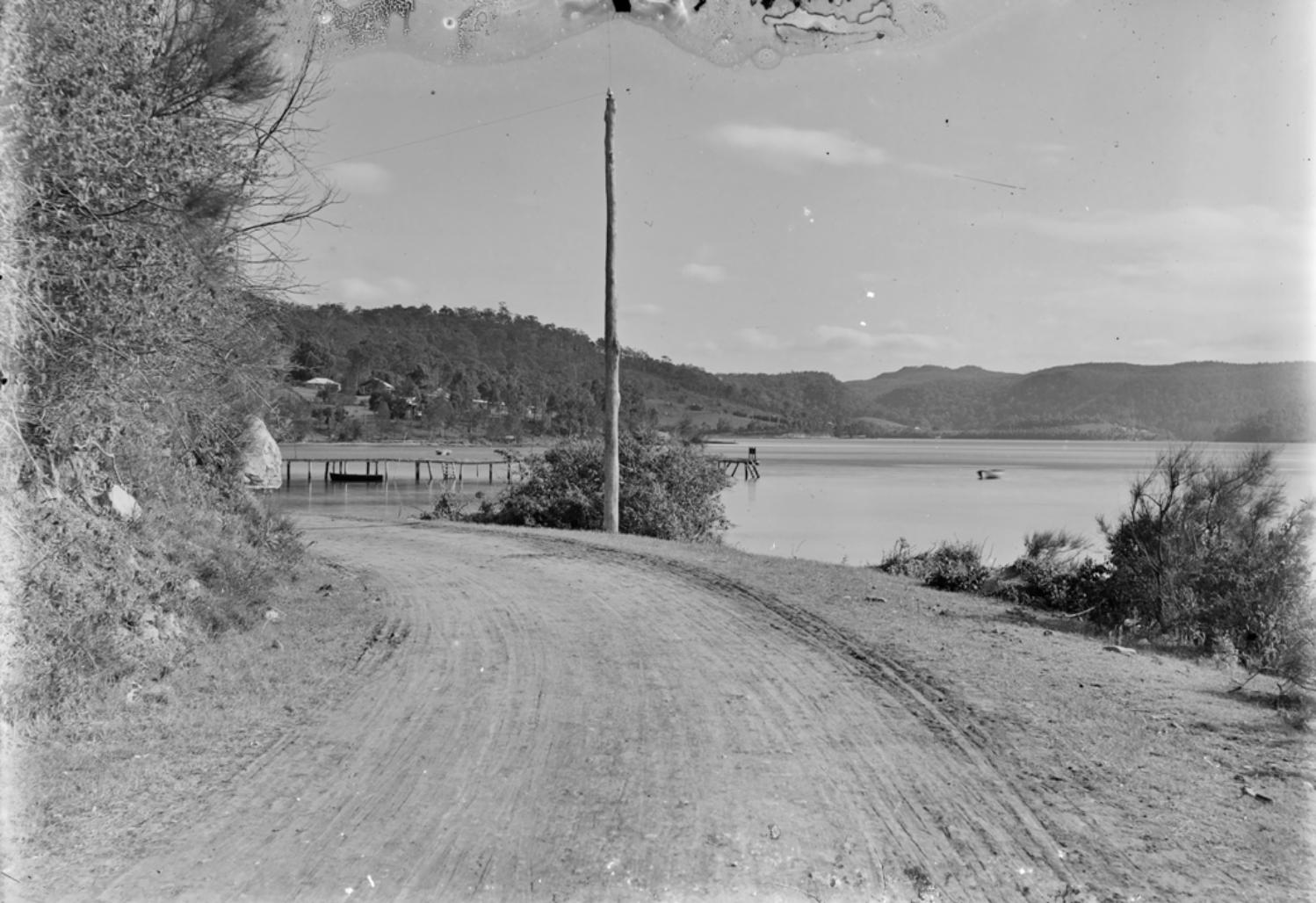
Pittwater Points.
The stranger can scarcely tell where Pittwater is as distinguished from Bay View. There is a romantic bay, with boats speeding back and forth, islands about the mouth of the bay, one of them called Lion Island, all looking vague, shadowy and uncanny. The road around the bay is perfectly level. There is a first-class boarding house kept by Mr. Buist, and the Post Office is boomed by Mr. Roche, who is also an enterprising News-agent, Poulterer, Orchardist, etc. Pittwater Points. (1898, October 1). The Mosman Mail (NSW : 1898 - 1906), p. 2. Retrieved from http://nla.gov.au/nla.news-article247003517
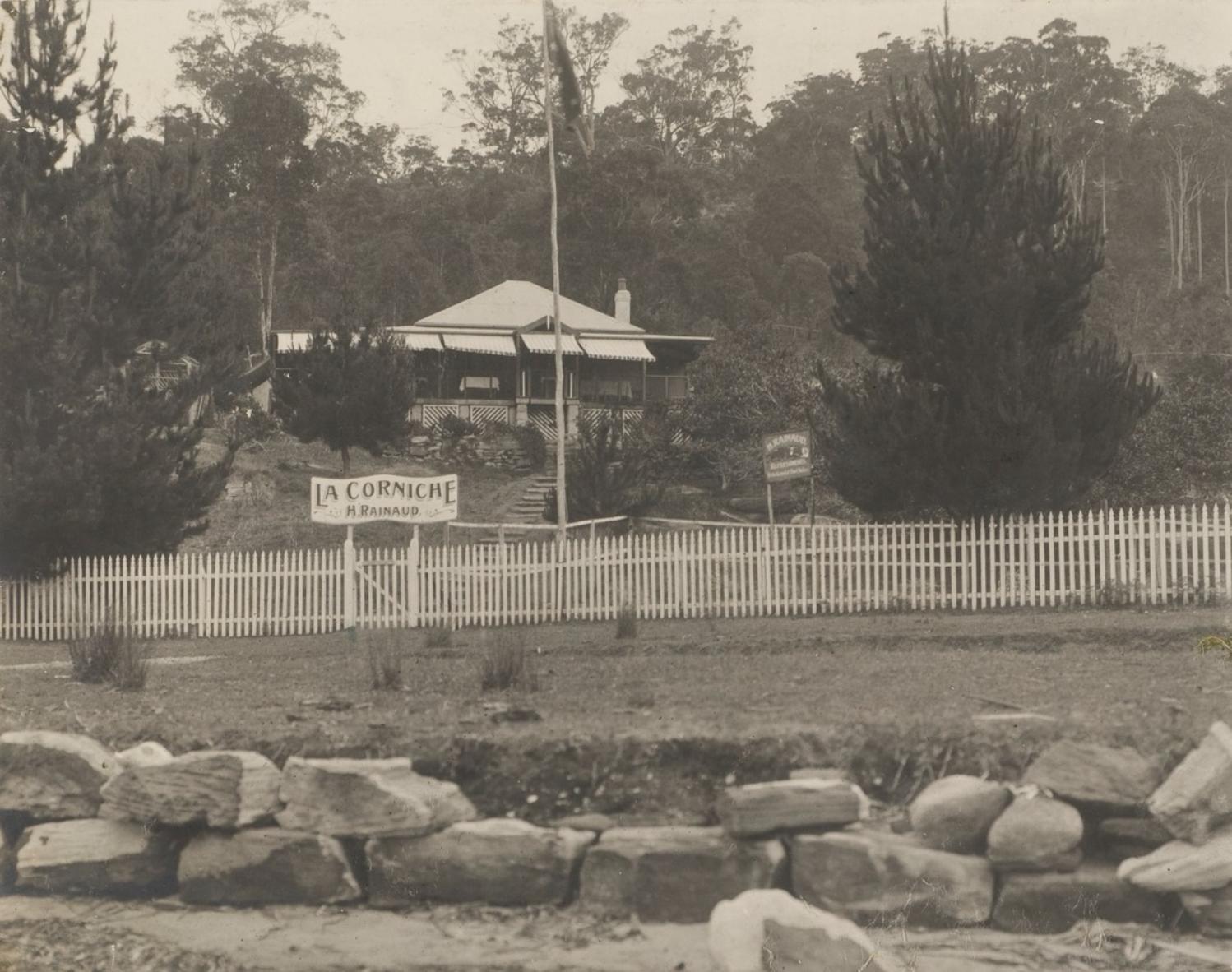
Just as there is one road to Palm Beach, with subordinate roads leading off, so too is the case for that hugging the foreshores road on the way to Church Point. Originally called 'Bay View Road', due to have a view of the bay of Pittwater, the area between Mona Vale and Church Point attracted the hardy who planted orchards and prize winning fruit trees after the earlier timber getters had moved on.
This was a place people who owned yachts were attracted to, while the peace and seclusion brought weekend residents from among universities, the arts, industry, marine pursuits, women's rights and more.
The road, a 'track' or widened path initially, wove through the series of connected farms.
'The whole of the traffic to Pittwater was at first carried through Newport, and passengers to the opposite shore had to arrange to be taken by boat across the bay. There was then no Bayview, and no road to Church Point, but simply a track which led through farms, generally called by the name of the owner of the nearest farm. As time went on, Bayview became more settled than Newport, and passengers from Manly were transferred at the Rock Lily to a smaller coach, while the larger one carried the majority to Bayview and Church Point. - The Story of Pittwater, Maybanke Anderson, 1920
The article below describes that coach, and the jetty which was closer to Winni Jimmi bay than the Newport Wharf which would be opend to traffic in 1880. William Boulton (also Bolton) ran the Royal Mail coach to Bayview, Church Point and Newport and he who became licensee of the Newport Hotel and then its owner to whom a succession of others as licensees stayed for a season or many years:
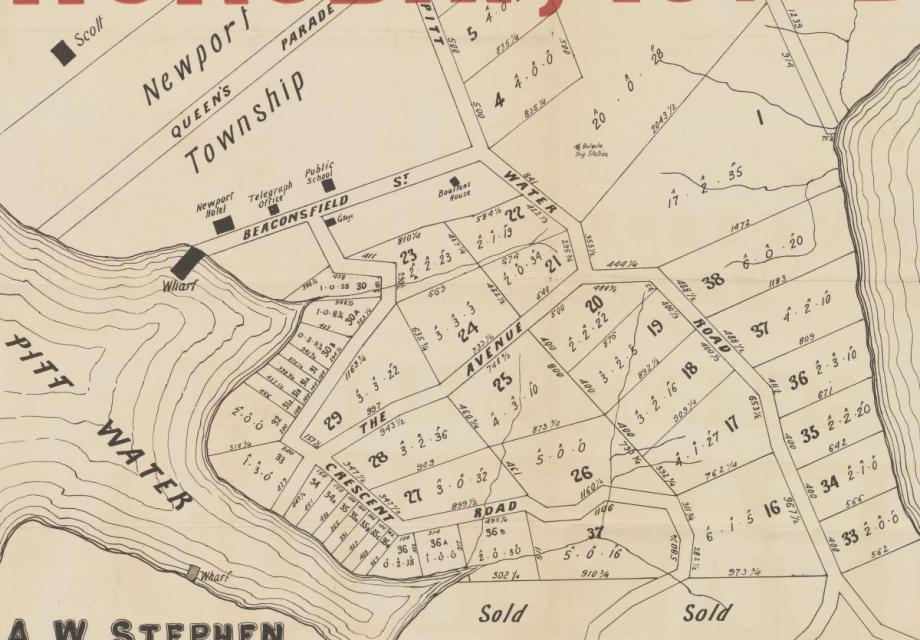
The " Florrie" having started, at full speed, at eight o'clock a.m., reached Blackwall (at the southern extreme of the widest part of the lovely broadwater of Gosford) in rather better than half an hour, and there she took in the Blackwall mail, with some more passengers; after which she proceeded rapidly down the stream, by Hardy's Bay, and across the large, lake-like expanse beyond it, in the direction of Mulhall's Point, and the Bar; passing through that seaward portal of the lonely district out into Broken Bay, at a pace which fully proved the capabilities of the trim little craft for her destined purpose. The mail steamer was found by her passengers to be swift but steady, being furnished everywhere, and in every respect, with a studious regard to the personal comfort of all. In the bay there happened to be a very heavy rolling ground swell, yet the " Florrie " swept over it all, though more like a quick little seabird than a lumbering pelican : her rapid motion being barely perceptible, because she is not worked by paddle-wheels, but by a screw at her stern of the latest design and best construction. The smart little steamer in a very few moments flew across Cook's broad Broken Bay, a little to the eastward of Mount Elliott; paused for a brief space off the Sub- collector's station in the Bight of Barrenjuey, and then ran directly and pleasantly south-ward, over the smooth, still, landlocked depths of Pittwater- past Careen Bay to the left, and past the "Basin" and Scotland Island to the right-until she halted at the jetty, at the head of the long and picturesque inlet at Pittwater, at half-past 10 o'clock, having come along leisurely from Gosford wharf (including all stoppages) in two hours and a half. Here the excursionists, who were going no further,-and who had evidently enjoyed the trip amazingly, and were in a high state of delight with the ever changing scenery-all landed; and, having formed a hasty camp, they dined together al fresco under the trees.
The coach came down to the end of the jetty precisely at eleven o'clock, and after having been duly and heartily approved of by the Gosfordites, was depatched back again in due course to her destination - Manly Beach. The coach proved to be a fine four-wheeled waggonette, provided with a high, fixed leathern hood, and drawn by two horses; everything about this coach, as on the steamer, was perfectly new. The experienced driver is Mr. Bolton, whose hospitable roof has often sheltered disappointed, weary, and sea-sick travellers, when the sea-going steamer has had to put back with them into Pittwater in bad weather, and stern necessity has compelled them to face a long night's journey overland to Manly afterwards, through the darkness and rain. The trap to carry the mail and passengers is a smart and stylish turn-out, painted red and black; and it was found-by some critical jago of the party, who must needs know everything-to have come all the way from the Manly post office that morning in one hour and three-quarters. It would seem, therefore, that there is really nothing whatever to prevent letters sent from Gosford to the Metropolis by this route from being distributed in Sydney by the four o'clock delivery on the very same day. Comment on the magnitude of this improvement must be quite superfluous.
Before the excursionists left the " Florrie," the Police Magistrate, Mr. Edward Reeve, addressed a few remarks to those present, congratulating them all on the happy and auspicious inauguration of the new overland route to Sydney, via Pittwater and Manly. He briefly pointed out to them some of the many striking advantages thereby secured to the district and to the public at large; and he expressed his ardent hope that the opening of this route might be to them an earnest of still greater progress. In the courts of his observations Mr. Reeve paid a warm and well merited compliment to his friend, Mr. Rock Davis, by whose persevering energy and liberal enterprise the outer gates of their district were thus for ever unbarred, and an immense and permanent alteration secured for more expeditious and pleasant travelling between Gosford and Sydney, together with a greatly improved means afforded for the reception and despatch of letters and newspapers. At the close of the Police Magistrate's remarks three hearty cheers were given for the " Florrie" and for Mr. Rock Davis.
The day was a lovely one, and the magnificent lake scenery was everywhere seen to the very best advantage. It appears to be quite certain-now that, in spite of interested opposition, flippant imbecility, and pure Rip-Van-Winkleism, this route is happily established-that a large number of excursionists may constantly be expected down this way from Sydney to visit the far-famed Hawkesbury and the little-known Brisbane Water district. These will have to leave the Circular Quay for Manly Beach in the steamer with the mails at seven a.m. ; and they can thus arrive at Gosford at about 2 p.m. This route is open (for the present) only on Thursdays and Saturdays, but it will, doubtless, soon be in active use daily. The "new overland" will doubtless be the favorite route by which all foreign visitors to the Sydney Exhibition will come down in search for the picturesque at the Hawkesbury and at Brisbane Water.Gosford, 5th August. Opening of the New Overland Route from Gosford to Sydney. (1879, August 9). The Maitland Mercury and Hunter River General Advertiser (NSW : 1843 - 1893), p. 12 Supplement: Second Sheet of the Maitland Mercury. Retrieved from http://nla.gov.au/nla.news-article18931762

Parish of Narrabeen, County of Cumberland [cartographic material] : Metropolitan Land District, Eastern Division N.S.W. 1886. MAPG8971.G46 svar (Copy 1). Courtesy National Library of Australia - showing Bayview section
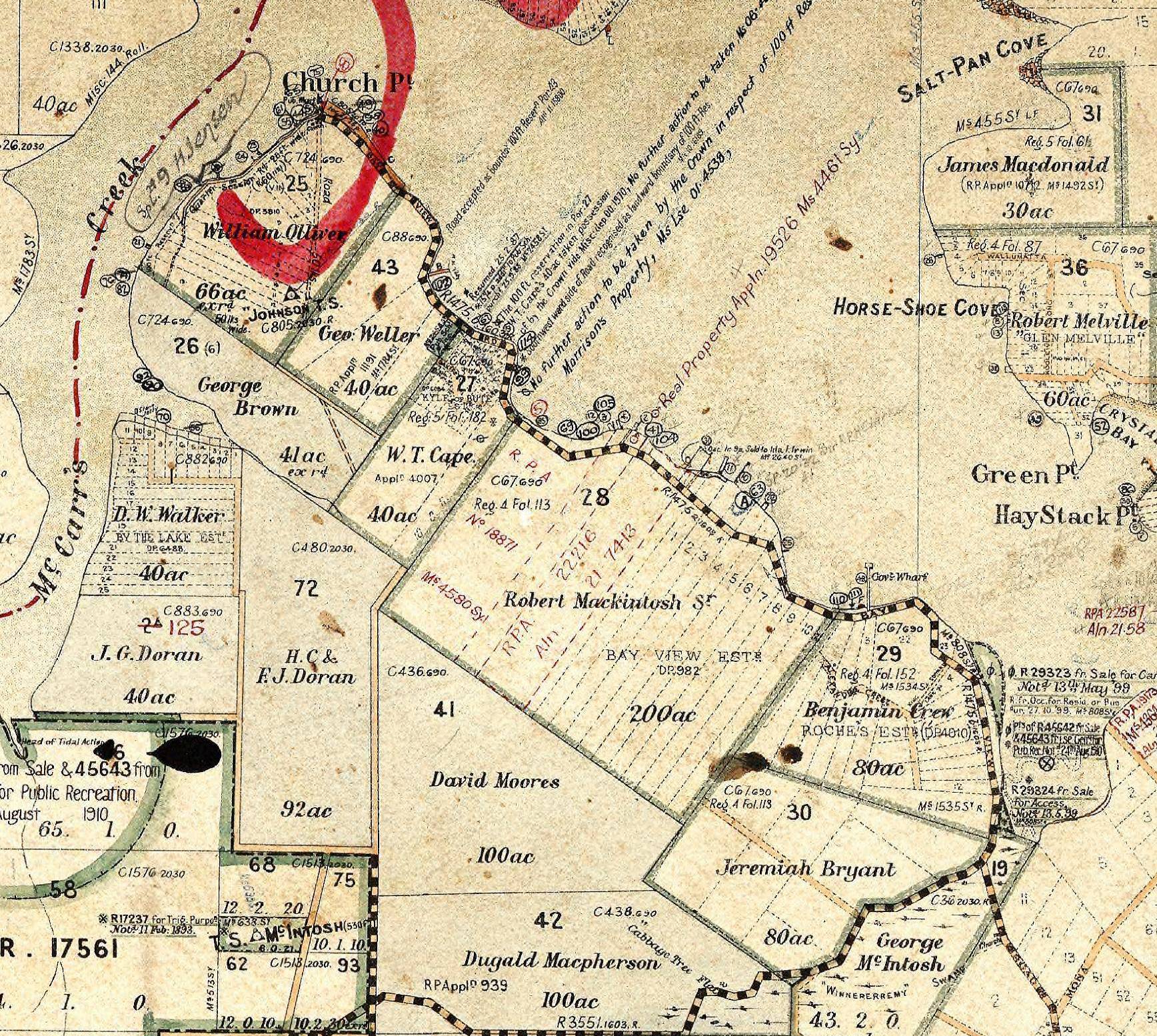
No, 153, By the Rev. John Joseph Therry, of Hyde Park, Sydney, in opposition to memorial of Wm. Wright, to. 42, to 80 acres of land, promised by the crown to Peter Petillo, described as follows : situate in the parish of Narrabeen, commencing at the north-east corner of Robert McIntosh's 200 acres, and bounded on the west by that farm by a line south 35 degrees west 20 chains 50 links to the north corner of Jeremiah Bryan's 80 acres, on the south by Bryan's by a line south 74 and a half degrees east 38 chains 50 links by a swamp called Wennejereme swamp, and On the east and north by that swamp and Pitt Water to the commencing corner, situate at Pitt Water, Broken Bay. Government Gazette Notices (1834, April 23). New South Wales Government Gazette (Sydney, NSW : 1832 - 1900), p. 230. Retrieved from http://nla.gov.au/nla.news-article230686595
Robert McIntosh Junior sold the 200 acres to William Timothy Cape on 6 June 1834 for £130 [LTO Book G No. 238].
On 1 January 1841 William Timothy Cape leased McIntosh’s 200 acre grant at present Bayview to John Johnson for £20 per annum. [LTO Book V No.569] John and Charlotte Johnson were living there, with three children, at the time of the 1841 census. They were still there in 1845, when John Johnson, Peter Duffy, and Daniel Bullock were all named as being associated with illegal distilling at McCarr’s Creek. The three were all married to Oliver women.
John and Charlotte’s children were: John Junior, born 1834; Frances (b.1836, married Richard Augustus Willoughby Green 1858); Henry (b.1840); William (b.1841); Charles (b.1847); Daniel (b.1850); Charlotte (b.1855, died 1875). William was born at Pittwater.
The Johnsons had departed from Pittwater by 30 August 1845, when Cape leased the 200 acres to Thomas Johnson Jones. [LTO Book 9 No. 442] This stretch of land at Bayview was known as Cape’s Flat. After Cape’s death it was sold to Albert Henry Turner for £200 on 2 June 1876. [LTO Book 170 No.52]. In his own name, Robert II had applied to purchase 40 acres next to the 200 acres, on 28 March 1831. This was also sold to W.T. Cape on 6 June 1834, for £25. [LTO Book G No.239] The deed of grant was made to Cape on 8 April 1840. [LTO SN 60/27] - Shelagh Champion OAM and George Champion OAM - Profiles of the Pioneers
POUNDS AND POUNDKEEPERS
NOTIFICATION of the appointment of Pounds, and poundkeepers, in the Town and District of Sydney, under the Act of the Governor and Council, 4th Gul. IV., No, 9, Tiz. The five Pounds at Sydney, Petersham, Longbotton, Lane Cove, {ma Pitt-Water, to be confirmed.
The following persons appointed Poundkeepers, namely—Andrew Byrne, for the Town of Sydney; William Taverner, for Petersham; Robert M'Intosh, for Lane Cove; and George Melville, for Pitt Water.
By Order of the Court of Petty Sessions.
W. H. MEACH,
Clerk of the Petty Sessions. Police Office, Sydney, 31st August, 1833. POUNDS AND POUNDKEEPERS. (1833, September 25). New South Wales Government Gazette (Sydney, NSW : 1832 - 1900), p. 388. Retrieved from http://nla.gov.au/nla.news-article230390780
The 1882 Notification of the landholders being responsible for the official parish roads:
Department of Mines,
Sydney, 31st October, 1882.
PRELIMINARY NOTIFICATION OF PARISH ROADS.
HIS Excellency the Governor, with the advice of the Executive Council, having deemed it expedient to open and make the several Parish Roads mentioned in the Schedule appended hereto, to be maintained at the expense of the parishes through which they pass: Notice is hereby given that, in accordance with the provisions of the Act 4th William IV No. 11, plans and books of reference, showing the intended lines of the Roads in question, are now deposited at the Office of the Surveyor-General in Sydney, and at the Police Offices mentioned.
It is requested that any well-grounded objections that may exist to the formation of the Roads in question may be transmitted in writing to the Clerk of the Executive Council within one month from this date.
By His Excellency's Command,
ARTHUR RENWICK.
Schedule referred to.
Roads No. 82-3416 81-1243-7 S.G. R.1475b,
Description of Road.
Deviations in the road from the Manly Beach and Pittwater Road to McCarr's Creek, near the Church. (1) From the said road, within J. Bryant's (now Anderson's) 80 acres, to the said road, at the south boundary of R. Mcintosh, senr.'s (now A. H. Turner's) 200 acres. (2) From the said road within R. Mcintosh, junr.'s (now W. Baker's) 40 acres to the said road, near the Church, within W. Oliver's (now J. Wilson's) 66 acres, parish of Narrabeen, county of Cumberland,—in lieu of parts of road previously confirmed by notice in Government Gazette, 14th February, 1879, folio 684.
Names of reputed owners or occupiers through whose properties the Roads pass.
— Anderson, .T. Collins, A. H. Turner, W. Baker, J. Wilson. Police Offices at which plans and books of reference hare been lodged. Gosford. PRELIMINARY NOTIFICATION OF PARISH ROADS. (1882, October 31). New South Wales Government Gazette (Sydney, NSW : 1832 - 1900), p. 5749. Retrieved from http://nla.gov.au/nla.news-article225833100
And an advertisement for land that shows it has been built:
PITTWATER.
100 ACRES MAGNIFICENT LAND, on the southern shore, opposite the Pittwater Hotel, TO BE SOLD IN ONE BLOCK.
This land immediately adjoins the rapidly improving orchard property belonging to Mr. M'Keown. The new road has been completed right along this property, giving direct communication from Manly.
The soil is of the richest possible description, and the land gently rises from the water, commanding most Beautiful views of the charming Hawkesbury scenery.
Plans in course of preparation.
HARDIE and GORMAN have received instrnctions to sell by public auction, at their Rooms, Pitt-street, at 11.50 o'clock, WEDNESDAY, 20th September, 100 acres of land at Pittwater, the choicest spot In the whole district, and which was selected by the present owner as a site for a residence. Advertising (1882, September 7). The Sydney Morning Herald (NSW : 1842 - 1954), p. 15. Retrieved from http://nla.gov.au/nla.news-article28376790
As more farmers and weekenders moved into that side of the estuary, improvements were called for:
DEPUTATIONS. THE NARRABEEN-ROAD.
A deputation, consisting of the Mayor of St Leonards, Dr Tibbit's, and several other gentlemen, waited upon the Hon. Alexander Stuart, Colonial Secretary, yesterday, to request that the Narrabeen-road from Manly to Pittwater be put in a proper state of repair, and that a jetty be constructed on Church Point at Bayview, Newport. The road, it was represented, is now in a very bad condition, and if it were put into proper order it would open up one of the most beautiful districts in the colony. The jetty was required for the benefit of children going to school and persons attending church. The deputation also asked for a bathing place.
Mr. Stuart said he was quite aware that the road had been in a very bad condition, but it was gradually, perhaps rather too slowly being made, and as soon as a bridge was carried across s Narrabeen the work on the other side must follow in a matter of course. He would give instructions to have the road examined specially, and reported upon to him during the ensuing week, and he would take an opportunity of visiting the locality and seeing what further could be done in the what further could be done in the way of relief. In regard to the jetty he would give the matter consideration but while the Government might erect a wharf he thought the inhabitants ought to construct a bathing place. The next thing likely to be wanted by the residents would be that the Government should go and wash them. DEPUTATIONS. THE NARRABEEN-ROAD. (1883, June 2). The Sydney Morning Herald (NSW : 1842 - 1954), p. 9. Retrieved from http://nla.gov.au/nla.news-article13536041
Dr. Tibbits of Petersham, a medical practitioner, is the landholder of 40 acres, part of Portion 25, on the west side of the ‘church acre’ at Church Point. A year and a bit later:
THE following tenders were opened by the Tender Board at the Public Works Department yesterday: Wharf at Church Point, Pittwater. NEWS OF THE DAY. (1884, December 10). The Sydney Morning Herald (NSW : 1842 - 1954), p. 9. Retrieved from http://nla.gov.au/nla.news-article13581494
Accepted tenders: William Boulton, construction of wharf at Church Point, Pittwater. GOVERNMENT GAZETTE. (1884, December 31). The Sydney Morning Herald (NSW : 1842 - 1954), p. 6. Retrieved from http://nla.gov.au/nla.news-article13578833
And another half year past that:
The completion of the Government wharf at Church Point, Pittwater, will prove a great benefit to the residents in that district. The wharf is a substantial wooden structure, and boats drawing 11 feet of water will be able to come alongside at high tide. The population in the neighbourhood of Pittwater is rapidly increasing, and it is understood that the Government intend building a Public school to accommodate 50 pupils. Fruit-growing promises to be the leading industry in that locality. A considerable area of land is being planted with fruit trees. NEWS OF THE DAY. (1885, July 4). The Sydney Morning Herald (NSW : 1842 - 1954), p. 11. Retrieved from http://nla.gov.au/nla.news-article13592258
The turn off to Bayview, called 'Bay View Road' on early land maps, commenced at the junction of Pittwater and Barranjoey roads. An earlier description of the road to Church Point, post the wharf being installed:
At length the Rock Lily Hotel is reached, and here is refreshment for man and beast. A few yards beyond here the road branches, one to the town of Newport and Barrenjoey Lighthouse, and the other to Bay View Post Office and Telephone Office and Church Point.
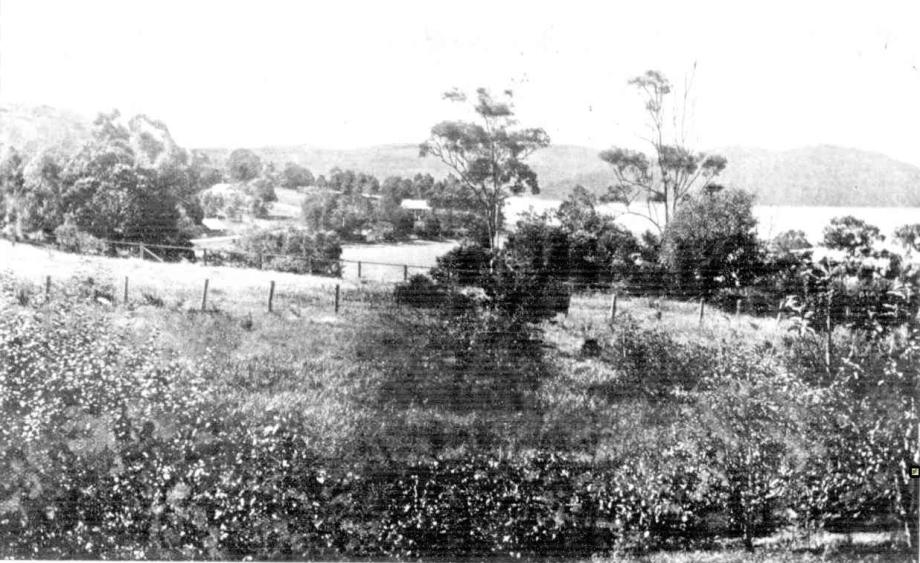
BAY VIEW, PITTWATER, AN ARM OF BROKEN BAY
At Bay View the expansive waters of Pittwater and Broken Bay in all their glory lie disclosed to view. Our illustration gives a very good idea of the scene. In the foreground is Bay View House, vine yard, orchard, Post and Telegraph Office, the property of Mr. J. J. Roche. In the near view is Pittwater, extending its broad and deep arms to the right and to the left, and in the distance is Broken Bay, with Lion Island barring the passage way, so named because of its resemblance to a lion couchant. Only half the scene described is represented in the picture, but the varied panorama of headland jutting out beyond headland, with the intervening bays and arms as they sweep inward between the wooded head lands, gives a good idea of what the other side is like. Broken Bay is, as is well known, one of the most magnificent harbors in Australia, with plenty of deep water and ample scope for the largest ships that sail the ocean. Its vicinity to Port Jackson has, up to the present, destroyed its chances of becoming a commercial centre, but no one can doubt that the day will come when it will be the seat of a prosperous population with cities and towns within its borders, and railroads and ships bringing goods to its marts. At present it is merely used as a haven of shelter by storm-tossed ships, yachting parties, and an occasional excursion steamer from Sydney. At present its population is mostly composed of private gentlemen, who have residences among its beauty spots, the summer residences of business men from the metropolis, a few professional fruit-growers, with a scattering of business men and fishermen.
From Bay View the road, a very good one, winds around the beach, disclosing as every vantage point is gained new beauties of land and water. Around here are some very good orchards, with trees laden with fruit, and the homesteads peeping out from masses of evergreen foliage, with an extensive vista of land and water. In a charming spot on a sloping hillside, with such a fore ground and a craggy background Professor Anderson Stuart has a summer residence and orchard. Mr. W. G. Geddis (spelled Geddes elsewhere) has a neat residence on a pleasant point. Mr. W. Baker has an orchard with some magnificent trees, while on a commanding bluff is Mr. John Poster's residence and orchard. Mr. A. McIntosh's residence is also hard by.
This road ends at Church Point, a lovely spot commanding a view of Pittwater the town and hotel of Newport at the head of Navigation, Broken Bay, and Barrenjoey directly in front; Scotland Island and Towler's Bay right across the water, with the long and deep arm known as McCarr's Creek on the left. On the Towler's Bay side there are several residents who pull across the water to the wharf at Church Point and meet the steamer from Sydney or the coach from Manly, as the case may be. The dynamite powder hulk is moored in Towler's Bay, with residences on shore for the officers in charge. Mr. Robert Robinson has his residence of Raamah at the same place. Mr. Robinson informs me that he can grow to perfection such tropical fruits as bananas, guavas, ginger, mangoes, pineapples, Brazilian cherries, &c. This fact will demonstrate that there can be little or no frost in this locality. Other residents of this side of the bay are Mr. F. Chave, Woodlands, who has a very nice orchard, mostly summer fruit ; Mr. E. C. Johnstone, who has a nice residence and orchard; Mr. A. Steffanis another prominent resident, while the residence of the firm of Flood and Oately occupies a lovely peninsula in the quiet waters of the bay. Mr. Geo. Brown has a residence and an orchard in the neighborhood, and there is also a small church and cemetery at Church Point.
The land, as seen in its bold outlines from a distance gives one an idea of sterile beauty, but on closer approach and investigation it will be found that, while there are many rocky ridges and promontories, there are also deep alluvial valleys, composed of very good soil for fruit-growing and even dairying purposes. Most of the land is a light sandy loam, but there are spots of excellent soil. Stretching back from the bay there is Mr. J. J. Roche's orchard, composed of very good soil. Beyond for several miles the soil is generally good, and at Mr. Austin's Cabbage Tree Valley Orchard the soil is of an excellent quality. In the hands of Mr. Roche and a few others, fruit-growing and poultry farming is a paying industry and will be sure to extend. Our illustration, " A Cluster of Lemons," grown by Mr. Roche, on his Bay View Orchard, will compare favorably with any fruit of the kind grown in this country or any other. The lemons, which are of the Lisbon variety, and are very juicy, are simply superb, and grow close to the salt water in the greatest profusion ; and oranges, which are of the Siletta variety, are among the sweetest and best ever grown.
On Mr. Roche's property are several small caves, interesting as the unmistakable residence of generations of blackfellows, and the shells and debris collected show ages of habitation, and what is now used as manure.
The flora of the district is varied, as may be supposed from the climate and soil. Grey gum, spotted gum, ironbark, blood wood, and turpentines, and others of the eucalypti develop into lofty trees, which cover the whole face of the country and give it a densely wooded appearance. In the olden days large quantities of excellent timber was shipped from the district, and there is still large quantities obtainable, although not so handy as desirable. A dense undergrowth occurs in suitable situations, prominent among which are the numerous palms common to the coast. The baroneas, flannel flowers, waratahs, fuchsias, &c, all grow in the most bewildering confusion ; rock lilies, stag horns, and other epiphytal plants cover the rocks and trees, while a perfect maze of ferns cover the sward wherever they can find root for themselves, from the tender maidenhair to the more lofty fern tree. Ever-flowing streams of water pour down from the mountain sides, in some instances forming cascades of considerable volume, which still further enhance the beauty of the scene.
In short this favored region has every resource calculated to render it a fit habitation for man, a salubrious climate, fertile soil, plenty of wood and water, and within easy distance from market. Its fisheries alone, if energetically prosecuted ought to return a revenue sufficient to support a large population, while its close proximity to the metropolis and many beauties ought to attract a constant stream of tourists. The reason the district is so backward in respect of permanent settlement is no doubt because there are so many other localities where the land is more easily cleared and the soil of a better quality. One drawback has been that much of the best of the land has been locked up from settlement by large landholders. Manly to Broken Bay. (1893, November 11). Australian Town and Country Journal (NSW : 1870 - 1907), p. 19. Retrieved from http://nla.gov.au/nla.news-article71191632

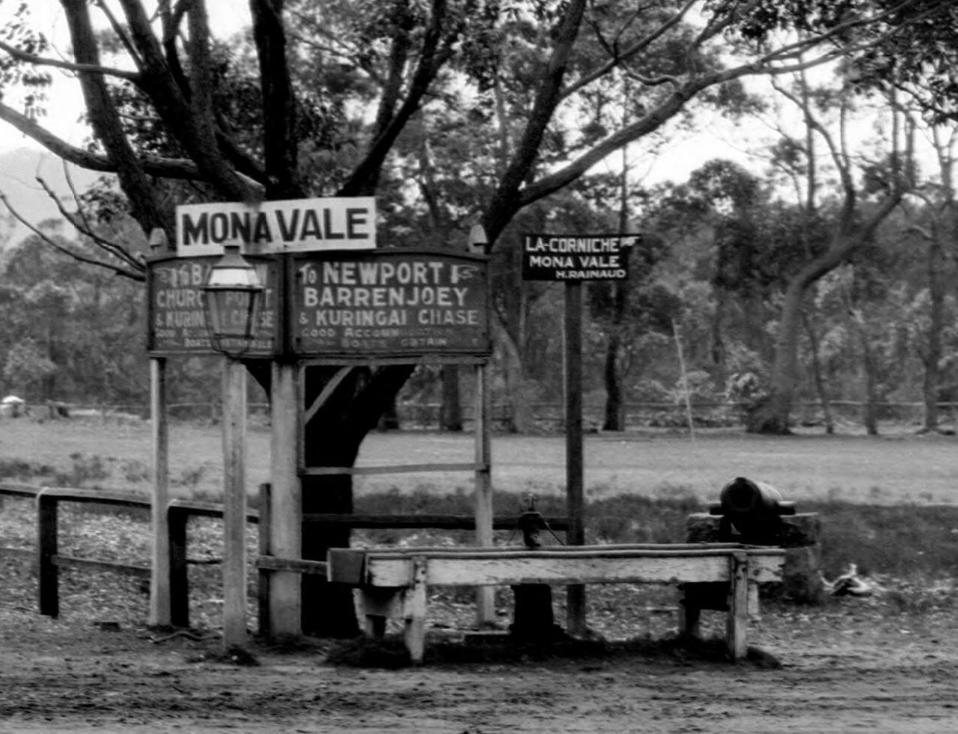
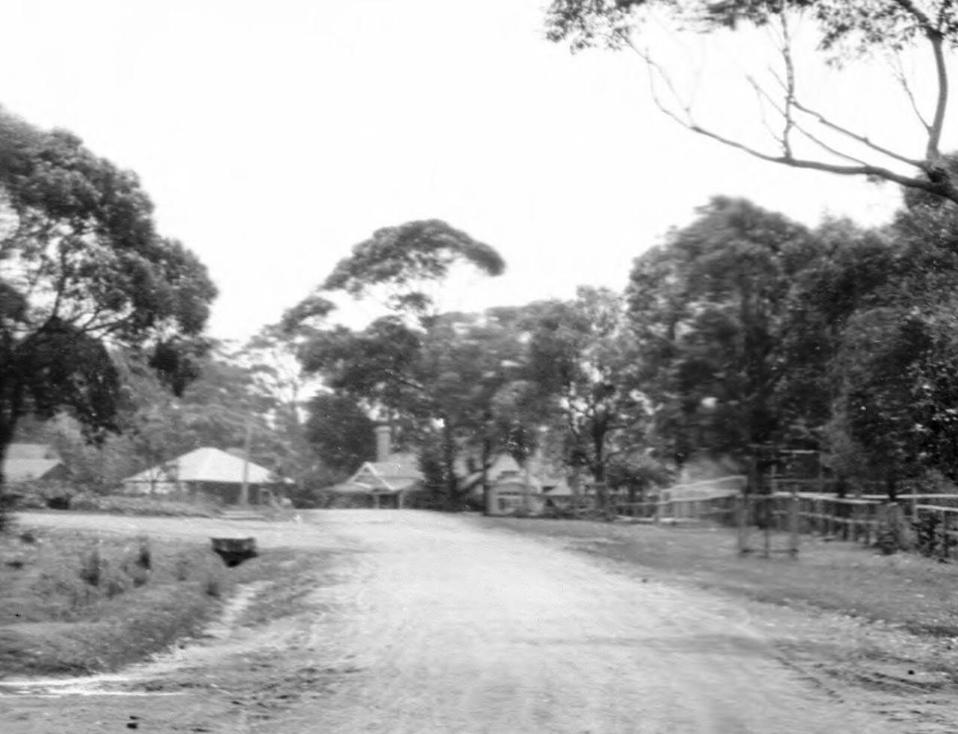
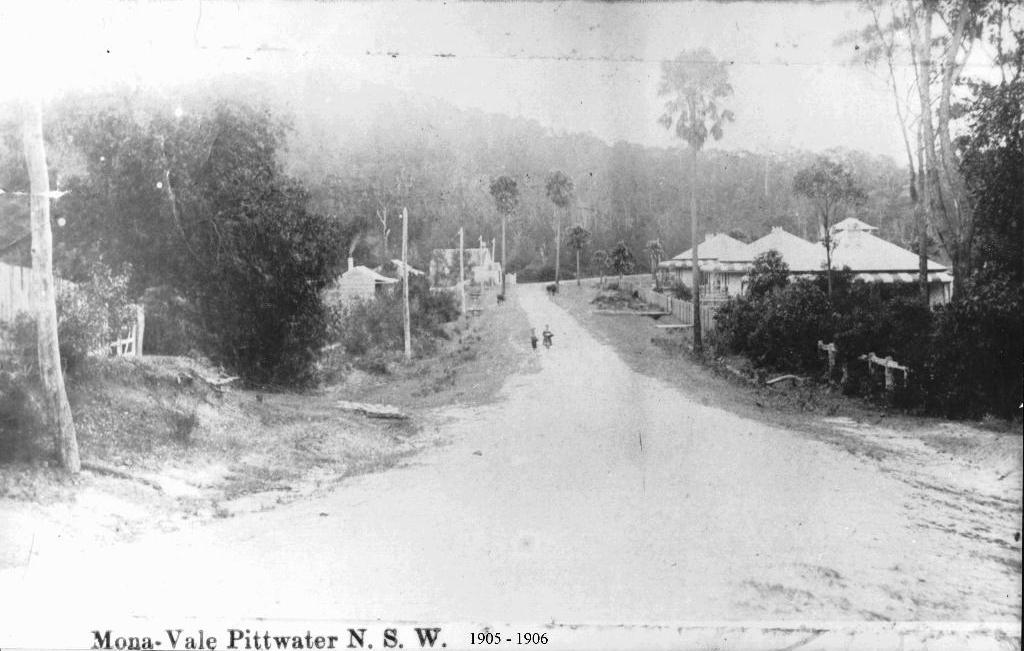
Mona Vale circa 1905 - looking towards Bayview. Mona Street runs off to the bottom right of this picture. To the left is St John's Church of England.
The shift from tracks through side by side farms was taking place too and was no longer strictly the responsibility of the landholders. An advertisement from earlier in May 1890 states a new government road has been built when speaking of 53 acres for sale 'next to Munros' on the Bay View Road. Further Tenders called for show:
Department of Roads and Bridges,
Sydney, 8th May, 1890.
TENDERS will be received until 11 o'clock on THURSDAY, the 22nd MAY, from persons willing to contract for
10 T. Eastern-road, Gordon.
17 T. Cowan-road, Gordon.
18 T. Manly to Pittwater-road.
19 T. Bay View-road, Pittwater.
Tenders to be addressed to this Department, where specifications may be seen. Advertising (1890, May 17). The Australian Star (Sydney, NSW : 1887 - 1909), p. 8 (THREE O'CLOCK). Retrieved from http://nla.gov.au/nla.news-article230617726
Pittwater.—Lost or stolen, about three weeks ago, from the person of Christopher Donohue, road contractor, Narrabeen, whilst in the vicinity of the “Rocklily Hotel,” Pittwater,— twenty-two £1-notes on the Union Bank, Sydney. Miscellaneous Information. (1890, October 1). New South Wales Police Gazette and Weekly Record of Crime (Sydney : 1860 - 1930), p. 305. Retrieved from http://nla.gov.au/nla.news-article251637772
Department of Public Works, Roads and Bridges Branch.
Sydney, 28th November, 1890.
TENDERS will be received up to 11 o'clock 11 a.m. on TUESDAY, the 9th December. 1890, for Contracts
43T Manly to Pittwater-road, 44T Pittwater- to Barranjoey-road and 45T M Garr's Creek-road, Pittwater.
Tenders to be addressed to the Roads Office, Sydney where speoifications, &c., may be seen. Advertising (1890, December 1). The Daily Telegraph (Sydney, NSW : 1883 - 1930), p. 2. Retrieved from http://nla.gov.au/nla.news-article235798340
AN ACCOMMODATION ROAD
In conformity with the provisions of the Act of Council, William V , No 11, section 21, George Brown being the owner of portion No 6, parish of Narrabeen, applied to the Chairman of the Quarter Sessions for an accommodation road from his land to run through land supposed to be the property of trustees of the Wesleyan Church Dr Tibbetts and Alfred McIntosh being part of Olivers grant, portion 7, until it should meet the road from Manly, at the public wharf Church Point, Pittwater, such being the nearest highway. Evidence was given by the applicant that he had no thoroughfare nor right of away to get to a highway from his land as described consisting of 11 acres, and the accommodation road he now applied for was the best available, considering all the interests. No objection was raised to the road being made and the application was granted by His Honor. QUARTER SESSIONS. (1897, November 19). The Sydney Morning Herald (NSW : 1842 - 1954), p. 3. Retrieved from http://nla.gov.au/nla.news-article14100043
George Brown had a farm at what we now call 'Brown's Bay'. His home burnt down in March 1912:
FIRE AT MANLY.
At 9 p.m. on Sunday a seven-roomed weather-board cottage, situated at McCarr's Creek, Pittwater, owned and occupied by Mr. Geo. Brown, was totally destroyed by fire, with all its contents. Mr. Brown was reading in the dining-room at the time of the outbreak, and he tried to put it out himself with buckets of water but was not successful. The damage is estimated at £450, and the house was not insured. The cause of the fire is not known. FIRE AT MANLY. (1912, March 5 - Tuesday). Evening News (Sydney, NSW : 1869 - 1931), p. 10. Retrieved from http://nla.gov.au/nla.news-article113820231
Pittwater Points.
The stranger can scarcely tell where Pittwater is as distinguished from Bay View. There is a romantic bay, with boats speeding back and forth, islands about the mouth of the bay, one of them called Lion Island, all looking vague, shadowy and uncanny. The road around the bay is perfectly level. There is a first-class boarding house kept by Mr. Buist, and the Post Office is roomed by Mr. Roche, who is also an enterprising News-agent, Poulterer, Orchardist, &c. Pittwater Points. (1898, October 1). The Mosman Mail (NSW : 1898 - 1906), p. 2. Retrieved from http://nla.gov.au/nla.news-article247003517
Shaw's Creek - Cahill Creek
A short watercourse at the southern tip of Pittwater. It rises near Suzanne Road Bayview, and is joined by two smaller branches within Bayview Golf Course. It enters Pittwater through a lined channel at Winji Jimmi Bay. Known as Winnererremy Swamp in the early days of European settlement, the name was applied to the Bayview area. Water drained into the swamp from the surrounding hillsides and flowed into Pittwater through a meandering mangrove lined channel called the "Newport Maze" on the eastern side of Pittwater Road.
Later, the creek was known as Shaw's Creek after the local blacksmith, who also built boats near the creek. Changes to the waterway were undertaken in 1920 by New Zealand sheep farmer John Orr, who developed the golf course, through which the waterway still flows, though much reduced in scale. Orr ran sheep on the property, and, as he and his wife were golfers, he constructed six holes for their amusement. This was a difficult task amidst swampland, but the Orrs mounded dirt up to plant the first fairways; then gradually filled in the rest.
Department of Lands,
Sydney, 7th March, 1900.
HIS Excellency the Lieutenant-Governor, with, the advice of the Executive Council, directs it to be notified that, in order to enforce the saving and reservation contained in Crown Grant to William Timothy Cape, of 40 acres, being portion 27, on Pitt Water, parish of Narrabeen, county of Cumberland, dated the 8th day of April, 1840, and registered volume No. 59 (Register of Grants of Land 33), folio 33, it is the intention of the Crown to take possession of the lands comprised within the said reservation. [Ms. 1900-1,050 Dep.] T. H. HASSALL Government Gazette Notices (1900, March 7). New South Wales Government Gazette (Sydney, NSW : 1832 - 1900), p. 1917. Retrieved from http://nla.gov.au/nla.news-article221016173
THE BAYVIEW COACHES. The residents of Bayview and Newport want an earlier and a later coach to Manly. The subject was before the last Manly Council meeting, when a petition was read from residents of the district, pointing out their wants. An alderman said that the proprietors of the present line had recently raised the fares. It was thought a great improvement could be .......Superintendent Edwards, of the Traffic Department, forwarded the correspondence on the matter, and asked the council to express an opinion on an application made by the Manly and Balgpwlah Coach Company, to ply a coach leaving Bayview at 7 a.m. and Manly at 5.45 p.m. Mr. Edwards pointed out that some years ago when two lines of coaches were running it was certainly not in the interests of the general public of Manly and the district. The Manly Livery Stable Company, who has the right of the road at present, wrote, saying that they were willing to provide any additional vehicles considered necessary to meet any reasonable regulation of traffic. At the same time the number of passengers at this time of year was very small. The company was willing next summer to make any alteration in the time-table considered justified. The writer trusted that no licence would be granted to any other proprietary. As the matter had been under consideration by the Warringah Shire Council, the aldermen came to the conclusion that it would be wise to await the result of their deliberations. THE BAYVIEW COACHES. (1909, June 16). Evening News(Sydney, NSW : 1869 - 1931), p. 8. Retrieved from http://nla.gov.au/nla.news-article115495066
Article: THE BAYVIEW COACH. (1909, June 30). Evening News(Sydney, NSW : 1869 - 1931), p. 9. Retrieved from http://nla.gov.au/nla.news-article115499886
MANLY TO BAYVIEW COACHES. At a recent meeting of the Warringah Shire Council a letter was received from the Traffic Branch of the Police Department asking the council's opinion on the question of running another line of coaches from Manly to Bayview and Bayview to Manly- later and earlier than the present coaches run Consideration of the matter was deferred to the last meeting when the council was in receipt of in application from the Balgowlah District and Manly Coaching Company to be allowed to run a line of coaches to Bayview, to leave Manly in the evening at 5.45 and Bayview at 7.45pm.
A letter stated that the company intended to reduce the fares to 1s to Rocklily and 6d to Church Point . A letter was also received from the Manly Livery Stable Company signifying their intention to reduce the fares to residents and to run an earlier and late coach from September 1.
On the motion of Councillor Quirk it was agreed to support the application of the Balgowlah District and Manly Coaching Company on the grounds that a coach at the proposed hours would suit the requirements of the district. MANLY TO BAYVIEW COACHES. (1909, July 6). The Sydney Morning Herald (NSW : 1842 - 1954), p. 8. Retrieved from http://nla.gov.au/nla.news-article15070033
Bayview to Manly. EXTRA COACHES ASKED FOR.
At a special meeting of the Manly Council, the aldermen dealt with the question of running extra coaches from Manly to Bayview between the hours of 5 and 6 p.m., and from Manly at about 7 a.m. The application is made by the Manly and Balgowlah Coach Company, an opposition line of conveyances to the 'coaches having the present right of the road, the Manly Livery Stables 'Company. There was a large attendance of interested spectators, as the new company is largely composed of Manlyites. At the start of the business Mr. Hogan, the council clerk, announced that he was in the receipt of telephone communication from Mr.Edwards, the Traffic Superintendent, that the matter had been settled by the Inspector General of Police. The request of the people of the district had been agreed to, and that the Manly Livery Stable Company (the old company) had been granted the right of arranging the trips. A couple of letters from residents were also read, pointing out the necessity for better communication with the district. On busy days the present coaches were not able to cope with the traffic. Fully 150 people had walked to Manly on a holiday, after being taken down by the 'buses, or had waited till next day.Alderman Quirk animadverted on , the peculiar message sent to the council by Mr. Edwards, regarding the Inspector-General settling the matter. He moved — -'That the Superintendent of the Traffic Department be informed that, in the opinion of this council, the application of the Manly and Balgowlah Coach Company to run a conveyance from Manly to Bayview, between the hours of 5 and .6 p.m., and from Bayview to Manly about 7 a.m., should be granted, and the resolution dealing with the above matter negatived at last meeting of this council be altered to that effect.' He said it was sufficient for him that the people of, the district of Newport wanted the extra coach accommodation. They were wholly interested, and the residents of Manly only indirectly so the motion were not carried, they would do the residents of Bayview and Newport an injury for which they had no redress.
At present visitors to Bayview were not given time to enjoy the beauties of one of the most picturesque spots in New South Wales. Alderman Mulligan seconded the motion, and Pointed out that he thought the Manly Council should be the body to settle this matter, and not the police authorities. He hoped the council would agree to the new line of coaches, as the easier the mode of communication, the more people would visit the picturesque locality. Alderman Russell moved an amendment, to the effect that no licence be granted to run the extra coaches, and asked how often did the present 'buses run down to Newport only half full. There was always a crowd on holidays and Sundays, and he had no consideration for people left behind. Alderman Patison, who seconded the amendment, had to withdraw a statement styling some of the aldermen renegades. 'The present company, he said, was complying with every wish of the residents, and was quite prepared to give every concession necessary. Alderman Heaton supported the motion, and said every fine Sunday numbers of people were left behind, owing to there being no late coach to Manly. Sometimes conveyances had seven or eight passengers riding on the top. Alderman Ogilvy said he was of opinion that the beauty spots in the district should have better access. '' ,An opponent to the motion was found in Alderman Dargan, who said no one travelled down the district more than he did. There was no doubt the residents wanted the extra coaches. In fact, they wanted all the vehicles on the road they could get. It was the city public that filled the coaches. As a matter of fact; one of the beach donkeys could take all the Manly people who travelled. The Mayor said he had carefully watched the coaches the last week leaving and arriving at Manly, and he had come to the conclusion that a second line of conveyances was not required. On any holiday the company could put on extra buses to meet the rush. He was sorry he could not support the proposal; .. and if he could see any reason for a second -line of coaches he would gladly do so. Alderman Quirk having replied, the motion was put, and the voting was 4 for and 4 against.The Mayor gave his casting vote against it, and declared it lost. Bayview to Manly. (1909, July 16). Evening News (Sydney, NSW : 1869 - 1931), p. 9. Retrieved from http://nla.gov.au/nla.news-article114768274
MANLY TO BAYVIEW.
TO THE EDITOR OF THE HERALD.
Sir,-Referring to an item of news in your columns, headed "Manly to Bayview," in which it Is stated that the Mayor of Manly gave his casting vote against the proposal of an opposition company to put extra coaches on this most popular run, surely such an act denotes lack of enterprise on the part of the Mayor and a few of the aldermen of Manly. It Is conceded by those who are qualified to give an opinion that Bayview and the beautiful surroundings of Pittwater must continue to 'remain a sealed book" so far as the general public is concerned until better and more 'frequent communication is established. The coach service to-day is the same as it was 10 years ago, sluggish and expensive, and unless the Government comes to the rescue no improvement is possible. If a single concern is allowed to have control of the road under present conditions the coaches will be run to suit those interested, and not the public.
Monopolies do no good for the people. I am of opinion that the Transit Commissioners should consider the interests of the general public, who are clamouring for a better service to Bayview. The old standing complaint of the residents of Pittwater is the want of a later coach from Manly on week days than 4.15 p.m., and one to leave Church Point at about 5 p.m. The proposed now company intended, I believe, to fill the gap by providing coaches about the time stated. Then, what reason could the Mayor have for voting against such a proposal?
I am a supporter of the coaches both in winter and summer, and, with many others, would like to see a change In the time-table to suit present requirements. The one in existence was all right 10 years ago.
I am, etc.,
WM. RUMMELL MANLY TO BAYVIEW. (1909, July 27). The Sydney Morning Herald (NSW : 1842 - 1954), p. 5. Retrieved from http://nla.gov.au/nla.news-article15077087
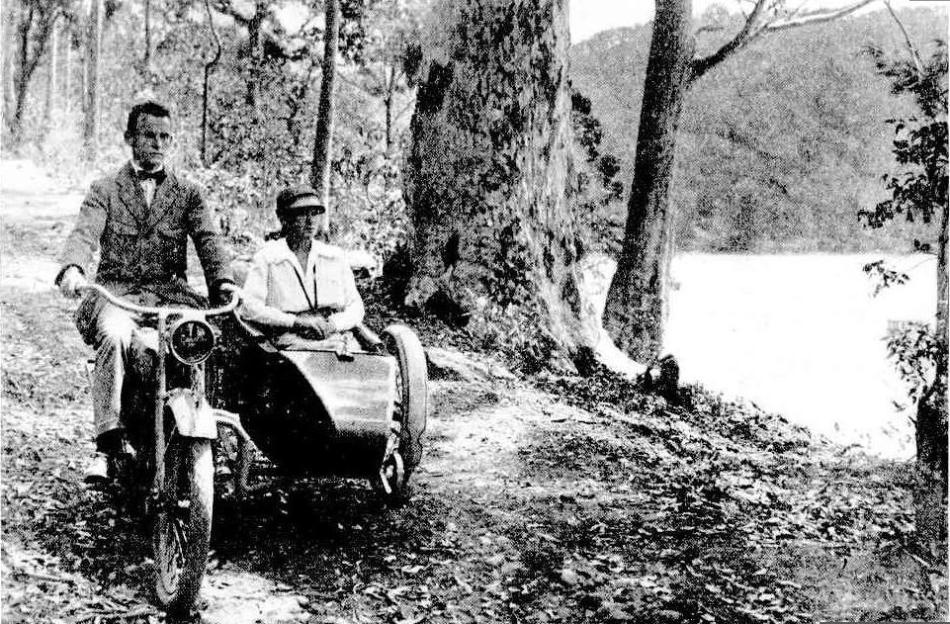
Along the foreshores of Broken Bay - 1918
The photograph was taken at Bayview, which overlooks lovely Pittwater, the southern part of Broken Bay into which runs the beautiful Hawkesbury River. The whole of this locality is wonderfully rich in scenic charms. ALONG THE FORESHORES OF BROKEN BAY. (1918, January 23). Sydney Mail (NSW : 1912 - 1938), p. 5. Retrieved from http://nla.gov.au/nla.news-article159026429
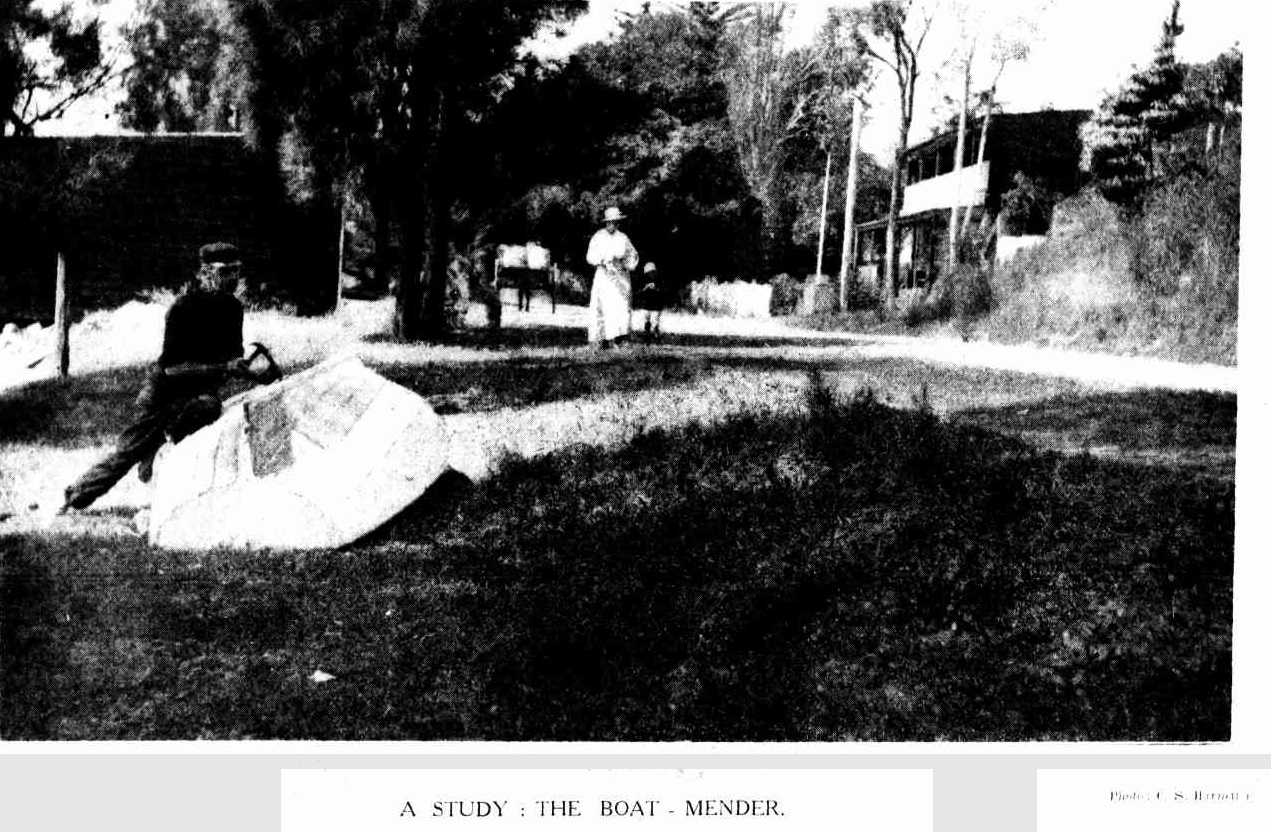
Metropolitan Water, Sewerage and Drainage Board, Sydney, 31st December, 1925.
NOTICE TO LAY SERVICE PIPES.
Notice to the Owners of Tenements and Premises IN Warringah Shire: Bay View road, from existing main to Mona-street, Mona-street, from Bay View road north-easterly 116 yards (80,711); Innes-road, from Condamine-street to Stuart-street; Stuart-street, from Innes-.road to Lovett-street; Lovett-street, from Stuart-street to existing main (80,693); Boroniastreet, from Daisy-street easterly 181 yards (80,692)
THE main pipe in 'the said street having been laid down, the owners of all tenements and premises situated at above are hereby required to cause a proper pipe and stop-cock to be laid, so as to supply water from the main pipe to such tenements and premises, within three weeks from the date of this publication. THOMAS ROSEBY, Secretary. NOTICE TO LAY SERVICE PIPES. (1925, December 31). Government Gazette of the State of New South Wales (Sydney, NSW : 1901 - 2001), p. 5785. Retrieved from http://nla.gov.au/nla.news-article223018370
Main Roads Dept. Received.' 4. Same 27.2.30 Pointing out that the temporary store erected on Bayview Road, Church Point, by H Jensen, has not been removed, although the six months allowed in the permit has expired.
48. Local Government Dept. 25.2.30. Advising the Council that Residential District No. 2 (Bayview and Church Point) was proclaimed in the Government Gazette as of 14th ult.
SHIRE OF WARRINGAH.
Addition to Scavenging Area,
NOTICE is hereby given that the Council of the abovenamed Shire has resolved that the boundaries of the Newport Scavenging Area shall be extended to embrace Mona Vale, Bay View and Church Point, the added area being bounded as follows:—
By Warriewood-road from the junction of that road with Pittwater-road to Macpherson-street; thence by the last named street to Narrabeen Creek; thence by Narrabeen Creek to Macpherson-street; again thence by that street northerly to Vineyard-street ; thence by the eastern boundaries of lots 33 and 14, Rock Lily Estate, to the south-east corner of Mona Vale Cemetery; thence by Emma-street to the south-east corner of lot 43 Rock Lily Estate; thence northerly by the eastern boundary of that lot and by Cahill Creek to Mona-street,; thence by Mona-street north-westerly to Cabbage Tree road; thence again north-westerly by the south-west boundaries of parish portions 30, 28, 27 and 26 ("Brown's Block") to McCarr's Creek; thence generally north-easterly by the high-water mark of that creek to Church Point Wharf; thence generally south-easterly by the high-water mark Pittwater Bay to The Avenue; thence easterly by the Avenue to Pittwater-road; thence in a direct easterly straight line to the Pacific Ocean; thence southerly by the high-water mark of the Pacific Ocean to the southeast corner of Black Swamp Reserve; thence northwesterly by the southern boundary of that reserve to the north-western corner of portion 13; thence southerly by the western boundary of that portion and portion 14 to the junction of Pittwater-road and Warriewood-road, that being the point of commencement.
R. G. JAMIESON,
Shire Clerk. Shire Hall, Brookvale, 24th December, 1926. SHIRE OF WARRINGAH. (1926, December 31). Government Gazette of the State of New South Wales (Sydney, NSW : 1901 - 2001), p. 5517. Retrieved from http://nla.gov.au/nla.news-article223001780
October 1928 NAMING AND RENAMING OF ROAD
Deputy Shire Clerk: (a) Request by A.R. May that an unnamed Road fronting his property at Dee Why West be named Maybrook Avenue. 20. Resolved that consideration be deferred pending a street further report. amen. (b) Request by L.P. Horton for rearrangement of the naming Of Kananook Avenue and Noolinga Road, Bayview, and recommending that the section of Noolinga Road between Pittwater Road and Kananook Avenue be renamed Kananook Avenue. 21. Resolved that the recommendation be adopted.
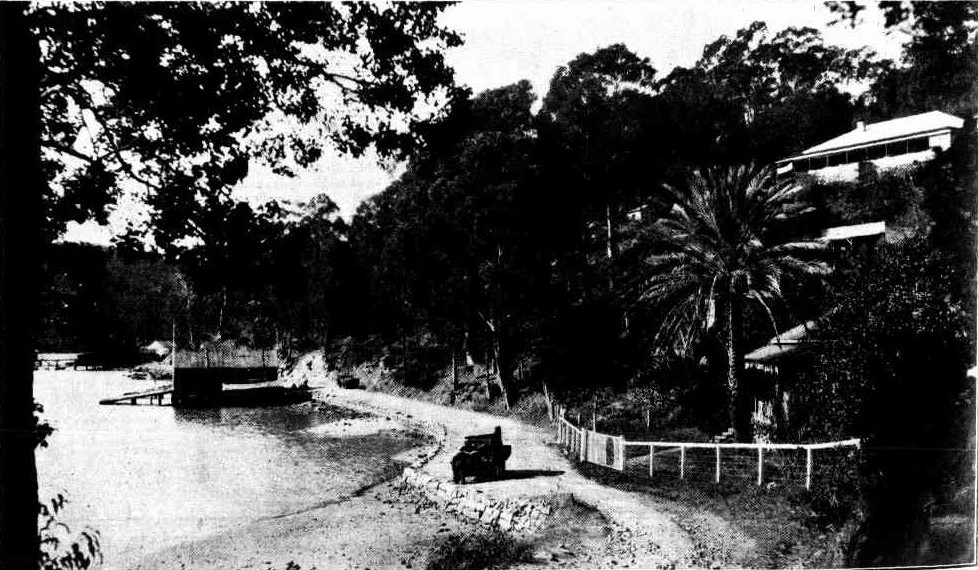
A Picturesque Motor Drive — View at Church Point (Pittwater), from McCarr's Creek. With the approach of warmer weather Sydney motorists are making preparations for outings to pleasure resorts near the city. The charms of the Manly and Pittwater districts and one of the most popular spots near Broken Bay is Church Point. MOTORING. (1929, August 28). Sydney Mail (NSW : 1912 - 1938), p. 45. Retrieved from http://nla.gov.au/nla.news-article160395048
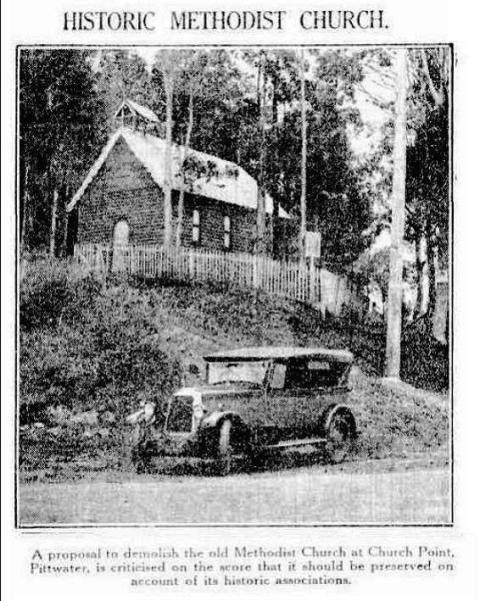
Above: HISTORIC METHODIST CHURCH. (1930, March 19). The Sydney Morning Herald(NSW : 1842 - 1954), p. 16. Retrieved from http://nla.gov.au/nla.news-article16634674
NOTIFICATION OF RESUMPTION OF LAND UNDER THE LOCAL GOVERNMENT ACT, 1919.
IN pursuance of section 536 (4) of tlie Local Government Act, 1919, and under Division 1, Part V, of the Public Works Act, 1912, I notify that so much of the land hereunder described as is Crown Land is hereby appropriated, and so much thereof as is private property is hereby resumed for a public recreation ground; and I further notify that the said land is hereby vested in the Warringah Shire Council.
Dated this seventeenth day of November, 1930.
M. A. DAVIDSON, Minister for Public Works.
Description of Land referred to.
All that piece or parcel of land situate at Bay View in the Shire of Warringah, parish of Narrabeen, county of Cumberland, and State of New South Wales, being lot 5 a, deposited plan 4,010: Commencing on the north-eastern side of Bay View road at the north-western corner of lot 6a of the said deposited plan 4,010; and bounded thence on the south-West by north-eastern sides of that road, being lines bearing 346 degrees 20 minutes 2 chains 18.55 links and 306 degrees 5 minutes 45.2 links respectively; on the north-west by the south-eastern boundary of lot 4, deposited plan 14,555, bearing 57 degrees 24 minutes 30 seconds 57.5 links; on the northeast by part of the south-western boundary of the northern portion of Reserve No. 45,642 from sale and 45,643 from lease generally for public recreation, notified 24th August, 1910, bearing 152 degrees .55 minutes 2 chains 95.5 links; and on the south by the northern boundary of the aforesaid lot 6a, deposited plan 4,010, bearing 265 degrees 49 minutes 30 seconds 95 links, to the point of commencement.—having an area of 27 perches or thereabouts, and said, to be in the possession of Bungarribee Ltd. (Misc. .1930-7,415) 1 (9380) NOTIFICATION OF RESUMPTION OF LAND UNDER THE LOCAL GOVERNMENT ACT, 1919. (1930, November 21). Government Gazette of the State of New South Wales (Sydney, NSW : 1901 - 2001), p. 4641. Retrieved from http://nla.gov.au/nla.news-article220233522
Sydney, 17th August, 1938.
DECLARATION OF ROADS TO BE PUBLIC ROAD
UNDER PROVISIONS OF SECTION 18, PUBLIC ROADS ACT, 1902.
I, the Right Honourable John de Vere, BARON Wakehurst, Governor of the State of New South "Wales, with the advice of the Executive Council, do hereby notify that the roads hereunder described, in pursuance of the provisions of section 18, Public Roads Act, 1902, are hereby declared to be public road, and dedicated to the public accordingly.
WAKEHURST, Governor.
COLIN A. SINCLAIR, Minister for Lands.
Descriptions.
Warringah Shire.
The parts of road known as Bay View road, lying between the existing public road B. 1,475b-1,603, and the present high-water mark of Pittwater fronting portions 43 and 27, parish Narrabeen; county Cumberland, Land District Metropolitan. R. 37-J,012. DECLARATION OF ROADS TO BE PUBLIC ROAD UNDER PROVISIONS OF SECTION 18, PUBLIC ROADS ACT, 1902. (1938, September 2). Government Gazette of the State of New South Wales (Sydney, NSW : 1901 - 2001), p. 3492. Retrieved from http://nla.gov.au/nla.news-article225072451
RELIEF WORKERS IN MOTOR CRASH 47 Involved - CRASH INTO TREE SYDNEY, Friday.
With the driver frantically trying to regain control, a motor lorry, carrying 47 relief workers to-day crashed Into a tree in Bayview Road, Bayview, throwing the men in all directions. But for the tree, the lorry would have fallen over a 6ft. drop Into Pittwater.
Nine of the men were taken to Manly District Hospital by Manly District Ambulance for treatment. Bushell, who was found to have suffered a probable fracture of the skull, and Tickner and Hyslop with severe lacerations and shock, were admitted to hospital. The others were allowed to leave.
The more seriously Injured men are: —John Bushell, 50, of Osborne Road, Manly, head injuries, large wound on right leg and right finger. Arthur Hyslop, 54, of Banksia Road. Dee Why, probable fractured left leg, Injuries to right arm. and probable internal injuries. Henry Tickner, 61. of Daisy Street, Dee Why abrasions to legs and severe shock. Other men, treated for minor injuries, were: —Arthur Brunette, G3, of High Street, Dee Why, Alonda Augustus Roney, 35,Bennett Street, Manly Vale; Herbert Pomfrett, of Headland Road. Curl Curl; Frederick Loxton, 40, of Dalley Street, Harbord; Charles Rowles, 50,of Pittwater Road. North Manly Arthur Smith, 44, of Pittwater Road, Brookvale. Ambulance treated several others at the scene of the accident for shock and minor abrasions.
The lorry was one of four conveying the men to the scene of roadway construction in progress at Church Point. Approaching a sharp bend in the road near Fermoy Avenue, the steering gear of the third lorry suddenly failed, and, failing to take the bend, the lorry crashed headlong into the tree, catapulting Its passengers into the air. Mr. Cedric Williams, who lives in Fermoy Avenue, about 50 yards from the accident scene, was at the rear of his home when a terrific crash was heard.
'We couldn't see what had happened from where we were,' he said, 'but before we could investigate, a man came running up, shouting out. 'We've had a smash at the bottom of the road. Quickly, can you give us some water.' The man's clothes were torn and he was covered In dust.' Mr. Williams provided the man with a can of water and with his mother accompanied him to the scene of the accident. ''It was an amazing sight. Men were lying everywhere.' he said. 'A local doctor, who had been called, was attending to the injuries of the men.' They certainly were lucky men, for the most part. Only for that tree, which prevented the truck from going into the water, some of them may have been drowned.' Manly District Ambulance was not long in arriving, and after first aid treatment was administered, nine of the men were taken to Manly Hospital. Miss Ruby Cowell, of Bayview post Office store, was standing at the doorway of a shop when she heard what she describes as a loud bang. 'Four trucks pass daily.' she said, 'and I had already seen two of them go by, and when I heard the crash. I guessed it was one of the other trucks.' Miss Cowell directed one of the relief workers to a telephone to call the ambulance. NINE INJURED. (1938, January 29). National Advocate(Bathurst, NSW : 1889 - 1954), p. 4. Retrieved from http://nla.gov.au/nla.news-article160704753
Warringah Shire Council Minutes of Meetings records
22.11.1938 19. The Shire Clerk reported that he had this day received a telephone message from Mr. Brooks, of the Public Works Department, that the new road constructed by the Government as unemployed relief, work from West Head Road via Coal & Candle Creek and McCarr’s Creek to Church Point would be completed in about a week's time, that it was proposed to hold an official opening by the Minister for Works & Local Government, probably on Saturday, 10th December, and the Department would like the Council to participate in the function. Resolved. That the party be entertained by the Council at "Pasadena", Church Point, at the expense of the Council, and the arrangements be left in the hands of the President. (Crs. Butcher, Nicholas)
Coal and Candle Creek road, alongside McCarrs creek, was actually completed soon after - the works had commenced at the other end as relief work too and went on in construction right up to WWII:
PUBLIC WORKS ACT, 1912.
Ku-ring-gai Chase Roads: McCarrs Creek Road.
Authorisation.
HIS Excellency the Governor, with the advice of the Executive Council, has authorised the carrying out under the provisions of the Public Works Act, 1912, as amended, of the work described in the Schedule hereto, the estimated cost of which does not exceed £20,000, and has approved of the Minister for Public Works being deemed the Constructing Authority.
Dated this sixth day of August, 1937.
E. S. SPOONER, Minister for Public Works.
Schedule.
McCarrs Creek road: Construction, subject to such deviations as may be deemed necessary by the Minister, of a road: Commencing within portion 26, parish of Narrabeen, county of Cumberland, and extending generally south-westerly along the south-eastern side of McCarrs Creek to The Upper Gledhill Falls, and extending-thence generally - westerly through the Ku-ring-gai Chase area to a point in West Head road, near the southern boundary of that area. PUBLIC WORKS ACT, 1912. (1937, August 6). Government Gazette of the State of New South Wales (Sydney, NSW : 1901 - 2001), p. 3225. Retrieved from http://nla.gov.au/nla.news-article224748056
Conditions for the workers, 500 in all according to this report, weren't ideal:
"DRINK WITH HORSES"
Shocking Conditions On Relief Job
MEN BEAT TEA BAN
SYDNEY.—"We would be pleased if you would publish some of the following complaints on the McCarr's Creek Road job," writes a representatives of the Manly-Warringah Council of Unemployed and Relief Workers.
"Last week the Public Works' Department made definite efforts to tighten up the already foul conditions on this job by instructing their gangers that the morning tea which the men had been having, more or Iess under the lap, had to stop, and the first man who attempted to boil the copper would be instantly dismissed.
"The Unemployed Council, not wishing to see anybody -victimised, decided to approach all the men on the matter, and it was decided that at 9.30 a.m. every worker in each gang down tools and walk over to the copper in a body and all take part In boiling the water. This was done while the gangers looked on and threatened that everyone would be docked half an hour, but this was not done.
HYGIENE
"This, I think, proves a victory for us, seeing that we are continuing to have it every day by the same methods. We have had several deputations to the engineer and head office on this and other matters and have explained that some of the men have to arise at 4 ajn. to get to this job, which means eight hours without anything to eat.
"Another serious matter is the fact that we' have no latrines on the Job. This may not sound so bad to some people, seeing that there is nothing but bush out there, we wouldn't mind, either, if we didn't have to drink the water which runs through the bush, and which the men ate forced to use. Another i thing: the horses have to drink from the same holes as us.
"The department did provide two tanks, but these had been used to preserve herrings in, and the water made some of the men sick. In any case, these are stored about a mile and a half from where' the bulk' of the men are working, the position when the hot weather comes oh.
ACCIDENTS
"Another very serious matter is the fact that we have no transport in case of bad accidents and no means of communication. The nearest telephone is five miles away. The department will not connect with the 'phone because it would cost about £60. Apparently it is not worth that amount to protect the lives of about 500 men for at least three years, which the job will take.
"Just before we close we would like to mention that two members of the Council were victimised over the morning tea trouble. These men were sent to other jobs and isolated. However, they were just on the tail-end of their two weeks on and will now be off for two weeks, so we will have to see what happens when they start again." “DRINK WITH HORSES” (1937, August 31). The Workers' Weekly (Sydney, NSW : 1923 - 1939), p. 4. Retrieved from http://nla.gov.au/nla.news-article211822157
NEW SCENIC ROADS.
Opening Up Kuring-gai Chase.
MANY IMPROVEMENTS.
Hundreds of men employed by the Public Works Department is ere engaged during the past year building roads which will eventually open up more of the scenic beauties of Kuring gai Chase.
Bobbin Head on a picturesque bend of Cowan Creek has long been a popular motor drive and the completion of the road through from the lodge gates at the Turramurra end of the Mount Colah enhance to the Chase provided what is considered to be one of the finest scenic trips In the metropolitan area. At the northern end it connects with the Pacific Highs leading to Brooklyn at the extremity of the Chase.
A deviation at Bobbin Head which is almost finished leads to Apple Tree Bay, where the trustees propose to reclaim about four acres for a picnic area and construct capacious baths.
Men have been engaged for some time in the construction of a road from Church Point near Pittwater to the head of McCarrs Creek and thence to Coal and Candle Creek opposite Bobbin Head. On its way this road junctions with West Head Road, recently completed a branch of the highway from Pymble to the northern beaches.
The chairman of the trust Mr. R B Orchard said these new roads opened up some of the most beautiful country around Sydney including parts of the Chase that had not accessible to tourists.
The trust is erecting a boatshed at Oyster Bay at the entrance to Coal and Candle Creek adding a refreshment room and conveniences for picnickers. The trust also has plans for further improvements at Bobbin Head where an adequate electric light supply has just been provided Eventually Orchard Park and other resorts in the vicinity will be lit up at night as will the approach roads It was estimated that 500 motorists used the parking area each week. Several times that number passed through on the new road to Mount Colah.
"We still have difficulty," Mr Orchard said protecting the native flora of the Chase. Prosecution of offenders during the year how-ever has had a salutary effect." NEW SCENIC ROADS. (1939, January 3). The Sydney Morning Herald (NSW : 1842 - 1954), p. 8. Retrieved from http://nla.gov.au/nla.news-article17560501
NEW SCENIC ROAD OPENS UP FRESH COUNTRY.
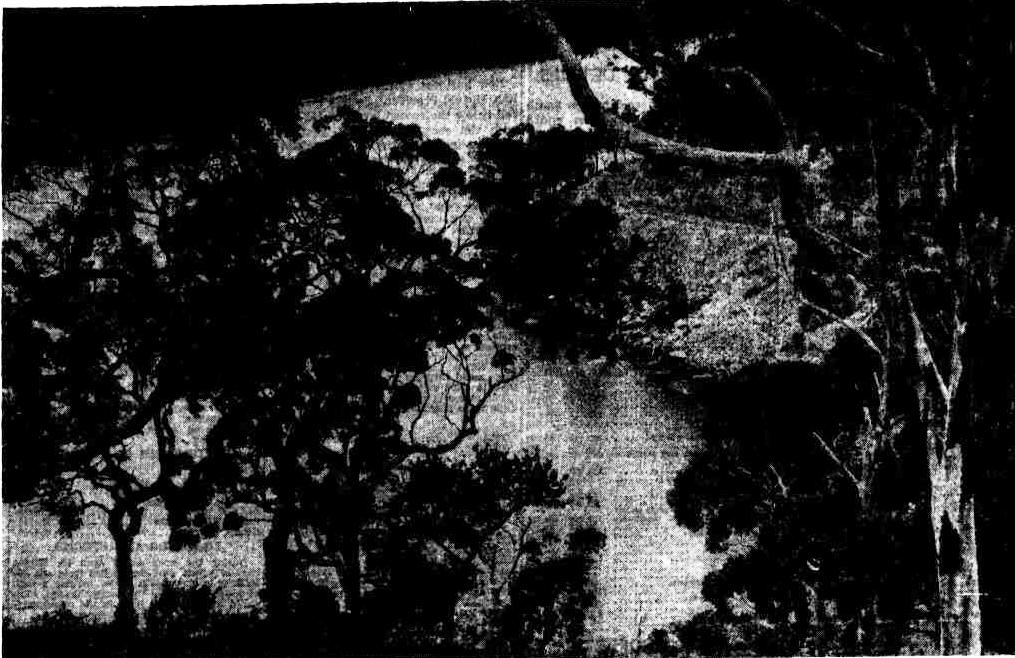
A glimpse of the quaintly-named Coal and Candle Creek from the new scenic road which is being constructed by the Public Works Department. As an accompanying article explains, this road can be reached from Church Point on the Pittwater or from Pymble. It runs through part of the area controlled by the Kuring-gai Chase Trust and opens to the motorist some of the wild and unspoilt areas of the Hawkesbury River country. NEW SCENIC ROAD OPENS UP FRESH COUNTRY. (1939, April 22). The Sydney Morning Herald (NSW : 1842 - 1954), p. 13. Retrieved from http://nla.gov.au/nla.news-article17570090
Relief Workers' Complaint
P. E. MEDANA (North, Sydney) writes: Last Thursday 60 men returning home from the McCarrs Creek relief job were held up for five hours when their bus Skidded into a ditch on the way to North Sydney. They had to wait until a breakdown truck arrived and repaired the bus. Yet— when a bus breaks down on the way to work, a relief bus is made available immediately, and only one hour is lost.
Wives were waiting at North Sydney for the men to get home— it was pay night— and the police station was besieged by anxious Inquirers. Children ran all over the suburb to see If other fathers had returned home yet. But families just had to wait patiently for five hours!
The least that could be done to compensate the men would be to pay them for that time. Australia will need every man to defend her shores— even the 200,000 unemployed. Is this the way to earn their co-operation?
Only If the Government eliminates the many injustices, such as the above, now meted out to relief workers, will It be on the road to getting that spirit.
I have been Instructed to write this letter as delegate for the men on the McCarr's Creek Job. Relief Workers' Complaint (1939, April 24). Daily News (Sydney, NSW : 1938 - 1940), p. 4. Retrieved from http://nla.gov.au/nla.news-article236292374
More Warringah Shire Council Minutes of Meetings records pertaining to this road and those on either side of it and their activities during World War Two:
34. Land Board Office, 9/2/40, further re A. J. Riddle's application for extension of term of his Special Lease for boat shed &c at Pittwater off Church Point, stating Main Roads Department is agreeable to the extension, provided 48 ft. is left from the centre of the existing formation of Bayview Road Lease for future road-widening; requesting Council's concurrence in the extension desired. Resolved, - That the Council concur in the extension. 35. Palm Beach Lands Ltd.,12/2/40, (a) forwarding cheque for • 4.00 for improvement of Norma Road, as arranged, and requesting Norma that the work be proceeded with as early as possible; (b) requesting that as a settlement has now been arrived at, the this its
30. Pittwater Aquatic Club, 17/6/40, advising that on account Bayview of the war the Club has found it necessary to suspend operations, and is unable to pay its debt of £15 to the Council. Referred to the Works Committee. 31. Condmaine & Progress Anzac., 18/6/40, requesting Council to investigate the possibilities of establishing a road from Manly Vale and adjacent areas to Main Road No. 397, suggesting that a good road could be built from Sunshine Street without engineering difficulties. Resolved, - That the Association be informed that
3. Proposals for Declaration of Additional "Brick Areas" - Report submitted to Council on 18/2/41: Resolved, - That the Council, in exercise of the power given it by Clause 22 (f) of Ordinance 71, hereby declares the following lands to be within "brick areas" and prohibits the erection on such lands of buildings with external walls of materials other than brick, stone or concrete or the like materials, viz - A. All lands having frontage to Main Roads Nos. 159 and 164 (Pittwater Road, Newport Road, Barrenjoey Road and Ocean Road) Brick from the southern boundary of the Shire at Manly Lagoon to the Areas southern extremity of Ocean Road at Palm Beach, except, (i) lands fronting Pittwater Road from Powderworks Road intersection northerly to Warriewood Road intersection; (ii) lands facing Barrenjoey Road from Attunga Road northerly to Plateau. Road intersection; (iii) lands facing Barrenjoey Road from Careel Head Road intersection northerly to the southern end of Iluka Road at its intersection with Barrenjoey Road; and (iv) lands fronting Barrenjoey Road from Palm Beach Road intersection northerly to Very's property, being Lot 5, D.P.6746 and Lot B. of a resubdivision of Lot 4, D.P. 6746. B. All lands having frontage to or bounded by Condamine Street (Main Road No. 164) in its new location. C. All lands having frontage or bounded by Main Road No, 174. (Bayview Road) from its intersection with Main Road No. 164 (Pittwater Road) at Mona Vale to its north-western extremity at Church Point. (Crs. Sterland, O'Reilly) (A proposed amendment moved by Cr. Campbell, seconded by Cr. Savage, that consideration be deferred for another three months was defeated, and the above motion was carried on division by four votes to three.
More resumptions - hopefully those named weren't engaged elsewhere, defending their country for example, and returning home to a 'surprise'. What all these resumptions indicate is that land once rural, with a track through to other farms further on, has now become a place where the suburban lot is more common and roads to access these and car parking spots, has become the 'landscape'. With no government having made provision for that future need, land resumptions, in increments quite small at times in order to widen roads, were the only way to achieve the making of access through what had been paddock, orchard and bushland. The era of settlers being expected to make their own tracks and roads were long gone:
Sydney, 26th January,. 1944.
RESUMPTION AND WITHDRAWAL OF LAND AND DEDICATION OF ROAD UNDER SECTIONS 9 AND II, AND DECLARATION OF ROADS TO BE PUBLIC ROAD UNDER SECTION 18, PUBLIC ROADS ACT, 1902, AND OF THE CLOSING OF ROADS.
I, the Right Honourable John de Verb, Baron Wakehuest, Governor of the State of New South Wales, with the advice of the Executive Council, do hereby notify that in accordance with the provisions of sections 9 and 11, Public Roads Act, 1902, the lands described hereunder and required for the roads I specified, shall be and are hereby resumed and withdrawn and dedicated as public road; and in accordance with the provisions of section 18 of such Act, the roads described hereunder are hereby declared to be public road and dedicated to the public accordingly; and also that the roads hereunder specified (intended closing of which has been duly notified), are hereby closed.
WAKEHURST, Governor.
J. M. TULLY, Minister for Lands.
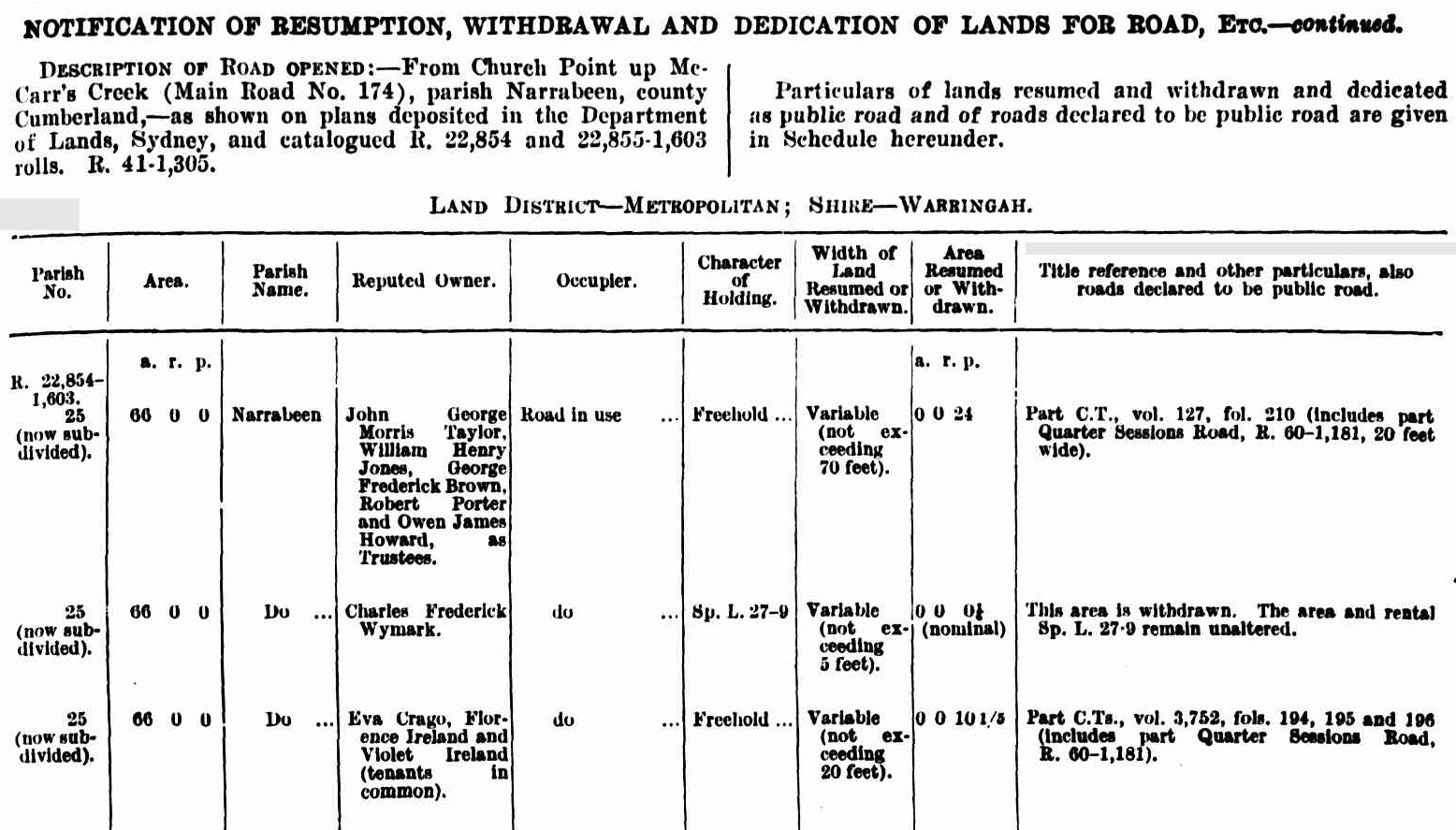
.jpg?timestamp=1542760263135)
.jpg?timestamp=1542760300832)
RESUMPTION AND WITHDRAWAL OF LAND AND DEDICATION OF ROAD UNDER SECTIONS 9 AND 11, AND DECLARATION OF ROADS TO BE PUBLIC ROAD UNDER SECTION 18, PUBLIC ROADS ACT, 1902, AND OF THE CLOSING OF ROADS. (1944, February 11). Government Gazette of the State of New South Wales (Sydney, NSW : 1901 - 2001), p. 266. Retrieved from http://nla.gov.au/nla.news-article225093640
Just as at Newport and Avalon, as sen in Roads In Pittwater; The Barrenjoey Road, this area of Pittwater had some marsh areas, what was then called 'The Newport Maze' as much as that area of Bayview-Mona Vale we now call Winnermerrey and the Bayview Golf course range, that was a wetland fed by creeks. On the other side of Barrenjoey road, at its junction with Mona Vale's Village Park, was the area known as the Black Swamp. The emphasis was always on going against the natural 'flow' by draining, 'reclaiming' by filling in such areas so they could be used for farming, for sport, for building homes on:
Department of Public Health, Sydney.
PUBLIC HEALTH ACT, 1902-3944—SECTION 55.
Area No. 542.
Unhealthy building land at Mona Vale, Shire of Warringah.
THE Board of Health have reported that after due inquiry they are of the opinion that it would be prejudicial to health if certain land situated in the Shire of Warringah, and described in Schedules hereunder, were built upon in its present condition. The Board of Health have further reported that in order to render such land fit to be built upon it is necessary that:—
(a) The land be adequately drained by properly constructed stormwater channels and by subsoil drains;
(b) The surface of the land comprised in Schedule 1 be raised with clean soil at the shore of Pittwater to a height of four feet about the datum shown on plan of this area at the Department of Public Health, and at Mona street and Bay view-road to the height of the adjacent crown of that street or road, rising from the shore, and from the street or road on an even grade of one in 300;
(c) The surface of the land comprised in Schedule 2 be raised with clean soil at Mona-street to the height of the crown oi' Mona-street, and at the stormwater channels specified in clause (a), to a height twelve inches above the level of the natural surface of the land, rising from Mona-street and from the aforesaid channels on a grade of one in 200;
(d) Floors of buildings erected thereon be laid on joists, the undersides of which shall be not loss than. 18 inches above the surface of the land when raised;
(e) All work be done to the satisfaction of the Board of Health.
Now, therefore, in pursuance of the power and authority vested in me by section 55 (1) of the Public Health Act, 3902-1944, I hereby declare that such land shall not be built upon until the measures above referred to, which are also specified in a document deposited in the office of the local authority (the Council of the Shire of Warringah) and open to the inspection of any person, have been complied with or until this notice has been revoked by me.
C. A. KELLY, Minister for Health.
Schedule 1.
Commencing at a point being the intersection of the eastern side of Bayview-road with the northern boundary of the northern part of portion 19; and bounded thence on the north by the aforesaid northern boundary south-easterly to the north-eastern corner of portion 19; thence by the highwater mark on the shore of Pittwater generally north and north-east to the south-western side of Waterview-street, being the northernmost corner of lot 1, section B, shown on plan 4,390 (L); thence by Waterview-street and the Esplanade south-westerly and southerly to the easternmost corner of lot 20, section B; thence by a line south-east to a point oil the north-western side of Mona-street, being 150 feet distant and north-east from Darwin-street; thence by Mona-street south-westerly to Bayview-road; thence by Bayview-road northerly to the point of commencement.
Schedule 2.
Commencing at a point on the south-eastern side of Mona-street, being 513 feet distant and south-westerly front the southernmost intersection of Mona-street with Waterview-street ; and bounded thence on the east by a line southerly to the southernmost corner of lot d{ thence by a line south-westerly to the northernmost corner of lot 56, section 1, plan 680 (L); 1 hence by Basset-street south-easterly to Newport-road; thence by Newport-road southerly to Polo-avenue; thence by a line westerly lo !he north-eastern corner of lot 25, d.p. 5,497; thence by the eastern boundaries of lots 25, 26 and 27 southerly to the most southerly corner of lot 27; thence by a line southerly lo a point on the south-western boundary of lot 3, d.p. 5,497, being 80 feet north-westerly from the south-eastern corner of lot 3; thence by a line parallel to Newport-road south-westerly to the north-eastern boundary of lot 6, d.p. 16,794; thence by the north-eastern boundary of lot 6 south-easterly to Newport-road; thence by Newport-road south-westerly to Darley-street; thence by Darley-street north-westerly to By-the-Sea-road; thence by a line northerly to the easternmost corner of lot 31, d.p. 5,497; thence by the north-eastern boundary of lot 31 north-westerly to the northernmost corner of lot 31; thence by a line north-westerly to a point on the north-western boundary of lot 61, section 1, plan 680 (L), being 350 feet distant and north-easterly from Darley-street; thence by a line bearing 275 degrees 170 feet; thence by a line bearing 210 degrees to its intersection with the north-eastern side of Darley-street; thence by a line south-easterly to the northernmost corner of lot 27, section ]. plan 680 (L); thence by the northwestern boundary of lot 27 south-westerly 60 feet; thence by a line parallel to Darley-street south-easterly to the south-eastern boundary of lot 27; thence by that boundary north-easterly to Darley-street; thence by Darley-street south-easterly 330 feet; thence by the following lines in succession, i.e., a line bearing 260 degrees 330 feet; a line bearing 284 degrees 300 feet; a line bearing 318 degrees 180 feet; tlienee by a line northerly to the northernmost corner of lot 21, section 1, plan 680 (L) ; thence by a line north-westerly to the southernmost corner of lot C, being a subdivision of lot 57, section 1, plan 680 (L) ; thence by a line bearing 328 degrees 520 feet; thence by a line northerly to the southernmost corner of lot 51, section" 1, plan 680 (L); thence by the south-eastern boundary of lot 51 northwesterly to Mona-street; thence by Mona-street north-easterly to the point of commencement. PUBLIC HEALTH ACT,]902-1944—SECTION 55. (1946, March 22). Government Gazette of the State of New South Wales (Sydney, NSW : 1901 - 2001), p. 657. Retrieved from http://nla.gov.au/nla.news-article224762229
SHIRE OF WARRINGAH.—Road Levels.—Notice is hereby given that the Department of Main Roads, acting on behalf of the Warringah Shire Council, intends to carry out work on Main Road No. 174, Bay view-road, between Bayview and Church Point, necessitating the fixing of levels for this road. Plans showing the new levels may be inspected during office hours at the Shire Hall, Brookvale. All persons interested may lodge objections or claims in writing (addressed to me) within one month from date hereof. W. U. GORS, Shire Clerk, Council Chambers, Brookvale, 7th October, 1949. 2865—10s. SHIRE OF WARRINGAH.—ROAD LEVELS.—Notice is hereby given that the Department of Main Roads, acting on behalf of (1949, October 7). Government Gazette of the State of New South Wales (Sydney, NSW : 1901 - 2001), p. 2998. Retrieved from http://nla.gov.au/nla.news-article225592257
The building of a wider Bayview road required taking land from numerous local owners - examples here indicate that stretch between Park Street at Mona Vale and past the Bayview Golf Course:
TRANSPORT (DIVISION OF FUNCTIONS) ACT, 1932-1947.
—MAIN ROADS ACT, 1924-1949— PROCLAMATION.
(r_.s.) J. NORTHCOTT, Governor.
I, Lieutenant-General John Northcott, Governor of the State of New South Wales, in the Commonwealth of Australia, with the advice of the Executive Council and by virtue of the provisions of the Transport (Division of Functions) Act, 19323947, and in pursuance of the provisions of the Main Roads Act, 1924-1949, do, by this my Proclamation, declare that so much of the land hereunder described as is Crown land is hereby appropriated, and so much thereof as is private property is hereby resumed under the provisions of the Public Works Act, 1912, for the purposes of the Main Roads Act, 1924-1949, and that the land hereunder described is hereby vested in the Commissioner for Main Roads, and I hereby further declare the land hereunder described to be a public road, and, in accordance with a recommendation of the Commissioner for Main Roads, the said land is hereby placed under the control of the Council of the Shire of Warringah.
Signed and sealed at Sydney, this fifth day of April, 1950.
By His Excellency's Command,
M. O'SULLIVAN, Minister for Transport.
GOD SAVE THE KING!
Descriptions of the Land referred to.
All that piece or parcel of land situate in the Shire of Warringah, parish of Narrabeen, county of Cumberland, and. Stale of New South Wales, being part of lots 5a to 12a inclusive, deposited plan 4,010, part of portion 19, parish arid county aforesaid, part of lot 11, section 1, Mona Vale Estate, part of lot A as shown on plan in Dealing B93666, and part of a reserve for public recreation: Commencing at the intersection of a north-eastern side of Bayview-road with the northwestern boundary of lot 5a aforesaid; and bounded thence on the north-west by that boundary of that lot bearing 57 degrees 20 minutes 37 feet 74 inches to the north-eastern boundary of lot 5a, aforesaid; thence on the north-east by part of that boundary of that lot bearing 152 degrees 55 minutes 81 feet 7 ½ inches; again on the north-east, the east and again on the north-east by marked lines bearing consecutively 189 degrees 5 minutes 5 seconds 880 feet 1 inch, 170 degrees 51 minutes 35 seconds 82 feet 6| inches, 174 degrees 24 minutes 30 seconds 82 feet 6& inches, 177 degrees 57 minutes 25 seconds 52 feet inches 181 degrees 30 minutes 20 seconds 82 feet 6| inches, 183 degrees 16 minutes 50 seconds 678 feet 10 inches, 181 degrees 6 minutes 10 seconds 96 feet inches, 16 degrees 44 minutes 45 seconds 96 feet 3 ½ inches, 172 degrees 23 minutes 20 seconds 96 feet 3 ½ inches, 168 degrees 1 minute 55 seconds 96 feet 3| inches, 163 degrees 40 minutes 30 seconds 9(3 feet 3£ inches, 159 degrees 19 minutes 5 seconds 96 feet 3 ½ inches, 154 degrees 57 minutes 40 seconds 96 feet 3 ½ inches, 150 degrees 36 minutes 40 seconds 06 feet and 146 degrees 15 minutes 20 seconds 96 feet 7 ½ inches to a north eastern side of Bayview-road; thence on the south-west, the north-west, the west, again on the south-west, again on the west and again on the south-west by that road bearing consecutively 324 degrees 4 minutes 10 seconds 240 feet 9| inches, 344 degrees 18 minutes 10 seconds 746 feet 11 inches, 31 degrees 47 minutes 10 seconds 157 feet 6 ½ inches, 4 degrees 56 minutes 10 seconds 460 feet 4| inches, 347 degrees 3; minutes 271 feet 9 ½ inches, 352 degrees 30 minutes 440 feet 101 inches, 346 degrees 23 minutes 15 seconds 425 feet 6J inches and 306 degrees 8 minutes 15 seconds 29 feet 10 inches to the point of commencement,—having an area of 1 acre 3 roods -5 perches or thereabouts, and said to be in the possession of the estate of the late John Orr, the estate of the late A. R. Percy, F. G. Larson, F. E. T. Lewis, the Council of the Shire of Warringah, the Crown and others.
Also, all that piece or parcel of land situate in the Shire of Warringah, parish of Narrabeen, county of Cumberland, and State of New South Wales, being part of lot 2, section 1, Mona Vale Estate, and part of lot 6, section 1, deposited plan 6,392: Commencing at the intersection of the north-western boundary of lot 6 aforesaid with a south-western side of Bay view-road; and bounded thence on the north-east by part of that side of that road bearing 169 degrees 6 minutes 20 seconds 125 feet 10| inches; thence on the south-west by marked lines bearing consecutively 346 degrees 36 minutes 10 seconds 49 feet 6 inches, 311 degrees 35 minutes 40 seconds 49 feet 6 inches, 336 degrees 35 minutes 15 seconds 49 feet 6£ inches, 331 degrees 34 minutes 50 seconds 49 feet 63 inches and 326 degrees 34 minutes 20 seconds 49 feet 6 inches to a south-western side of Bayview-road; again on the north-east by part of that side of that road bearing 144 degrees 4 minutes 30 seconds 125 feet 10§ inches to the point of commencement, —having an area of 4 perches or thereabouts, and said to be in the possession of the estate of the late J. Orr and Mrs. Christina D. Orr.
Also, all that piece or parcel of land situate in the Shire of Warringah, parish of Narrabeen, county of Cumberland, and State of New South Wales, being part of lot 1, section 1, deposited plan 6,392: Commencing at the intersection of a south-western side of Bayview-road with a north-eastern side of Darley-street; and bounded thence on the south-west by part of that side of that street bearing north-westerly 8 feet; thence on the north-west by a marked line bearing north-easterly 6 feet 7 inches to the south-western side of Bayview-road aforesaid; thence on the north-east by part of that side of that road bearing south-easterly 8 feet to the point of commencement,—having an area of 24 square feet or thereabouts, and said to be in the possession of Mrs. Christina D. Orr.
Also, all that piece or parcel of land situate in the Shire of Warringah, parish of Narrabeen, county of Cumberland, and State of New South Wales, being part of lot 1, section 2, deposited plan 6,392: Commencing at the intersection of a north-eastern side of Bayview-road with a south-western side of Darley-street; and bounded thence on the north-east by part of that side of that street bearing south-easterly 8 feet; thence on the south-east by a marked line bearing south-westerly 6 feet 8 inches to the north-eastern side of Bayview-road aforesaid; thence on the south-west by part of that side of that road bearing north-westerly 8 feet to the point of commencement,—having an area of 24 square feet or thereabouts, and said to be in the possession of Irene A. Westmoreland.
Also, all that piece or parcel of land situate in the Shire of Warringah, parish of Narrabeen, county of Cumberland, and State of New South Wales, being part of lots 1, 2 and 3, section 2, deposited plan 6,392: Commencing at the intersection of the north-western boundary of lot 2 aforesaid with a northeastern side of Bayview-road; and bounded thence on the south-west by parts of north-eastern sides of that road bearing 329 degrees 5 minutes 7 feet 4 inches and 348 degrees 54 minutes 50 seconds 169 feet 0-} inch; thence on the northeast by marked lines bearing consecutively 166 degrees 29 minutes 30 seconds 81 feet 8| inches, 161 degrees 38 minutes 50 seconds 81 feet 8| inches, 156 degrees 46 minutes 5 seconds 82 feet 10i inches and 152 degrees 2 minutes 25 seconds 78 feet 2f inches to a north-eastern side of Bayview-road aforesaid; again on the south-west by part of that side of that road bearing 329 degrees 5 minutes 151 feet 8 inches to the point of commencement,—having an area of 6 perches or thereabouts, and said to be in the possession of Irene A. Westmoreland, E. C. Seale and G. M. Bushnell.
And also, all that piece or parcel of land situate in the Shire of Warringah, parish of Narrabeen, county of Cumberland, and State of New South Wales, being part of lot 7 as shown on plan 6,546 (L) at the Registrar-General's Office; Commencing at the intersection of a south-western side of Bayview-road with a north-eastern side of Park-street; and bounded thence on the south-west by part of that side of that street bearing north-westerly 12 feet; thence on the northwest by a marked line bearing north-easterly 6 feet 0| inch to the south-western side of Bayview-road aforesaid; thence on the north-east by part of that side of that road bearing south-easterly 12 feet to the point of commencement,—having an area of 35 square feet or thereabouts, and said to be in the possession of G. E. Johnson.
(D.M.E, No. 479-1,523) TRANSPORT (DIVISION OF FUNCTIONS) ACT, 1932-1947. —MAIN ROADS ACT, 1924-1949.—PROCLAMATION. (1950, April 21). Government Gazette of the State of New South Wales (Sydney, NSW : 1901 - 2001), p. 1079. Retrieved from http://nla.gov.au/nla.news-article220099707
A scene of a murder, a tragic incident, gives us a photo that shows the surface of the road between Church Point and McCarrs in 1952:
Taxi-driver Found Shot In The Head
Edward Joseph Fisher, 29, the Deewhy taxi driver who had been missing since early on Saturday, was found dead, in a culvert under McCarr's Creek, near Church Point, yesterday. He had been shot in the back of the head.
Mrs. C. F. Wymark, wife of the proprietor of the Pasadena Roadhouse, Church Point, gave information which helped to lead the police to the murder spot. She was nearly knocked down by Fisher's taxi, which was then being driven by a "thin man" who is believed to be the murderer. Having seen a description of the taxi in the Sunday papers, she immediately rang the police.
DASH-28 Police Cars
More than 28 car loads of detectives and police dashed to Church Point. Soon, Detective - Sergeant Humphries and Detectives Grubb, Barnard, and Martin, of 21 Division, found Fisher. He was completely hidden in the culvert, lying face down in the water. The police cordoned off a section of the road. They turned back hundreds of Sunday afternoon motorists,
The culvert runs for 60ft under McCarr's Creek Road.
Detectives believe the murderer carried Fisher down a 10-foot embankment, then dragged him feet first into the culvert, which is 2ft 6in in diameter.
HUNT-Clues Taken Away
Detectives yesterday hunted round the pipe and crawled through it searching for clues. Detectives A Clarke and N Merchant, of [the Scientific Bureau, took a number of exhibits.
They think robbery was the motive for the murder. Taxi-driver Found Shot In The Head. (1952, June 30). The Sydney Morning Herald (NSW : 1842 - 1954), p. 1. Retrieved from http://nla.gov.au/nla.news-article18271021
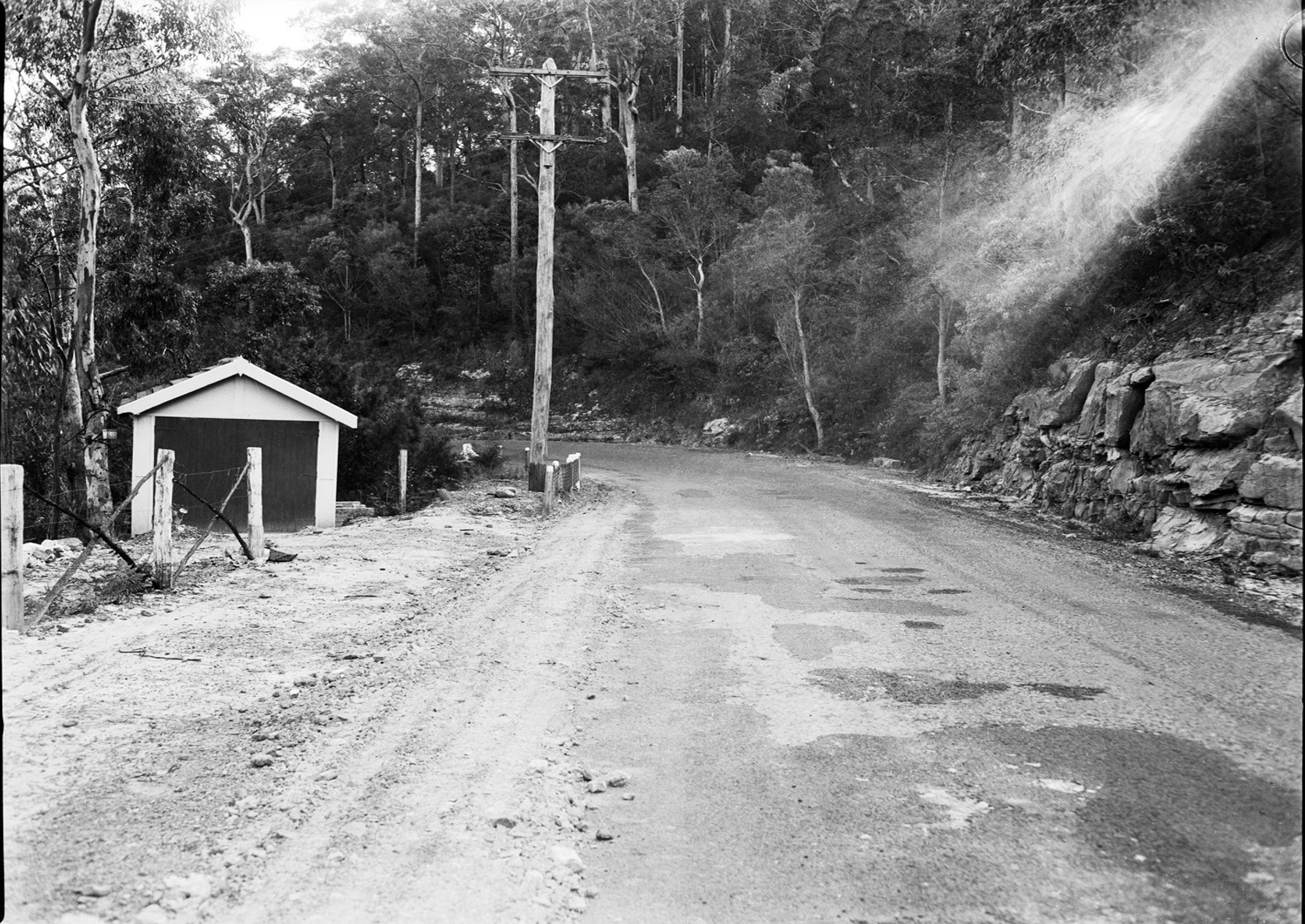
Scene of murder, Church Point - 29 June 1952. Created by New South Wales. Police Dept.
HOW THE KILLER GOT AWAY
The police have pieced together the movements of Fisher's taxi on Saturday from information supplied by numerous telephone callers. This is the picture they have got:
8 A.M.-Fisher left home to start work.
10.30.-Taxi seen by Mr. C. Clark, whose Church Point store is about three-quarters of a mile from the culvert where Fisher was found.
WIFE-"Had To Skip"
10.45_Mrs. Wymark, on her way to buy groceries, heard the taxi coming, with its engine full-out. She said yesterday "If I hadn't skipped out of the way it would have hit me. We very rarely see coloured taxis out here They are mostly private hire cars. That is why I noticed its cream and orange colour. When I saw the description in the Sunday papers I immediately told the police "
The taxi was travelling towards Mona Vale
10.55-Mr C Williams ambulance officer at Bayview, saw the taxi rush past the ambulance station, heading for Mona Vale.
“I knew Fisher and I know his taxi," he said "Every time he went past he hooted his horn to say good day.
"I was in the garden, but this time there was no hoot "
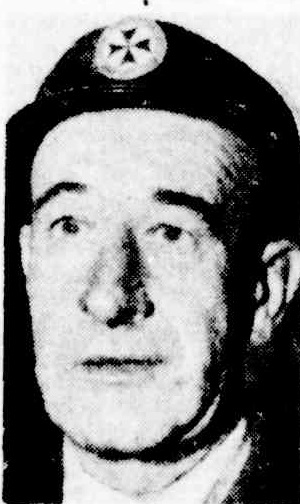
MR. C. WILLIAMS
11.30.-Mr M Daddry, of Roseville Road, Beacon Hill who works for the same employer as Fisher did was looking out of the window with his wife and saw the taxi on Pittwater Road going towards the city
Mr. Daddry slid to his wife, ‘Gee, Ted must be late to work.'
12 10 pm-Mr Chris Mallis who owns Fisher’s cab saw the taxi being driven along Oxford Street city by a thin stranger He challenged him and the man got out of the cab. He ran away as Mr. Malus was questioning him.
The police believe that Fisher, who lived in Oaks Avenue, Deewhy, was murdered at about 10 a.m. on Saturday.
They want to interview a man aged about 18 to 20, 5ft 7in to 5ft 11in tall, very thin build, fairly fair complexion clear skin, very fair hair, parted on left side (hair on right side of parting tends to stand up a little), thin features, clean shaven. He was dressed in a brown, possibly check, sports coat, sports trousers, and white shirt.
It is believed Fisher may have been in the back of the car dead for some time before the killer dumped him in the culvert.
After Mr. Malus took over the taxi in Oxford Street, detectives found a .22 cartridge shell and Fisher's wrist watch and a cigarette lighter on the back seat. Later, a Paddington man found a sawn off 22 calibre rifle in his backyard He handed it to police
SEARCH-Scrub And Roads
On Saturday night, Superintendent H E Snowden, Detective Inspector J Rogers and Detective Inspector M F Calman organised yesterdays big police search. They scientifically searched roads and dense scrub over a wide area.
They are searching for a fibre seat cover which was missing from the murdered man's taxi.
They appeal to anyone who finds it to contact the C.I.B. immediately.
Detective-Inspector J. Rogers, Detective-Inspector M. Caiman, Detective-Sergeant Crowley, Detectives W Cannings and K. Brown, and other C.I.B. men are leading the hunt for the killer
Police are impressed by similarity of the murder with the Southport taxi-murder last month. The blood-stained taxi of Athol Henry McCowan was found on the seafront at South-port, near Brisbane, towards the end of May. McCowan was found murdered in a creek a week later after a manhunt in which more than 1,000 people took part. His murderer has not yet been found. HOW THE KILLER GOT AWAY. (1952, June 30). The Sydney Morning Herald (NSW : 1842 - 1954), p. 1. Retrieved from http://nla.gov.au/nla.news-article18271020
Taxi Murder Inquest
SYDNEY: A witness at the inquest on murdered Sydney taxi-driver, Joseph Edward Fisher, Identified a Victorian youth as the driver of the dead man's taxi.. The witness, Edward Russell Notting, contractor, of Lovett Bay, near Church Point, pointed out to the City Coroner ] (Mr. Forests S.M.), Peter Mannington Harvie (17), of Eildon, Victoria.
Harvie, who has been charged with the murder of Fisher, was present in court in custody.
Fisher's body was found in a culvert at Church Point, on June 29. Taxi Murder Inquest (1952, July 25). The Armidale Express and New England General Advertiser (NSW : 1856 - 1861; 1863 - 1889; 1891 - 1954), p. 1. Retrieved from http://nla.gov.au/nla.news-article194175135
'Confession' At Murder Trial
SYDNEY: A solicitor said in the Central Criminal Court today that an alleged admission of guilt by his 17-year-old client, Peter Mannington Harvie, charged with the murder of 29-year-old taxi-driver, Joseph Edward Fisher, at Church Point on June 28 last, would not be challenged.
The solicitor, Mr. J. W. Binney, appeared for Harvie, a farm hand, who pleaded not guilty. Harvie wrote copious notes on the dock table ledge as the Crown case against him was being unfolded, and he whispered frequently through the dock bars to his solicitor The Crown alleged that Harvie. who had come to Sydney from Eildon (Vic.), feloniously and maliciously murdered Fisher, who lived at Oaks Ave., Dee Why, by shooting him with a sawn-off rifle in the back of the head while he was a passenger in Fisher's taxi. The Crown further alleged that Harvie then dragged Fisher's body into a nearby culvert and drove the taxi back to Sydney, picking up a fare to Manly on the return journey. The Crown Prosecutor (Mr. Harvey Prior) read to the court an alleged confession of guilt by Harvie, which had been written in his own handwriting.
Alleged Confession
The alleged confession in part, read: 'I hailed a taxi at Manly and told the driver to go to Church Point. He took me there. I told the driver to stop and he did. As he backed to turn round, I drew the gun and fired at his head. I got into the front seat, pushed him over and drove back to the culvert. I dragged him into the culvert.' Mr. Binney then informed the Crown Prosecutor that he would not attack the statement.
Edward Russell Notting, contractor, Church Point, said that at 10.45 a.m. on June 28 he saw a taxi back out on to Bay View-rd. and go off at great speed in top gear to a nearby parking area. 'The cab pulled up, the driver got out and asked for general directions and names of surrounding roads, ' said Notting. 'He then got back into the cab and drove off at reckless speed, again in top gear.'
Archibald John Fitzgerald, P.M.G. linesman, of Morella-rd., Dee Why, said that about noon on June 28 be hailed a taxi at the corner of Pittwater-rd. and Roseville-rd. Fitzgerald said that the cab was driven in an amazing manner and he was so perturbed when he got out of it at Manly that be took the number — 1157 — and reported it to a policeman. Fitzgerald told the court that later out of a line up of 12 men at the C.I.B. he had identified Harvie as the driver of the taxi.
Christos Mallos, taxi operator and driver, of Bellevue St., Manly, said that he owned the taxi numbered 1157, which had been driven by Fisher. At 12.30 p.m. on June 28, he was driving his own taxi along Oxford St., Paddington, when taxi 1157 passed him. (Proceeding) 'Confession' At Murder Trial (1952, September 10). The Newcastle Sun (NSW : 1918 - 1954), p. 2. Retrieved from http://nla.gov.au/nla.news-article160336772
The last execution in New South Wales was carried out on 24 August 1939, when John Trevor Kelly was hanged at Sydney's Long Bay Correctional Centre for the murder of Marjorie Constance Sommarlad. New South Wales abolished the death penalty for murder in 1955, but retained it as a potential penalty for treason, piracy, and arson in naval dockyards until 1985. New South Wales was the last Australian state to formally abolish the death penalty for all crimes.
The last person executed in Australia for murder occurred in Victoria when Ronald Ryan was the last man executed at Pentridge Prison. He was hanged on 3 February 1967 after being convicted of the shooting dead a prison officer during an escape from Pentridge Prison, Coburg, Victoria in 1965. Ryan was the last of 186 executions.
Victoria was also the state of the last woman executed in Australia. Jean Lee was hanged in 1951. She was accused of being an accomplice in the murder of 73-year-old William ('Pop') Kent. She, along with her accomplices, were executed on 19 February 1951. Victoria would not carry out another execution until that of Ronald Ryan.
Those under 18 could not be executed:
Life Imprisonment For Youth Who Killed Taxi-driver
Peter Mannington Harvie, 17, was found guilty in the Central Criminal Court yesterday of the murder of Joseph Edward Fisher, 29, taxi-driver, on June 28, and sentenced to imprisonment with hard labour for life.
Harvie, who had been self-composed throughout the trial, appeared on the point of collapse when the jury returned with its verdict. The jury recommended mercy because of Harvie's youth.
Mr. Justice McClemcns said it was not within his power to extend mercy, but the jury's recommendation would be sent to the Minister of Justice.
The only sentence the law permitted him to impose was one of imprisonment with hard labour'for life.
[A person under 18 cannot be sentenced to death for murder. Harvie will be 18 on December 16 this year.]
His Honor added: "This is the second trial in three days in which a man has been convicted of murdering an un-fortunate, unarmed taxi-driver going about his ordinary daily duties.
LAW ALWAYS WINS
"In both cases the offenders were swiftly discovered, the offences were sheeted home, and the juries by their verdicts intimated that such crimes would not be permitted.
"I hope that these cases will serve as a dreadful warning that in the end the law always wins. Anybody who thinks that he can defeat the law will find in the long run that he will live long to regret his crime."
Harvie, a farm hand, arrived in Sydney from Melbourne the day before the crime. His foster parents live in Eildon, Victoria.
The Crown case was that Harvie engaged Fisher at Manly to drive him to Church Point, near Mona Vale,'and that when the taxi stopped, Harvie shot him in the back of the head with a sawn-off pea rifle.
Harvie dumped Fishers body in a culvert and stole 4/, a wrist watch, and a cigarette lighter. Harvie gave himself up to the police two days later.
The chief Crown witness, Detective-Inspector J. H. Rogers, C.I.B., said that Harvie admitted to police that he took a gun out of his breast pocket, shot Fisher in the back of the head, and afterwards dumped the body in a culvert. Harvie had told the police: "I don't know why I did it. Mainly because I wanted to drive the taxi."
Harvie, in a statement from the dock, said he had no intention of doing Fisher any harm when he hired the taxi.
"I had been to Church Point about six years before with my mother, and I knew I could shoot birds and rabbits there." he added. "That is why I took the pistol.
PISTOL IN POCKET
"The pistol was in my inside coat pocket and I had no intention of taking it out until seconds or less before the shot.
"I never planned to shoot the driver.
"When I realised what I had done I completely panicked. During the next two days the thought that I had killed a man nearly drove me mad. That is why I gave my-self up."
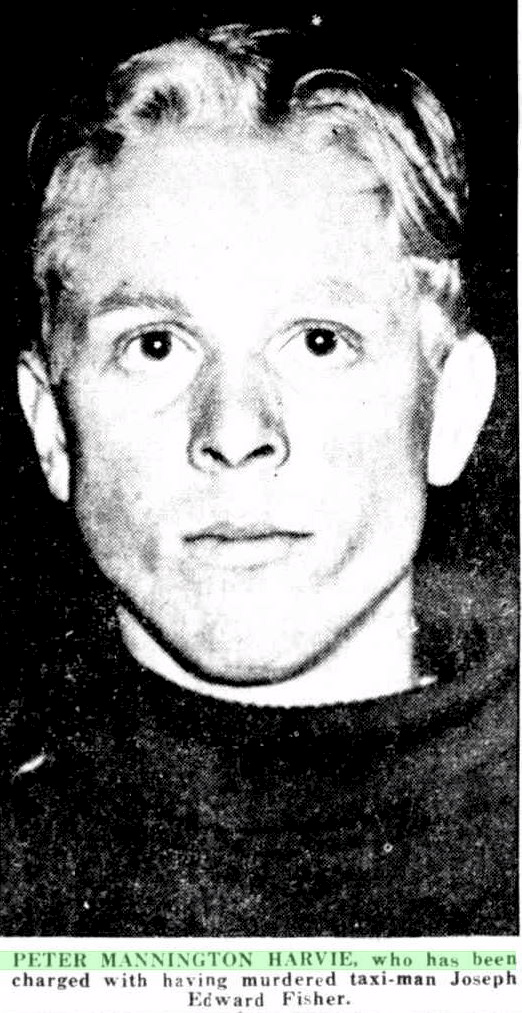
NOT DELIBERATE
Mr. J. W. Binney, for Harvie, in his address to the jury, said it would be dis-honest to ask for an acquittal. Harvie was responsible for Fisher's death, but the circumstances were such that the jury should consider a verdict of manslaughter.
The Crown Prosecutor, Mr. J. Harvey Prior, in his address to the jury, described the shooting as a deliberate and callous minded.
Harvie, he said, was in need of money, and lured Fisher to a quiet spot, where he shot him for the purpose of robbing him.
The jury deliberated on its verdict for 70 minutes.
The Comptroller-General of Prisons, Mr. L. C. J. Nott, said last night there was no set period for a life sentence in N.S.W. In practice, a life sentence was regarded as 20 years, but a prisoner could petition for his release at any time during his sentence.
Any first offender sentenced to life would first go to Goulburn Training Centre, which was a maximum security prison. After a time he might be transferred to a medium security prison such as Berrima, and later to an "open establishment" such as a prison farm. Life Imprisonment For Youth Who Killed Taxi-driver (1952, September 11). The Sydney Morning Herald (NSW : 1842 - 1954), p. 1. Retrieved from http://nla.gov.au/nla.news-article18281191
Another accident near 'Roche's corner':
DEPARTMENT OF MAIN ROADS Levels
MAIN ROADS ACT, 1924
Section 264 of the Local Government Act, 1919
Shire of Warringah. Main Road No. 174—Pittwater Road.
Deviation between Mona Street and Bayview Place, Bayview.
NOTICE is hereby given that The Commissioner for Main Roads proposes to fix and/or refix the levels of Main Road No. 174—Pittwater Road between Mona Street and Bayview Place, Bayview, and so much of any side roads thereby affected within the Shire of Warringah, in accordance with and as shown on plan Registered No. 0174.479.RC.2511, prepared by the Department of Main Roads. Any persons interested are hereby called upon to set forth in writing addressed to the undersigned within one month any objections to the proposal and in the case of an original fixing of levels a claim for the provision of reasonable means of access to the property in which they are interested and in the case of any refixing of levels a claim for any loss or damage which they may sustain by reason of the property being directly affected in any injurious manner by reason of the refixing. A plan of the proposed levels may be inspected at the Head Office of the Department of Main Roads, 309 Castlereagh Street, Sydney, at the Department's Divisional Office, Milsons Point, and at the Council Chambers of the Shire of Warringah.
Dated this twenty-sixth day of May, one thousand nine hundred and seventy-eight.
N. B. HERRICK, Secretary. 309 Castlereagh Street, Sydney. (D.M.R. No. L479.5357) DEPARTMENT OF MAIN ROADS (1978, May 26). Government Gazette of the State of New South Wales (Sydney, NSW : 1901 - 2001), p. 1989. Retrieved from http://nla.gov.au/nla.news-article220210444
DEPARTMENT OF MAIN ROADS Levels
MAIN ROADS ACT, 1924
Section 264 of the Local Government Act, 1919
Shire of Warringah. Main Road No. 174—Pittwater Road.
Deviation between Mona Street and Bayview Place, Bayview
NOTICE is hereby given that the levels of Main Road No. 174—Pittwater Road between Mona Street and Bay view Place, Bayview, and so much of any side roads thereby affected within the Shire of Warringah in accordance with and as shown on plan Registered No. 0174.479,RC.2511 exhibited at the Head Office of the Department of Main Roads, 309 Castlereagh Street, Sydney, at the Department's Divisional Office, Milson's Point, and at the Council Chambers of the Shire of Warringah and duly notified in the "Sydney Morning Herald" on Friday, 26th May, 1978, and in the Government Gazette on Friday, 26th May, 1978, have been approved.
The levels are now fixed and/or refixed and will take effect from the date of publication of this notice.
Signed and sealed at Sydney, this 20th day of September, one thousand nine hundred and seventy-eight.
I, Brian Joseph Sexton, The Commissioner for Main Roads, have hereto affixed the Official Seal of The Commissioner for Main Roads in the presence of:
N. B. Herrick, Secretary. (D.M.R. *To, L.479.5357) (L.S.)
B. J. SEXTON. (9074) DEPARTMENT OF MAIN ROADS (1978, December 8). Government Gazette of the State of New South Wales (Sydney, NSW : 1901 - 2001), p. 5113. Retrieved from http://nla.gov.au/nla.news-article220222110
LOCAL GOVERNMENT ACT, 1919.
PROCLAMATION.
(l.s.)
PHILIP GAME, Governor, 30th September, 1930.
ORDINANCE No. 71, as proclaimed in the Government Gazette of 11th November, 1921, and subsequently amended, is hereby amended as set out in the Schedule hereto. (L.G. 1930-S. 5,469)
By His Excellency's Command,
MICHAEL F. BRUXNER. GOD SAVE THE KING!
Schedule. The Ordinance is amended—
(a) by inserting in clause 1 (b) thereof after the words " Kyeamba (parts as set out in Schedule C)" the words "Warringah (parts as set out in Schedule D)";
(b) by inserting after Schedule C " to the Ordinance the following new Schedule " D":—
Schedule D
Parts of Warringah Shire to which Ordinance No. 71 applies:—
Villages of Avalon, Bay View, Brookvale, Church Point, Collaroy, Curl Curl, Dee Why, Harbord, Manly Vale, Mona Vale, Narrabeen, Newport, North Manly, Palm Beach, Queenscliff, and Whale Beach. [8504] LOCAL GOVERNMENT ACT, 1919. (1930, October 31). Government Gazette of the State of New South Wales (Sydney, NSW : 1901 - 2001), p. 4439. Retrieved from http://nla.gov.au/nla.news-article223055277
The Bayview Wharf
Alongside the Bayview Baths, a wire fenced enclosure, where people may swim without fear of being bitten by the sharks that were once prevalent in Pittwater. Constructed at the turn of the century in order for food producers and fisher families to load up their goods onto steamers, it was built after the Church Point wharf and the Victoria Wharf below current day Newport Hotel. As with so many rural enterprises, as Pittwater was considered 'country' then, residents had to step up and speak for themselves through their local MP;
DEPUTATIONS TO THE MINISTER FOR WORKS.— A number of deputations will wait upon the Minister for Works this morning. At 11.30 Mr. D. Thomson, M.L.A. will introduce a number of residents of Bayview with reference to a wharf at Bayview. At noon the residents of Narrabeen and Pittwater will press upon the Minister the necessity of tramway traffic being provided between Manly and Narrabeen. The Sydney Morning Herald. (1898, October 13). The Sydney Morning Herald (NSW : 1842 - 1954), p. 4. Retrieved from http://nla.gov.au/nla.news-article14152336
WHARF ACCOMMODATION AT BAYVIEW. A deputation was introduced by Mr Dugald Thomson to the Minister for Works yesterday. It comprised representatives of Bayview, who urged the Minister to provide adequate wharfage accommodation for local requirements. There was at present a wharf at Church Point, but that was too far removed from the centre of population and trade. If there had been deep water light up to the shore that deputation would not have troubled the Government, but owing to the existence of long mudflats the cost of erecting a suitable wharf would be so great that it would not pay private enterprise to undertake the work. Fishermen and settlers generally were seriously handicapped now because of the cost and the difficulty of shipment of their fish and produce.
The Minister said he recognised that the construction of a wharf would be convenient to many persons, and he thought a case had been made out for further inquiry. He would not make any promise however, because he saw from the papers before him that the undertaking would be an expensive one, and he would not be justified in sanctioning it unless it appeared on further inquiry that the results which would follow would justify the expenditure. WHARF ACCOMMODATION AT BAYVIEW. (1898, October 14).The Sydney Morning Herald (NSW : 1842 - 1954), p. 6. Retrieved from http://nla.gov.au/nla.news-article14154847
Construction of wharf, &c , at Bayview. Pittwater, 5 tenders received, M J. Woodbury, £686 6s 5d, lowest PUBLIC TENDERS. (1900, April 25). The Sydney Morning Herald (NSW : 1842 - 1954), p. 5. Retrieved from http://nla.gov.au/nla.news-article14307801
M J Woodbury was Matthew James Woodbury of Wyong, a pioneer settler of that region who resided on Mangrove Creek. He was also responsible for the Tuggerah Wharf (sometimes called Woodbury's wharf) which was built for fisherman circa 1900 too. He was partners with a man named 'Smith' in Smith & Woodbury - Timber Merchants. As with so many Pittwater histories, the Central Coast and Hawkesbury people are intertwined. Many of the steamers that carried produce away took it to be offloaded onto trains at Brooklyn. Much of the timber and tin that was needed for local structures was milled on this great river and transported down it to Pittwater.
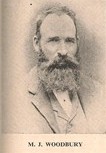 MATTHEW JAMES WOODBURY. THE GRAND OLD MAN OF WYONG. (1838-1921) There passed away at 11 o'clock on Sunday night, 20th March, 1921, a man who will never be forgotten as long as Wyong endures, for he was the father of Wyong, and every inhabitant loved him as a child loves a parent. He truly possessed every virtue in high degree; he was gentleness personified; a man of truth, and his word was his bond. Born on the Mangrove over 83 years ago, his father being an Australian, he came of long-lived people, for his mother died at about 89 and his grandmother at 100. Remaining on the Mangrove till he was 18 years of age, he then proceeded to the Snowy River gold fields at the very time when the white diggers had made a raid upon the Chinese, gold miners, and cut their long pig tails off. Some time later he found his way to the Wollombi, and thence to the Cedars, Wyong, where and at his late residence he resided 55 years. Hence he was one of the first pioneers that settled in the Wyong district. For half a century the dear old 'Cedars' was his home. In the far away days only two kinds of wood were extensively used, oak and cedar, the former for shingles and the latter for fine cabinet work . The timber and the shingles were carted to Maitland, and even slides were much in use when roads were impassable for drays. Away via Yarramalong and the Wollombi to Maitland was the route. In the bush 50 years ago there were practically no timber- getters, except shingle splitters and cedar cutters. When about 27 years of age he married Miss Eliza O'Neill, of The Cedars. She was a lady beloved by to her husband. Great was his grief when some seven years ago she passed away. He never ceased to mourn his loss, even though his children continually ministered unto his comfort in the most loving manner. His sorrowing daughters are Miss Woodbury, Mrs. W. A. Chapman, Mrs. W. Baldwin, and Miss O. Woodbury, and his sons, Councillor W. B. Woodbury, and Mr. Edwin Woodbury, to whom we extend our deepest sympathy. Our late friend was the Chairman of the Directors of the Wyong Butter Factory, and had been Chairman from the inception of the company. Hisvery last conversations were about the re-building of the factory on the ideal old site. He possessed a wonderful memory, and up to within a few hours of his end, his mental faculties were unimpaired. He knew he was nearing The Bar, and was much comforted to see a number of his devoted children round his bedside. The remains were brought to his beloved church, where service was conducted by Rev. Father Herlihy, and thence removed, by procession to the Jilliby cemetery, where a very solemn service was followed by a most eloquent ad-dress by the priest, which will be treasured in the memory of Protestants and Catholics alike. for years to come as a grand tribute to a good man. The immense concourse, testified to the worth and to the nobility of character of Matthew James Woodbury. Numerous wreaths and floral , tributes were offered by loving friends. — 'Gosford Times.' MATTHEW JAMES WOODBURY. (1921, April 1). Windsor and Richmond Gazette (NSW : 1888 - 1954), p. 10. Retrieved from http://nla.gov.au/nla.news-article85877526
MATTHEW JAMES WOODBURY. THE GRAND OLD MAN OF WYONG. (1838-1921) There passed away at 11 o'clock on Sunday night, 20th March, 1921, a man who will never be forgotten as long as Wyong endures, for he was the father of Wyong, and every inhabitant loved him as a child loves a parent. He truly possessed every virtue in high degree; he was gentleness personified; a man of truth, and his word was his bond. Born on the Mangrove over 83 years ago, his father being an Australian, he came of long-lived people, for his mother died at about 89 and his grandmother at 100. Remaining on the Mangrove till he was 18 years of age, he then proceeded to the Snowy River gold fields at the very time when the white diggers had made a raid upon the Chinese, gold miners, and cut their long pig tails off. Some time later he found his way to the Wollombi, and thence to the Cedars, Wyong, where and at his late residence he resided 55 years. Hence he was one of the first pioneers that settled in the Wyong district. For half a century the dear old 'Cedars' was his home. In the far away days only two kinds of wood were extensively used, oak and cedar, the former for shingles and the latter for fine cabinet work . The timber and the shingles were carted to Maitland, and even slides were much in use when roads were impassable for drays. Away via Yarramalong and the Wollombi to Maitland was the route. In the bush 50 years ago there were practically no timber- getters, except shingle splitters and cedar cutters. When about 27 years of age he married Miss Eliza O'Neill, of The Cedars. She was a lady beloved by to her husband. Great was his grief when some seven years ago she passed away. He never ceased to mourn his loss, even though his children continually ministered unto his comfort in the most loving manner. His sorrowing daughters are Miss Woodbury, Mrs. W. A. Chapman, Mrs. W. Baldwin, and Miss O. Woodbury, and his sons, Councillor W. B. Woodbury, and Mr. Edwin Woodbury, to whom we extend our deepest sympathy. Our late friend was the Chairman of the Directors of the Wyong Butter Factory, and had been Chairman from the inception of the company. Hisvery last conversations were about the re-building of the factory on the ideal old site. He possessed a wonderful memory, and up to within a few hours of his end, his mental faculties were unimpaired. He knew he was nearing The Bar, and was much comforted to see a number of his devoted children round his bedside. The remains were brought to his beloved church, where service was conducted by Rev. Father Herlihy, and thence removed, by procession to the Jilliby cemetery, where a very solemn service was followed by a most eloquent ad-dress by the priest, which will be treasured in the memory of Protestants and Catholics alike. for years to come as a grand tribute to a good man. The immense concourse, testified to the worth and to the nobility of character of Matthew James Woodbury. Numerous wreaths and floral , tributes were offered by loving friends. — 'Gosford Times.' MATTHEW JAMES WOODBURY. (1921, April 1). Windsor and Richmond Gazette (NSW : 1888 - 1954), p. 10. Retrieved from http://nla.gov.au/nla.news-article85877526
Eight months after he officially won the contract to oversee these works the Bayview Wharf was opened:
A VISIT TO BAY VIEW.
THE WHARF OPENED.
Bayview is steadily rising in Importance. Thousands who visit the locality gush over its lovely scenery, and its residents regard it as one of the most favored spots oil earth; and If any suggestion be made to the contrary, they are ready with numerous arguments to support that opinion. The present Government, acting upon the sagacious suggestion of the member for the district, Mr. Dugald Thomson, has caused to be constructed there a new pier, which will be appreciated not only by the frequent callers who make the journey thither by water, and whose yachts, during the season lend an additional charm to the seascape, but by the settlers in the place, who receive and send away many tons of produce in the year. The official opening of the pier took place on Saturday, and a small party left Sydney in the early morning to take part in the proceedings. Among the visitors were: Messrs. Dugald Thomson, Millard, arid Cohen, Ms.L.A., Dr. Cullen. M.L.C., the Mayor of Manly (Alderman Fletcher), the Mayor of North Sydney (Alderman Purves),and Alderman T. J. West (Mayor of Paddington).
Although somewhat threatening in the early part of the day, there was no rain, for which the party appeared thankful. The journey over the road from Manly acted like a good tonic, and all were in good spirits when they arrived at Bayview, where they received a cordial welcome from Mr. P. T. Taylor, president of the local progress association, Mr. J. J. Roche, and other residents.
After a pleasant chat about the weather, the fruit-producing powers of the district, the poultry, and suchlike matters of importance, the visitors were conducted under a gaily-decorated arch down the approach to the wharf. The latter is strongly built, is 140ft long, and there is a good depth of water alongside.
Mr. Thomson mounted a portion of a recently-discharged cargo, and was requested by Mr. Taylor to perform the interesting ceremony. In giving expression to that desire, Mr. Taylor intimated that the residents were very much indebted to the Minister for Works (Mr. O'Sullivan), and to Mr. Thomson, for the erection of the wharf. Successive Ministers had promised that it should be done before, but their promises had been of pie-crust frailty. However, when the Minister visited the place with the member for the district a little while ago, he was impressed with its necessity, and tenders were called a few weeks later. That, of course, spoke volumes for the energy of the present Government, and particularly for Mr. O'Sullivan. Mr. Thomson, in that spirit of modesty which becomes a member of Parliament so well, declined to take all the credit for the work.
'There were, he said, the strongest grounds for carrying it out. Those of you who have been living here for so many years will remember the difficulties that have been experienced in landing goods. Men were obliged to wade through mud, and women and children to be carried. The work was certainly warranted. You will also remember that Mr. Roche, with commendable energy and enterprise, constructed a wharf himself, which the waves, with equal energy and enterprise, quickly destroyed, and it became necessary to have some better and more substantial means of approach. The Minister saw that necessity, and could not resist fulfilling his promise. I am glad you have the wharf, which will be of immense use to the district, and I hope that this ceremony will be a happy omen for the future.
The ceremony over, the party boarded the steam launch Surprise, and were conveyed round Pittwater, and a delightful hour was spent viewing the glorious scenery which meets the eye on all sides. They were landed opposite the establishment of Mr. Buist, at which they enjoyed an excellent luncheon. The toast of 'The Queen' having been honored, Mr. L. Hopkins proposed the 'Ministry and Parliament.' In responding, Dr. Cullen referred to the importance of the Bayview district. Its claims would, he said, be recognised in the future, and although they might have to wait for it, the tramway would come at last. With reference to the second Chamber of Parliament, the members of that body were abused and ridiculed a great deal; but they had to ask themselves if they had any business there unless they had to exercise their judgement upon the measures submitted to them — to act fairly and squarely to the whole of the people of the colony. He claimed that, with all its faults, the Legislative Council had tried to do so. He claimed that the second Chamber had rendered many services to the country during the present session. Over and over again the representatives of the other branch of the Legislature, who were elected by the people, were tempted by the least thoughtful to forget the duties, which thy owed to the sober-minded, hard-working members of the community, who were not so well represented in the other Chamber; and measures that were passed by representatives who sat night and day needed the close attention of a revising Chamber. He appealed to the people of New South Wales to remember that while they had a second Chamber it was entitled to respect. If they did not respect it, let them sweep it out of existence at once. Although he was not in favor of a nominee Chamber, with life tenure, still that was better than having only one Chamber, but if it was not worthy of respect it should not be there. If the people wished for faithful service, and a court of appeal that would try fairly and squarely to serve the interests, not of any one class, but of the whole population, let them show the press of the country that they respected the Legislative Council and appreciated the work of its members. Mr. Millard, M.L.A, also responded. Mr. Cohen, M.L.A., proposed 'Success to the District,' and during his remarks made reference to the fact that its member would be a candidate for a seat in the Federal Parliament, expressing a hope that he would be found among its members. Mr. Mr. Purves supported the toast, and in doing so said he believed it was the Minister's intention to construct a tram lino from Manly to Bayview. The toast was also responded to by Messrs, Taylor, J. Symonds (hon. sec), and Joseph Waterhouse. Mr. W. H. Vivian proposed 'The Member for the District,' which was cordially honored. Mr. Thomson spoke at some length in reply. Mr. C. Bennett proposed 'The Visitors,' which was responded to by Alderman Fleischer and Alderman West. A VISIT TO BAYVIEW. (1900, December 3). Evening News (Sydney, NSW : 1869 - 1931), p. 4. Retrieved from http://nla.gov.au/nla.news-article114014867
BEAUTIFUL BAY VIEW.
VISIT OF A PARLIAMENTARY PARTY. THE GOVERNMENT WHARF OPENED.
Ono of the most charming spots to be found within easy distance of, Sydney is Bay view. It derives its name from the glorious, prospect of Broken Bay which It presents. Situated on the western side of the Pittwater arm of the bay, it looks out on an Incomparable vista of the whole Inlet. The foreshores on all sides are steep and clothed with rich, umbrageous foliage, while here and there little golden beaches gleam in the sun, and picturesque homes are dotted on cleared green patches, and over the blue water, on which the sun's rays play and glisten, Lion Rock and Barranjoey stand out hold and. majestic In the hazy blue distance.
Bayview itself is a narrow strip of land fringing the foreshore for about a mile and a half. In front the water laps an oyster-strewn beach; at the back the mountains rise up abruptly several hundred feet. At intervals along the shore are pretty residences, nestling among orchards, orangeries, and rich green vegetation, while an occasional palm and banana grove add a semi-tropical touch. Such at least is something of the picture which the locality presents on a bright day. A more delightful spot for the excursionist, picnicker, or health-seeker could, hardly be Imagined. Yet the beauties and attractions of the place are known ' to few except the ubiquitous cyclist. But Bayview's days of comparative obscurity will soon be a thing of the past.
The Government has just built a fine wharf, which will provide facilities for excursionists who make tho ocean trip to Broken Bay to land. There has also been a long-standing agitation for a tram from Manly to Pittwater, and its construction seems to be within measurable distance. The ambition of the residents is apparently to see the locality as alive with excursionists as a disturbed ant heap teems with ants. The Influx of visitors will doubtless destroy some of the charms of the place, but their presence will mean money and progress to the district. It was at the invitation of the Plttwater Progress Association that a party of Parliamentary and other visitors went down from Sydney to Bayview on Saturday, to take part. In the ceremony of opening tho wharf. Tho pier has been built directly opposite the post-office and Mr. J. J. Roche's fine orchard property. It has been constructed on substantial lines, and runs well out Into deep water, affording .berths for three steamers, with 14ft. to 28ft. of water at low tide. The opening ceremony was disposed of In a few minutes. Mr. P. T. Taylor, president of the Progress Association, explained that the. work was the prompt outcome of Mr. E. TV. O'Sullivan's recognition of the necessity for such facilities. Mr. Dugald Thomson, M.P., In declaring tho wharf open, remarked that the strongest grounds for its construction was the extreme necessity which had existed for It. He eulogised the Minister for Works for the despatch with, .which he had redeemed his promise to have the work carried out. Ample as It was for present requirements; he believed that it would not be many years before a much larger pier was needed. (Applause.) Tho visitors were then taken for an appetising trip In the steamer Surprise round the bay, and upon returning were entertained at a banquet at Mr; Buist's establishment. Mr. P. T. Taylor presided, and all the prominent local personages were present. A fairly, formidable toast list was negotiated,... BEAUTIFUL BAYVIEW. (1900, December 3). The Daily Telegraph (Sydney, NSW : 1883 - 1930), p. 3. Retrieved from http://nla.gov.au/nla.news-article237109956
The Roche family moved to Mosman and a succession of people rented the residence and made a living from the store and Post Office. This is from anecdotal family records by members of the Newey family:
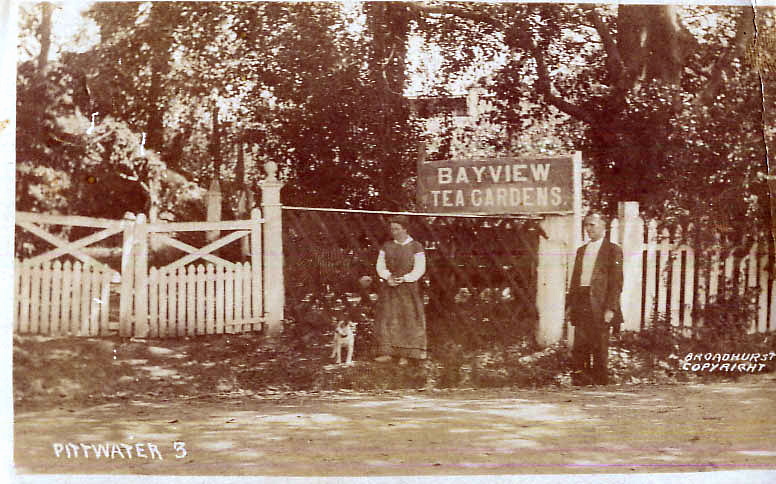
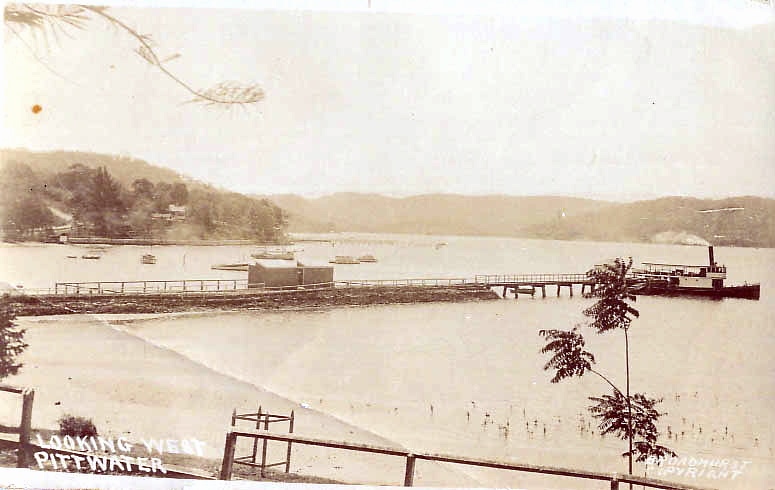
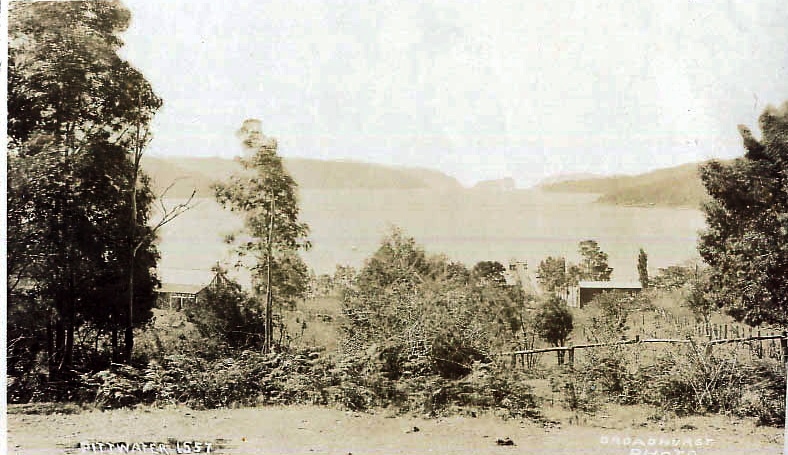
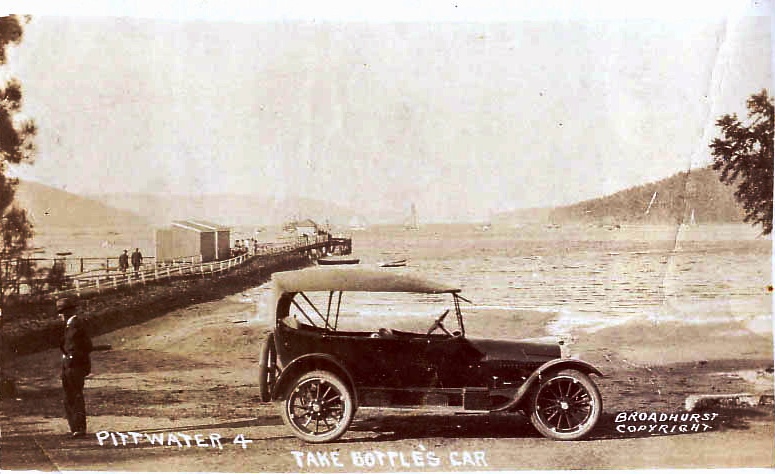
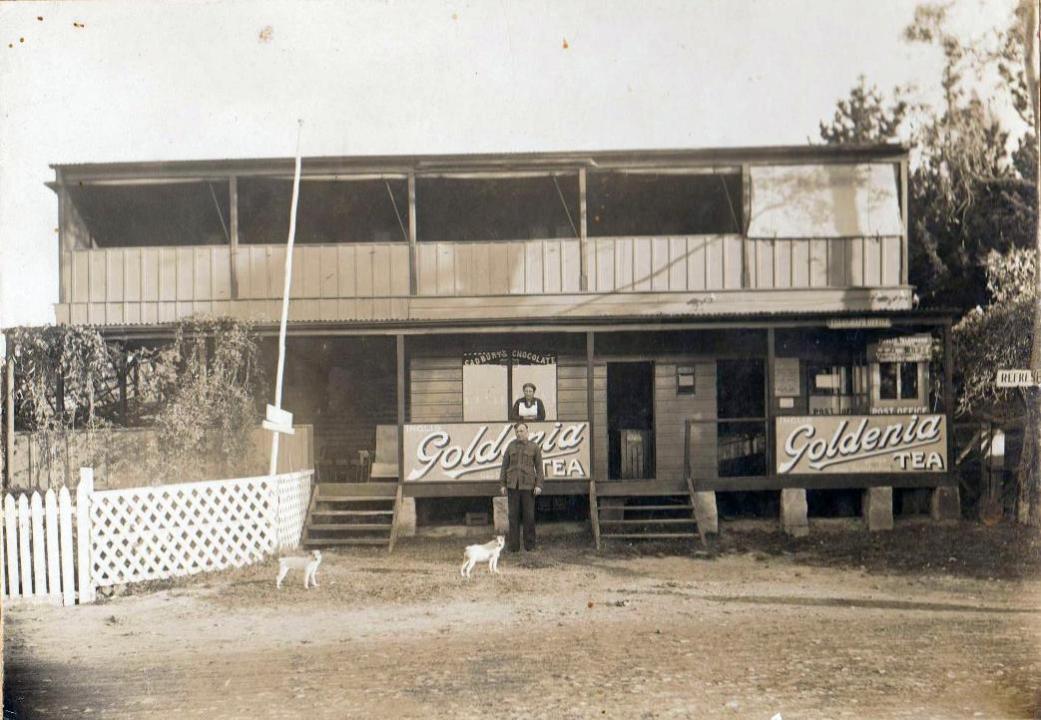
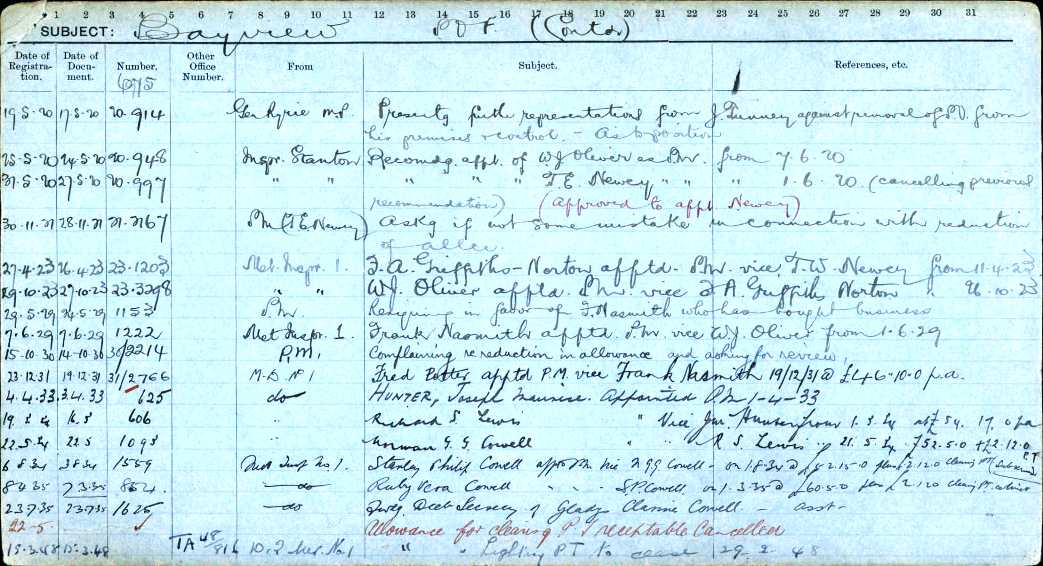
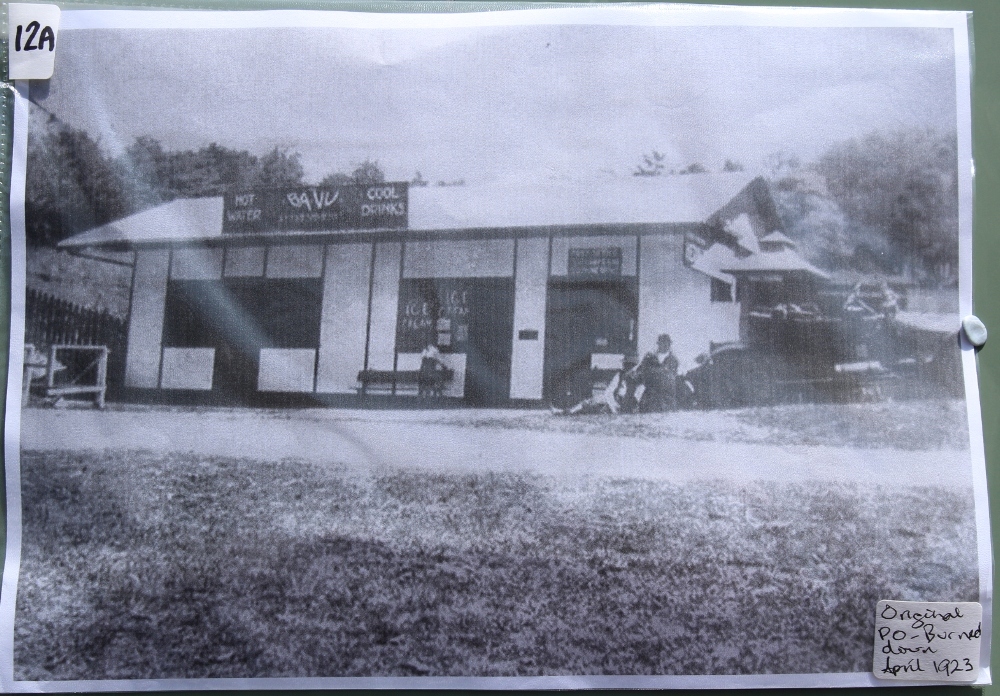
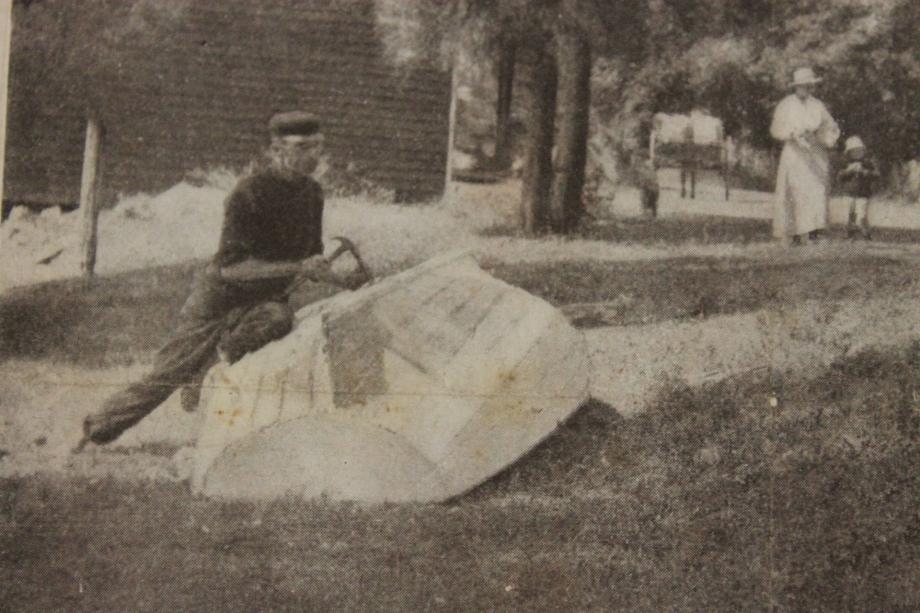
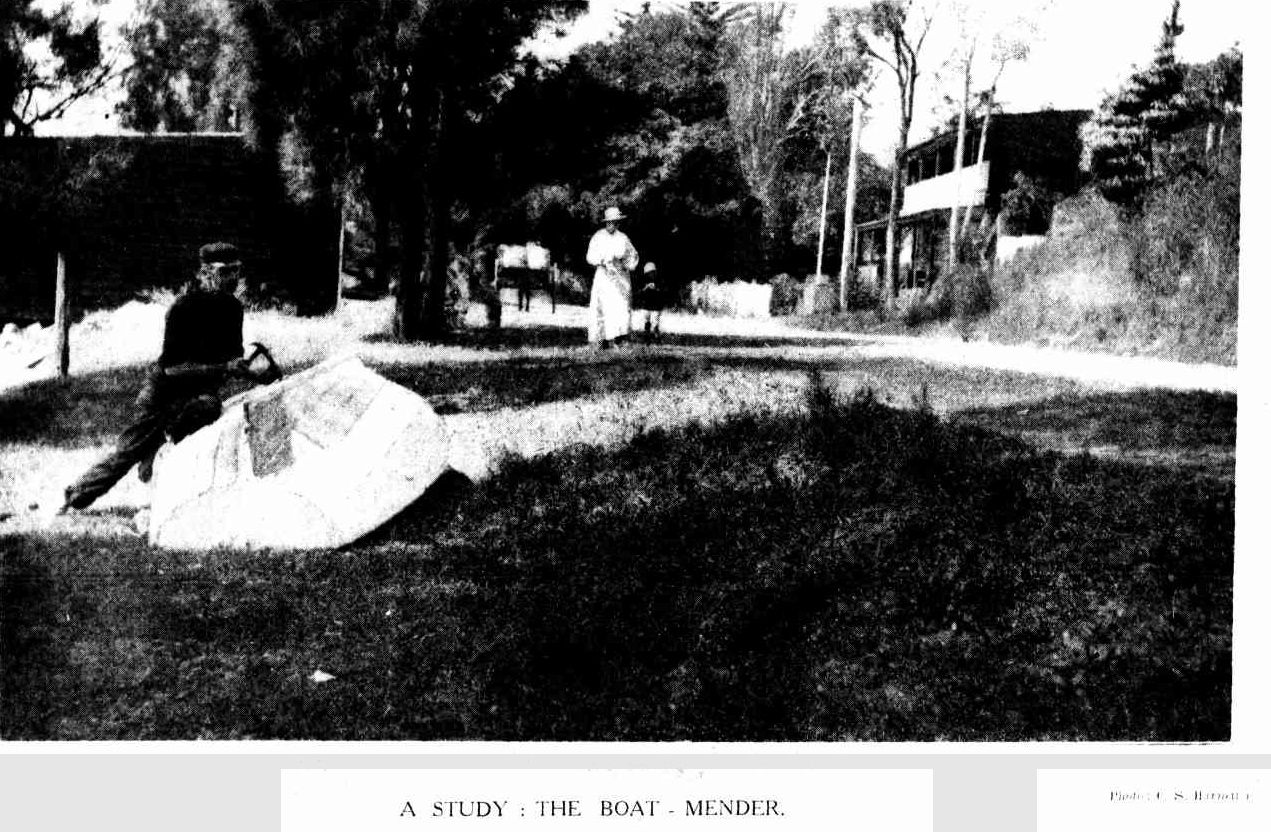
5th June 1908 (handwritten 46th Meeting, Minutes) Tenders for steps at Bayview Wharf:
Bayview Wharf Lighting: lighter of lamps on. Bayview Wharf: C M Williams resigning from his position as lighter of lamps on Bayview Wharf 25/2/1920 (Cr.s Hweitt and Quirk) That C.M. Williams resignation be accepted, and that Charles Charlesworth be given the work at a wage to be arrived at by the Council's Inspector. Charles Charlesworth, offering himself for same position.
Williams of, Bayview be requested to tend to the lighting of Bayview Wharf at the same remuneration as granted to the previous lighter. 8/10/1929
Pittwater Regatta came into being as the result of a private match, in December, 1905 between the Crouch brothers, of Queensland, and W. D. M. Taylor, who sailed the Carella, owned by Lord Forster, and Mr. John Roche, for 21 years honorary secretary for the regatta. An unusual course was chosen, being from Pittwater, where the flagship was moored on Saturday, around Lion Isle and back, a distance of 18 miles. The Crouch brothers won.
Local residents became enthusiastic as the result of this match, and the first regatta was held in February, 1906. It catered for local sailing and rowing boats, but there were only six starters for the first motor launch race. Both the entries and prize-money have in-creased annually. This year there were 107 sailing boats. 57 heavy boats, and eight events under New South Wales Rowing Association conditions, with crews totalling 80 rowers. There were also three races for Navy League Sea Cadets.
The regatta is now recognised as one of the most popular and spectacular in Australia. It has, too, many interesting personal characteristics. Among those who were connected with its inauguration 21 years ago, and who are at present taking an active part in it, are Mr. John Williams (the first president),Mr. W. D. M. Taylor, Mrs. E. G. Greig (formerly hon. treasurer and assistant secretary, who has not missed a regatta for 21 years),and Mr. John Roche (secretary from the beginning).
The Governor-General (Lord Stonehaven)was received at the Bayview Wharf on Saturday morning by Mr. Roche, who introduced him to the president of the Warringah Shire Council, to Mr. Archdale Parkhill, M.P., Mr C. A. Le Maistre Walker, C.B.E. (president of the regatta committee), Mt. R. W. D. Weaver. M.L.A.. Mr. John Williams, Alderman S. H. Burns (hon. secretary of Balmain Regatta), Mr. H. G. Alderson (chairman of the New South Wales Rowing Association). Mr. W. N. Cuthbertson (general manager of the Newcastle and Hunter River Steamship Company), and Mrs. E. G. Greig. The Navy League Sea Cadets provided a guard of honour beneath arches of flags and greenery prepared by residents of the district. His Excellency then embarked on the motor cruiser Miramar, belonging to Mr. Stuart F. Doyle, commodore of the Royal Motor Yacht Club. At 3.30. p.m. Lord Stonehaven was received aboard the flag-ship Newcastle. PITTWATER. (1928, January 2). The Sydney Morning Herald(NSW : 1842 - 1954), p. 4. Retrieved from http://nla.gov.au/nla.news-article16431002
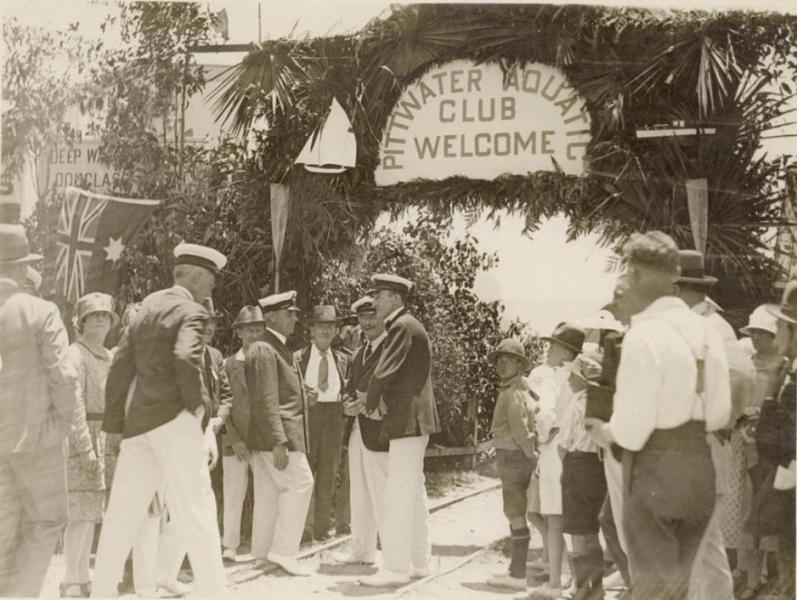
Left: Sam Hood image of Bayview's Pittwater Aquatic Club contributing to the regatta, with John Roche on Bayview Wharf waiting for Lord Stonehaven. Digital Order No. a409025, courtesy State Library of NSW.
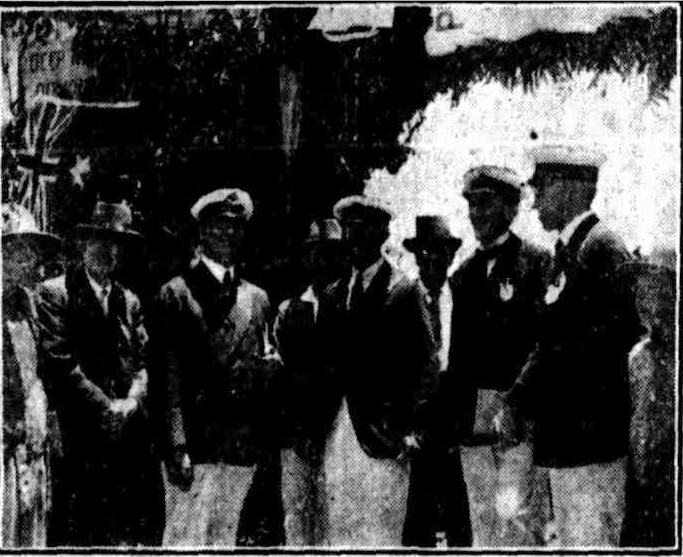
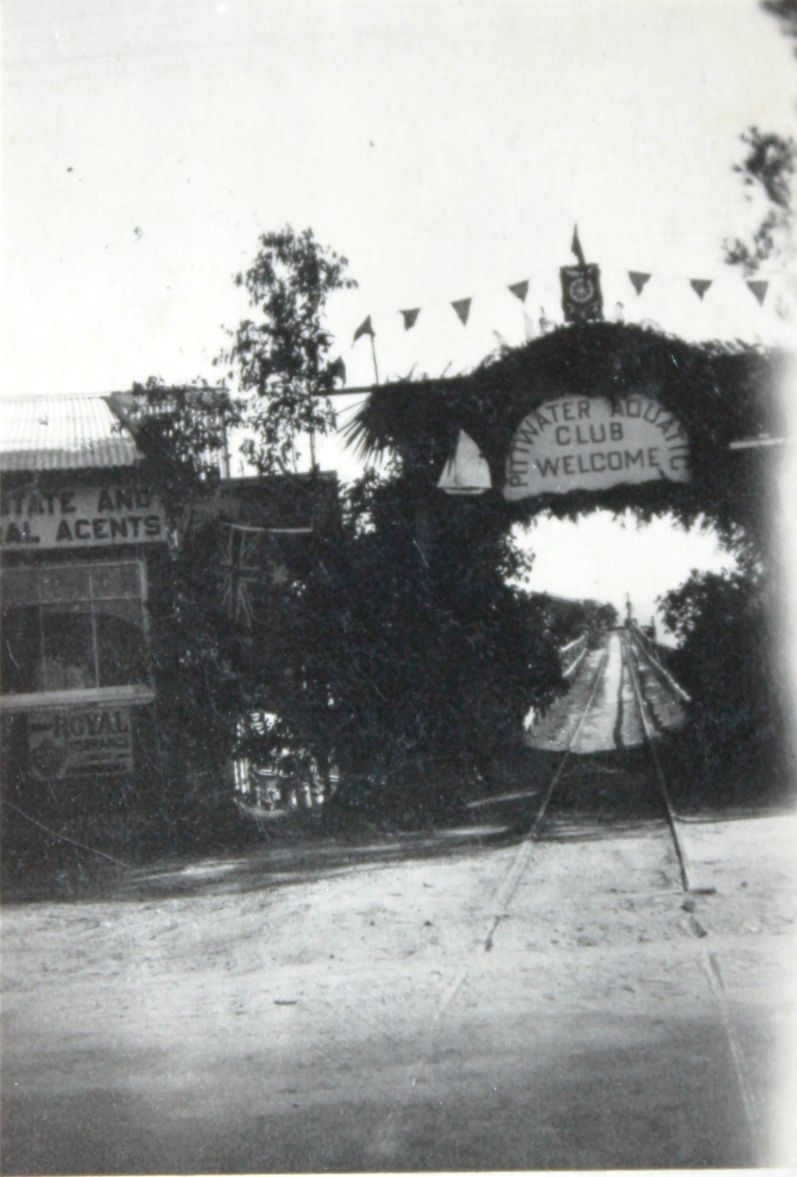
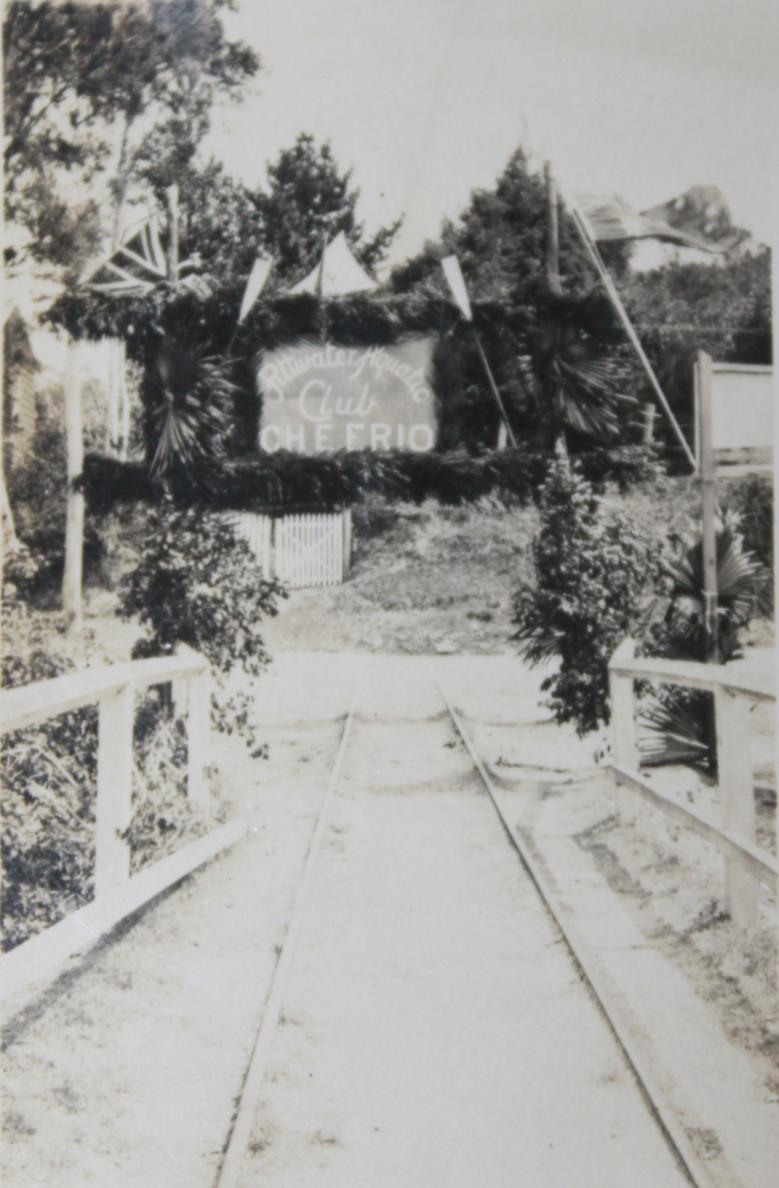
Evacuation Circular letter from Minister for National Emergency Services, 16/1/42, to Town and Shire Clerks, regarding arrangements which must be made to deal with the evacuation, if and when considered necessary, of the civil population from areas affected or likely to be affected by enemy action, and placing responsibility for such work on Councils. On the recommendation of the President it was resolved that a Special Meeting of the Council be held after the meeting of the Finance Committee on Tuesday next„27th inst. for the purpose of considering the matter. It was decided, on the suggestion of Cr. Williams, that the Bayview Military Authorities be requested to delay the completion of the Wharf wiring of Bayview wharf for as long as deemed advisable in order that the public may continue to use the wharf as long as possible. The Shire Clerk, through the President, sought permission to Aluminium order 6,000 dodgers for house-to-house distribution in B and C. Ridings in connection with the collection of aluminium for war purposes, and desired authority was given.
Reporting that Bayview Wharf had been closed off and a notice erected pending repairs: The Engineer orally reported he had been in touch with three or four divers whose services could be obtained when they were available, that the Council "would pay anything up to £100", and when they had finished their work the Council would be free to operate on the rest of the Wharf: 5/1/1943
Submitting progress report in regard to repairs at Bayview wharf : "Received" 19/1/1943
The SHIRE ENGINEER'S REPORT was dealt with as follows:- (1) Submitting report on the progress of the work of repairing Bayview Wharf, and what is still to be done, and giving estimates: Wharf Resolved, - That the work be carried on and completed, and that £300 amount of the Engineer's estimate, be voted to cover the cost of the whole work. (yrs. McLean, Bathe) 2) Reporting that portion of Taylor's Point wharf has collapsed, submitting estimates of the cost of necessary repairs, stating that notices have been erected at the wharf advising that the wharf is closed: Resolved, - That the necessary repairs be proceeded with, and that £100, the amount of the Engineer's estimate, be voted for the work. (Crs. Batho, Hitchcock) 2/2/1943
12/10/1943: Cr. Hitchcock: Can something be done to the Bayview baths to make them usable? The President replied that the work would be done if wire can be obtained.
Petition (per J. W. Lustin) 14/10/43, from 59 residents of Bayview for the placing of the baths adjacent to Bayview wharf in good repair. Resolved, - They be informed that the Council has no wire netting, and asked if they are able to obtain any. (Crs. Batho, Hitchcock)
Elizabeth Hird (Nee Williams) recalled her mother helped make camouflage nets for the army units stationed at Bayview.
After the war is over:
13/10/1958: Pittwater Road Bayview - Application by J.L. and C.M. Williams for Special Purchase for land adjacent to Bayview baths, and request for permission to install petrol pump on this land 14 ft from the street alignment: Resolved, - That consideration of the application be deferred and that Messrs. J.L. and C.M. Williams and the Cumberland County Council be informed that the Council is not prepared to give its opinion or a decision in this matter until such time as the applicants place before this Council plans for the re-modelling of existing installations to meet the Council's foreshore requirements and to improve the area for the benefit of the public. (Crs. ' Fisher, Corkery)
2/2/1959: Item (9) Letter from Cumberland County Council requesting Council's views on application by J.L. & C.M. Williams for "Special Purchase" covering land adjacent to Bayview Baths. Moved by Councillor Berry, seconded by Councillor Reynolds that this matter be referred to the next Meeting of the Finance Committee for consideration to the granting of a "Special Lease". This Motion was carried on the President's casting vote.
25/5/1959: Item D17. Pittwater Road Bayview - Letter from J. Williams & Sons, regarding their application for Special Lease adjacent to Bayview Baths, and requesting consideration of Councills requirements for a parking area of 30 cars: 14.Resolved - that in regard to this application Council inform J. Williams & Sons that the full terms of Council's Resolution of the 21st April must be adhered to. (Crs. Fisher/Wilson.)
SPOTTED GUMS AT BAYVIEW. Bayview, one of the most delightful of the many beauty spots round the waterfront at Pittwater, is more beautiful than usual today because of the presence of numbers of the young and middle-aged spotted gums on the roadside. Anyone, who has an eye for a tree trunk and a shapely headpiece, should see these hardwoods at work on their home holdings, over which Mr. Mark Foy and his neighbours hold sway. The grown trees are 30 and 40 feet in the barrel, and are quite perpendicular. All the young stock are lighter in body and shorter as well, but even the babies among these yellow-stemmed trees are as straight as a plumb line. Young trunks and old trunks, too, are coloured with unbroken bark of yellow-green pastel shade, blotched with spots of dull mauve, which clearly indicate the family to which they all belong. Only lately they were engaged in dropping their old bark in readiness for the work which has to be done during the year.
Thanks to Mr. Foy, Mr. Graham, Mr. Sinclair, and to the other tree lovers of Bayview, who are bent on preserving these native timber trees, visitors are able to enjoy from the roadside pictures which are too seldom seen on or near an outer suburban highway. In too many places all the native trees are cut down to make room for favourites from other continents. None of the Imported trees compare with those of our own wild land. Bayview's spotted gums stand head and shoulders above anything near them. While their present owners have power to protect them they are safe from the axemen. Recently, some splendid trees were taken off the roadside to make room for the electric light wires. Other trees were lopped or shortened for the same purpose. Many a bayside resident was sorry to see that work done. However, the chopping could not well have been avoided. The men who handled those spotted gums did their work feelingly, and saved every tree they could. SPOTTED GUMS AT BAYVIEW. (1930, January 3). The Sydney Morning Herald (NSW : 1842 - 1954), p. 10. Retrieved from http://nla.gov.au/nla.news-article16615090
A Settled Residency
Although some accounts may state that the area was mostly empty, other indications are that there were a larger resident population than first thought. Those given early land grants, when not occupying those lands, were renting them out to people who not only had their families on site but would also have 'hands' to help with the work.
At Church Point:
AN HISTORIC CHURCH
MEMORIES OF THE METHODIST CHAPEL AT CHURCH POINT, PITTWATER
The erection of the little Methodist Church at Pittwater was through the efforts of Mr. George McIntosh and Mr. William Henry McKeown, who conducted services at Bayview, under a tree. This prompted Mr. Wm. Oliver, an early settler of this district, to give one acre of land for 10/- to the following gentlemen, as joint tenants, as per the Certificate of Title, dated November 8,1871:— George McIntosh, William Oliver, James Jones, Thomas Oliver, John Alderton, William Baker, all following the occupation of farmers, and residing at Pittwater, and William Henry McKeown, of Lane Cove, also a farmer. The little church was erected on this land in the year 1872 for the sum of £60, and the point derives its name from this little wooden house of worship (Church Point in many early records is spoken of as Chapel Point).
In the cemetery lie many pioneers who passed away about half a century ago, and such a place enkindles in one's memory the lines of Gray's 'Elegy': —''Each in his narrow cell for ever laid, The rude forefathers of the hamlet sleep.' The Wesleyan Minister stationed at the North Sydney circuit, Chatswood or other Church in that or Artarmon locality, could only visit the church about once a quarter accounts for the burials in God's Acre being taken by the Rev. R. .S. Willis, M.A.. Incumbent of St, Matthew's Church of England, Manly, up to 1890, and therefore the records of these burials are contained in the Church of England burial register at Manly.
This church was used in the week days from May, 1884, until 1888 as a public school and known as the Pittwater Public School, under the charge of Mr. S. Morrison, who now resides at Manly. It was on July 19,1887, that the late Sir Henry Parkes paid a visit to the school in this church building, and signed the school's visitors' book. It is to be trusted that the demolition of this church will not be proceeded with, ,but that it will be restored, and again used for public worship, as the population is growing, and the nearest church is three miles away. This will save this historic place from going into oblivion. I have approached the church authorities with the hope that something may be done at the eleventh hour; even five members of my society (the Manly, Warringah, and Pittwater Historical Society) having approached me to the effect that they are willing to spend a few Saturdays, if a conveyance can be provided, to help to restore this building.
In conclusion I wish to point out that St. John's(Church of England, Pittwater, on the headland near the 11-mile peg, was the first house of prayer in the district, having been opened on September 21, 1871, and was referred to as follows: 'This small church was situated quite in the wilderness, being the first erected in that part of the colony." — P.W.G. AN HISTORIC CHURCH. (1930, June 6). Windsor and Richmond Gazette (NSW : 1888 - 1954), p. 10. Retrieved from http://nla.gov.au/nla.news-article85883396
The Roche family are synonymous with the area, and with the Collins family of Avalon, weer at the other end of that long and bay hugging road.
ROCHE—COLLINS.—April 18, at the residence of the bride's mother, Rockvale, by the Rev. Dean Hanly, James Joseph, youngest son of John Roche, Esq., County Cork, Ireland, to Katherine M., youngest daughter of the late John Collins, Esq., of Pittwater. Family Notices. (1883, May 24). The Sydney Morning Herald(NSW : 1842 - 1954), p. 1. Retrieved from http://nla.gov.au/nla.news-article13535436
They had six children: John (born 1884 - October 15, 1936) Elizabeth Ellen ( February 5th 1886 - 8 Apr 1979) Mary Honorah (Born 1888 - 26 Jul 1979) Katherine Agnes T (born 1889 - 13 Jul 1976) Nano E (1892- 29 Sep 1979) Francis Michael G (Born 1895)
And while the Roche family grew, their father's success as a farmer accounts for a few reports:
Successful Poultry Farming. WRITTEN FOR THE TOWN AND COUNTRY JOURNAL.' (BY " ST. MAGNUS.")
There can be no doubt whatever that poultry fanning will pay, providing that the proper conditions for the successful rearing of the fowls are present and that ' skill is' brought to bear on the business. Many men enter, upon this business without any previous experience at all, ' and in such 'cases' failure is the general result. To make the business successful the fowls must have plenty of run, their houses and roosts must be kept scrupulously clean, the best breeds of fowls must be selected, and they must receive intelligent and careful attention. Uncombined with any other agricultural pursuit, poultry farming seldom pays unless in the hands of an expert, and even then it will pay better if combined with' some pursuit such, as fruit or vegetable growing. Some of the most successful poultry-breeders of New South Wales, are fruit growers. It stands to reason that where fowls can be largely fed on the waste accruing about such premises, they can be more profitably reared than in a place where the whole of-their food must be purchased.
One of the most successful poultry-breeders of the country is Mr. J. J. Roche, Bayview, Pittwater. This gentleman combines poultry-breeding with fruit growing, he having 30 acres of a flourishing orchard, and making a, successful business of both pursuits. Briefly described, Mr. Roche's method is about as follows : His land (a light loamy soil, high, and dry, having a north-eastern aspect, with plenty of shells, sand, and grit in its natural composition) presents the ideal conditions for a poultry farm. The principal breeds he keeps are Langshans, Plymouth rocks, brown and white Leghorns, Houdans, Minoreas, Brahmas, Orpingtons, Spanish, Hamburgs, Dorkings, and colonial game, and Aylesbury and Pekin ducks. These he keeps fenced off in separate enclosures, giving them plenty, of room and plenty of shade. This order is, however, only observed during the breeding or mating season, after which, the birds are. allowed to assemble in flocks and to have an extended min. Mr. Roche hatches almost wholly by the incubator, and with moderate attention attains a high degree of success, getting on the average 90 per cent. He rears his chickens by foster-mother, consisting of iron tanks filled with hot water, sometimes, however, using hens in conjunction with the artificial mothers. The plan is to set a broody hen, and slip 12 chickens, hatched by the incubator, under her at night, when she will take to them as if they were her own hatching, and rear them, Mr. Roche believes that to cleanliness and feeding is due in a great measure, his success. He feeds principally on soft food, giving pollard mixed up into a stiff dough in the morning. The pollard should be moistened only to that consistency that when thrown on the ground it will crumble. Sometimes a little wheat is mixed with the pollard, and occasionally maize is given to color the eggs a bright red but maize is too heating to make it a regular diet. Garden feed, as a matter pf course, is given regularly, meat once or twice a week if it can be got, and sour milk when available..
Mr. Roche is particularly strict about his drinking fountains, and sees that they are kept clean and constantly supplied with pure, fresh water. Sulphate of iron is given as a tonic in the drinking water-as much as will lie on a penny piece in a bucket of water once a; week; This keeps the fowls free from disease, and gives them appetite for their food. His drinking vessels (see figures: 1 and 2) are simple of construction, yet eminently adapted for the purpose intended. Figure 1 shows a kerosene tin with holes cut in it(as shown in the engraving) through which the fowls thrust their heads, fill their mouths, and withdraw it to swallow the water.
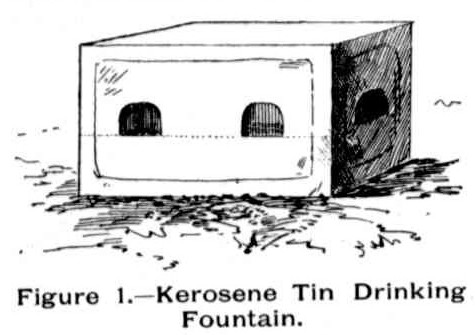
Figure 1.-Kerosene Tin Drinking, Fountain.
The advantage of this contrivance over an open vessel is that in the first place the water is kept cooler and purer, and in the second place the fowl, having to withdraw its head to swallow the water, any that may escape from its mouth in this ' operation falls on the ground instead of falling in the vessel as it inevitably would do, providing it was open, and the fowl stood over it to drink. The advantage of this contrivance then, is obvious, for - disease is but too frequently "communicated from one fowl to another by the slime and drippings that fall from diseased birds bills into the drinking-water. Figure 2 shows-another kind of drinking fountain;-
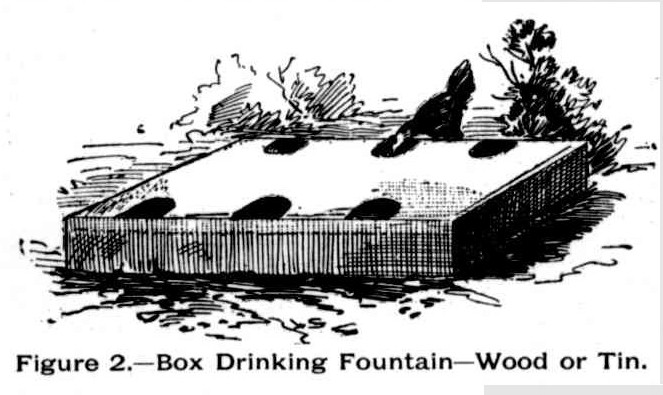
Figure 2.-Box Drinking Fountain-Wood or Tin.
It may be a wooden box or tin, or iron vessel-of say-5in. deep', covered on the top as seen in the engraving; but -having holes through which the fowls may thrust the bills to drink. This contrivance does not however meet with the some approval from Mr. Roche as the other, for although the cover keeps the water clean, yet the fowls may stand over it and drink and the slime and drippings, from their bills majrind its way into the water through the holes- and so contaminate it. . Mr. Roche has experimented much with fowls by crossing one breed on to the other, and sometimes with the best results. First, he is a great believer in the langshan as a general purpose farmer's fowl. They are good layers, good table fowls, hardy, fast growing, and docile. Next to them comes the brown and white Leghorns, so well and favorably known to poultry keepers. The Leghorns, however, lays a small egg, and they are small birds for the table. A cross between the Langshan and the Leghorn he, however, finds to bean excellent bird, and partakes .and combines the good qualities of both. He has also experimented extensively with other crosses; and is on the whole well pleased with the result. The colonial game he places before the British game as being better adapted to our climate and for table purposes. He considers his fowls pay him well, and there is room for an extension-of the business. It may be said that the whole district around Broken Bay is in every way adapted for poultry keeping. The climate is all that could be desired, and the soil is heavily impregnated-with shells and grit. The land has a good elevation, and there is an abundance of pure, fresh water and plenty of shade and green feed,- then it is close to market, and a man in his spare moments can always find something to employ his time working on the land. The district ought to be an excellent one for the beekeeper, as there are plenty of blooms and a wide scope of country for the bees to range over. There are, however, few apiaries of any pretensions in the district as yet, but various of the settlers are thinking of starting them. Successful Poultry Farming. (1893, November 18). Australian Town and Country Journal (NSW : 1870 - 1907), p. 22. Retrieved from http://nla.gov.au/nla.news-article71191960
The Late Agricultural Show. We regret that we omitted to record in the prize list of the late Sydney Agricultural Show the fact that Mr. J. J. Roche, Bayview, Pittwater, won first prize in preserved fruit in syrup, beating some very choice collections. Mr. Roche also secured second prize in mandarin oranges. Mr. Roche is the owner of a very fine Orchard and poultry farm at Bayview, Pittwater, and he writes that he is bottling his peaches and apricots, and makes it pay well, and in his opinion it is the only way to make fruit pay at the present prices. The Late Agricultural Show. (1895, May 4). Australian Town and Country Journal (Sydney, NSW : 1870 - 1907), p. 48. Retrieved from http://nla.gov.au/nla.news-article71229161
BAYVIEW, PITTWATER.
A handicap rowing race for local boats took place at Pittwater on Saturday last, the result being an easy win for the Magazine boys, with W. Dickenson's second. Six boats competed over a course of about one mile from Mr Gedde's wharf to Church Point. Mr. Booth acted as starter, and Mr. Mulligan as judge. BAYVIEW, PITTWATER. (1896, March 9). The Sydney Morning Herald (NSW : 1842 - 1954), p. 6. Retrieved from http://nla.gov.au/nla.news-article14040596
On the Towler's Bay side there are several residents who pull across the water to the wharf at Church Point and meet the steamer from Sydney or the coach from Manly, as the case may be. The dynamite powder hulk is moored in Towler's Bay, with residences on shore for the officers in charge. Mr. Robert Robinson has his residence of Raamah at the same place. Mr. Robinson informs me that he can grow to perfection such tropical fruits as bananas, guavas, ginger, mangoes, pineapples, Brazilian cherries, &c. This fact will demonstrate that there can belittle or no frost in this locality. Other residents of this side of the bay are Mr. F. Chave, Wood-lands, who has a very nice orchard, mostly summer fruit ; Mr. E. C. Johnstone, who has a nice residence and orchard; Mr. A. Steffani is another prominent resident, while the residence of the firm of Flood and Oately occupies a lovely peninsula in the quiet waters of the bay. Mr. Geo. Brown has a residence and an orchard in the neighborhood, and there is also a small church and cemetery at Church Point. Manly to Broken Bay. (1893, November 11). Australian Town and Country Journal (NSW : 1870 - 1907), p. 19. Retrieved from http://nla.gov.au/nla.news-article71191632
Mr. Johnson’s mother’s sister was married to Mr. John Oliver who, in an affidavit, described how residents flocked to the wharves when the steamers arrived and unloaded their supplies. The steamer carrying the tin used in the roof of houses A,B,C, would have been unloaded at the Bayview wharf, alongside the present William’s Marine. Mr. Johnson (in Pittwater 1907) remembers the steamer’s whistle alerted everyone to the approach of the steamers. Mr. John Oliver worked for Mr. Geddes and mentions the ships “Hawkesbury”, “Narara” and “Erringhi”. (Mr Geddes owned property on “Brick Yard Hill” ½ mile from Wharf, east towards Bayview). From ‘Comments by the Early Settlers' – St Johns Anglican document. April 13.2005.
1898 The Morrisons’ ‘Killarney’ Resort
On March 23rd 1899 Emma Morrison purchases ten acres from Martha Oliver, the property of Thomas Albert Oliver (deceased). (Certificate of Title 1277 – 51). This land is part of the original 40 acre land grant to William Cape in 1840 (Portion 27). This property with a cottage (once the Olivers’ home) is next to the small property which Emma purchased in 1891 from Thomas Oliver. The newly acquired cottage on the ten acres, near Killarney, is named Drumtochty.
"I had two on the Bayview side, near Fig Tree Flat, named Killarney and Drumtochly. … Mr Ireland had another furnished cottage near Church Point. Each of these furnished cottages were supplied with a good pulling boat and had enclosed baths.” (S. Morrison 1929)
1900 “Bayview Pittwater Furn Cottages, 4 bedrooms from …., boat firewood, water.S. Morrison, P.O.“ (SMH 6 October 1900 P.15)
1901 “Summer Resorts - Bayview – Furn. Cottages ev. conv., good fishing, bathing, boat. Term S. Morrison Bayview P.O.” (SMH 16 March 1901 P.6)
1903 “Country Resorts Bayview – Drumtochty, 7 rooms, …. Boat, baths, fishing, oystering. S. Morrison Bayview P.O.” (SMH Sat 31 Jan 1903 P.3)
1904 “Summer Resorts – Bayview – Furnished Cottages, 6 r, enclosed baths, boat, low rent, best position. S. Morrison Bayview P.O.” (SMH Sat 26 Nov 1904 P.17)
1905 “Bayview – Furn Cott, 6 rms, bathing enclosure, tennis, boat, firew. Low rt. Morrison, Bayview P.O.” (SMH 11 November 1905 P.20)
In 1905-6 Henri and Hedwig Rainaud take over Drumtochty and set up a restaurant and accommodation house. In December 1905 Henri Rainaud advertises that he is applying for a certificate authorising the issue of a Colonial Wine License for a house situated at Church Point, Bay View. (SMH 23 December 1905 P.14) ; “Bayview – Drumtochty and *Ripley – First class Accom., French cuisine, ev. Home con. H. Rainaud” (SMH 24 March 1906 P.6) - {*Ripley is a house to the east of Drumtochty}
On September 1st 1908 there is a transfer of land from Emma Morrison to Hedwig Rainaud. In the same month Monsieur Rainaud advertises his accommodation house, formerly Drumtochty, with the name “La Corniche”. (SMH 19 September 1908 P.22)
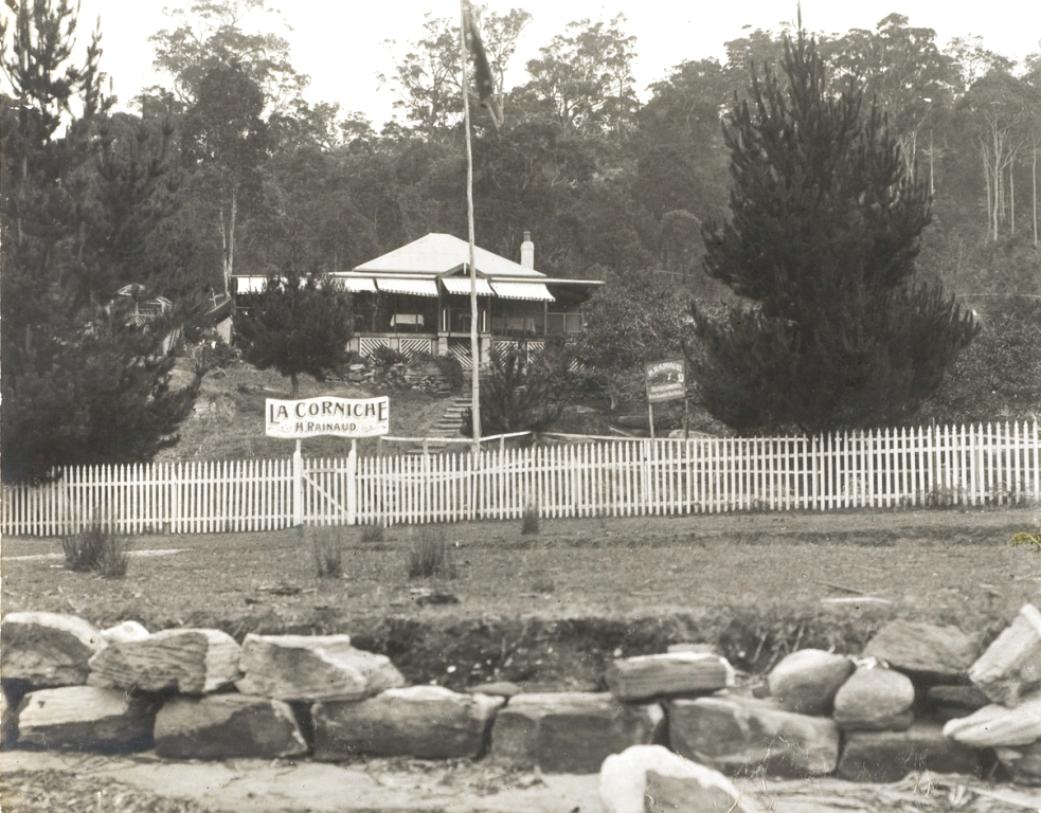
From The Mort Family Album, Image 131. H.Rainaud's restaurant La Corniche, Digital Order No. a1780131, from State Library of NSW: A note scribbled at side of this photograph says " Renaud - after his Restaurant in Macquarie Street - Morts Rooms-Chambers'.
In 1898 the Wheeler family rent the Morrisons’ cottage ‘Killarney’ at Bay View at one pound per week with seabaths and a good boat included. Mr. J. S. N. Wheeler relates insights on this cottages in his 1940 published The Early Days of Bayview, Newport, Church Point and McCarr’s Creek, Pittwater:
: This has brought us to the twelfth mile-post from Manly. Along the road bordered with trees the coach descends to Figtree Flat, also known as Cape’s Flat, and the orchard of W. J. R. Baker, with “Killarney” cottage lying between the two. This flat with its green sward was a favourite picnic ground. The annual school picnic and distribution of prizes were held there on November 9 each year, the birthday of the then Prince of Wales (later King Edward VII.).
Baker’s orchard has long since disappeared. It comprised six acres of peaches, nectarines and other summer fruits, and two acres of oranges. The orangery was situated high up at the apex of the orchard. A row of quince and peach trees flanked the fence next to "Killarney." As Baker also kept poultry, it will be seen that Bayview was once a thriving poultry-farming and fruit-growing district.
CHURCH POINT.
Before describing this district in detail, it is fitting that I should mention the furnished cottages, a feature of early tourist days, and tending to make the place known.
In 1898 we rented “Killarney” cottage at £1 per week, sea baths and a good boat included. My first evening at this spot includes a boyish reminiscence of a walk after tea to Bayview Post Office store for provisions, and a glimpse of the red beacon of Barrenjoey Lighthouse. “Killarney” had a lawn, summer-house, and a white fence—a spot where cool nor’-easters blew the tang of salt sea across the bay. I remember that a big, green-painted lugger, the Thomas and Martha, owned by Thomas Oliver, used to anchor off this spot. She carried firewood for sale in Sydney. Next door lived a fisherman, Tom Wilson, in a squat cabin-type of cottage half hidden by bracken and bush shrubs. From him we used to buy a dozen large black bream and black fish for a shilling for breakfast. Cases were packed with fish—the night’s harvest—and sent up to Manly on the roof of the coach in the morning.
At Mrs Chave’s orchard, a quarter of a mile away, a bucket would be filled with grapes for a shilling. The grape vines grew in a dingle half way between the house and the road. Mrs Chave, an old lady aged ninety-three years, passed away in 1934.
Just above “Killarney” was another furnished cottage, “Drumtochtee,” in which some of the Oliver family once lived. S. Morrison, schoolmaster, owned both these cottages. Later “Drumtochtee'’ was bought and renovated by Rainaud and named “La Corniche.” Luncheons were provided there for visitors. Another furnished bungalow, “Rosstrevor,’’ prettily situated with a beach in front, in a combe on McCarr’s Creek, belonged to J. Ireland, a confectioner of Leichhardt. It was named after his house in that suburb. It was cosily furnished, and had the usual appurtenances of a boat and baths.
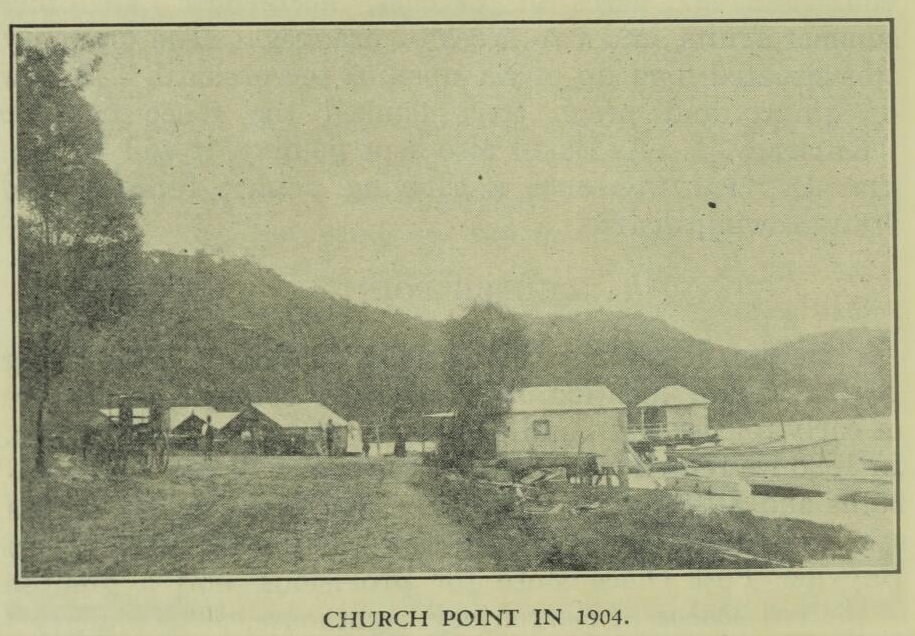
CHURCH POINT IN 1904.
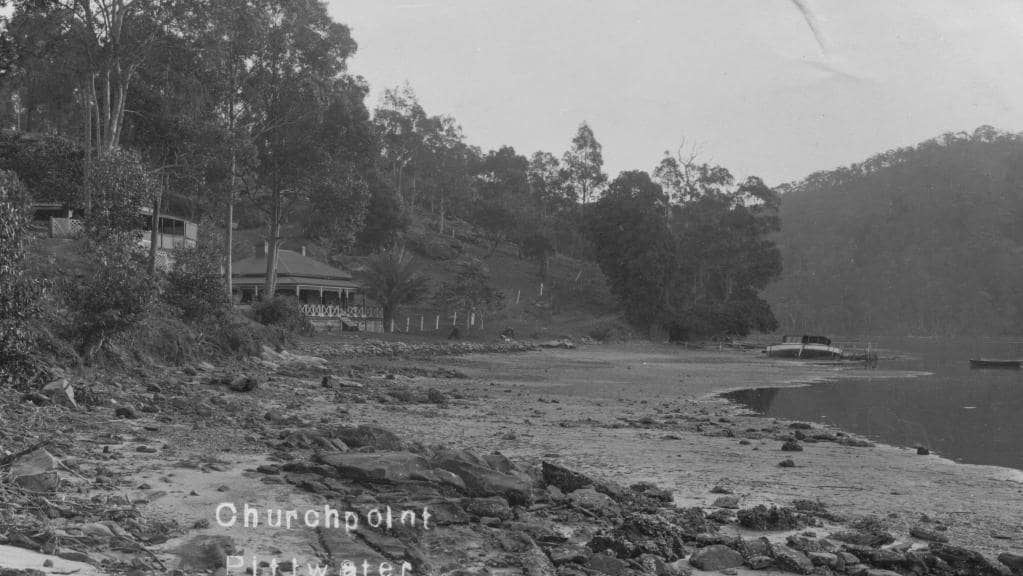
Rosstrevor circa 1905-1910
Mr. Wheeler's full anecdote has been digitised by the National Library of Australia is now now avail;able to view online - details below.
Bay View.
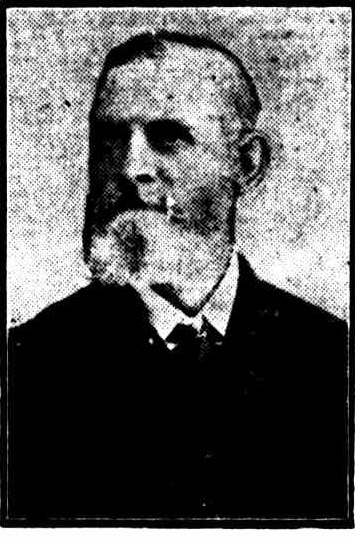 Lieutenant Wade Browne, of Medlow Bath and Bayview, Pittwater, who died recently in his 85th year, was a Crimean and Indian Mutiny veteran, and a pioneer in the improvement of cattle-breeding methods and sugar-planting in Australia.
Lieutenant Wade Browne, of Medlow Bath and Bayview, Pittwater, who died recently in his 85th year, was a Crimean and Indian Mutiny veteran, and a pioneer in the improvement of cattle-breeding methods and sugar-planting in Australia.
The Place Pittwater Regattas Began
A Place to Holiday: The Growth of Boarding Houses and Camping Areas
The Best Place to Spend a Holiday
AND THE BEST WAY. BAYVIEW.
Although this part of the country is so easy of access, few know of its existence, fewer still have seen its beauties and enjoyed the blissful quiet so much' appreciated by the busy city man. Bayview is beautifully situated on the southern arm of Broken Bay — Pittwater — eleven miles north from Manly, and is reached by coach from the latter. The road from Manly is one of the best in the state, and is a great favourite with cyclists. The scenery en route is varied and picturesque. Passing through Greendale we notice many neat cottages, beautiful gardens, and several dairy farms; further on we have the Salvation Army Home of Rest and Industrial Farm. A few minutes' drive and we pass the famous fishing ground, Deewhy Lagoon. Here the black swan are seen in large numbers. From this on for some miles the road skirts the ocean, and we pass Long Reef, long sandy beaches, Narrabeen village and lagoon, Sheepstation Hill, and Rocklily. A few yards from Rocklily, the Bayview road turns off.
After a drive of a mile through typical bush, with homesteads and orchards dotted here and there, we arrive at Roche's corner, where a panoramic view of Pittwater bursts suddenly on our sight. This is one of the finest pieces of scenery in all Australia. A beautiful sheet of water lies before you, with its countless bays and ramifications, the many headlands wooded down to the water's edge.
Scotland Island is directly opposite, while Mount Elliot and Lion Island, ten miles distant, fill up the background. The road from this point onward winds and twists fantastically alone the foreshore to the terminus, Church Point. The term Bayview is given to the western shore of Pittwater. The inhabitants who are noted for their hospitality, are engaged in various pursuits, principally orcharding, poultry farming, gardening, and fishing. The fruit and fowls from the district have won many medals and certificates at the Royal Agricultural Shows, and received high encomiums from experts and connoisseurs. The fishing is superior to anything within easy distance of Sydney. Provision has been made for the tourists and visitors by the various boarding-house keepers, whose tariff is most reasonable, and the many furnished cottages rent from 30/ per week, where families of eight and upwards may enjoy the comforts of home. Some of these cottages are provided with a boat, and supply linen cutlery, and firewood, &c.
As the butcher, baker, and grocer call regularly, there is no inconvenience. The return fare from Circular Quay to Bayview is 3/6; so, for a few shillings, you may spend a day on the waters of Pittwater, catch sufficient fish for the family dinner, and enjoy the beauties of this elysian spot. Space will not permit of any notice of the hew National Park — Kurringgai Chase— which has many miles of the foreshores of Pittwater. The trustees of this park are making many improvements for the convenience of visitors. Bayview, in short, is an ideal spot to spend a holiday — a place to recuperate after an illness, or to forget the worries and anxieties of business. — ONE WHO KNOWS. The Best Place to Spend a Holiday (1901, March 3). Sunday Times (Sydney, NSW : 1895 - 1930), p. 12. Retrieved from http://nla.gov.au/nla.news-article125880318
A few years on the campers:
The Land Sales
The State Library of NSW is gradually working its way through the alphabet in digitising all the subdivision advertisements. These great materials not only show us the growth of the streets leading off the Bay View Road to Church Point, some even had photographs of the scenic wonders to be seen from the properties being sold for potential buyers.
Bayview subdivision plans - State Library of NSW Church Point Subdivision plans - State Library of NSW
These would be incomplete without a few insights into who was converting farmland to Real Estate so that these lands, in allotments, could be sold. Some were sizeable, in acreage (now called hectares) and would later be further scaled down into what we now call the suburban block, although in Pittwater, these are not the half sized blocks currently being sold elsewhere in Sydney.
It is these series of sales, and the shift from being an orchading and farming area to a holiday resort, as well as a further influx of permanent residents, that would mean that dirt track out to those green-blue hills would require improvements - being sealed for instance, and then widened.
One of the earlier land sales on the road to Bayview and at the Mona Vale-Bayview junctions was put up for sale by E. C. V. Broughton. A little about Mr. Ernest C. V. Broughton, who obviously bought land here as well as selling it in the Centenary Estate - Mona Vale of March 1892 - Waterview street, Darwin, Huxley and Spencer streets Item No.: c029500001h, and the Plan of the Village of Turimetta and Suburban Lands - Vesper St, Mona Street, Allen St, Pittwater St, Wangara St, sale of 1897, and at Bungan- Newport verges. Visit: Pittwater Roads II: Where The Streets Have Your Name - Mona Vale, Bongin Bongin, Turimetta and Rock Lily and Pittwater Roads II: Where The Streets Have Your Name - Bungan Beach
DEATH OF MR. E. C. V. BROUGHTON.
The-death occurred In a private hospital yesterday of Mr. Ernest C. V. Broughton, ex-member for King Division in the Legislative Assembly, ex-Mayor of Ashfield, and a well-known estate and financial agent in Sydney. He had been in ill-health for the last twelve months.
The deceased, who has left a widow (the only daughter of the late Mr. William Newcombe, formerly receiver of the N.S.W. Treasury), was 52 years of age. He was the second son of the late Alfred Delves Broughton, formerly police magistrate at Drayton (Q.). His uncle was Sir. Henry Delves Broughton, Bart. of Voddington Hall, Staffordshire (Eng).
Besides taking a keen interest in political and municipal affairs, the late Mr. Broughton was a vice-president of the Pioneers' Club, one of the founders of the British Empire League in Sydney, a director representing the Government on the Sydney Hospital Board, treasurer for several years of the Surgical Aid Society, a member of the Sydney Golf Club, and a member of the executive of the Fresh Air League. Mr. Broughton, who resided In Ashfield, had been identified with the progress of that municipality since 1885. From boyhood, political questions engaged much of his attention, and he became hon. secretary to the School of Arts Debating Club.
At the time of the inauguration of the Commonwealth, Mr. Broughton was a member of the Commonwealth and Citizens' Royal Reception Committees, and he took an important part in arranging the details in connection with the work of those bodies. His father, the late Mr. Alfred Delves Broughton, was returned to the first Queensland Parliament which met under responsible government. DEATH OF MR. E. C. V. BROUGHTON. (1917, August 16). The Sydney Morning Herald (NSW : 1842 - 1954), p. 8. Retrieved from http://nla.gov.au/nla.news-article15753325

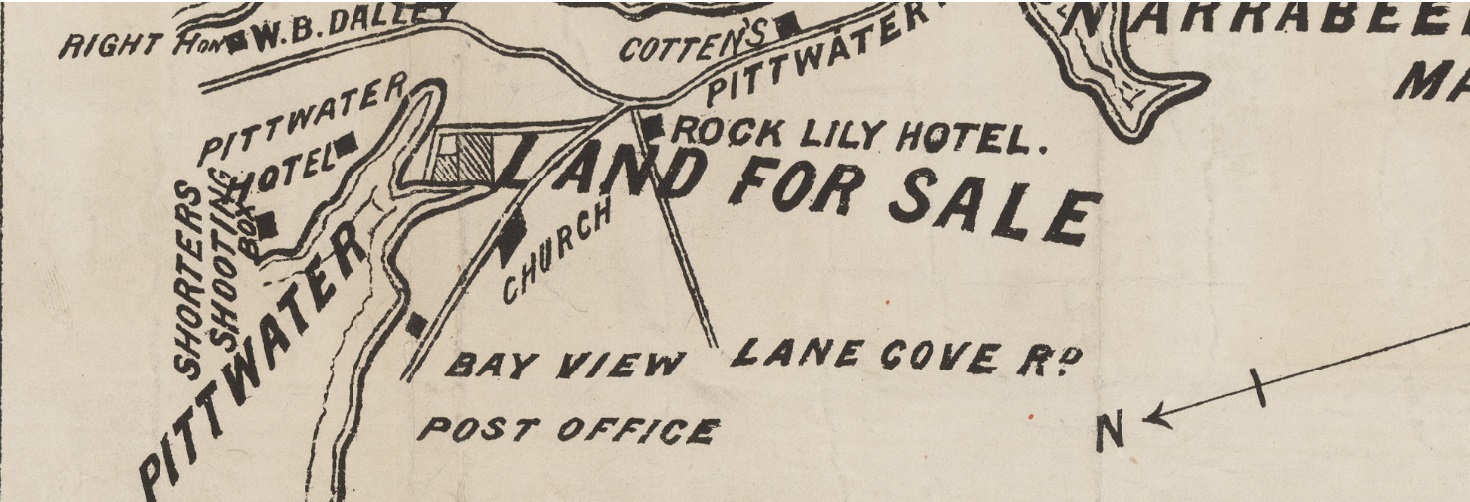
Centenary Estate Image No: 9500001h, March 1892- and sections from enlarged - courtesy State Library of NSW
CROWN LAND SALE, ALLOTMENTS £6 to £17 each. Village of Turimetta, close to Rock Lily Hotel Pittwater; day of sale, 25th January, 1897 at 11.30 a.m. E. C. V. Broughton. Auctioneer, 260 Pitt-st. Sydney. Advertising. (1896, December 26). Evening News (Sydney, NSW : 1869 - 1931), p. 8. Retrieved from http://nla.gov.au/nla.news-article108215572
Crown Land Sale. As announced in our advertising columns, Mr. E.C. V. Broughton, under instructions from the Minister for Lands, will conduct a Crown land sale at his rooms, 250 Pitt-street. The land to be offered comprises sixty-six blocks in the village of Turimetta, adjoining the Rock Lily Hotel, Pittwater. Areas, from ½ s to nearly 3s. Upsets, from £6 to £22 per lot.. Terms, quarter cash, balance in three equal annual payments, interest 5 per cent. From the inquiry, evinced it is anticipated that a successful sale will result. Crown Land Sale. (1897, January 27). Evening News (Sydney, NSW : 1869 - 1931), p. 3. Retrieved from http://nla.gov.au/nla.news-article108861575
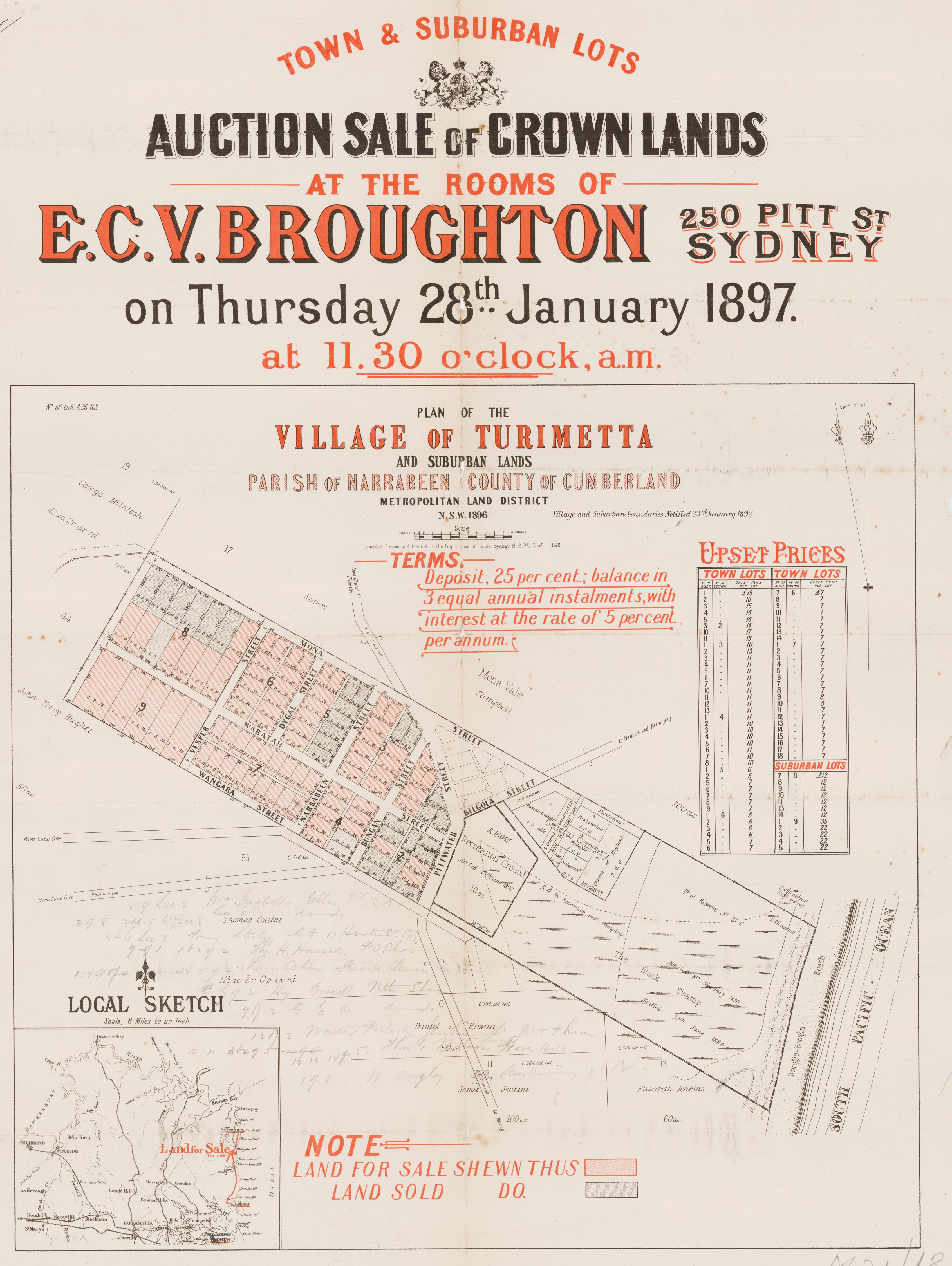
Plan of the Village of Turimetta and Suburban Lands - Parish of Narrabeen - Vesper St, Mona Street, Allen St, Pittwater St, Wangara St, 1897. Item c046820016 , from album Mona vale Subdivisions, courtesy State Library of NSW
Mr. E. C. V. Broughton sold on the ground on Saturday last the whole of Gilbert Park Estate, Canterbury, at prices ranging from 2a 7d to 17s per foot, and also, under instructions from the Minister for Lands, sold at his rooms, 250 Pitt-street, on Thursday last, the following lots in the village of Turimetta, adjoining the Rook Lily Hotel, Pittwater : — Section 1, lots.1 and 3, ... each ; section 2, lot. 10, .£18 ;lot. 11, £19; section 3, lot. 1, £10; lot. 2, £13; section 4, lot. 5, .£10 : section 7, lot. 10, £8; section 8, lot. 13, .£12. Total sales,-£120. FACTORIES AND SHOPS ACT. (1897, January 31). Sunday Times (Sydney, NSW : 1895 - 1930), p. 8. Retrieved from http://nla.gov.au/nla.news-article126248262
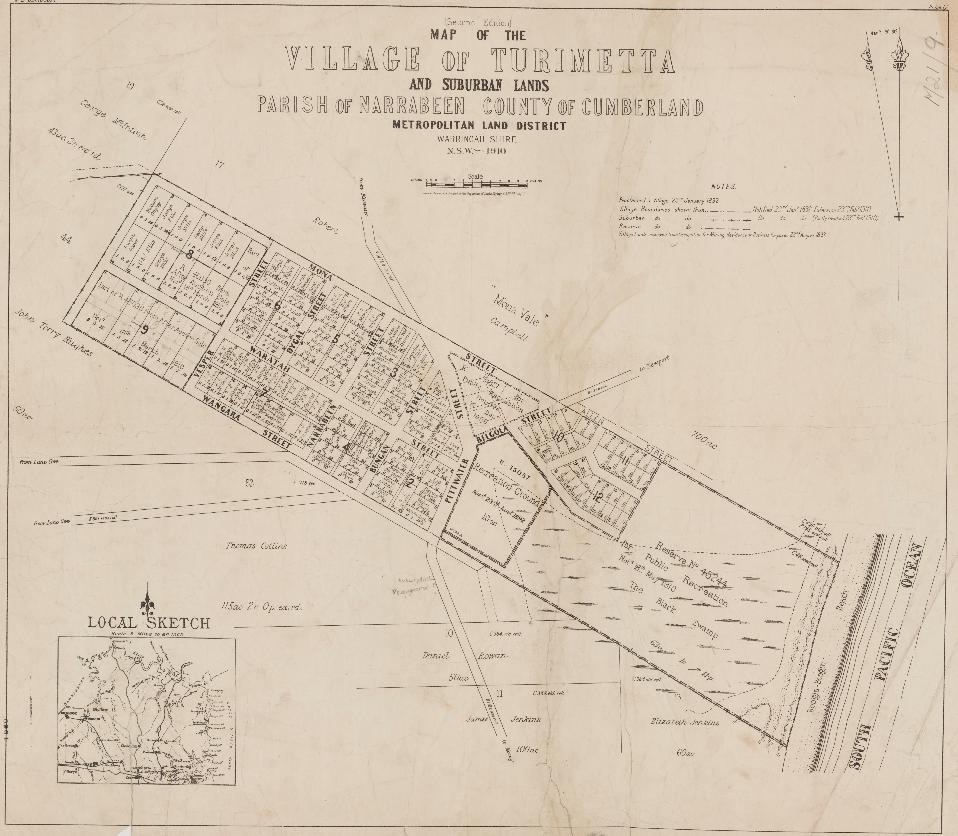
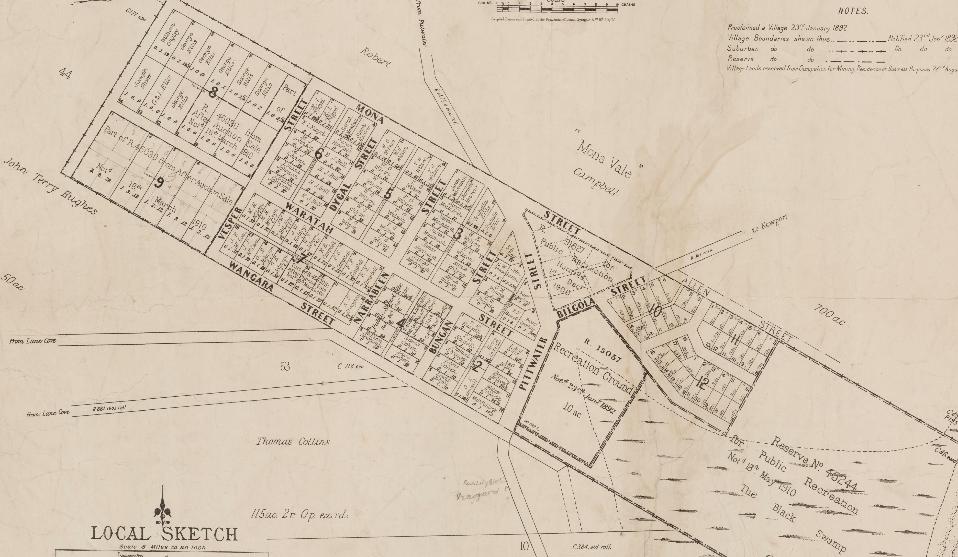
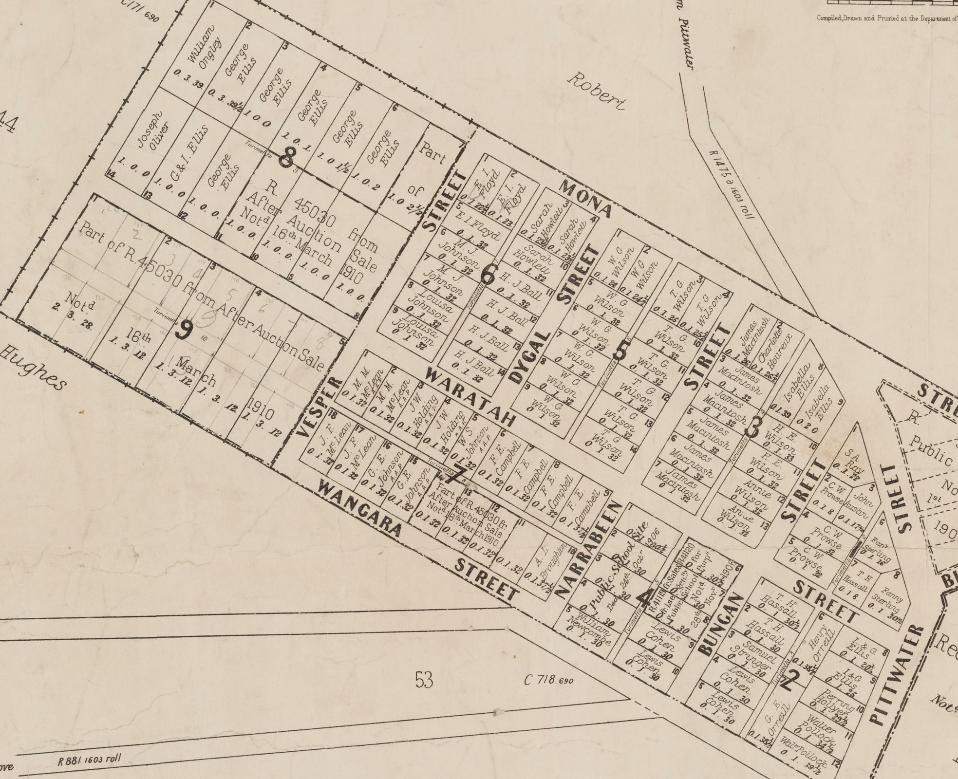
BY ORDER OF THE EXECUTORS THE ESTATE OF THE LATE MR. WILLIAM JOSEPH BAKER. ONE OF THE MOST CHARMING SPOTS AROUND SYDNEY. CHURCH POINT, PITTWATER. A pleasant Motor or Coach drive from Manly, through delightful and varied Scenery. SPLENDID SUBDIVISION BLOCK OF ABOUT 30 ACRES, PRACTICALLY A WATER FRONTAGE, with LARGE FRONTAGE to the MAIN ROAD, adjoining La Corniche, the well-known Accommodation House of Mons. Rainaud, and the old Public School, now the Property of Mr. Lesslie. The LAND is Fenced, and the improvements comprise old W.B. COTTAGE, with Iron Roof, containing Verandah, Hall, 6 Rooms, Kitchen, 2 Room's off, detached Stables, Shed, etc. There is an old Orchard of various Fruit Trees, and the Land is mostly nicely grassed, and divided into Paddocks. The Property is let on Lease till 1st July out to Mons. Rainaud. THE VIEWS ARE SUPERB, and embrace Pittwater, Scotland Island, Newport, etc
In the hands of a Capitalist for the building of week-end Cottages as on Investment, or for Subdivision purposes, the sale of this Property OFFERS EXCEPTIONAL CHANCES. Numerous overtures have been made to the Trustees to sell portions of about 1 acre. TITLE TORRENS. Plan at the Salerooms. HARDIE and GORMAN have received Instructions to sell by Public Auction, at their Salerooms, 133 Pitt-street, at 11.30 o'clock on WEDNESDAY, 7th OCTOBER, 1908, The above-described Property at Pittwater.Advertising. (1908, September 19). The Sydney Morning Herald (NSW : 1842 - 1954), p. 22. Retrieved from http://nla.gov.au/nla.news-article15010463
BEAUTIFUL PITTWATER. CHURCH POINT ESTATE. THE WEEK-ENDER'S PARADISE.
ENTRANCING VIEW'S, with a scope of 100 miles of Smooth-water Navigation, suitable for MOTOR LAUNCHES and AQUATIC PLEASURE-SEEKERS. Highly Recommended by the Medical Profession for a Week-end Rest.
AT THE CHURCH POINT WHARF, AND THE TERMINUS OF THE COACHES FROM MANLY. IN LARGE AREAS OF ABOUT THREE ACRES EACH. Well known as the Property of the late Dr. Tibbitts. General Store and Post-office adjoining the Estate. N.B.-This is the only Land available on the mainland, and will be Sold at Bargain Prices, so the Liberal Terms of 10 per cent, cash, Balance by 12 Quarterly Payments, interest at 4 per cent, perannum-, 5 per cent. Discount for Cash. Mr. A. M. SIMPSON, Storekeeper at Church Point, will point out the Land for Sale. SALE ON THE GROUND SATURDAY, 20th NOVEMBER, AT 2 P.M. Advertising. (1909, November 6). The Sydney Morning Herald (NSW : 1842 - 1954), p. 22. Retrieved from http://nla.gov.au/nla.news-article15084034
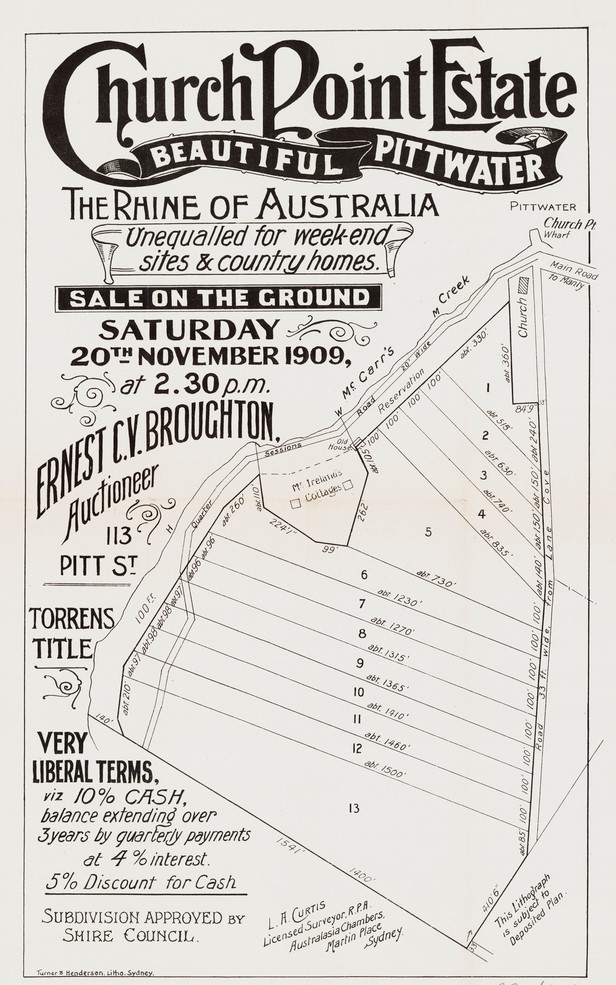
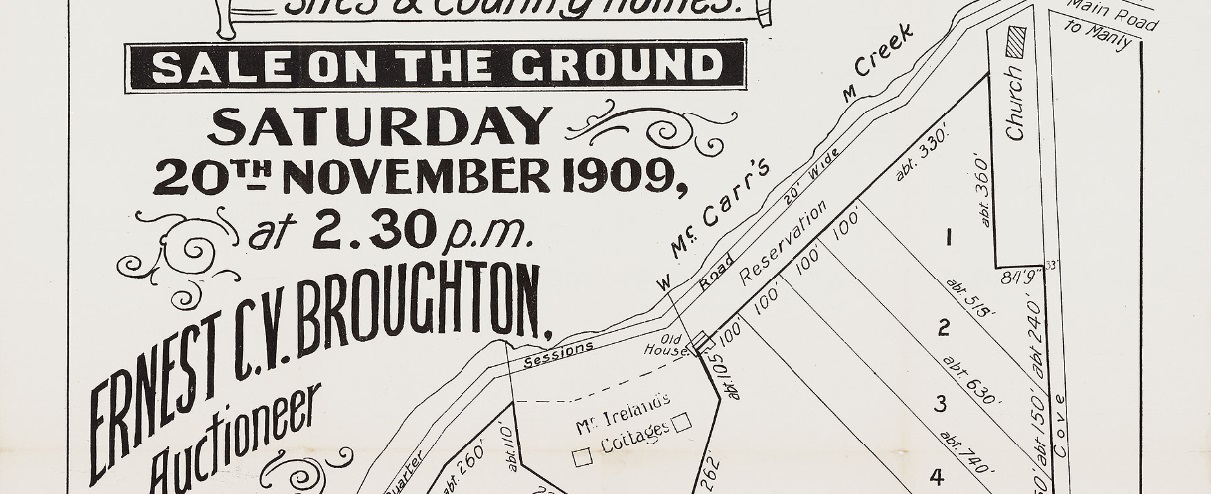
Church Point Estate Pittwater, Quarter Session Rd, Lane Cove, Sat. 20th Nov. 1909. Image No.: c035690001, courtesy Mitchell Library, State Library of NSW, and enlarged section from to show detail
No. 16,855. APPLICANT :—Justine Leontine Briquet, Rocklily. LAND:—County Cumberland, parish Narrabeen, shire Warringah, 2 acres, 3 roods, 2 acres 2 roods 1/2 perch, 9 acres 3 roods, on Bay View Road, in Darley and Allen streets, and on South Pacific Ocean, near Pittwater,—lots 3 and 14 to 17, section 1, lots 16 to 36, section 2, Mona Vale Estate, and part 700 acres (portion 17 of parish) granted to Robert Campbell ; adjoining properties of F. Ball, Trustees Church of England, and J. T. Hewitt.
Diagrams delineating these lands may be inspected at the Land Titles Office, Elizabeth-street, Sydney.
W. G. H-WILLIAMS,
Registrar-General. 21st December, 1910. NOTICE UNDER REAL PROPERTY ACT. (1910, December 21). Government Gazette of the State of New South Wales (Sydney, NSW : 1901 - 2001), p. 6886. Retrieved from http://nla.gov.au/nla.news-article229311881
No. 17,898. APPLICANTS:—Ada Louisa Ethel Black, Auckland, New Zealand, and Mabel Daisy Black, Annandale. LAND: —County Cumberland, parish Narrabeen, shire Warringah, 18 acres 2 roods, 244 perches, on Bay View road, at Pittwater,—part 40 acres (portion 43 of parish"), granted to George Weller; adjoining properties of D. Millar, A. M. Simpson, and J. Ware. NOTICE UNDER REAL PROPERTY ACT. (1912, April 10). Government Gazette of the State of New South Wales (Sydney, NSW : 1901 - 2001), p. 2230. Retrieved from http://nla.gov.au/nla.news-article227591158
Ada and Mabel Black were daughters of Broken Bay Customs Station Master Albert Thomas Black. All of their siblings, and themselves, were born at Barrenjoey and Christened at the newly opened St John the Baptist Church in Pittwater in 1871. The land had been bought by their father. He had also purchased land at Careel Bay.
Albert and Kate Black with their family at Barrenjoey - W. Deaton standing (mod Centre), Kate's sister is lower left - Kate is mid picture
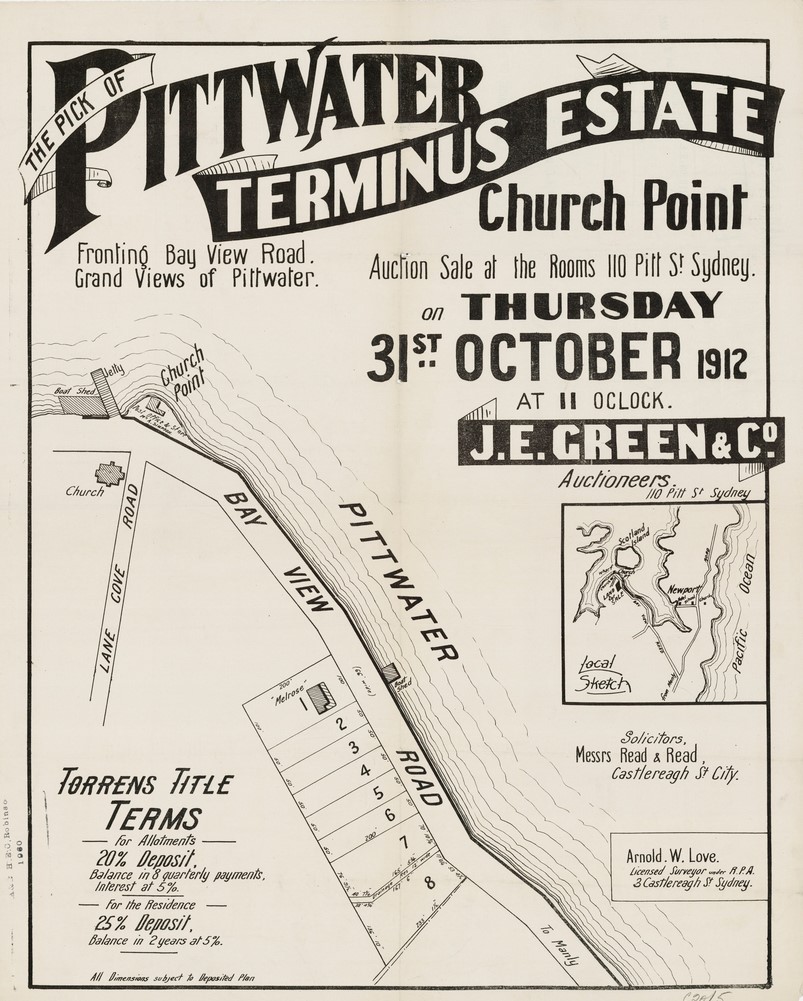
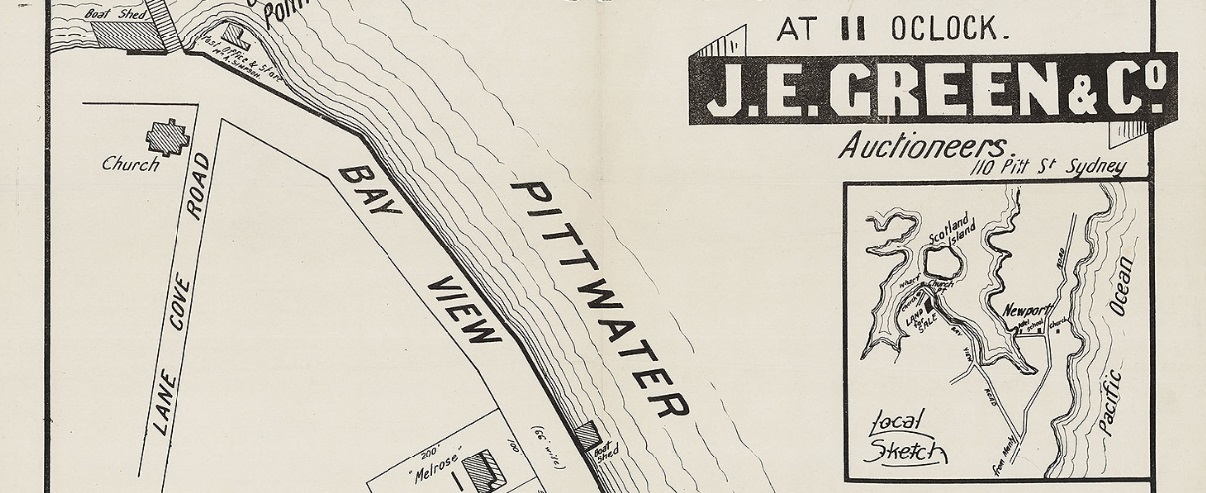
Pittwater Terminus Estate Church Point, Lane Cove Rd, Bay View Rd, Thurs. 31st Oct. 1912. Image No.: c035690006,courtesy Mitchell Library, State Library of NSW, and enlarged section from to show detail
Visit - The Green Frog - Melrose - NB: annotation by the Champions
No. 18,863. APPLICANT:—Edward Marsh Brodie, Sydney. LAND:—County Cumberland, parish Narrabeen, shire Warringah, 6 acres 19 1/2 perches, in Bay View road, Mona and Parley streets,—lot 53, section 1, Mona Vale Estate, and part 700 acres (portion 17, parish), granted to Robert Campbell; adjoining properties of T. Oliver and B. McCarthy. NOTICE UNDER REAL PROPERTY ACT. (1914, April 15). Government Gazette of the State of New South Wales (Sydney, NSW : 1901 - 2001), p. 2278. Retrieved from http://nla.gov.au/nla.news-article227334466
No. 19,248. APPLICANT .—Mabel Daisy Black, Annandale. LAND: County Cumberland, parish Narrabeen, shire Warringah,—8 acres 20 perches, at Pittwater, on Bay View road and a road 30 links wide,—being part 40 acres (portion 43. of parish), granted to George Weller; adjoining properties of F. J. S. Young, S. R. Mitchell, P. T. Taylor, Dr. J. Isbister, and G. Leslie. NOTICE UNDER REAL PROPERTY ACT. (1914, August 19). Government Gazette of the State of New South Wales (Sydney, NSW : 1901 - 2001), p. 5039. Retrieved , from http://nla.gov.au/nla.news-article227674898
No. 19,526. APPLICANTS:—Russell Sinclair and Margaret Jane Sinclair, both of Sydney. LAND: — County Cumberland, parish Narrabeen, shire Warringah, 2 roods 11 perches, on Bay View road, Pittwater,--being part 200 acres (portion 28, parish), granted to Robert Macintosh, the elder; adjoining properties of C. W. Bennett and Mrs. M. Wilshire. NOTICE UNDER REAL PROPERTY ACT. (1914, November 25). Government Gazette of the State of New South Wales (Sydney, NSW : 1901 - 2001), p. 7040. Retrieved from http://nla.gov.au/nla.news-article227424527
Taking advantage of the holiday, a number of subdivision sales have been arranged for Baroona Estate at Church Point, Bayview, the Barona Estate will come under the hammer, when Messrs. Batt, Rodd, and Purves will submit some good week-end allotments. Special arrangements have been made for free trips by motor car to the estate. REAL ESTATE. (1918, January 26). The Sydney Morning Herald (NSW : 1842 - 1954), p. 9. Retrieved from http://nla.gov.au/nla.news-article15779009
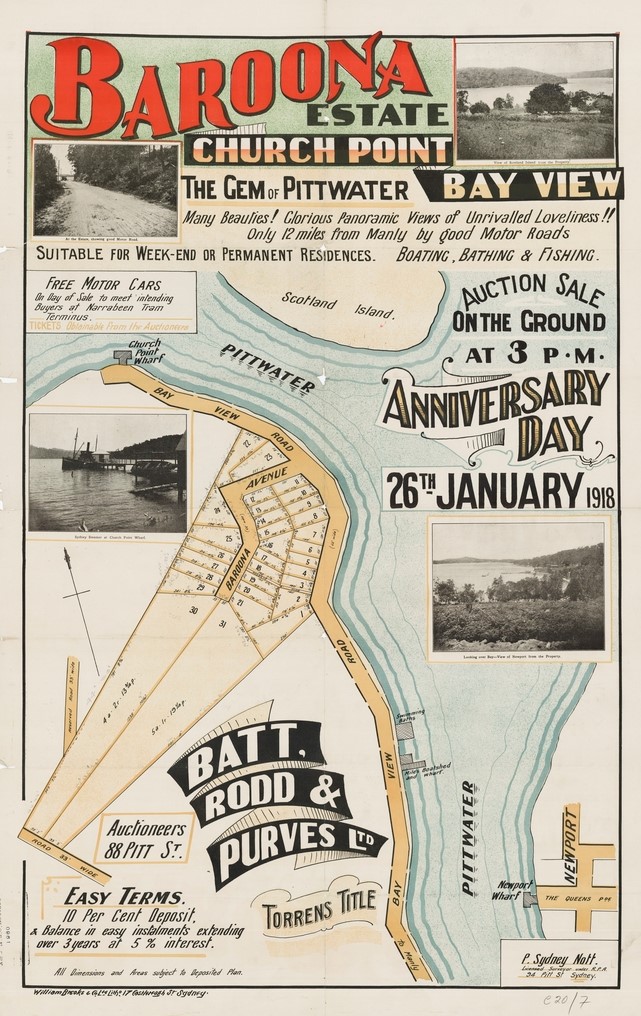
 baroona.jpg?timestamp=1542334459705)
baroona.jpg?timestamp=1542334519732)
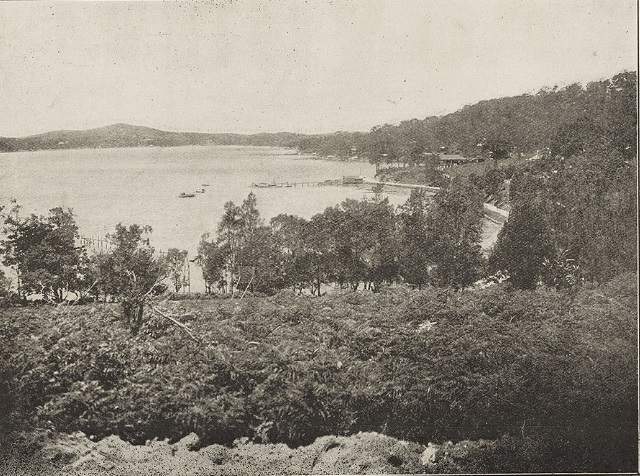
 baroona.jpg?timestamp=1542334422343)
baroona.jpg?timestamp=1542334587358)
Baroona Estate - Church Point Subdivisions, 1918, Image No.: c035690008h, courtesy Mitchell Library, State Library of NSW - and enlarged sections from to show detail
BAY VIEW, PITTWATER WATER-FRONTAGE COTTAGE RESIDENCE and 25 ½ ACRES OF BEAUTIFUL GROUNDS. Having 600 FEET FRONTAGE TO THE WATERS OF Pittwater, Close to BAY VIEW POST OFFICE AND WHARF. Adjoining the Residence of Sir Rupert Clarke, Professor Wilson, and P.T. Taylor, Esq. Commanding EXQUISITE VIEWS, Embracing the WHOLE LENGTH OF PITTWATER, from BAY VIEW to LION ISLAND, at the ENTRANCE to the HAWKESBURY RIVER.
The Cottage is most substantially, built of stone, with tiled roof, and contains verandah front and side, porch entrance (tiled), sitting-room, dining-room, study, 4 bedrooms, bathroom, storeroom, pantry, kitchen, and washhouse. Detached stable and buggy-house. The ATTENTION of SQUATTERS : and CITY MEN is directed to the Sale as affording an opportunity to acquire a WATERSIDE WEEK-END HOME, or it could be APPLIED by SPECULATORS - SUBDIVISION FORM. TERMS OF SALE;— One-fourth Deposit, balance in 3 years at 6 per cent. Full particulars obtainable from the Auctioneers. RICHARDSON and WRENCH, LTD., 92 Pitt Street. Advertising (1919, August 23). The Daily Telegraph (Sydney, NSW : 1883 - 1930), p. 4. Retrieved from http://nla.gov.au/nla.news-article239644622
MONA VALE-PITTWATER Old established General Store and Freehold, JUNCTION STORE, Pittwater and Newport roads Modern brick building, large shop, 5 rooms, stabling, etc TORRENS. Raine and Horne auctioneers. Advertising (1919, March 6). The Sydney Morning Herald (NSW : 1842 - 1954), p. 10. Retrieved from http://nla.gov.au/nla.news-article15828225
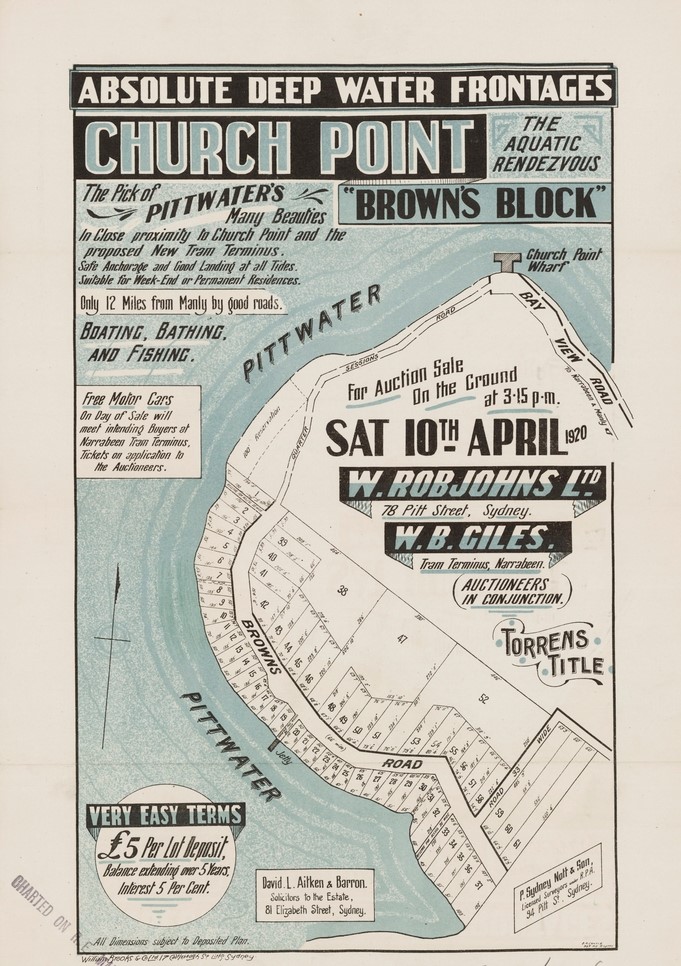
Before being named 'McCarrs Creek Road' - Church Point "Browns Block" Pittwater;Browns Rd, Quarter Session Rd, Bay View Rd Sat. 10th April 1920, Image No.: c035690002, courtesy Mitchell Library, State Library of NSW
REAL ESTATE AUCTION SALES. PITTWATER. ESTATE OF LA- CORNICHE.ESTATE OF LA CORNICHE.ESTATE OF LA CORNICHE. AUCTION SALE. ON THE GROUND.AUCTION SALE. ON THE GROUND. SATURDAY NEXT, at 2.30. This picturesque subdivision Is situated, between BAYVIEW and CHURCH POINT,. and/ comprises -26 BEAUTIFUL LOTS. and three Cottages. KILLARNEY. . ‘LA CORNICHE. ' and another. A frequent Motor Bus Service connects with all Trams from Manly at Narrabeen. TORRENS TITLE. EASY TERMS. One-tenth Deposit. Balance by 13 quarterly payments. Interest at 6 per cent. RAINE AND HORNE 70 PITT-STREET. AUCTIONEERS. Advertising. (1921, January 8). The Sydney Morning Herald(NSW : 1842 - 1954), p. 17. Retrieved from http://nla.gov.au/nla.news-article28090155
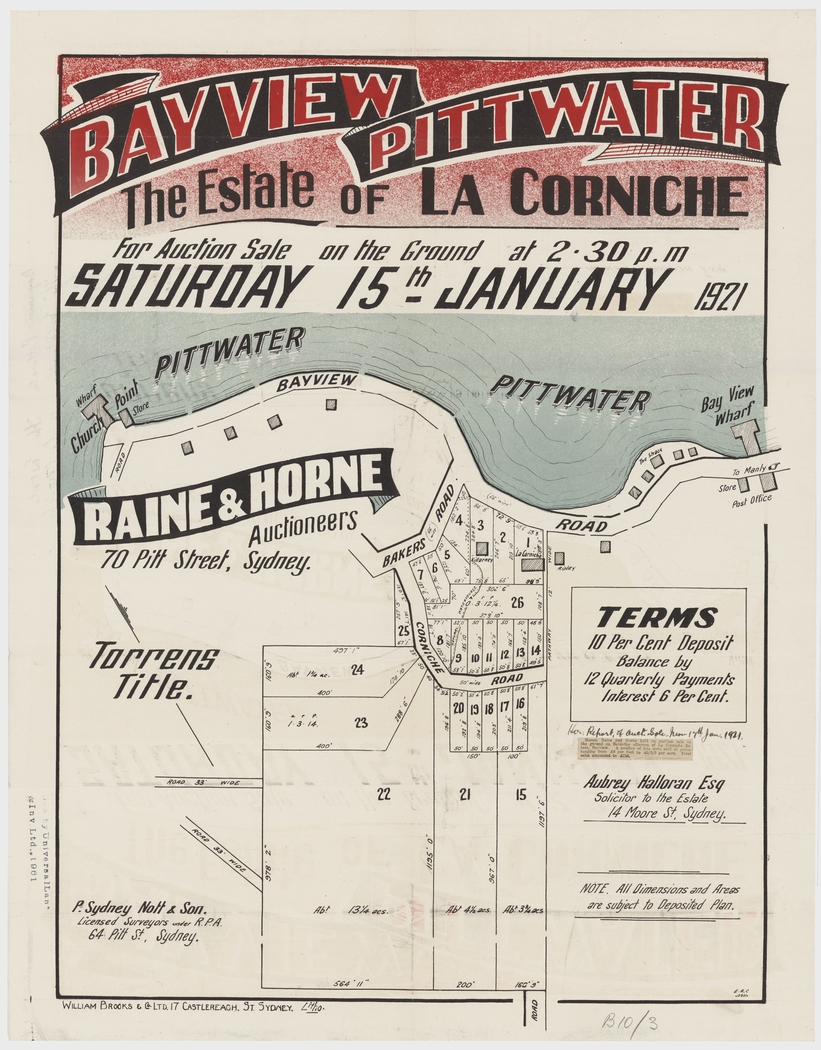
La Corniche Estate. Image No.; c029500003h, courtesy Mitchell Library, State Library of Australia
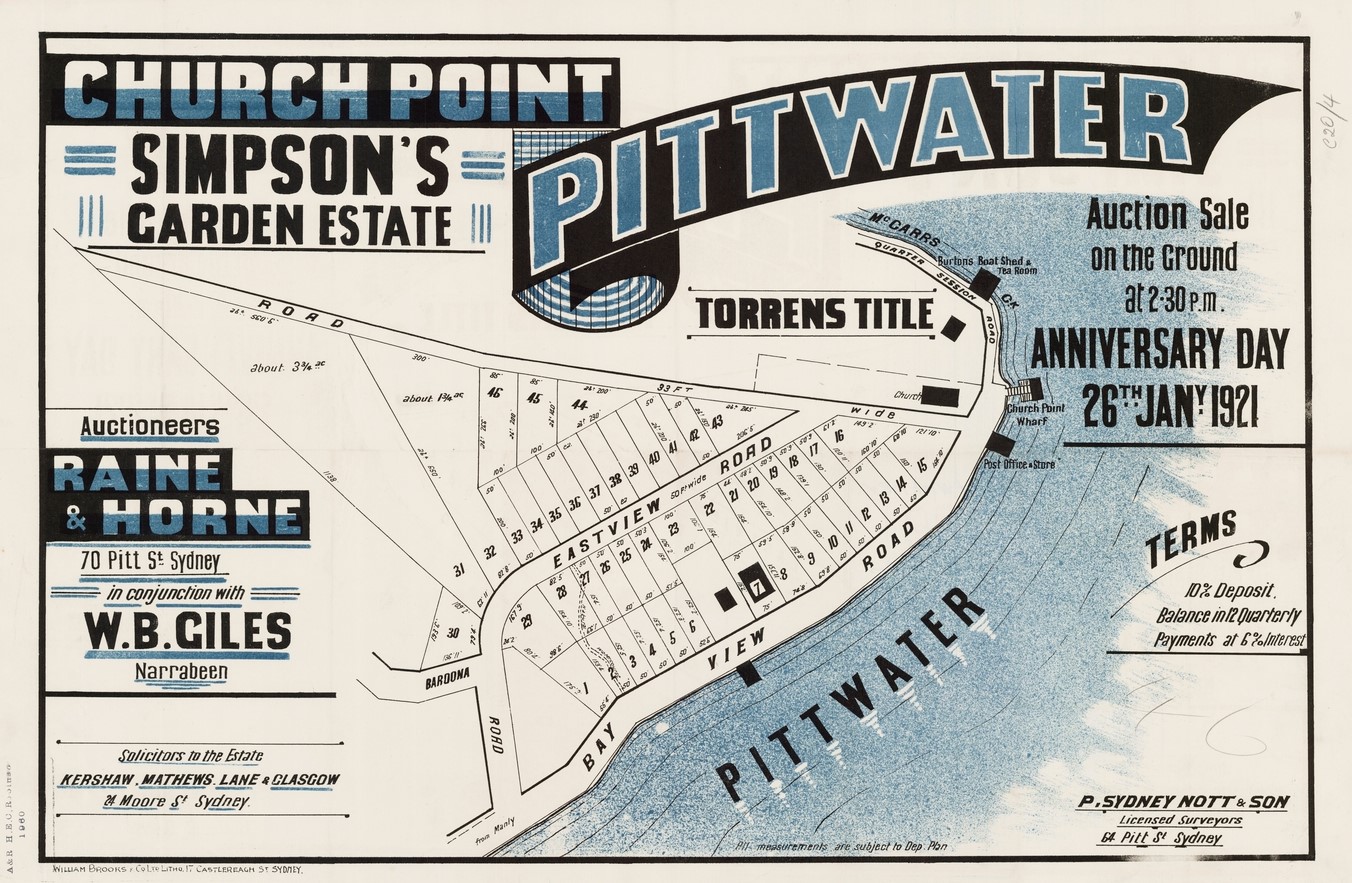
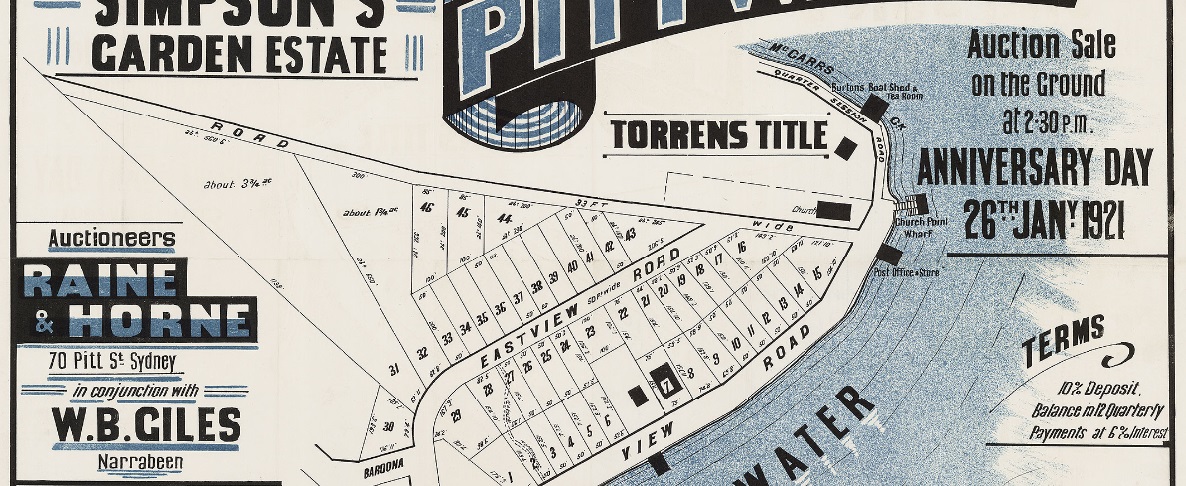
Simpson's Garden Estate Church Point Pittwater; Baroona Rd, Bay View Rd, Eastview Road, 26th Jan. 1921, Image No.: c035690005, courtesy Mitchell Library, State Library of Australia - The lots sold over successive months - Example; By private contract: Simpson's Garden Estate, Church Point, Pittwater, 2 lots. £125... REAL ESTATE. (1921, April 2). The Daily Telegraph (Sydney, NSW : 1883 - 1930), p. 17. Retrieved from http://nla.gov.au/nla.news-article239734635
Visit - The Green Frog - Melrose - NB: annotation by the Champions
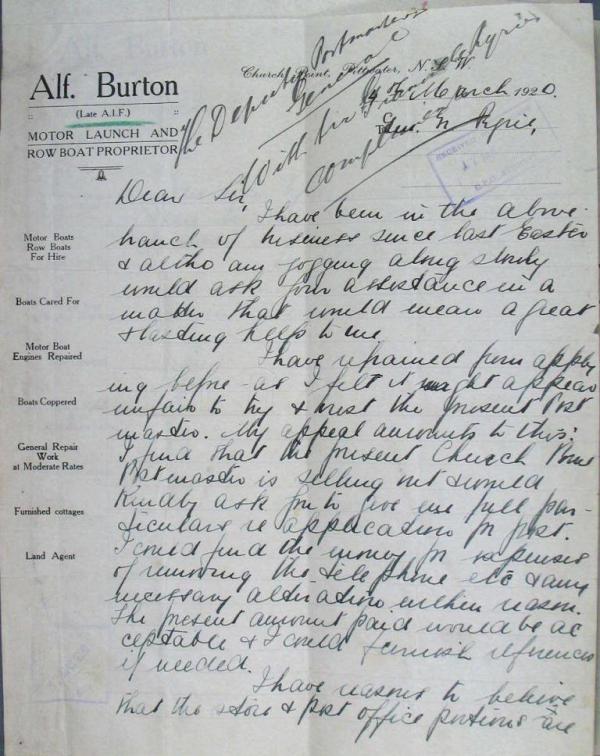
BILL'S ESTATE
Popular Pittwater
On Boxing Day William Robjohns and Co. will submit eight building allotments at Pittwater, on the ground, at 3 p.m. Four of the blocks are situate on the corner of Edwards-street and Bay view-road, about 200 yards from the Bayview Wharf, while the other four allotments are water-frontage blocks facing Pittwater and Sandy Beach. Pittwater is becoming more and more popular with the land-seeker who is desirous of acquiring ail allotment handy to any of our wonderful beaches, and, in view of the splendid situation of these blocks, a brisk sale should result. The title of the land is Torrens, and 10 per cent deposit is required. Further information is obtainable from the auctioneers, William Robjohns and Co., 121 Pitt-street, Sydney. BILL'S ESTATE (1924, December 24). The Sun (Sydney, NSW : 1910 - 1954), p. 2 (LAST RACE EDITION). Retrieved from http://nla.gov.au/nla.news-article223574942
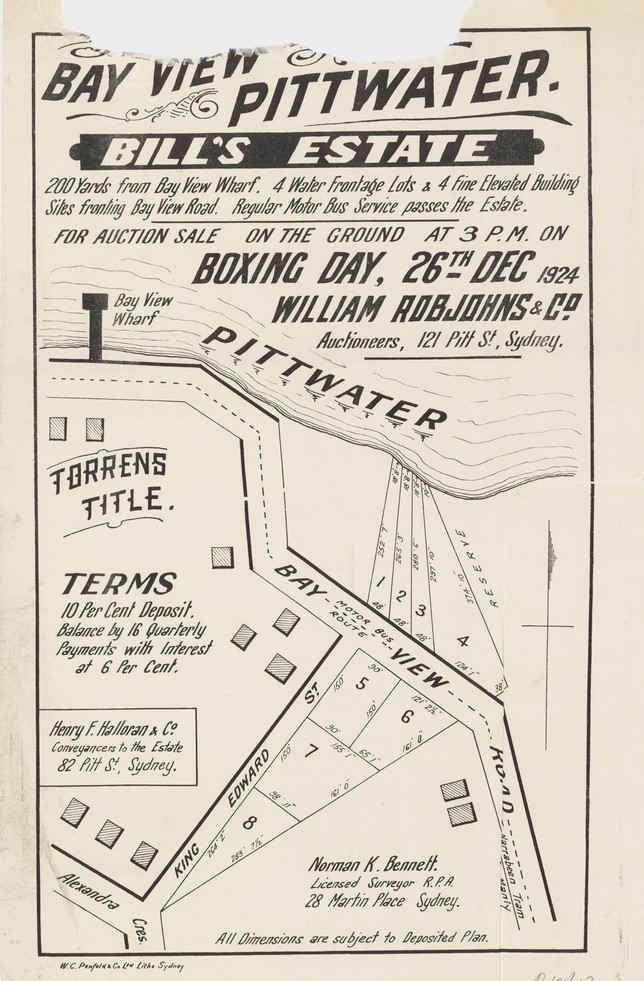
Bayview subdivision plans, Bill's Estate, Image no.: c029500013, courtesy State Library of NSW
23. G.S.Mackellar & Son, 9/10/41, on behalf of Mr. Mark Foy, requesting Council's permission to sell Lot 14 and Lot B, being part Lot 15, D.P. 9606, Bayview Road, and to retain Lot 14A. Resolved, - That the desired permission be granted, Subdn. A. provided that Lot 14A is attached in title to Mr. Foy's property known as "The Cabin", situated between Bayview Road and the waters of Pittwater. 24. Mrs. A. Turnbull, 0/10/41, requesting that attention be given to the roadway leading up from the main road to her home at Church Point, as there have been several nasty falls on the Road Point road. Resolved, - That the maintenance give attention to the road, as recommended by the Engineer. (Crs. O'Reilly, Nicholas)
Changes can also be seen in the installation of Utilities and residents requests - forming themselves then, as now, into community groups:
MONA VALE WATER SERVICE
Local Rate Required
The extension of the water service to Mona Vale will involve the necessity for a local rate. The roads to be served are: Pittwater-road, Bay-view-road, Newport-road, Vineyard-street, Bungan-street, Mona-street. Darley-street, and By-the-Sea-road. The total ratable frontage will be 42,408ft. This at 80s per foot, an average struck on values, as assessed for this year, has (says the shire clerk in a report to the Warringah Council) a total unimproved value of £63,612. The rate necessary to be levied to make up the estimated annual deficiency of £317 14s 9d is 1 l-5d in the £. . : A petition has been forwarded to the Water Board asking for the inclusion of Warriewood-road in the reticulation scheme. MONA VALE WATER SERVICE (1923, September 18). The Sun (Sydney, NSW : 1910 - 1954), p. 10 (FINAL EXTRA). Retrieved from http://nla.gov.au/nla.news-article222681170
MONA VALE GETS A MOVE ON
Residents Insist on Good Roads and Other Improvements — Progress Association formed
TOURISTS' PARADISE.
Residents of the district extending from Green Hills to Church Point met at the Mona Vale Town Hall last night formed a Progress Association to co-operate with the Warringah Shire Council in getting necessary work done in their picturesque area.
There was a splendid roll-up of enthusiasts from all parts of the district. Some came in their motor cars, others walked through the bush for tulles, guided by the light of their lanterns.
They elected their officers, adopted their rules, and outlined their plan of campaign. Mr. H. Lodge was appointed president, Mr. W. W. Hill vice-president, Mr. Muddle secretary, and Mr. Austin, treasurer. The president pointed out that the association would confine its activities to the area extending from Green Hills to Church Point, which had not received the attention at the hands of the council that it deserved.
REFORM PLAN. Mr. Williams (Bay View) said that the Progress Association would not rest content until: —
(1) The Warringah Shire Council makes a more equitable expenditure in A riding in proportion to the rates paid by the residents of that area. A riding extends from Narrabeen to Barrenjoey, and to Cowan on the western side.)
(2) First-class roads ore constructed from Manly to Pittwater— tho gateway from Sydney to the beautiful Kuringai Chase.
(3) The approaches to the surfing beaches are improved.
(4) The wharves and baths at Bay View are made safe. (At present the stringers on the wharves are runuu, and the wire-netting In the baths Is in a most dilapidated condition— sharks ran easily get through the huge holes at high tide.)
(5) The steps are made safe from the wharves to the boats at Bay View. (At present one has to be a gymnast to be able to Jump from the boats to the first step on the wharf. Four steps are missing, and the rest are rotting.)
(6) The wharf at Church Point is made safe for the public. (It, like the wharf at Bay View, is rotting away.)
(7) The Black swamp at Mona Vale is drained and utilised either as a public park or a golf course.
A BEAUTIFUL AREA.
When these reforms are executed the district will be the pride of all Australians, blessed by Nature with scenic beauty beyond compare in the world; with glorious surfing beaches and mile after mile of beautiful bays, set like Jewels in sylvan surroundings, reflecting in their still depths the graceful trees that adorn them — bays for boating, fishing, and swimming, it is little wonder that the Pittwater district, which the newly-formed Progress Association is out to improve, is so popular with tourists.
The district has commercial possibilities also, in its soil almost anything can be grown. Mr. Fredericks, of Mona Vale, is cultivating successfully pineapples, bananas, mangoes, citrus fruits, and sugar cane. And only 18 miles from Sydney!
At present the district is renowned as a tourist resort, but with the advent of the Spit Bridge, rendering it, with good roads, easily accessible to the city, it will probably develop into one of the most popular residential areas on the outskirts of Sydney. The Mona Vale Progress Association is determined that this wonderful district shall come into its own. MONA VALE GETS A MOVE ON (1924, July 2). The Labor Daily (Sydney, NSW : 1924 - 1938), p. 5. Retrieved from http://nla.gov.au/nla.news-article236544961
SHIRE OF WARRINGAH.
Special Loan, £21,000—"A'' Riding.
WARRINGAH Shire Council hereby gives notice, in accordance with the provisions of Local Government Act, 1919, that:—
1. The Council proposes to raise a Special Loan of twenty-one thousand founds (£21,000) for the purpose of carrying but in Riding "A" of the Shire certain public works, the acquisition of certain lands for public recreation purposes, and the acquisition of certain lands for road purposes; and for the purpose of paying expenses incidental to the carrying out of such works and acquisitions.
2. The Council proposes to expend the loan money as follows, but reserves the right to utilise the surplus or saving on any one item in paying the excess cost of any other:—
(a) In Palm Beach-Whale Beach District:
Public Reserve oil shore of Pittwater, Palm Beach — Filling, levelling, and construction of retaining wall £1,000
Ocean Beach Reserve, Palm Beach—Making parking area and constructing pipe-line in southern portion £250
Governor Phillip Park — Erection of public lavatories £500
New Wharf—Construction of, at Palm Beach, Pittwater side £500
Improvements to roads, viz.—Florida-road, £1,000; Pacific-road, £405; Palm Beach road, £500; road from Barrenjoey-road to Whale Beach, £500; road from Whale Beach to Palm Beach, £500 2,905
(b) In Avalon-Bilgola-Clareville District:
Public rock-bath at Avalon Beach—Enlargement of £250
Avalon Flat Drainage—Construction of concrete culverts £700
Avalon Beach Reserve, Extension, etc.—
Acquisition of lot 26, Pittwater Estate, with exception of small portion at south western corner £2,750
Bilgola Beach Reserve—Construction of retaining wall £100
Improvements to roads, viz.—Central-road, £600; George-street, £300 900
(c) In Newport District:
Newport Ocean Beach Reserve — Levelling sand, and top-dressing, on northern portion £700
Newport Recreation and Sports Ground—
Fencing and other improvements £800
Queen's-parade drainage £ 300 Improvements to roads, viz.—Ocean-avenue, £400; Foam Crest avenue, £220; Myola road, £270; Bungan Head road, £400; Beaconsfield-street, £200; Karloo-parade, £200; Robertson-road, £150; Bardo-road, £300; King-street* £150; Queen's-parade and Stuart-street, £250 2,540
(d) In Mona Vale-Warriewood District:
Mona Vale Park—Culvert across park from Park-street to Newport-road £200
Drainage works, Bassett-street, at eastern end £600
Footpath formation—Gravelling footpath on Pittwater-road, Mona Vale £100 Improvements to roads, viz. — Darley-street, £400; Bassett-street, £220; Noble-street, £100; Bungan-street, £320; Allen-street, £160; Rickard-avenue, £100; Mona-street and Waterview-street, £250; Vineyard street, £150; Seaview-street, £126 , Seacrest-avenue, £200 : 1,826
(e) At Bay View—Church Point:
Bay View Park Construction of pavilion and boat-shed £750
Church Point-—Reclamation and parking area near public wharf £200
(f) In North Narrabeen District:
Lake Park Extension, and new road—Acquisition of land for enlargement of Lake Park and for new road connecting Narrabeen Park parade and Collins-street ... £1,075 Improvements to roads, viz. — Kobado and Elanora Estate roads, £750; Powderworks-road, £200; Deep Creek road, £200;- Warraba-road, £120; Garden street, £200; Taiyul-road, £200; Collins avenue and Walsh-street, £250 1,920
(g) Incidental and contingent expenses £634
Total £21,000
3. The Council proposes to carry out most of the abovementioned works under the Government's Emergency Relief Scheme. The proposed allocations to those works as set out above, are consequently allocations of loan money only and do not include the wages of the relief workers payable from grants receivable from the Government.
4. Plans and full details of the works to be carried out and of the lands to be acquired by means of the loan money may be inspected at the Council's office during the ordinary office hours.
5. The rate of interest on the loan will not exceed four per centum (4%) per annum, and the loan will be issued at par.
6. It is proposed to repay the loan over a period of twelve (12) years by 24 equal half-yearly instalments of principal and interest combined. The amount of each such instalment will be £1,110 os. 10d., or thereabouts.
7. For the purpose of repaying the loan and paying the interest on the loan the Council proposes to levy a rate of two-fifths of a penny (2/5d.) in the £ on the unimproved capital value of all ratable lands in the "A'' Biding of the Shire. (Total u.c.v., £1,326,723.) Should the proposed rate not provide sufficient for the purpose the deficiency will be paid from the General Fund of the Shire and charged to "A" Hiding's portion of that fund. (Nom—The loans of £28,200 and £3,500 raised ten years ago or thereabouts for the carrying out of public works in "A" Biding will be entirely repaid this year, and the present loan rate of 4/5d. in the £ levied in respect of them will not be levied after this year, but will be replaced by the proposed rate of 2/5d.).
8. Within one month of the date of the publication of this notice any number not less than twenty-five per centum (25%) of the ratepayers enrolled for "A" Riding may petition the Council to take a poll of the ratepayers, either as to whether the ratepayers approve of the loan or as to whether the loan rate shall be on the unimproved capital value or improved capital value, or on both questions. The number of ratepayers on the Roll of Electors for "A"' Riding is 5,421.
A. H. HUGHES, President. R. G. Jamieson, Shire Clerk.
Shire Hall, Brookvale, 20th July, 1936.
SHIRE OF WARRINGAH. (1936, July 24).Government Gazette of the State of New South Wales (Sydney, NSW : 1901 - 2001), p. 3236. Retrieved from http://nla.gov.au/nla.news-article223038435
Meeting of 20/1/1942 13. Manly, Warringah & Pittwater Historical Society advising that the Society has been given two monuments to commemorate events of historical importance and requesting permission to erect one of these at McCarr's Creek near Church Point to Creek Rd, "commemorate that this beautiful piece of water was first surveyed by Captain John Hunter R.N. in 1789 and again in 1829 by W. R. Govett"; submitting rough sketch showing proposed position for the monument., Resolved, - The Society be informed the Council is prepared to give favourable consideration, to the proposal when the road has been dedicated t o the Council, but that it is still under the control of the Public Works Depart- ment, and suggesting that the Society get in touch with that Department. (Cre. Langdale, McLean)
One scheme worth noting:
County of Cumberland Planning Scheme
by Dictionary of Sydney staff writer 2008
CC BY-SA 2.0
The County of Cumberland Planning Scheme was arguably New South Wales's first attempt at a comprehensive and coordinated town plan for metropolitan Sydney, and, after a short and troubled history, it was ultimately a failure.
Aware that postwar growth would put pressure on Sydney's existing footprint, in July 1944 the Labor Premier William McKell announced that he intended to introduce legislation concerning both
the extension of the boundaries of the City of Sydney, and the Union of Areas in the County of Cumberland.
The second proposal was a most radical innovation in metropolitan governance, in that it created a tier of government intermediate between local and state governments – the Cumberland County Council – to oversee preparation and implementation of metropolitan Sydney's first statutory plan. The Cumberland County Council was established under the provisions of the Local Government (Town and Country Planning) Amendment Act 1945, which enabled local councils to prepare comprehensive local planning schemes for the first time. The process was overseen by a new Town Planning Branch in the Department of Local Government, with another new creation, the Town and Country Planning Advisory Committee, providing high-level ministerial advice.
Released in 1948 but not legally gazetted until 1951, the County of Cumberland Planning Scheme has been described as
the most definitive expression of a public policy on the form and content of an Australian metropolitan area ever attempted.
It drew inspiration from the London plans of Patrick Abercrombie, and introduced land use zoning, suburban employment zones, open space acquisitions, and the idea of a 'green belt' for greater Sydney. The Main Roads Department supplied plans for an expressway network. The scheme tied in with the Commonwealth Government's strategy to prepare for predicted rapid postwar growth, and in June 1947 the Cumberland County Council was inaugurated by state parliament, to prepare 'for the guidance and control of growth in the County' – ultimately the future direction of growth for metropolitan Sydney.
Opposition to the plan
The cornerstone of the Cumberland County Council Scheme was a 'green belt' around the existing urban footprint, designed to restrict urban sprawl, while satellite towns beyond the belt would take care of future growth. But from the outset, the Cumberland County Council was in a precarious position, particularly with its constituent councils, which were uneasy about its new powers: only four suburban municipalities had worked to develop comprehensive town planning schemes by the time of the Cumberland County Council's formal demise. It also faced hostility from more entrenched state government agencies, such as the Sydney Water Board and the Department of Housing. It met strenuous opposition from property owners, and by the mid-1950s had 22,000 claims against it for 'injurious affectation' arising from county zoning. A further blow came when anticipated Commonwealth funding never eventuated.
The green belt to prevent sprawl was the most contentious element, and it was continually attacked by developers, who saw it as an impediment to future profits. In response to these mounting pressures, the Cumberland County Council was dissolved on 19 December 1963 and replaced by a State Planning Authority, in accordance with the State Planning Authority Act, 1963. With the advent of the conservative Askin state government in 1965, the Cumberland County Council Plan's grand objectives were finally put to rest, with the result that thousands of hectares of farmland were 'released' for housing, incrementally whittling the green belt away to accommodate ongoing population increases from both immigration and the long term results of the postwar 'baby boom'. The pressure of increasing demand for land also affected the Department of Main Roads' proposed 'County Roads': the state government requested that the Department eliminate the least necessary road reservations within the county. Thus raw new suburbs sprang up, devoid of vital infrastructure. An eventual compromise led to developers making contributions to help fund infrastructure in new release areas.
Dictionary of Sydney staff writer, County of Cumberland Planning Scheme, Dictionary of Sydney, 2008, http://dictionaryofsydney.org/entry/county_of_cumberland_planning_scheme
During the interim between coming into law and being made defunct, that green space we now know as Winnemerey Reserve, among others, was part of what was 'resumed':
County of Cumberland Planning Scheme
EXTRACTS FROM EXPLANATORY HANDBOOK.
(continued from last issue)
PART V. Preservation of Natural Beauty and of Places of Special Significance.
This part deals with the preservation of trees, foreshore scenery and places of scientific or historic interest. Preservation of Trees. Where it appears, to the Responsible Authority for the particular zone or reservation, to he advisable to preserve any tree or croup of trees, the Responsible Authority may issue a Tree Preservation Order. This may prohibit the ringbarking, cutting down, topping, lopping or wilful destruction of trees without consent of the Responsible Authority. Foreshore Scenic Protection Areas. Some areas adjacent to Port Jackson, George's River, Port Hacking and Pittwater are shown on the Scheme Map as Foreshore Scenic Protection Areas. The Governor has power to proclaim additional areas adjacent to any waterway.
The Responsible Authority for the particular zone or reservation, in dealing with any application to erect a building or use land in a Foreshore Scenic Protection Area, must have regard to the appearance of the proposed development to and from the adjacent waterway and its foreshores.
Before a local council approves such an application it must consult with the Cumberland County Council and, where Crown land is concerned, the Cumberland County Council must consult with the Minister for Local Government. Foreshore Building Lines. The Responsible Authority for the particular zone or reservation may by resolution fix building lines in respect of any land fronting any harbour, bay, river, ocean, lake, estuary or lagoon. Buildings shall not be erected between this building line and the water. Places of Scientific or Historic Interest. On the application of the Cumberland County Council, the Governor may proclaim any land, building or work to be a place of scientific or historic interest. No person may then make any alteration or additions to or demolish the building or work without the consent of the Cumberland County Council. The owner may require the acquisition of the property and the Cumberland County Council also has the power to acquire it at any time. Next week: Part VI.—Applications and Approvals.
County of Cumberland Planning Scheme (1952, July 16). Construction (Sydney, NSW : 1938 - 1954), p. 4. Retrieved from http://nla.gov.au/nla.news-article223548886
LOCAL GOVERNMENT ACT, 1919.
Cumberland County Council: Proposed Resumption of Land at Bayview.
HIS Excellency the Lieutenant-Governor, with the advice of the Executive Council, and in pursuance of the Local Government Act, 1919, has approved of the Cumberland County Council's causing a notice of resumption of the land described in the Schedule hereto, together with a description of such land, to be published in the Government Gazette and in a newspaper circulating in the area in which the land is located, such land being required by the Cumberland County Council for the purpose of carrying into effect the provisions of the County of Cumberland Planning Scheme. (S. 56-2,579)
Schedule.
All that piece or parcel of land situate in the Shire of Warringah, parish of Narrabeen and county of Cumberland, having a frontage to Pittwater-road, being lot 5a in deposited plan 11,186 and being part of the land comprised in Certificate of Title, registered volume 3,432, folio 16, and shown on plan with the Department of Local Government, Sydney.
J. B. RENSHAW, Minister for. Local Government. Department of Local Government, Sydney, 28th September, 1956.
LOCAL GOVERNMENT ACT, 1919. (1956, September 28). Government Gazette of the State of New South Wales (Sydney, NSW : 1901 - 2001), p. 2812. Retrieved from http://nla.gov.au/nla.news-article220390768
LOCAL GOVERNMENT ACT, 1919
Suspension of Provisions of County of Cumberland Planning Scheme in Respect of Certain Land within Shire of Warringah
WHEREAS a resolution of the Cumberland County Council for the preparation of a Town and Country Planning Scheme for the whole of the county district, under Part XIIa of the Local Government Act, 1919, to vary the County of Cumberland Planning Scheme, took effect on 16th October, 1953, the date on which notice of the Minister's approval of such resolution was published in the Government Gazette: AND WHEREAS, after consideration of a report of the Town and Country Planning Advisory Committee it appeared to me, as Minister, expedient so to do for securing that development prohibited by the County of Cumberland Planning Scheme may be carried out, notwithstanding the provisions of that scheme: NOW I, the Minister aforesaid, in pursuance of the provisions of section J42v of the Local Government Act, 1919, hereby notify the suspension of the provisions of the County of Cumberland Planning Scheme as respects all development on the land referred to in the Schedule hereto. The provisions of Division 7 of Part XIIa of the Local Government Act, 1919, with respect to the control of interim development, shall apply, as from to-day's date, to development to which this notification relates. (S. 58-S83)
J. B. RENSHAW, Minister for Local Government. Department of Local Government, Sydney, 3rd April, 1959.
Schedule
All that parcel of land at Mona Vale in the Shire of Warringah, parish of Narrabeen and county of Cumberland, being lots 1 to 5 inclusive of D.P. 16,553, and having frontage to the northern side of Bassett-street
All those parcels of land at Mona Vale in the Shire of Warringah, parish of Narrabeen and county of Cumberland, fronting Maxwell-street, Park-street, Waratah-street and Government-road, as shown by red edging on plan catalogued No. 245—369 in the Department of Local Government, Sydney.
All those parcels of land at Dee Why West in the Shire of Warringah, parish of Manly Cove and county of Cumberland, being lots 29 to 35 inclusive, section 2, D.P. 1,818, and lots 10 to 16 inclusive, section 4, D.P. 1,818, fronting Wabashavenue; lot 34, section 5, and lot 14, section 7, D.P. 1,818, fronting Washington-avenue; lots 12 to 17 inclusive and lots 36, 37 and 38, section 8, D.P. 1,818, fronting Grover-avenue and Cleveland-avenue.
All that parcel of land at Elanora in the Shire of Warringah, parish of Narrabeen and county of Cumberland, being lot 2, D.P. 22,281, fronting Powderworks-road.
All those parcels of land at Forestville in the Shire of Warringah, parish of Manly Cove and county of Cumberland, having frontages to Keldie-street and Salerno-street, as shown by red edging on plan catalogued No. 245—372 in the Department of Local Government, Sydney.
All those parcels of land at Church Point and Bay view in the Shire of Warringah, parish of Narrabeen and county of Cumberland, being the land shown by red edging on plan catalogued No. 245—374 in the Department of Local Government, Sydney. (1219) LOCAL GOVERNMENT ACT, 1919 (1959, April 3). Government Gazette of the State of New South Wales (Sydney, NSW : 1901 - 2001), p. 1016. Retrieved from http://nla.gov.au/nla.news-article220267263
LOCAL GOVERNMENT ACT, 1919
Warringah Shire Council: Proposed Resumption of Land at Bayview
HIS Excellency the Governor, with the advice of the Executive Council, and in pursuance of the Local Government Act, 1919, has approved of the Warringah Shire Council's causing a notice of resumption of the land together with all mines or deposits of coal, ironstone, kerosene shale, limestone, slate or other minerals under the said land (excepting any such mines or deposits as were reserved to the Crown in the original Grant of the said land) described in the Schedule hereto, together with a description of such land, to be published in the Government Gazette and in a newspaper circulating in the area in which the land is located, such land being required by the Warringah Shire Council for the purpose of the improvement and embellishment of the area and selling or leasing the whole or any portion of such land in one or more lots. (S. 60-622)
P. D. HILLS, Minister for Local Government. Department of Local Government,
Sydney, 5th August, 1960.
Schedule
All that piece or parcel of land situate in the Shire of Warringah, parish of Narrabeen and county of Cumberland, being lots 29, 30 and 31, section B, of the Centenary Estate, shown on plan catalogued 4,390 (L), and being also the whole of the land described in the Second Schedule to Deed Registered Book 2,365, No. 755,—having an area of 1 rood 4 perches or thereabouts and said to be in the possession of Halvorsen Boats Pty. Ltd.
Also all that piece or parcel of land situate as aforesaid being lot 33, section B, of the Centenary Estate shown on plan catalogued 4,390 (L) and being also part of the land described in Deed Registered Book 378, No. 573,—having an area of 16 1/2 perches or thereabouts and said to be in the possession of the estate of Clara Fowler, deceased.
Also, all that piece or parcel of land situate as aforesaid, being lots 41 to 44 inclusive, section B, of the Centenary Estate, shown on plan catalogued 4,390 (L) and being also the whole of the land described in the Second Schedule to Deed Registered Book 403, No. 729,—having an area of 1 rood 35 1/2 perches or thereabouts and said to be in the possession of Robert J. Amaral.
Also, all that piece or parcel of land situate as aforesaid, being lots 1 to 6 inclusive, section C, of the Centenary Estate, shown on plan catalogued 4,390 (L) and being also the whole of the land described in the Third Schedule to Deed Registered Book 2,348, No. 385,—having an area of 2 roods 20 1/2 perches or thereabouts and said to be in the possession of Halvorsen Boats Pty. Ltd.
Also, all that piece or parcel of land situate as aforesaid, being lots 19, 20 and 21, section C, of the Centenary Estate, shown on plan catalogued 4,390 (L) and being also the whole of the land described in the First Schedule to Deed Registered Book 2,365, No. 755,—having an area of 39 perches or thereabouts and said to be in the possession of Halvorsen Boats Pty. Ltd.
Also, all that piece or parcel of land situate as aforesaid, being lot 1, section D, of the Centenary Estate, shown on plan catalogued 4,390 (L) and being also the whole of the land described in Deed Registered Book 2,060, No. 534,— having an area of 19 1/2 perches or thereabouts and said to be in the possession of Joseph J. Homer.
Also, all that piece or parcel of land, situate as aforesaid, being lot 2, section D, of the Centenary Estate, shown on plan catalogued 4,390 (L) and being also the whole of the land comprised in Certificate of Title, Volume 3,308, folio 132,—having an area of 16 1/2 perches or thereabouts and said to be in the possession of Joseph J. Homer.
Also, all that piece or parcel of land situate as aforesaid, being lots 3, 4, 5 and 7, section D, of the Centenary Estate, shown on plan catalogued 4,390 (L) and being also the whole of the land described in the Second Schedule to Deed Registered Book 2,348, No. 385,—having an area of 1 rood 20 1/2 perches or thereabouts and said to be in the possession of Halvorsen Boats Pty. Ltd.
Also, all that piece or parcel of land situate as aforesaid, being lot 6, section D, of the Centertary Estate, shown on plan catalogued 4,390 (L) and being also the whole of the land described in Deed Registered Book 2,365, No. 756,—having an area of 23 perches or thereabouts and said to be in the possession of Halvorsen Boats Pty. Ltd.
Also, all that piece or parcel of land situate as aforesaid, being lots 8, 9 and 48, section D, of the Centenary Estate, shown on plan catalogued 4,390 (L) and being also the whole of the land described in Deed Registered Book 2,060, No. 535,—having an area of 39 1/2 perches or thereabouts and said to be in the possession of Joseph J. Homer.
Also, all that piece or parcel of land situate as aforesaid, being lot 10, section D, of the Centenary Estate, shown on plan catalogued 4,390 (L) and being also the whole of the land comprised in Certificate of Title, Volume 6,403, folio 222,—having an area of 13 1/2 perches or thereabouts and said to be in the possession of Jack M. Kirby.
Also, all that piece or parcel of land situate as aforesaid, being lots 11 and 12, section D, of the Centenary' Estate, shown on plan catalogued 4,390 (L) and being also the whole of the land comprised in Certificate of Title, Volume 6,071, folio 220,—having an area of 26 1/2 perches or thereabouts and said to be in the possession of Nora Barker.
Also, all that piece or parcel of land situate as aforesaid, being lots 13 to 16 inclusive, section D, of the Centenary Estate, shown on plan catalogued 4,390 (L),—having an area of 1 rood 12 1/2 perches or thereabouts and said to be in the possession of Cyril D. Duer.
Also, all that piece or parcel of land situate as aforesaid, being lots 17, 18, 39 and 40, section D, of the Centenary Estate, shown on plan catalogued 4,390 (L),—having an area of 1 rood 12 1/2 perches or thereabouts and said to be in the possession of the estate of Alfred Ingram, deceased.
Also, all that piece or parcel of land situate as aforesaid, being lots 41 to 44 inclusive, section D, of the Centenary Estate, shown on plan catalogued 4,390 (L),—having an area of 1 rood 12 1/2 perches or thereabouts and said to be in the possession of the estate of C. H. Ingram, deceased.
Also, all that piece or parcel of land situate as aforesaid, being lot 47, section D,: of the Centenary Estate, shown on plan catalogued 4,390 (L) and being also the whole of the land comprised in Certificate of Title, Volume 3,321, folio 198,—having an area of 13 1/2 perches or thereabouts and said to be in the possession of Violet C. Kirby.
Also, all that piece or parcel of land situate as aforesaid, being lot 49, section D, of the Centenary Estate, shown on plan catalogued 4,390 (L) and being also the whole of the land described in the First Schedule to Deed Registered Book 2,348, No. 385,—having an area of 13 perches or thereabouts and said to be in the possession of Halvorsen Boats Pty. Ltd.
Also, all that piece or parcel of land situate as aforesaid, being the sites of Darwin-street, Huxley-street, Spencer-street and the Esplanade, as shown on plan catalogued 4,390 (L) and that part of the site of the street 60 links wide shown on that plan lying to the south-west of the south-easterly prolongation of the north-eastern boundaries of lots 4 to 20 inclusive, section B, of the Centenary Estate, shown on the said plan catalogued 4,390 (L) 3—and having an area of about 4 acres 1 rood 9 perches.
All such pieces or parcels of land are shown on plan with the Department of Local Government, Sydney. (9827)
LOCAL GOVERNMENT ACT, 1919 (1960, August 5). Government Gazette of the State of New South Wales (Sydney, NSW : 1901 - 2001), p. 2409. Retrieved from http://nla.gov.au/nla.news-article220314811
The Scheme needs a tad more:
LOCAL GOVERNMENT ACT, 1919
Cumberland County Council: Proposed Resumption of Land at Bayview
HIS Excellency the Governor, with the advice of the Executive Council, and in pursuance of the Local Government Act, 1919, has approved of the Cumberland County Council's causing a notice of resumption of the land together with all mines or deposits of coal, ironstone, kerosene shale, limestone, slate or other minerals under the said land (excepting any such mines or deposits as were reserved to the Crown in the original Grant of the said land) described in the Schedule hereto, together with a description of such land, to be published in the Government Gazette and in a newspaper circulating in the area in which the land is located, such land being required by the Cumberland County Council for the purpose of carrying into effect the provisions of the County of Cumberland Planning Scheme. (S. 61-4,236)
P. D. HILLS, Minister for Local Government Department of Local Government, Sydney, 23rd March, 1962.
Schedule
All that piece or parcel of land situate in the Shire of Warringah, parish of Narrabeen and county of Cumberland, being lot 20, deposited plan No. 9,606, containing an area of perches, having a frontage to Pittwater-road, (late Bay view-road) and being the whole of the land comprised in Certificate of Title, volume 4,463, folio 41, said to be in the possession of Henry James Brown and shown on the plan with the Department of Local Government, Sydney. (2537). LOCAL GOVERNMENT ACT, 1919 (1962, March 23). Government Gazette of the State of New South Wales (Sydney, NSW : 1901 - 2001), p. 785. Retrieved from http://nla.gov.au/nla.news-article220248205
John Illgsworth has recently made available this interview with Dorothy Hawkins, daughter of Joseph Homer, diary farm owner, whose land was resumed in the 1960 Notice above.
Dorothy Hawkins
a new film by John Illingsworth
Dorothy Hawkins shares some wonderful local history of Bayview and Mona Vale in this new film by John Illingsworth.
Dorothy Hawkins family ran a dairy near Winnererremy Bay at Mona Vale from 1936. Mona Street is in the foreground of the painting shown in the film, Bassett Street with the ocean beyond in the far distance. Brock’s Folly (La Corniche) is on the hill to the right of the ocean.
Dorothy, still 14, lived in this house and worked in these fields. Her father, Joseph Homer, later purchased all the land seen here bounded by Bassett and Mona Streets, including the buildings on the hill. 98 year old Dorothy’s story as told here is a case study of a young woman living a semi-rural life at Mona Vale prior to WWII through to the late 1960s.
Dorothy was the last person to live on what is now Winnererremy Bay Park. Her account of eviction from the home she loved, following a brutal forced resumption, is wrenching. This was a private development by Warringah Shire Council in partnership with developer ‘Pacific Paradise’. After examining numerous documents and newspaper clippings and listening to Dorothy and her children, it seems doubtful due process was followed. A significant injustice may have been perpetrated against Dorothy and her sister, co-inheritors of the Centenary Estate Land which 32 years later became Winnerrremy Bay Park.
Joseph Homer's Dairy - Bassett Street, Mona Vale
Koalas Found In Bush At Mona Vale
Residents of the Mona Vale district declare that if a thorough search were made of their area many koalas would be found.On one property, Homer's dairy, Mr. J. Homer says that they are to be found in the gum trees. When a "Sun" representative visited the property to-day, one koala was quickly located on a tea-tree, but he left it, ran across the ground and then mounted a large grey gum. The koala showed smart climbing prowess and was soon as high as lie possibly could get in the tree. There, he quietly munched away at the surrounding leaves. Another resident of Mona Vale, Mr. F. Mason, who has a tropical garden, also says that koalas are in the district. He said that it was difficult to find them readily, but he and his wife had often seen them in gum trees around their home. Mr. W. Brewer who has lived in the district for more than 40 years, said that, although koalas were not as plentiful as they had been, probably because of the cutting down of trees, he believed that if a thorough search were made, many would be found. Koalas Found In Bush At Mona Vale (1936, September 30). The Sun (Sydney, NSW : 1910 - 1954), p. 18 (COUNTRY EDITION). Retrieved from http://nla.gov.au/nla.news-article230019965
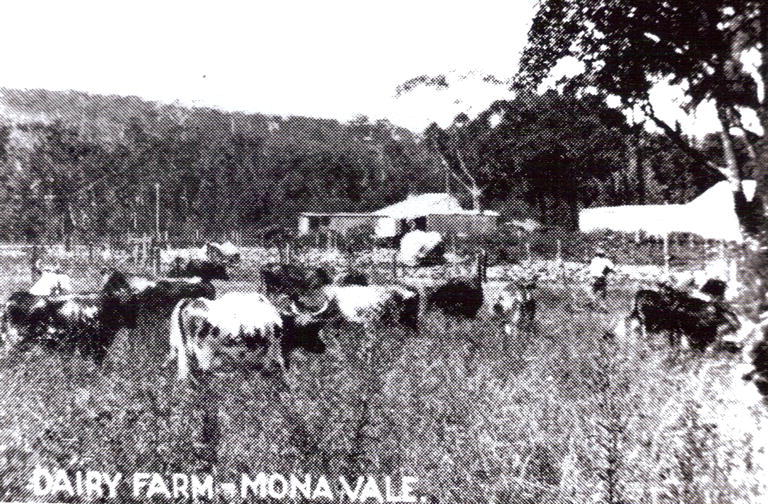
Diary farm at Mona Vale. Circa 1940. Courtesy Olwyn Johnstone, Pittwater Historical Image Library; Mona Vale Library.
MILK SAMPLE WAS DEFICIENT IN FATThrough her husband, Gladys Homer, a dairy proprietor, of Mona Vale, pleaded guilty today in Manly Court and was fined 2s 6d with 8s costs for having sold milk which was stated to have been deficient in milk fat to the extent of 15.6 per cent. Inspector Patton said that only one of five samples taken showed any deficiency, and he had been informed that the deficient milk was bought from another company. There was no added water and the deficiency could nave come about through the milk being improperly handled or some cans having got more fat than others. If companies delivered to the dairies Instead of "dropping the milk about the streets," and the milk was stirred before being used, such difficulties might not occur. MILK SAMPLE WAS DEFICIENT IN FAT (1939, March 2). The Sun (Sydney, NSW : 1910 - 1954), p. 36 (LATE FINAL EXTRA). Retrieved from http://nla.gov.au/nla.news-article231104710
FORMER MUR-BAH MAN'S DEATH FROM HEART FAILUREThree minutes after he had been heard whistling merrily at Homer's dairy, Mona Vale, on February 8, Robert Jesse Johnson (20) collapsed at a wash basin and fell forward, dead, with his face in a few inches of water. Dr. Belli, of Mona Vale, was called by Joseph Homer, proprietor of the dairy, and Sergeant Cook, of Narrabeen, took Johnson's body to the morgue. Examination revealed that death was due to heart failure. Johnson, was a son of Mr. and Mrs. J. T. Johnson, of Ewing Street, Murwillumbah. He also is survived by three sisters and two brothers, one serving overseas with the A.I.F. Johnson was a member of the AIF and was discharged. He was at one time employed by the Tweed Butchering Coy., Murwillumbah. FORMER MUR-BAH MAN'S DEATH FROM HEART FAILURE (1942, February 17).Tweed Daily (Murwillumbah, NSW : 1914 - 1949), p. 2. Retrieved from http://nla.gov.au/nla.news-article194546233
Willy-willy hit's Mona Vale; roofs torn off
Roofs were torn away, a chimney knocked down and buildings damaged when a willy-willy struck Mona Vale early this afternoon .
A dairy owned by Mr. J. Homer, of Bassett Street, Mona Vale, received the full force of the wind and eight other buildings were damaged. Mr. Reg Homer, son of the owner of the dairy, said: "A strong breeze sprang up shortly after noon. Suddenly we heard a "whishing" noise and saw a cloud of dust sweeping across the paddocks. "We didn't have time to do anything. When the whirlwind hit us it tore the roof off the main section of the dairy, and hurled it against the house.
"It knocked down one of the chimneys and as that fell I saw another roof lifted from a building just as if it were a piece of paper."
Weather Bureau officials said wind in some suburbs had reached 47 mph. They did not expect it to get any worse, they added. A cool change tonight is forecast. Today's 1 pm temperature reading of 83.8 degrees was steadily climbing towards yesterday's maximum of 84.5, which was the highest reading since last April. . Despite a flat surf, surf clubs today reported biggest attendances since last summer. "Thousands Thousands flocked to Bondi and Manly to escape the heat. Willy-willy hits Mona Vale; roofs torn off (1949, October 13). The Sun (Sydney, NSW : 1910 - 1954), p. 3 (LATE FINAL EXTRA). Retrieved from http://nla.gov.au/nla.news-article229224418
Willy Willy Strikes Mona Vale
SYDNEY, Thursday. - Several buildings were badly damaged when a willy-willy struck Mona Vale to-day. One resident said: "A strong breeze sprang up shortly after noon. Suddenly we heard a whishing noise and saw a cloud of dust sweeping across the paddocks." A dairy owned by Mr. J. Homer, of Bassett-street. Mona Vale, received the full force of the wind. Eight other buildings were damaged. Willy-Willy Strikes Mona Vale (1949, October 14). Newcastle Morning Herald and Miners' Advocate (NSW : 1876 - 1954), p. 3. Retrieved from http://nla.gov.au/nla.news-article134172237
DAIRY FARMERS' CO-OP. MILK CO. LTD.50th ANNUAL REPORT.The annual meeting of the Company was held on Friday last. The report discloses: — The total quantity of milk handled was forty-one and one-half million gallons, exceeding the quantity handled in the previous year by approximately two million gallons. Following the removal of the ban on the sale of sweet cream greatly increased quantities of milk will be required. The turnover for the whole of the Society's operations was £6,090,000. The profits, after providing for depreciation and Taxation totals £22,992, a dividend of 5 per cent, will be made. The disastrous floods during June in the Hunter River district and in the North Coast River districts necessitated the imposition of a rationing of supplies to consumers more severe than ever before. The Directors offer their sympathy to those suppliers who suffered loss due to the floods. Machinery, plant and equipment continue in good order and condition. The construction of the new Western Suburbs unit is progressing despite the shortage of labour and materials, and the completed 'work-shop buildings are now being used by the Society.
The construction of the new Willoughby depot is progressing and it is intended to build a new depot at Manly. It is also intended to build a new depot at Canberra and to introduce a pasteurised bottled milk service in the capital city. The freehold of the Mosman depot premises has now been acquired. Following the purchase of a dairyman vendor's business at Mona Vale a new branch has been established in that district. During the year your Society acquired the business and property of the Taralga Co-operative Dairy Company Limited, Goulburn, and the Bathurst Dairy Company Limited, Bathurst. The factory suppliers are now shareholders in your Company and are voluntarily contributing for additional shares. Both of these acquisitions in these important and rapidly-growing centres will further consolidate the distribution of milk by co-operative enterprise. Increased costs generally in milk handling and distribution were again evident and were recognised in the Milk Board Prices Declarations operating from the 7th October, 1949, and the 24th March, 1950, and also by the State Prices Commissioner in respect of prices in areas outside the Milk Zone. This is the fiftieth year of your Society's operations and your Directors are issuing a commemorative booklet dealing with the history, achievements and plans for the future of your Society. .. Appreciation is again expressed to milk producers and country factory managements for their support during the year. The service of the many loyal employees of the Society is also appreciated. There are now 5,953 members in your Society. Following the alteration of Rule 94 by which the minimum number of Directors was increased, the vacancy created was filled by the appointment of Director A. R. Keith. . Directors, Messrs. A. G. Martin, E. H. K. Downes, J. S. Haddin, R. J. Alison, and A. R. Keith, retire but are eligible for re-election. DAIRY FARMERS' CO-OP. MILK CO. LTD. (1950, October 5). Camden News (NSW : 1895 - 1954), p. 4. Retrieved from http://nla.gov.au/nla.news-article143972258
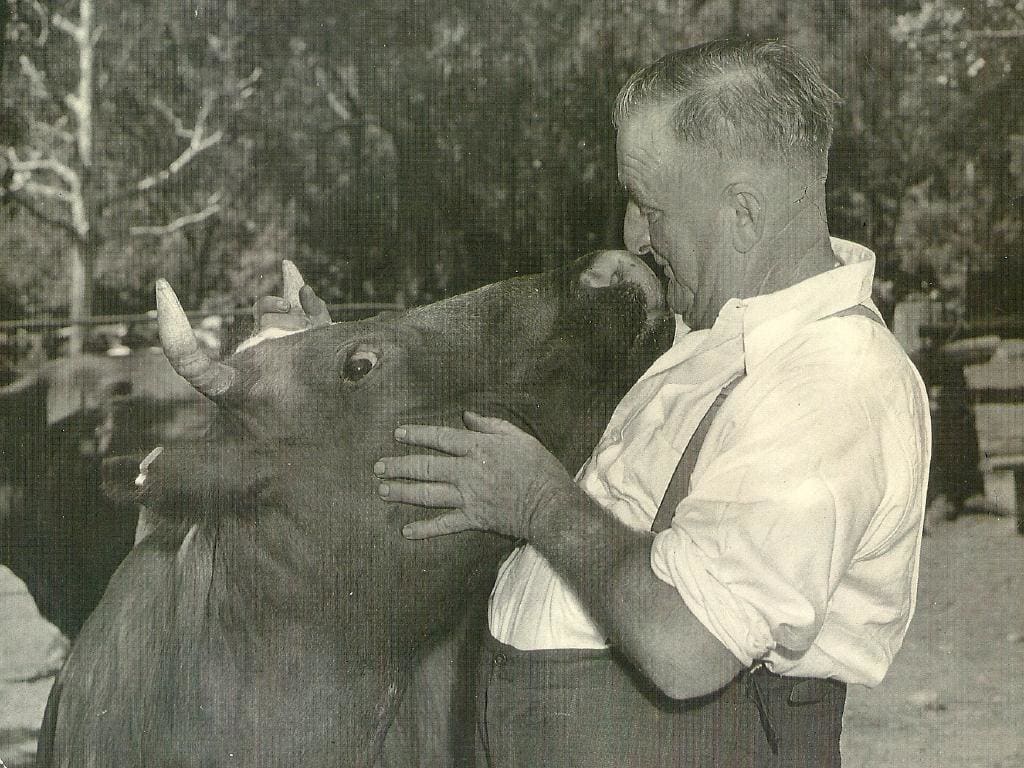
Joseph James Homer kissing Annabela goodbye when he sold his dairy at Mona Vale in 1950. Photo courtesy Kevin Hawkins
Mona Vale milk ban is withdrawnThe Milk and Ice Carters' Union late today withdrew its ban on milk supplies to Mona Vale vendor J. Homer.Justice de Baun announced this following a compulsory conference of the parties in the Industrial Commission. He said Mr. Homer's customers would be supplied with milk from tomorrow morning. A conference of all interested parties, including Dairy Farmers Ltd., and Fresh Food and Ice Co., would be held at 2.15 pm next Thursday. Justice de Baun added it appeared the dispute was a little wider than the issue in regard to Mr. Homer. The management committee of the union yesterday imposed the ban because it claimed Mr. Homer had been "filching" customers from other vendors.
3 am -.visit 600 families were left without milk today, when, acting under union instructions, carters stopped supplies to Joseph Homer. Milk and Ice Carters' Union secretary A. W. Thompson and organiser W. Jackson went to Fresh Food and Ice Co's., Manly depot at 3 am today and ordered union members not to handle milk for Homer. The union officials told the company if milk was made available for Homer, the union's action would he extended to the whole of the North Shore.
Vendor's stand Mr. Thompson said later, "We do not want the dispute to extend, but Homer will get no milk until he employs union labor, or the matter is settled by Health Minister O'Sullivan." Fresh Fresh Food and Ice Co.'s-general manager J. Agnew said company employees generally had been directed by the union not to handle milk for Homer. Homer, of Newport Rd., said, "My wife, sister and I run the business and employ nobody. I can't see where the non-union labor nonsense comes in. They say I have broken union zoning regulations, but the Milk Board does not recognise zoning and says it is illegal.” Mona Vale milk ban is withdrawn (1951, May 4). The Sun (Sydney, NSW : 1910 - 1954), p. 1 (LATE FINAL EXTRA). Retrieved from http://nla.gov.au/nla.news-article230758723
Milkman's OrdealLeslie Kuhlmorgan, 50, milk carter, of Park Street, Mona Vale, lay for an hour in Forest Road, Warriewood, yesterday, with his left leg broken in two places. His horse kicked him when the cart overturned after striking a rut. Another milk carter found Kuhlmorgan at 5 a.m. Manly District Ambulance took him to Manly Hospital. Milkman's Ordeal (1951, July 13). The Sydney Morning Herald (NSW : 1842 - 1954), p. 5. Retrieved from http://nla.gov.au/nla.news-article18211226

Willy-willy hit's Mona Vale; roofs torn off
Roofs were torn away, a chimney knocked down and buildings damaged when a willy-willy struck Mona Vale early this afternoon .
A dairy owned by Mr. J. Homer, of Bassett Street, Mona Vale, received the full force of the wind and eight other buildings were damaged. Mr. Reg Homer, son of the owner of the dairy, said: "A strong breeze sprang up shortly after noon. Suddenly we heard a "whishing" noise and saw a cloud of dust sweeping across the paddocks. "We didn't have time to do anything. When the whirlwind hit us it tore the roof off the main section of the dairy, and hurled it against the house.
"It knocked down one of the chimneys and as that fell I saw another roof lifted from a building just as if it were a piece of paper."
Weather Bureau officials said wind in some suburbs had reached 47 mph. They did not expect it to get any worse, they added. A cool change tonight is forecast. Today's 1 pm temperature reading of 83.8 degrees was steadily climbing towards yesterday's maximum of 84.5, which was the highest reading since last April. . Despite a flat surf, surf clubs today reported biggest attendances since last summer. "Thousands Thousands flocked to Bondi and Manly to escape the heat. Willy-willy hits Mona Vale; roofs torn off (1949, October 13). The Sun (Sydney, NSW : 1910 - 1954), p. 3 (LATE FINAL EXTRA). Retrieved from http://nla.gov.au/nla.news-article229224418

The Bayview to Church Point Road: Historical Pictorial

Above and Below: Panorama of Mona Vale, New South Wales, ca. 1930 [picture] / EB Studios National Library of Australia PIC P865/125 circa between 1917 and 1946] and sections from made larger to show detail.
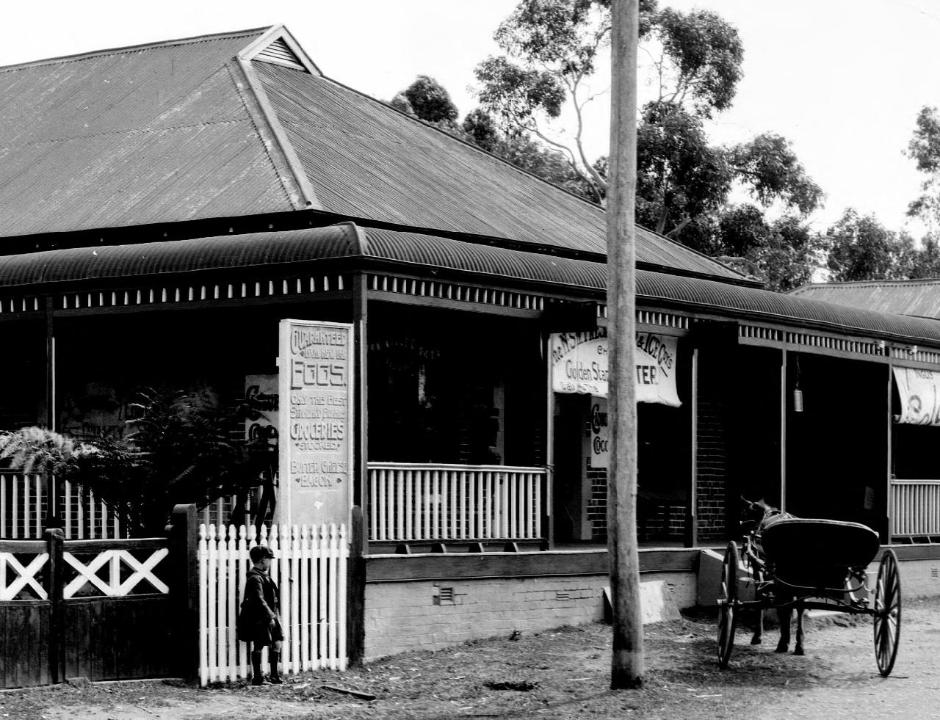
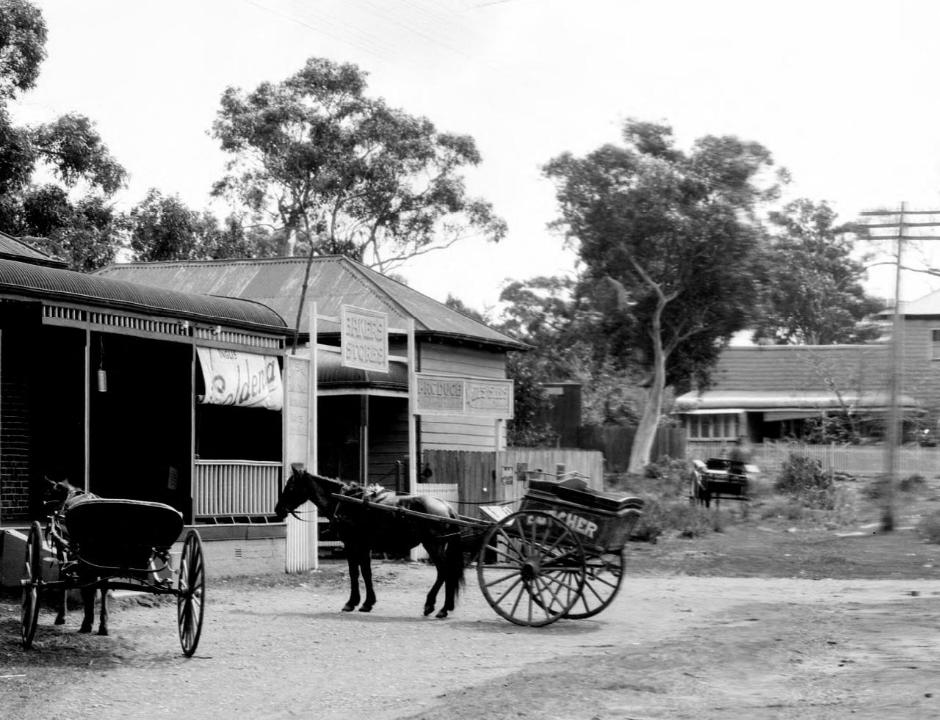
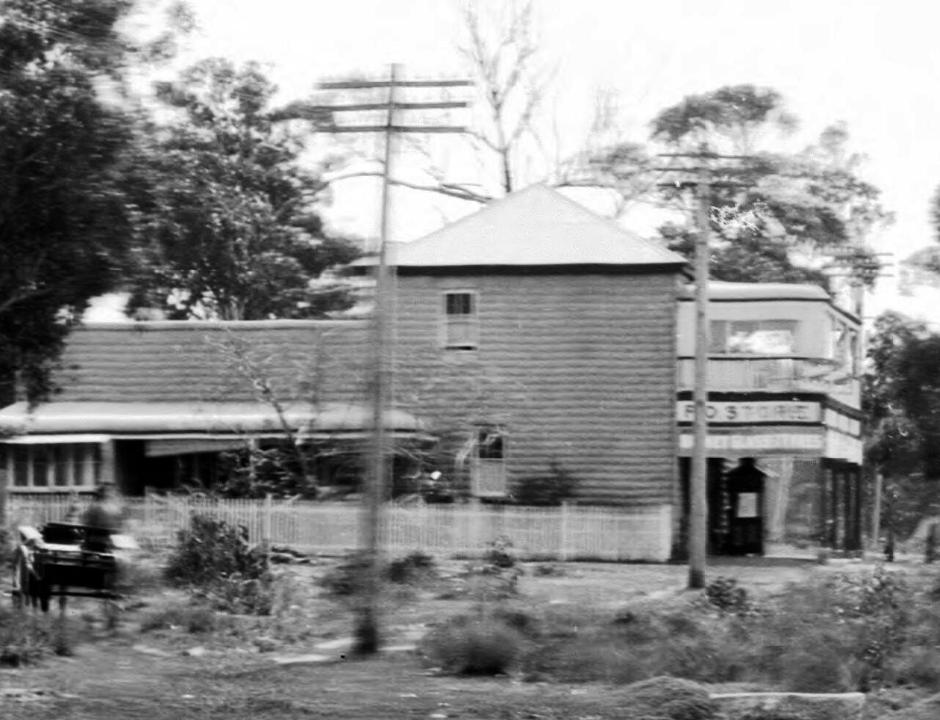
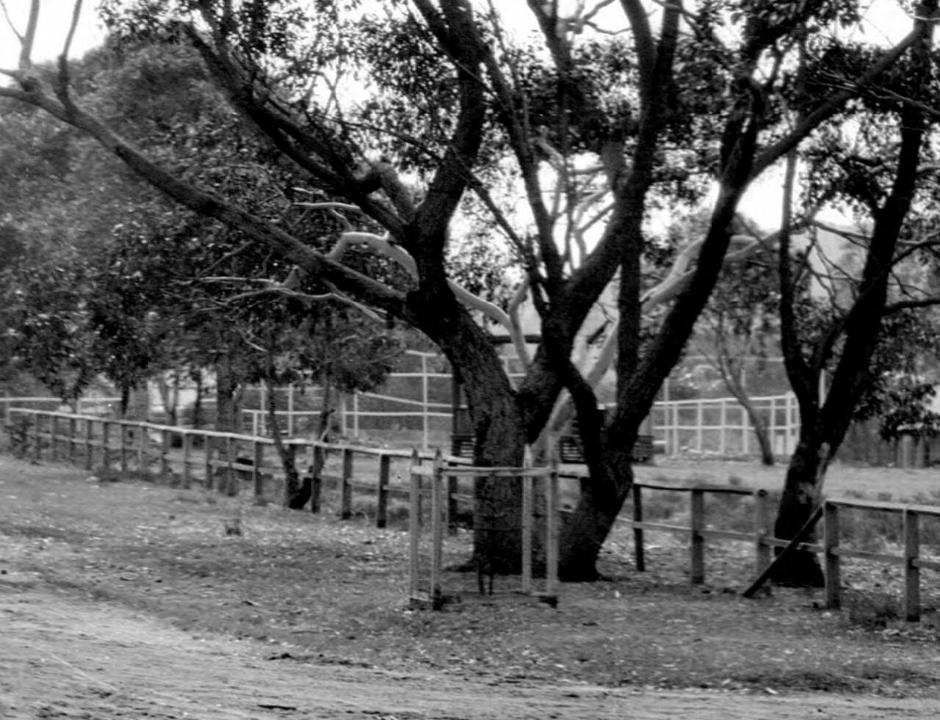
Above: Section showing Tennis courts - Below: Section showing Cricket Pitch
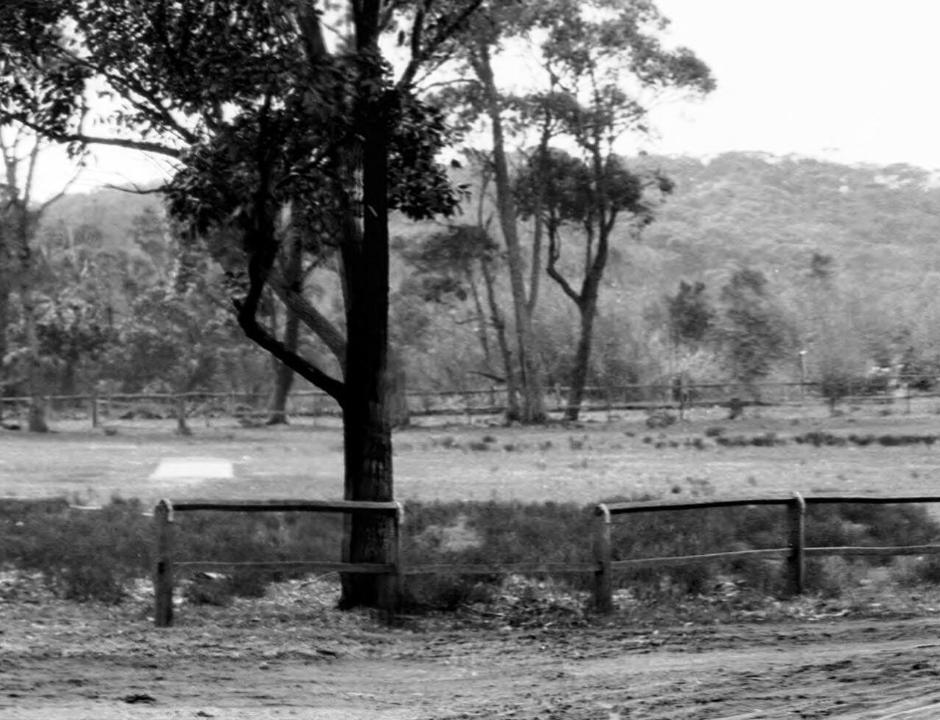
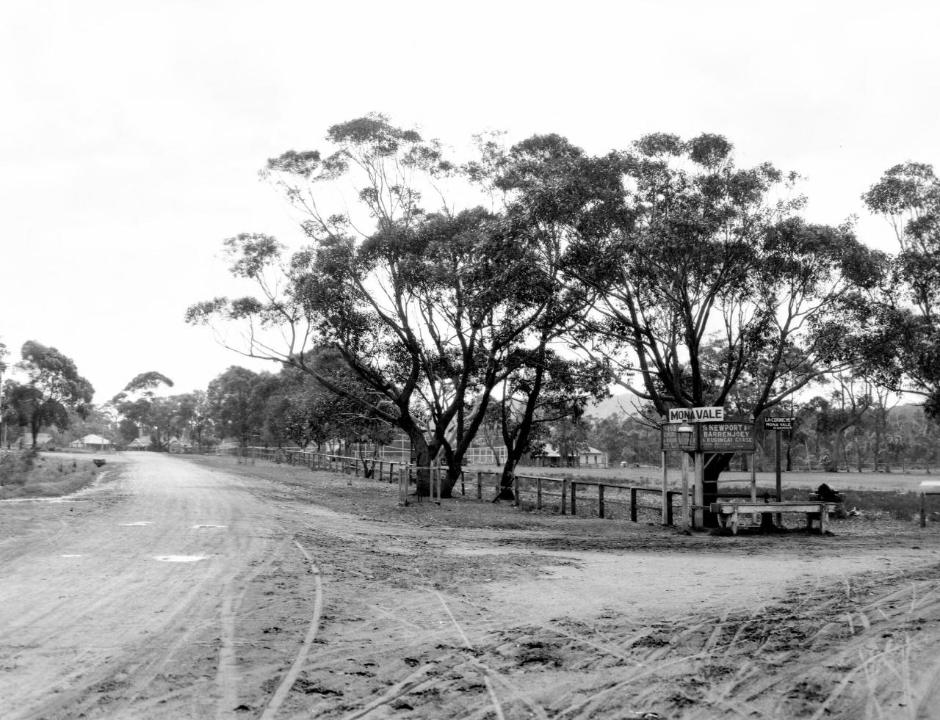
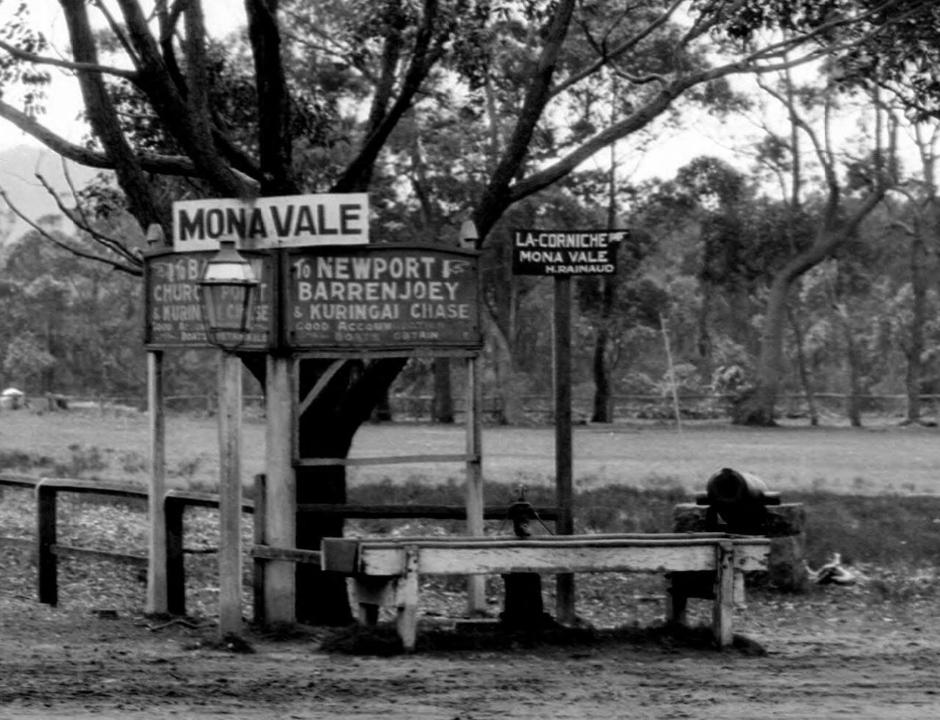


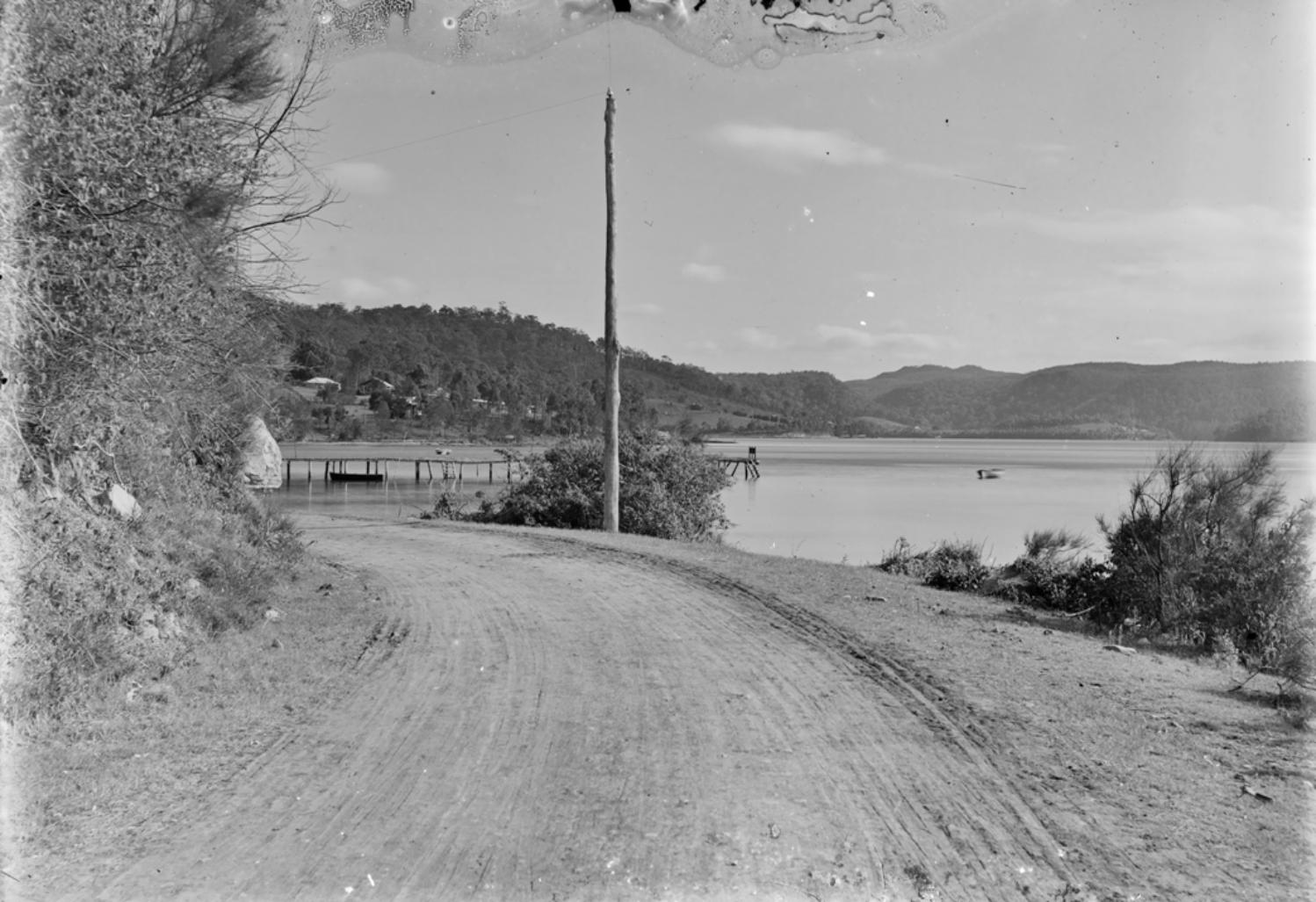
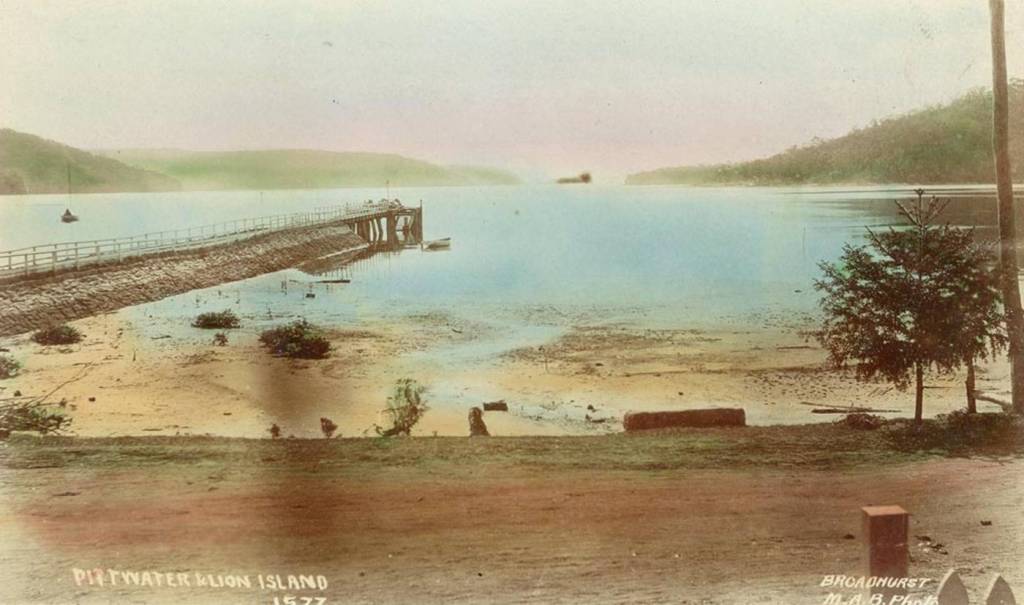
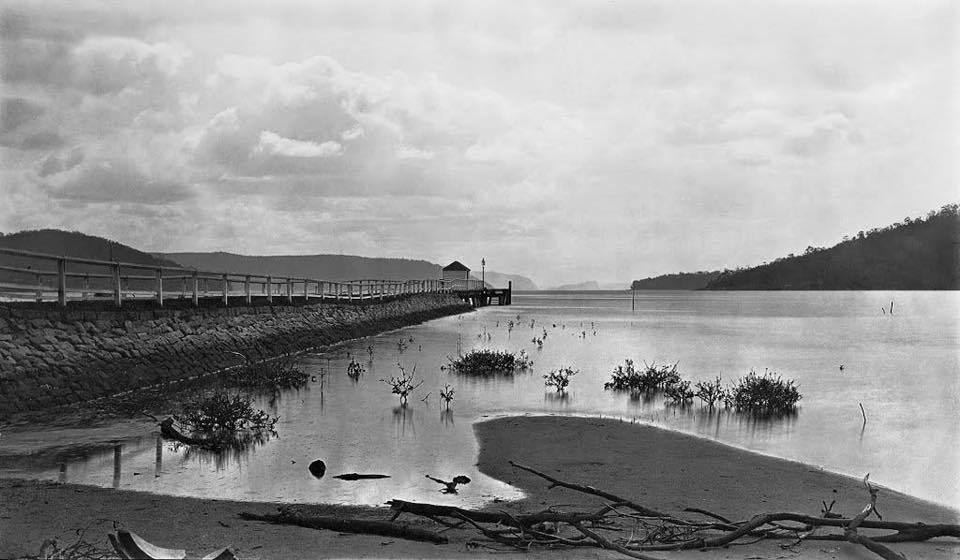
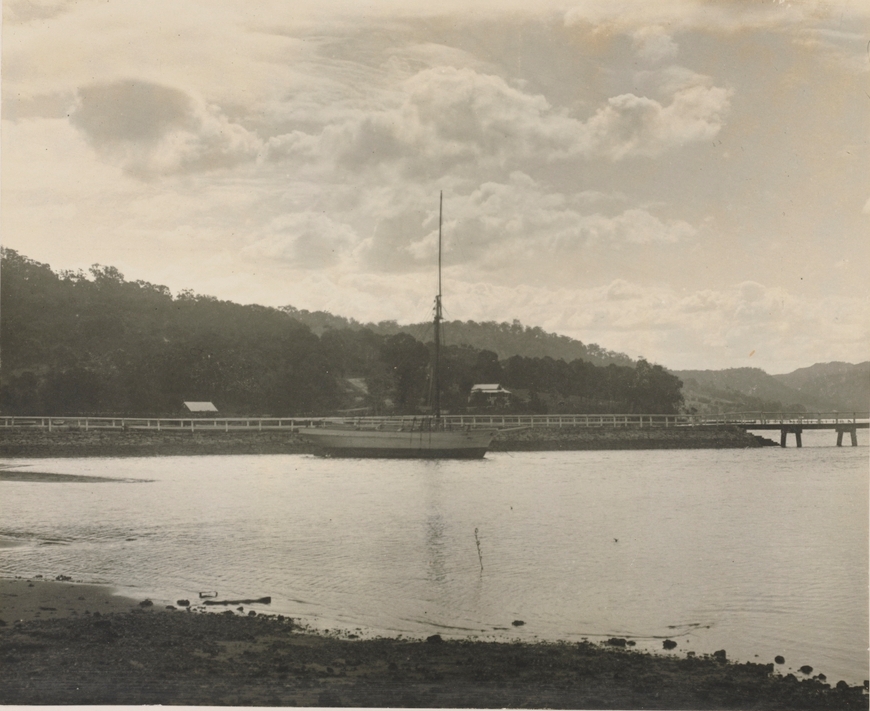
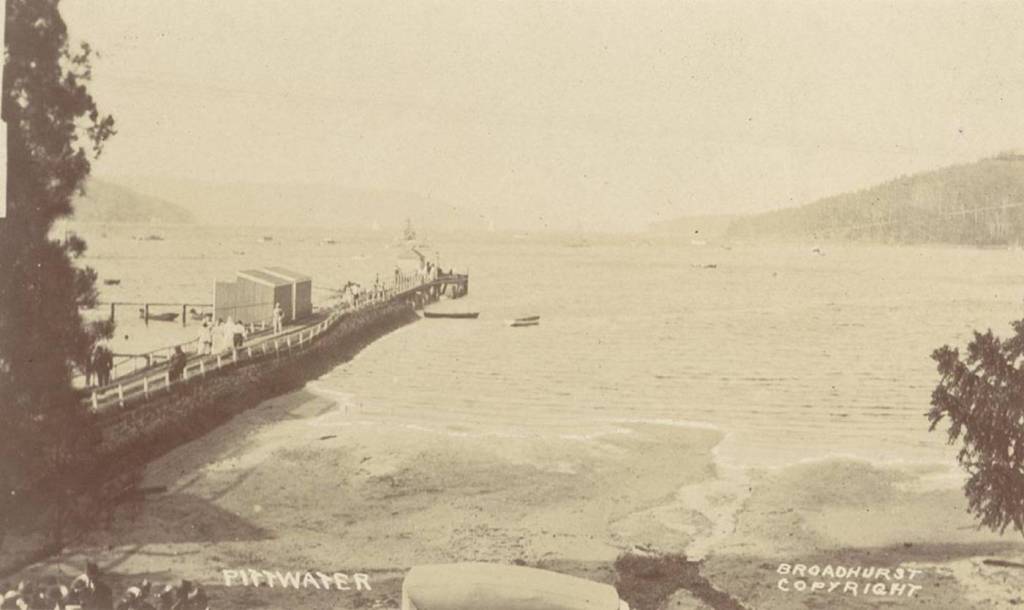
Bayview Wharf, circa 1915-20. Broadhurst Image 11061661h, courtesy State Library of NSW.



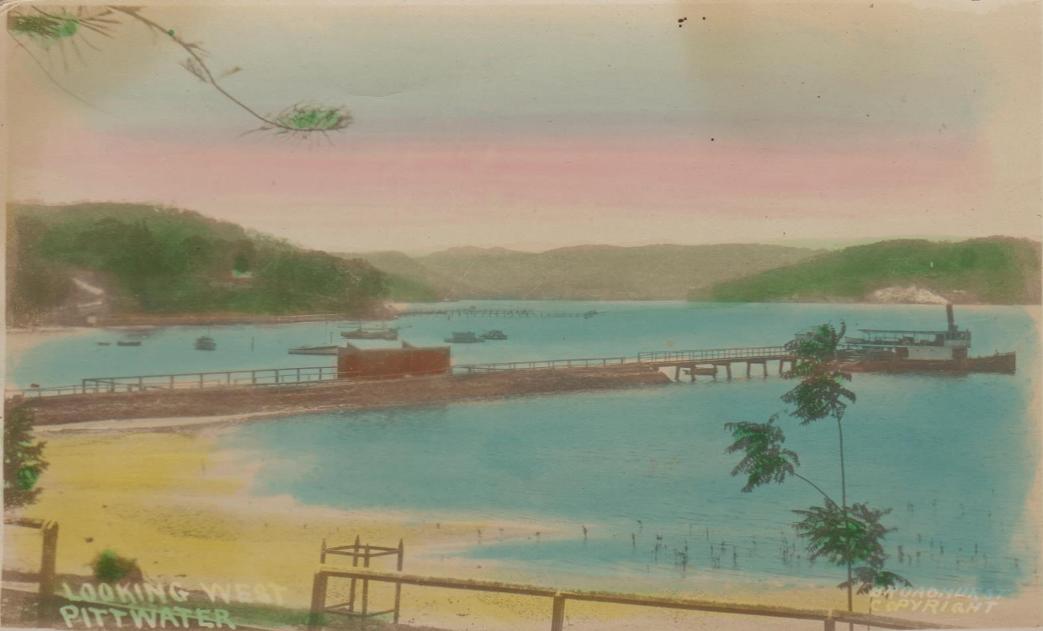
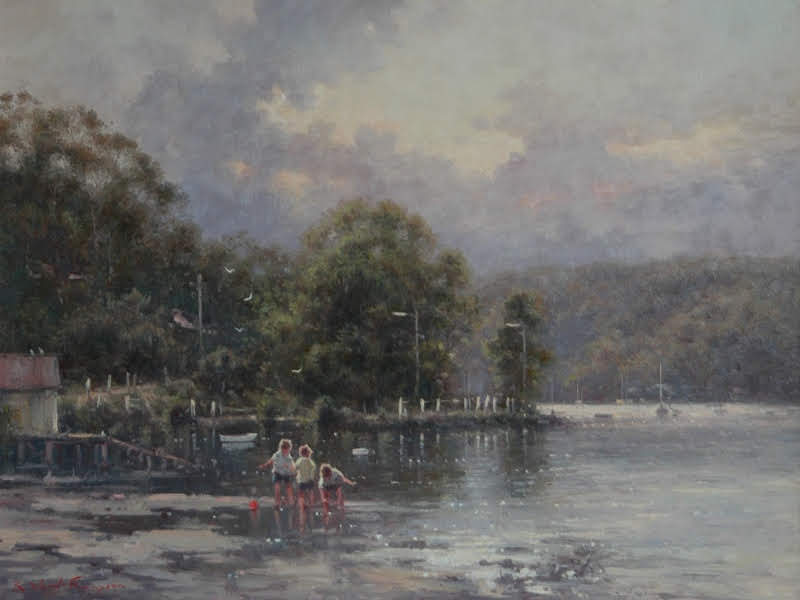
Low tide Bayview by Ramon Ward Thomson. Courtesy of Davidson Auctions © Ramon Ward Thompson or assignee
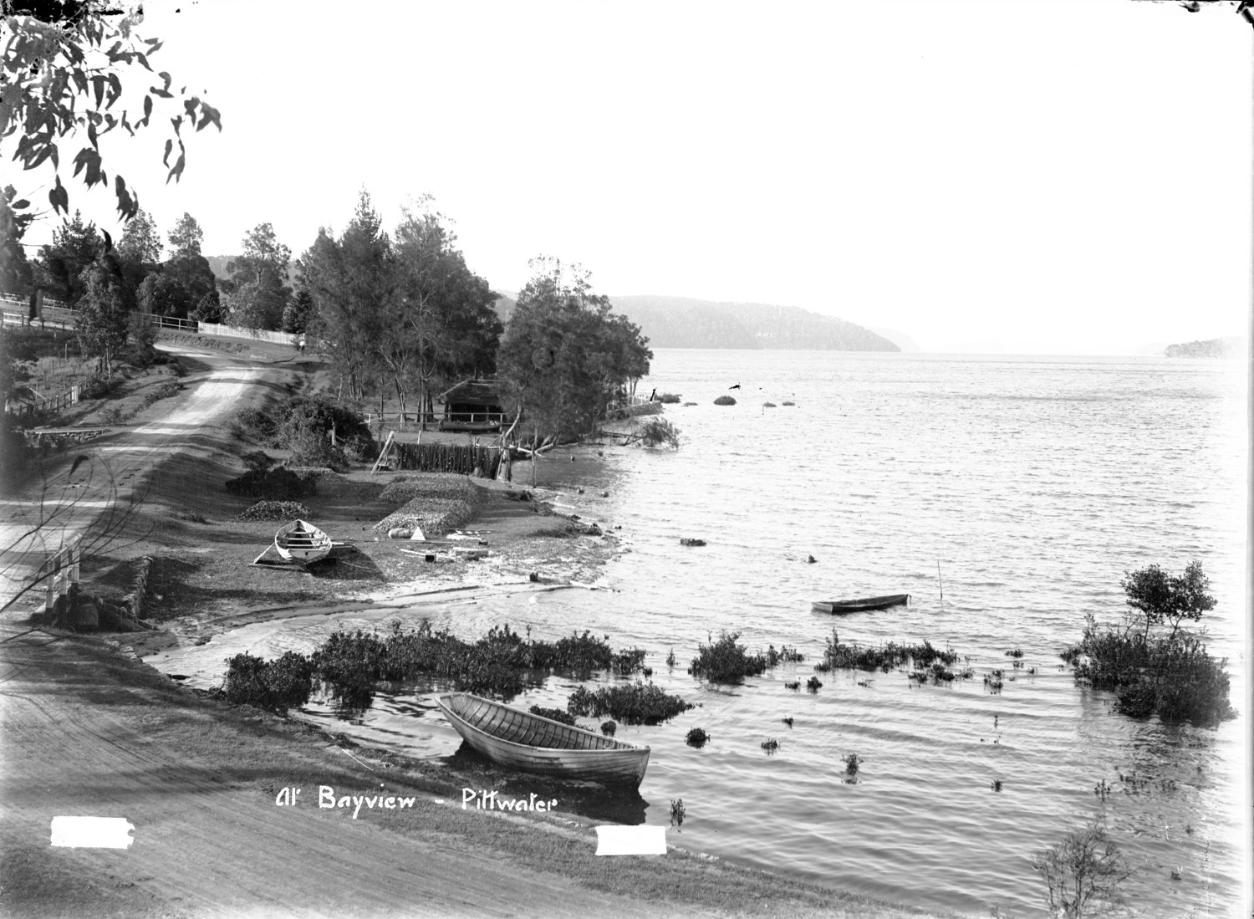

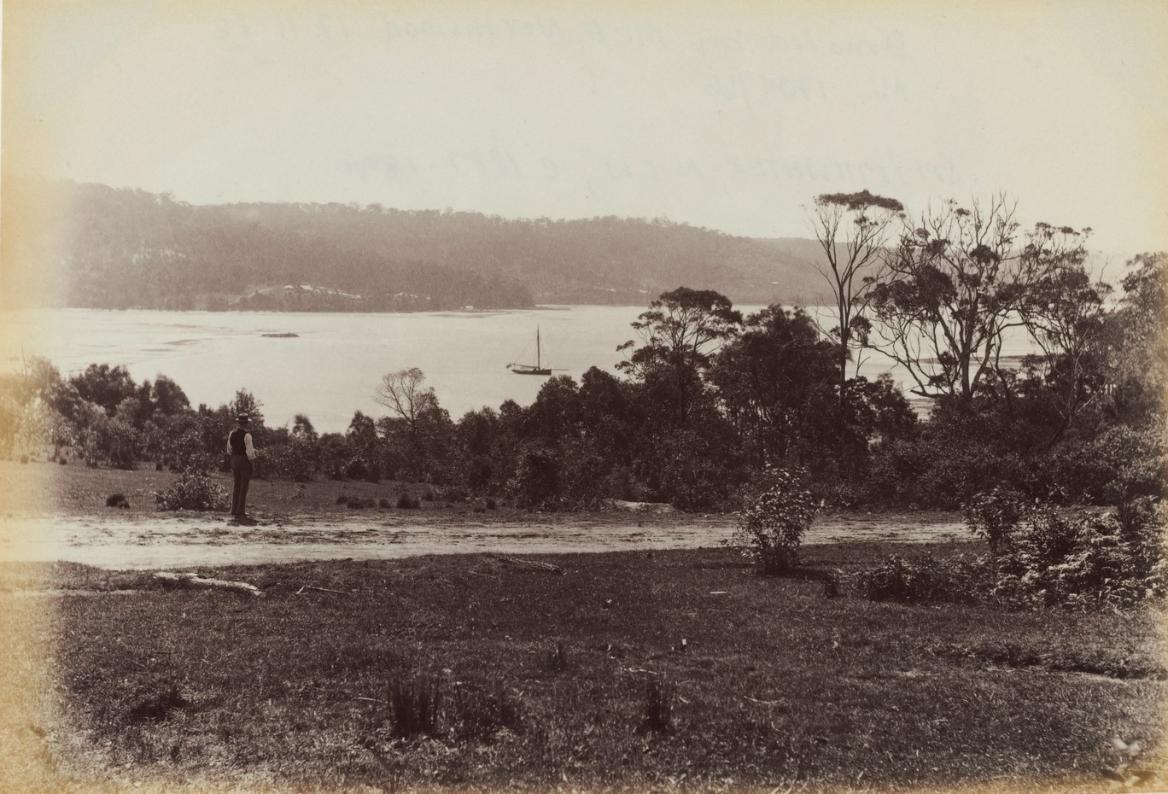
Newport from Bayview, ca. 1900-1910, Image No.: a4367002h, courtesy State Library of NSW.
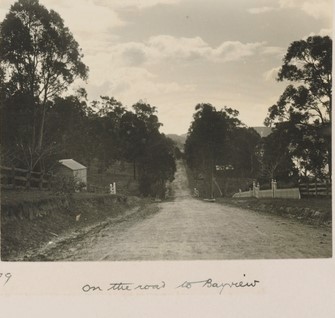
Sunday, 26th September, 1909, 'On the Road to Bay View' - from Allen Family Album 50, Image No.: a3286050h, courtesy Mitchell Library, State Library of NSW
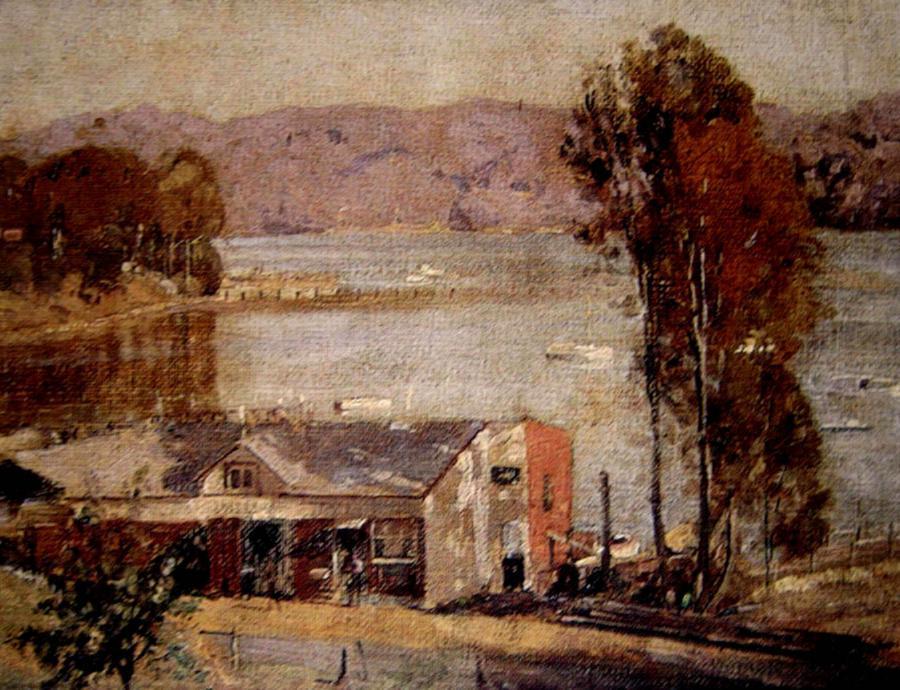
Mr. Percy Lindsay reveals his breadth of style with telling effect in his exhibition of oil paintings at the Australian Fine Art Gallery of Mr. W. R. Bennett. There is remark-able variety in these pictures, all of conspicuous attainment in colour and atmosphere. Mr. Lindsay has studied nature in varying moods, and has caught her spirit with manifest fidelity. Such studies as "Riddle's Boatshed," ART EXHIBITION. (1927, July 5). The Sydney Morning Herald(NSW : 1842 - 1954), p. 14. Retrieved from http://nla.gov.au/nla.news-article16370289

From The Mort Family Album, Image 131. H.Rainaud's restaurant La Corniche, Digital Order No. a1780131, from State Library of NSW: A note scribbled at side of this photograph says " Renaud - after his Restaurant in Macquarie Street - Morts Rooms-Chambers'.
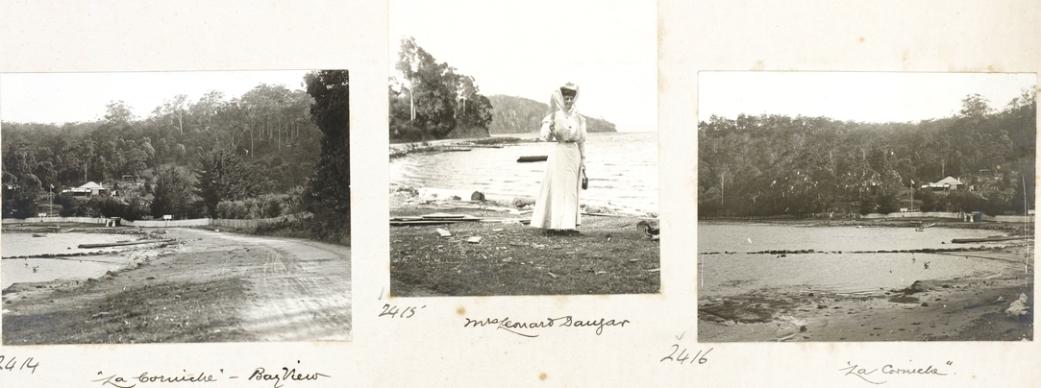
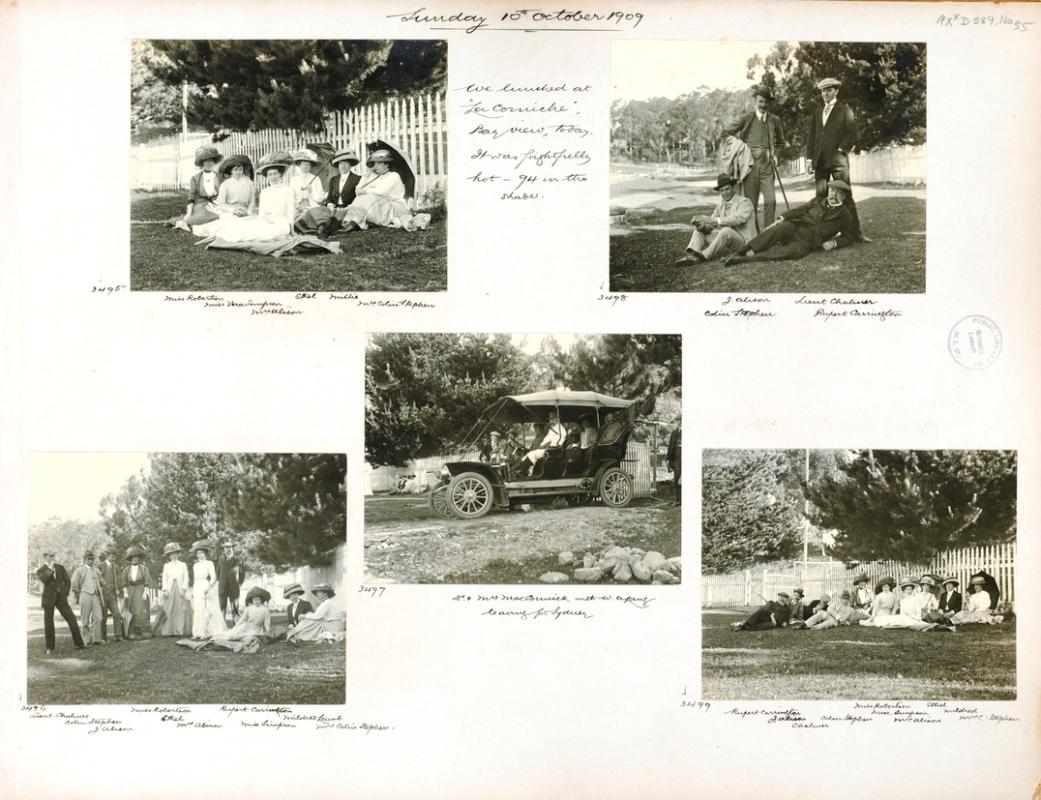
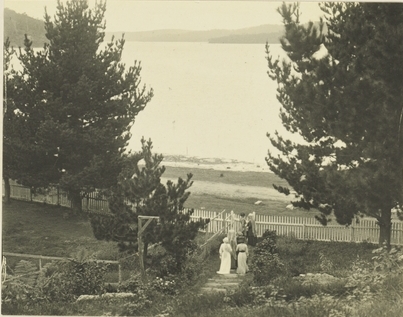
Sunday 5th of February 1911; 'Leaving La Corniche'; from Album 56: Photographs of the Allen family, 1 December - 30 April 1911. Courtesy State Library of NSW.
.jpg?timestamp=1355212682889)
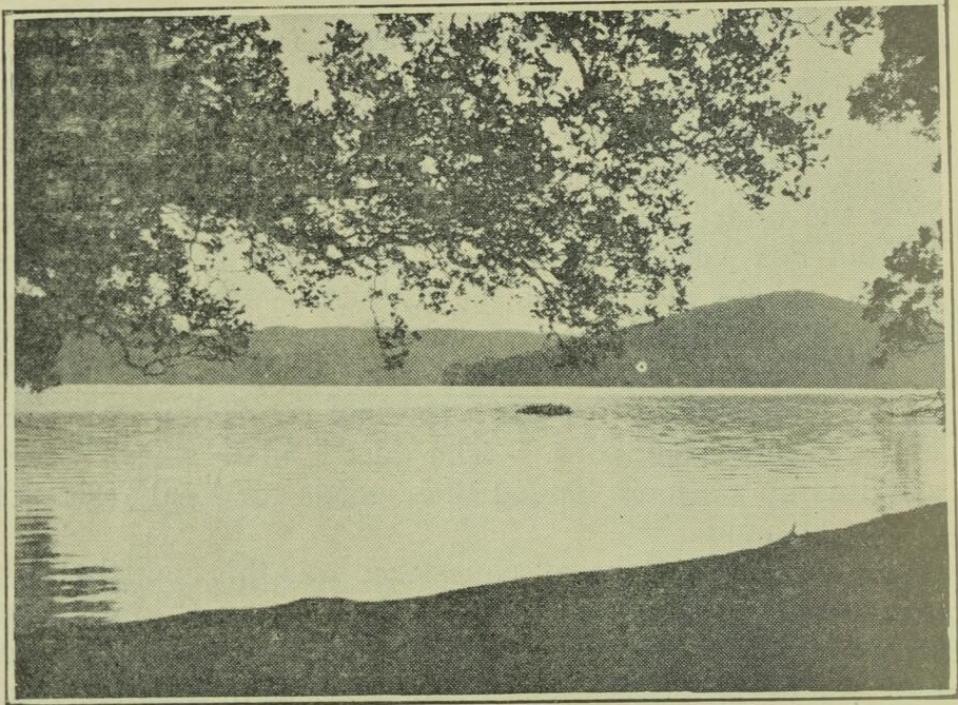
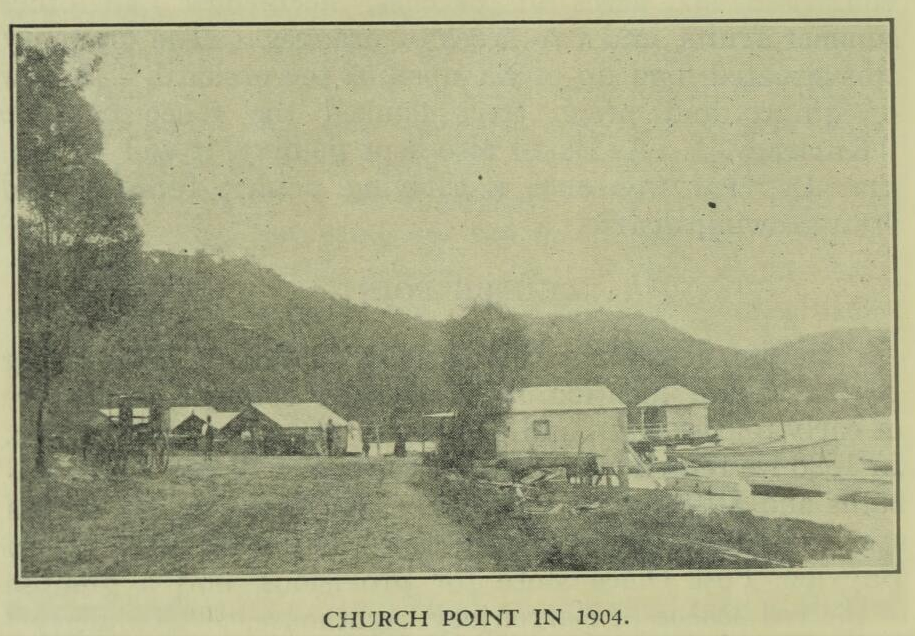
Church Point in 1904 - from The Early Days of Bayview, Newport, Church Point and McCarr’s Creek, Pittwater By J. S. N. WHEELER. Appears in Journal and proceedings / Royal Australian Historical Society Vol. 26 Part. 4 (1940)
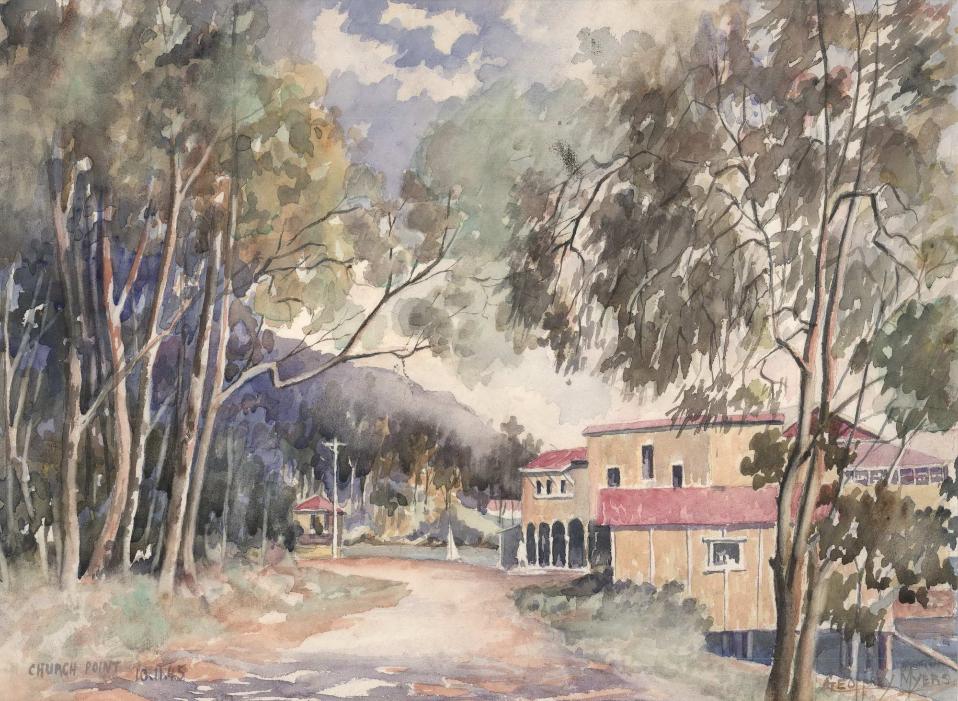
Church Point [Boatshed, Pittwater, NSW]
by Geoffrey Myers, 1945. Watercolour, titled, dated “10.11.45” and signed lower left to right, 26.7 x 36.7cm. Slight tears to right edge. Item #CL183-125 Price (AUD): $880.00 at JOSEF LEBOVIC GALLERY
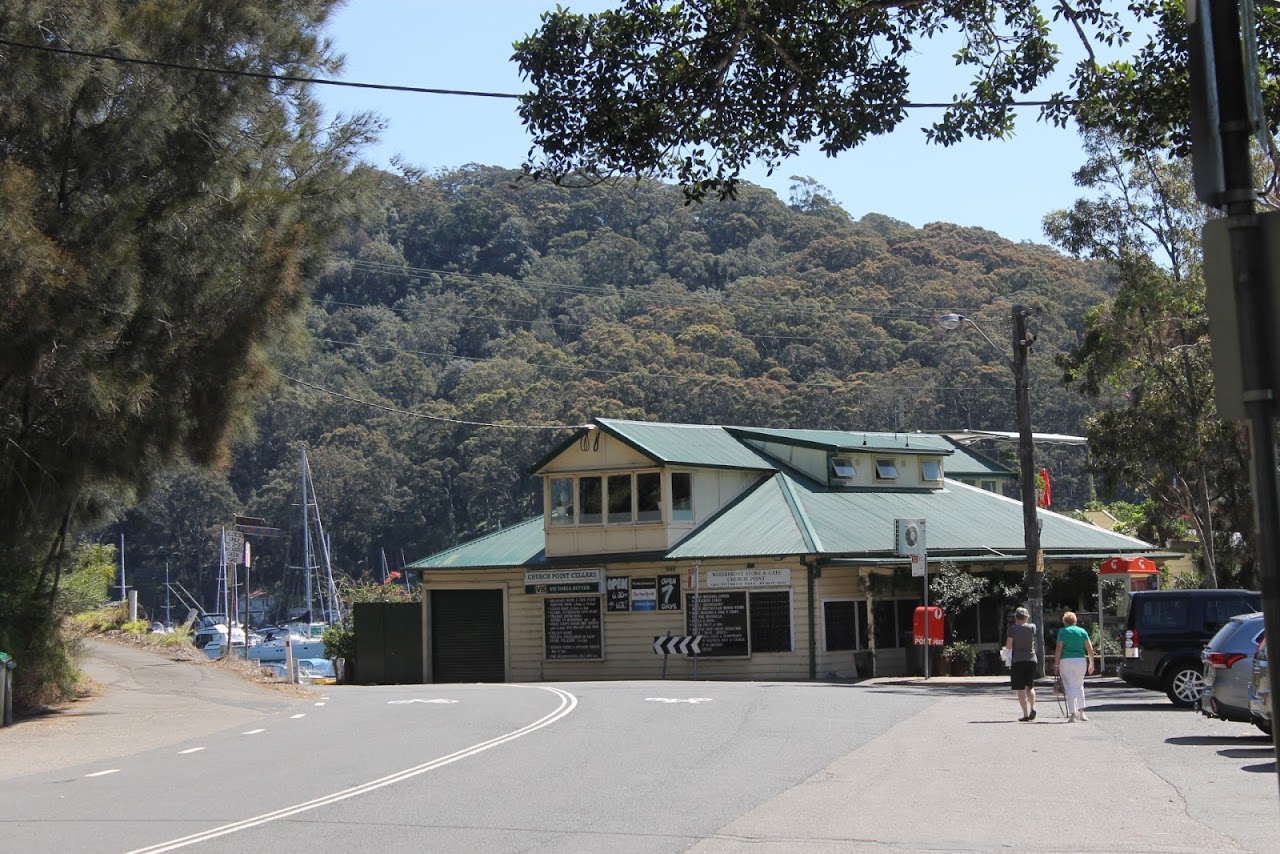
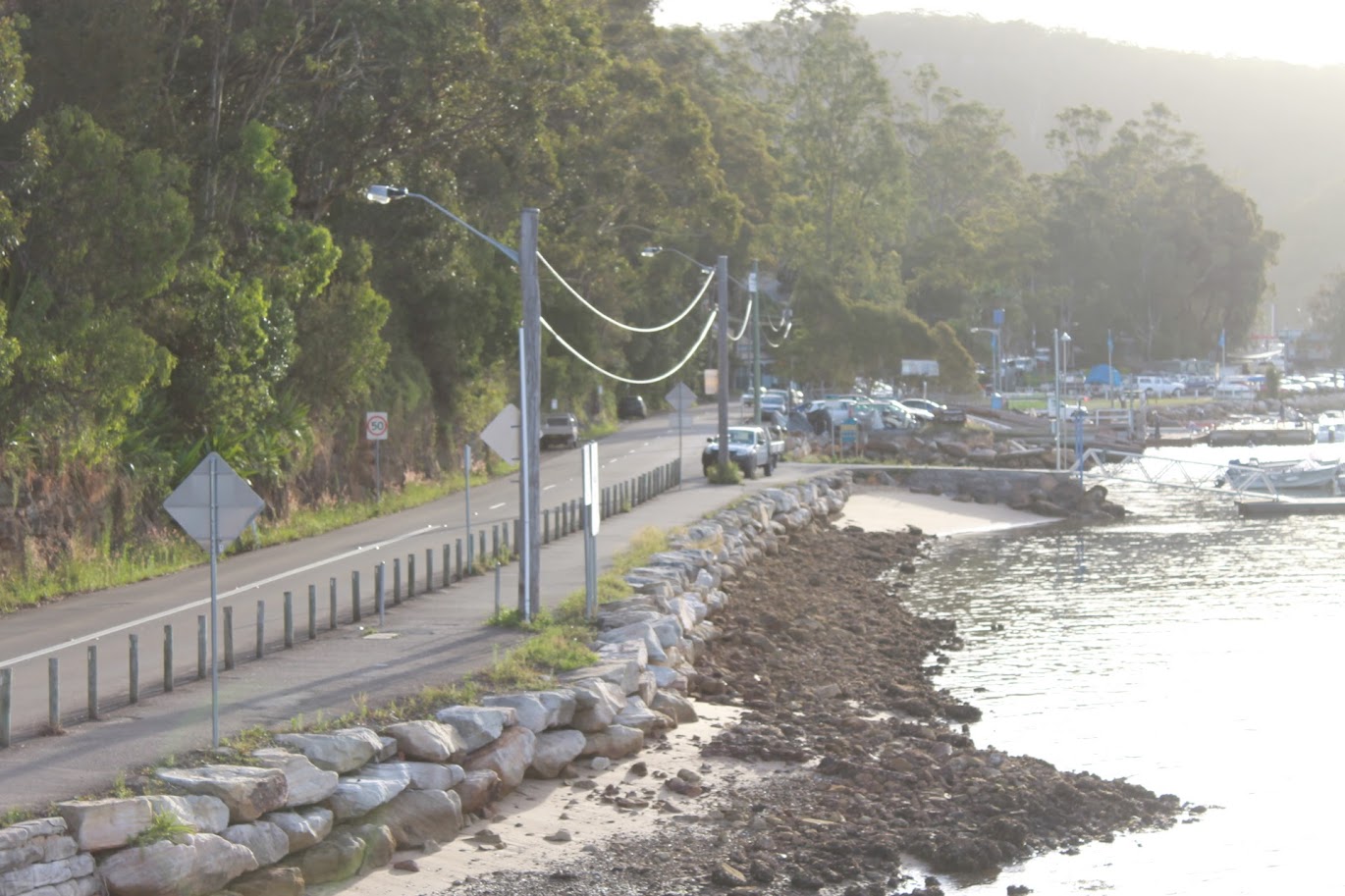
The Pittwater road out to Church Point and junction with McCarrs creek road in 2014 and Mc Carrs Creek road view West
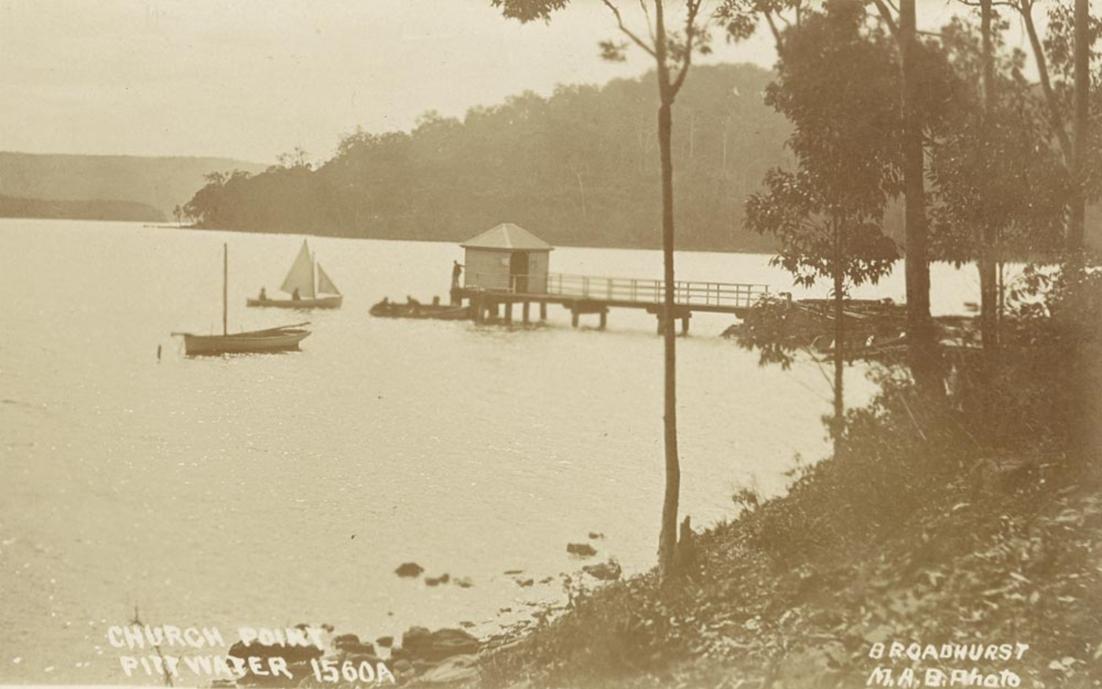
Church Point, circa 1910- 1915, Broadhurst Image No.: a106164h, courtesy State Library of NSW.
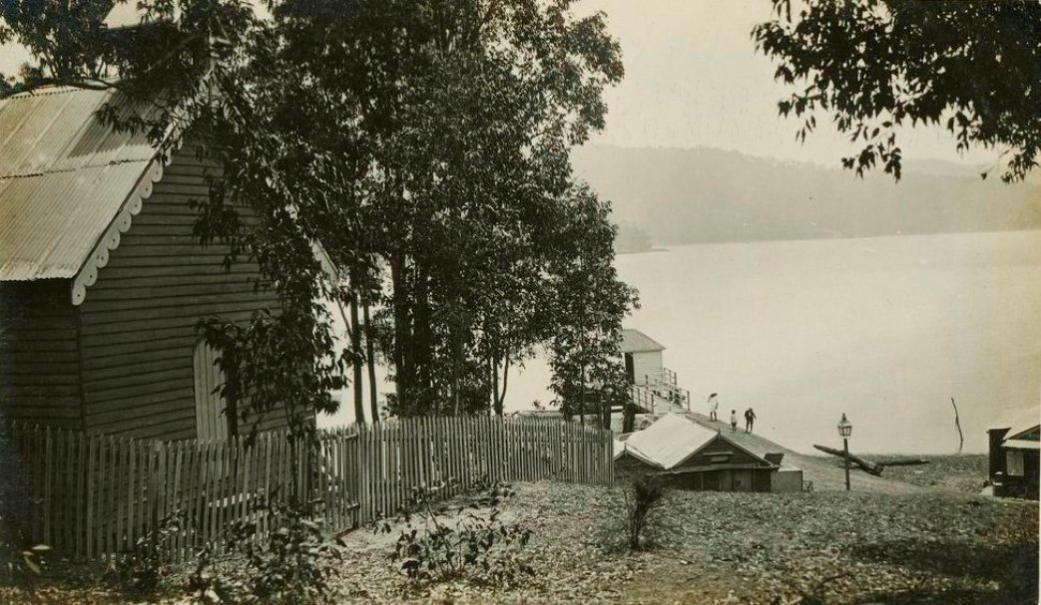
AT CHURCH POINT
On the precipitous slopes of the hillside overlooking the quiet backwater of Pittwater, and shaded by the silver coated gums, stands the little wooden church that gave Church Point its name. It is a quaint little structure in which a service is held occasionally, and I should think that ten people would crowd It. It has a tower bell. It looked up at the church from the road that winds round the waterside, and 'Johnnie' Roche, the man they call the 'Prince of Pittwater’— who was my companion, asked me if I had seen the church yard. We scrambled up past the church, and then, among the rank grass and ever-spreading scrub, found the stones that mark the dust of the 'Rude forefathers of the hamlet.' Beside one weatherworn stones 'Johnnie' paused, and spoke to himself rather than to me. 'He was a relative of the teacher at the little school we got a holiday, I remember, to attend this funeral.'
In this quiet spot rest many that were friends of my companion in his boyhood. The muter gardeners Time and Mature are gradually repairing this small 'God's Acre,' and the few graves are being gradually lost to human ken. Meanwhile the waters of the Bay lap the sand-fringed road, and motor parties Indicate that to-day is the day of the quick. The dead are of the past. Church Point. AT CHURCH POINT. (1922, November 23). Evening News(Sydney, NSW : 1869 - 1931), p. 8. Retrieved from http://nla.gov.au/nla.news-article118825051

A Picturesque Motor Drive — View at Church Point (Pittwater), from McCarr's Creek. With the approach of warmer weather Sydney motorists are making preparations for outings to pleasure resorts near the city. The charms of the Manly and Pittwater districts and one of the most popular spots near Broken Bay is Church Point. MOTORING. (1929, August 28). Sydney Mail (NSW : 1912 - 1938), p. 45. Retrieved from http://nla.gov.au/nla.news-article160395048
The Early Days of Bayview, Newport, Church Point and McCarr’s Creek, Pittwater.
By J.S.N. WHEELER.
A trip to Church Point, Pittwater, in the old days, prior to the advent of tram and motor car, was made by means of the coach running from Manly. Many a traveller by that old-fashioned means of transport was able to study and enjoy the trip of thirteen miles perhaps far more than one who makes the journey now by more modern and speedier methods. The large Royal Mail coach which commenced its journey from the livery stables next door to the old Pier Hotel, Manly, was put into service when a crowd was travelling on holidays. With its two box-seats and five horses it was a “thing of beauty,” and there were usually among the occupants one or two bright spirits who enlivened the journey with their joviality. On the way down there was usually a break of a few minutes for refreshments at the Narrabeen and Rock Lily Inns.
In the year 1884 a traveller mentioned that the coach collected passengers at the livery stables behind the Steyne Hotel. When I first went to Bayview in 1898, the coach used to leave from stables next to the Pier Hotel. The coach fare to Church Point and Bayview was one shilling and sixpence.
The road after passing Curl Curl lagoon was formerly very lonely. Indeed, a traveller in 1884 says:“I passed only two houses that were occupied—Mrs. Malcolm’s at Brookvale and Miss Jenkins’ at Collaroy.”
It is noteworthy that Prince Albert Victor and Prince George (late King George V.) travelled along this road in a coach-wagonette to Newport on the morning of August 1, 1881, when the two young princes saw the paddle-wheel steamer Collaroy ashore near Long Reef.
BALGOWLAH.
In 1834 the road to Pittwater commenced at Balgowlah, or Bulgowlah, which was a village down by the waters of North Harbour. There the road was known as “Jenkins’ Road,” after a farmer of that name. The New South Wales Calendar for 1834 states:—
Jenkins’ house was miles out, at Narrabeen Lagoon. At 11 1/2 miles the path from the Pennant Hills Road joins this coast road at the farm of one Foley, a tenant of Mr. Wentworth’s. About 1 mile further on is the south-east arm of Pittwater, on which there are some small farms. The head of Pittwater, as seen from the heights along which the road or path leads is equal to any lake scenery; and there are many romantic spots with good land on its banks which only require suitable inhabitants to resemble Arcadia.
So jaded were the horses at holiday seasons that it was sometimes necessary for travellers to get out of the coach at steep grades and help to push it up the hills. This happened at Sheep Station Hill, beyond Narrabeen. Sixty years ago there was no road across the Narrabeen Lakes; it was forded in the shallows near the present bridge.
In the year 1894 Leon Houreux, a Frenchman, ran a line of coaches. He was well known as the host of the Rock Lily Hotel. About that time George Ellis, a botanist, wrote of this inn:—
The menu is extensive and varied, quite equal to the best of our metropolitan cafes, and after luncheon there are quoits, skittles, swings and other aids to digestion in the recreation ground over the road.
I must not forget to mention Harry Duncan. He was a well-known coachman in the early years of this century, of the type that Charles Dickens made famous in the person of Tony Weller.
Now I will convey my listeners in imagination a little further along on this old-fashioned journey till we come to the stately columns of the two Livistona or cabbage-tree palms. The botanist Ellis, just mentioned, said in 1895:
It is to be hoped that these beautiful specimens of a fast disappearing and interesting class of plants may be long spared from destruction.” They are standing there, l am very glad to say, up to the present time, and are like old friends.
Just beyond the little church the scenery becomes more picturesque. The wooden church (the Church of St. John the Baptist) that stood in Bayview Road was erected in 1888, having been removed from a previous site in Newport Road. During the year 1906 it was decided to erect a new stone edifice in the township of Mona Vale in place of the building that was fast falling into decay.*
On our right a dense belt of Casuarina trees or swamp oaks shuts us out from any extended view in that direction, but when this belt terminates the beautiful expanse of Pittwater comes suddenly into sight, with its coves and beaches and green points resplendent in the sunshine.
J. J. ROCHE.
We soon reach the site of the homestead of the late J. J. Roche, set amid green leafiness. I remember him, a sturdy squatter type with a Victorian beard. He and his family ran the post office and store, the orchard, and prize poultry farm. Excellent preserves were made from the orchard products, such as fig and grape jams. The approach to this house was by a path bordered with orange and lemon trees. A visitor in 1895 wrote:
The proprietor, whom we surprised up to the eyes in work among his feathered flocks greets us with a cordial welcome, and conducts us through his establishment, pointing out such birds as he considers worthy of special attention.
About twelve years earlier Roche had commenced to clear his ground, then occupied by an almost primeval forest, and in the year 1895 he had twenty-one acres under fruit trees. The ground was sheltered from southerly gales by a high ridge covered with bush. The citrus trees yielded immense crops of the finest fruits. Five acres were devoted to oranges; to lemons five acres; peaches, three acres; plums, apricots, guavas and loquats, five acres. Roche, one-time Postmaster of Bayview, was indeed a pioneer of Pittwater.
*information supplied by Mr P. W. Gledhill.
EARLY POSTAL FACILITIES.
I must here mention early postal facilities at Bayview and Church Point. A post office at the head of Pittwater was opened on August 21, 1882, at the residence of Mrs. Collins, Miss Katherine Mary Collins being appointed postmistress. The office was named Bayview, and is situated on the site of Collins’s farm, which consisted of eighty acres. That is how the district received its name.
On October 30, 1892, a petition was presented asking that the Telegraph Office be removed from Newport to Bayview. This request was not acceded to, but in August, 1893, Bayview was created a Telephone Office, Mrs Roche (nee Collins) being appointed telephone attendant.
On January 1, 1909, a Receiving Office was opened at Church Point, James Booth being appointed Receiving Office Keeper, in which position he was succeeded by A. M. Simpson on February 6, 1909. On May 15, 1912, the Receiving Office at Church Point was created a Post Office (non-official), A. M. Simpson being appointed Postmaster.
In the thirties of the last century there were a few farms along the south-eastern shore of Pittwater. These were noted by Surveyor W. R. Govett, who surveyed and explored the country in these early days. It was often made a harbour of refuge for coasting vessels and steamers weatherbound from the Hunter River. Coaster’s Retreat leading to The Basin derives its name from that fact. Passengers then preferred to go overland to Balgowlah, thence across Middle Harbour by ferry at The Spit to North Shore, and thence by ferry to Miller’s Point, Sydney. In the ’sixties it was a favourite trip by water for excursion parties from Sydney, and was justly celebrated for the beauty of its scenery.
The only post office in the ’seventies was situated at Barrenjoey, and great delay occurred before visitors and residents in other parts received their letters. Prior to the year 1880 Pittwater was undisturbed by, and aloof from, influences of the metropolis. However, in that year, thanks to the enterprise of W. Jeannerett, a line of coaches from Manly to Newport was established. The traveller had hitherto been obliged to hire any old contraption he could get to take him to Newport. At John Farrell’s Colonnade Hotel, Corso, Manly, was situated the booking office for Collins’s line of Newport coaches. The fare was five shillings each way, and if the traveller wished to proceed to Bayview or Church Point it was necessary to hire a boat.
The road to Newport, after leaving Manly, crossed Curl Curl lagoon on a solid embankment about twenty feet in width and half a mile in length. It then passed along the northern side of Curl Curl Creek for a mile or so, leaving the splendid rich country belonging to the Bassett-Darley Estate to the left. Towards the end of the journey Bolton’s farm was passed on the Newport Road, and Campbell’s Avenue, “where the main road to Barrenjoey bounds the town of Newport." Beyond that Farrell’s farm was situated at the foot of a hill, then known as Mount Loftus, a name which seems to have fallen into desuetude.
Prior to the year 1880 there was no hotel at Newport. A spacious hotel was built at that time, this being situated in a most picturesque position. Jeannerett’s steamers ran to Windsor, and Newport became the main avenue of traffic and travel with Barrenjoey, Blackwall, Gosford, Kincumber, Terrigal, Lake Macquarie and Tuggerah Lakes.
In The Pittwater and Hawkesbury Lakes Album, 1880, an excursion trip from Newport in the small steamer Florrie is described in the following words:—
The channel on the western side was chosen, and the party had the opportunity to view the pretty cottages on the western side of the bay, and a pretty building, evidently a church with tombstones around, showed that the ordinances of religion are not forgotten there.
Crossing over the bay (which was once known as Winnijimmi) to the green slopes of Newport we have the old weatherboard Newport Hotel, kept by W. Boulton in the ’eighties. The Boulton family ran the coaches to Manly—the only means of conveyance. These coaches carried the mails twice weekly. Later, Mrs Greig kept this hotel in the early part of this century.
MONA VALE.
At Mona Vale lies Brock's mansion. Brock was a Newtown man who inherited a fortune, and spent it on the establishment of a large boarding-house which was built in the late ’nineties. It proved to be ahead of its time and turned out “a white elephant.” A fire occurred there in 1902. Later, in the early part of this century, Rainaud took the place over, naming it “La Corniche.”
At the head of the bay is the Newport “Maze,’’ a channel running into a tangle of mangroves, finishing in a swamp up near Bayview Road. A book of adventure — Drowning Maze —was written about this area by Miss Jean Curlewis. The Sydney Morning Herald commented as follows:
Visitors to Pittwater are acquainted with the intricate tangle of scrub and channel at the Newport end, but they probably have no suspicion of the exciting things that happen in this eerie locality. Miss Curlewis lets them into some of its intriguing secrets.
To the west of The Maze is Shaw’s Creek. I often saw old Jack Shaw stealing along silently in his ketch about dusk up McCarr’s Creek, like the “Old Grey Man of the Sea.”
GOVERNOR PHILLIP’S EXPLORATION.
On August 24, 1788, Governor Phillip, Lieutenants Johnston and Cresswell, Surgeon-General White and six soldiers were returning from an examination of the south entrance to the bay. We are indebted to Surgeon John White for his record of these early excursions. In his Journal of a Voyage to New South Wales, published in London in 1790, will be found many plates of plants, animals and birds, and valuable details of the discovery of lagoons and creeks along the coast from Port Jackson to Pittwater. Surgeon White writes with reference to the return of this party from what is now known as Barrenjoey:
We returned by the same passage along the coast, without seeing any objects worth notice, until we came to a convenient spot to encamp for the night, where there was great plenty of cabbage trees and tolerable water. While soup was making of some birds we had lately killed (which proved very good) and everything was getting ready for the night, the governor and myself and two other gentlemen took our guns and ascended a hill just above us. From this eminence we saw the southern branch of Broken Bay, which runs far into the country. During our return we picked up, in the distance of about half a mile twenty-five flowers of plants and shrubs of different genera and species, specimens of which I have transmitted to Mr. Wilson, particularly the Red Gum Tree. On the spot where we encamped, the grass was long, dry and sour; and in such abundance, that we set it on fire all around, for fear the natives should surprise us in the night by doing the same; a custom in which they seem always happy to indulge themselves.
We set off early* in the morning to look at the branch of Broken Bay (Pittwater), which we had seen the evening before; and were led to it by a path not very much frequented. At the head of this branch we found a freshwater river, which took its rise a little above out of a swamp. On this river we saw many duck and teal. Mr. Cresswell shot one of the latter, and I shot one of the former. At the head of this branch we found the country rough and impassable. Having followed the course of the river to its origin, we that day returned to Manly.
After traversing the terrain outlined in the preceding paragraphs, I gathered that Governor Phillip and his party camped on the evening of August 24, 1788, half a mile to the south of the lofty eminence which towers above Bungan Beach. There is a long vale in this locality situated just to the north-west of Bongin-Bongin, or, as it is now generally called, Mona Vale Beach, and many Cabbage tree palms are still to be seen there. Phillip and three members of his party walked to the top of the eminence (now called “Bushranger” trigonometrical survey station, 321 feet) just before dusk, and saw the southern part of Pittwater extending from Winnijimmi (Newport) to Church Point. The freshwater river that they explored the next day would be Shaw’s Creek, Bayview, and the swamp in which it took its rise was known one hundred years ago as Winnereremy. A map in the Department of Lands shows the entrance to that creek as Winni Jenny, and this name and Winnijimmi are probable corruptions of Winnereremy.
FIRST WHARF.
Returning to Bayview, the first wharf near the post office was erected by the Public Works Department in 1901 under the regime of the late E. W. O’Sullivan. The control of the wharf passed to the Warringah Shire Council at the inception of Local Government in 1906.
Bayview has always been famous for its Spotted Gums growing on the roadside. The grown trees are thirty and forty feet in the barrels, with bark of yellow-green shade. The foreshores in the early days were sold to settlers for £1 per acre—five shillings deposit, and the balance by yearly instalments. Swamp-oaks grew thickly round the shore, and the land was principally taken up by owners of small sailing vessels on account of the oak firewood, which was conveyed by sea and sold in Sydney. When the oak was depleted, owners sold their holdings for whatever they would fetch and bought another portion. As far back as 1829 heaps of shells were to be found in the creeks, and large vessels were engaged in shell-digging, the shells being taken to Sydney to be burnt for lime.
Before the road was made from Rock Lily to Church Point a track led through the farms, generally named after the nearest farm, and it is interesting to note the beginning of settlement along and near the shore of Old Bayview.
In May, 1814, Surveyor J. Meehan surveyed a farm of seven hundred acres for Robert Campbell where Mona Vale is situated to-day. In those early days fields of wheat and acres of cultivation flourished near Newport Road. In his survey book, written in pencil, Meehan refers to the mouth of a creek on Campbell’s property, and it is probably the one visited by Governor Phillip and his party.
EARLY SETTLERS.
In 1821 a man named Peter Patullo had a house near the south-eastern corner of Pittwater, where the beautiful green golf links of Bayview are situated to-day. In 1832 the following farms, extending from Winnijimmi to Church Point, were surveyed by J. Larmer : Jeremiah Bryant, eighty acres; P. Patullo, eighty acres; Robert Macintosh, two hundred acres and forty acres. On August 1, 1832, Thomas Langford applied to purchase forty acres within half a mile of Church Point. Some of these old settlers were squatters in the original sense of the term.
In the creek which passes under the Bayview Road, the Shaw brothers, old pioneers, kept the ketches which they built thirty years ago or more.
Close at hand is the home of Mr and Mrs James Shaw, pioneers of the district. Mrs Shaw, who was formerly Miss Ann Oliver, was born on the peninsula, Lovett Bay, in 1856. Before that, her father, William Oliver, lived in a cottage on Cape’s Flat, near the Fig-tree, the site of which has been swallowed up by encroaching tides. Mrs Shaw told me that she had a vivid recollection of a black fellow spearing fish under a mangrove on the point of the flat just below Baker’s orchard. That was when she was a young girl. “I can see that blackfellow now,” said she, “with the fish quivering on the spear just as I see the leaves shaking on that tree.” On the bank of the small creek near the Bayview Post Office a blackboy who nursed her brother Tom was buried. Mrs Shaw said that probably the grave was covered over when the road was made to Church Point.
Why The Spear Was Stayed —
STORY OF GRIT AND SILENCE
"EVERY muscle tense, an aboriginal chieftain stood poised over a pond in a Mona Vale garden yesterday, his hunting spear drawn back for the deadly thrust. Although the carp beneath him was an easy target, the spear was not launched, for realistic though the figure is, it is made of cement, not flesh and. blood. He is one of the many works modeled by Mr. H. Tristram Squire, whose garden is filled with life-like representations. Kangaroo and wallaby, lizard and snake are mingled with a dozen flamingoes, whilst a group of children stand quietly looking on. The interior of the house is no less remarkable than the garden. "Blank walls are hard and damaging to the sight," said Mr. Tristram Squire yesterday, whose walls are painted to represent land and seascapes. "The effect of a distant scene keeps the eye at a more or less natural range." Mr. Squire told of a large, black snake that he recently made for a friend, who placed it in a natural position among some bushes in his garden. The next morning the snake was smashed by an alarmed milkman.
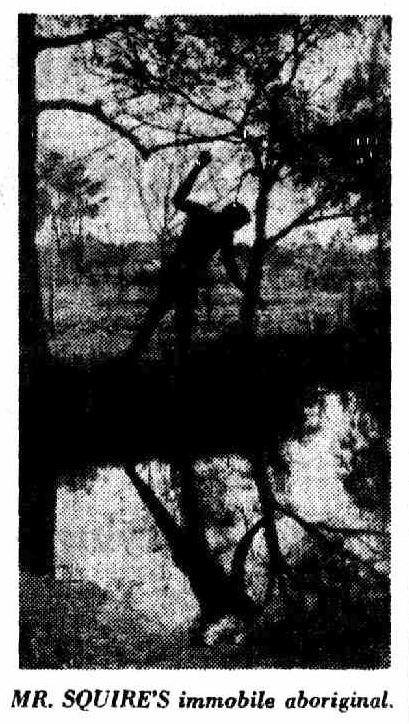
MR. SQUIRE'S immobile aboriginal.
Why The Spear Was Stayed (1935, May 14). The Daily Telegraph (Sydney, NSW : 1931 - 1954), p. 7. Retrieved from http://nla.gov.au/nla.news-article246472427
BLACKFELLOW STATUE REFUSED
Permission for the erection of a statue of a blackfellow spearing a water-buffalo, at the intersection of Park, Bassetts, and Bayview Roads, Mona Vale, has been refused by Main Roads Board.
One reason given was that the policy of the board was against the placing of objects on the road which might distract a driver's attention. The statue is a life-size one by a Mona Vale sculptor, Mr. H. Tristram Squire. BLACKFELLOW STATUE REFUSED (1937, June 17). The Daily Telegraph (Sydney, NSW : 1931 - 1954), p. 3. Retrieved from http://nla.gov.au/nla.news-article247138983
Haystack Point is near Newport and opposite Bayview. In the great flood of 1873 a haystack from a farm on the Hawkesbury River came floating down on its frame work of large logs. It was fastened to the logs with stringy-bark rope. By a freak of wind and tide, it drifted up Pittwater to a point just below the township of Newport. This gave it the name of Haystack Point. A number of pigs, which had managed to float down on the stack and feed on the hay, was retrieved by a fisherman from Mona Vale.
Continuing our old-time journey, the coach climbs a hill, and on the left was once a fine brick-kiln and drying sheds. Bricks of superior quality were made by J. Austin. I remember seeing Mr Symonds, an elderly gentleman, at a gypsy tea near Church Point in the year 1900; he was associated with Austin at the brickworks.
Near this spot, overlooking the water, were the residences of P. Taylor, W. G. Geddes, C. Bennett and Sir Rupert Clarke.
This has brought us to the twelfth mile-post from Manly. Along the road bordered with trees the coach descends to Figtree Flat, also known as Cape’s Flat, and the orchard of W. J. R. Baker, with “Killarney” cottage lying between the two. This flat with its green sward was a favourite picnic ground. The annual school picnic and distribution of prizes were held there on November 9 each year, the birthday of the then Prince of Wales (later King Edward VII.).
Baker’s orchard has long since disappeared. It comprised six acres of peaches, nectarines and other summer fruits, and two acres of oranges. The orangery was situated high up at the apex of the orchard. A row of quince and peach trees flanked the fence next to "Killarney." As Baker also kept poultry, it will be seen that Bayview was once a thriving poultry-farming and fruit-growing district.
CHURCH POINT.
Before describing this district in detail, it is fitting that I should mention the furnished cottages, a feature of early tourist days, and tending to make the place known.
In 1898 we rented “Killarney” cottage at £1 per week, sea baths and a good boat included. My first evening at this spot includes a boyish reminiscence of a walk after tea to Bayview Post Office store for provisions, and a glimpse of the red beacon of Barrenjoey Lighthouse. “Killarney” had a lawn, summer-house, and a white fence—a spot where cool nor’-easters blew the tang of salt sea across the bay. I remember that a big, green-painted lugger, the Thomas and Martha, owned by Thomas Oliver, used to anchor off this spot. She carried firewood for sale in Sydney. Next door lived a fisherman, Tom Wilson, in a squat cabin-type of cottage half hidden by bracken and bush shrubs. From him we used to buy a dozen large black bream and black fish for a shilling for breakfast. Cases were packed with fish—the night’s harvest—and sent up to Manly on the roof of the coach in the morning.
At Mrs Chave’s orchard, a quarter of a mile away, a bucket would be filled with grapes for a shilling. The grape vines grew in a dingle half way between the house and the road. Mrs Chave, an old lady aged ninety-three years, passed away in 1934.
Just above “Killarney” was another furnished cottage, “Drumtochtee,” in which some of the Oliver family once lived. S. Morrison, schoolmaster, owned both these cottages. Later “Drumtochtee'’ was bought and renovated by Rainaud and named “La Corniche.” Luncheons were provided there for visitors. Another furnished bungalow, “Rosstrevor,’’ prettily situated with a beach in front, in a combe on McCarr’s Creek, belonged to J. Ireland, a confectioner of Leichhardt. It was named after his house in that suburb. It was cosily furnished, and had the usual appurtenances of a boat and baths.

CHURCH POINT IN 1904.
The Date Palm on the right was planted in 1902. The old Port Jackson Fig-tree overhangs the spot where the private baths were situated. At that cottage we had many happy days, and it was a base for picnics up the creek, and to Kuring-gai Chase, Scotland Island and The Basin. The scene from the veranda is unforgettable. In the early morn, when the land-locked bay is calm as a mill-pond, the bottle-green reflections of the gums are mirrored in the placid stream. The forest resounds with the melody of butcher birds, while in the bright glory of noon the mocking voices of a few old black crows make the welkin ring as they fly across the hills.
The only school in the district was first held in the Methodist Church, Church Point, Samuel Morrison being appointed teacher on May 1, 1884.
OLD PITTWATER PUBLIC SCHOOL.
And now we re-trace our steps for half a mile. The old Pittwater Public School was a brick building erected in the year 1888. Alongside and facing the bay was a good residence, Morrison’s home for twenty years. My brothers and I attended the school for a couple of days a week when sojourning at Pittwater. Morrison was the only teacher who taught in that school building. The name was changed to Bayview Public School in 1892.
I remember some of the scholars in the years 1900-1903: J. W. Austin, Elsie Baker, Ethel, Lily, Jack and Percy Morrison, Una Chave, Florence and Violet Ireland, the Booth children, Johnsons, Carl Morgan, Roches, Buists, S. Lloyd, and Godbolds. Mrs Francis Anderson used to give a treat each February for the school children when the grapes were ripe at her residence near Bayview Post Office.
In 1904, the motor launch Patonga conveyed children residing at Barrenjoey, Careel Bay and other parts to Bayview school. Early in that year the Hon. John Perry, Minister for Education, instructed Senior Inspector Lobban to suggest means for providing convenient school accommodation for children living in outlying parts. He was assisted by S. Morrison, and it was proposed to gather together all the children (twenty-nine in number) and take them by launch to Bayview Public School. This idea commended itself to Perry, and arrangements were made with William Sykes, the owner of the Patonga, to give the scheme a fair trial. The boat was thirty feet long and eight feet beam, with motor power. The boat was in charge of William Sykes, whom I knew. I often saw the Patonga as she came alongside Church Point wharf with twenty to thirty children aboard. Bayview school was closed on September 7, 1906, and a Public School opened at Mona Vale.
Near Church Point was a boarding-house kept by Mrs Codrington, about 1900, named “Melrose.” Later, in 1906, Mrs Friend ran the place. Then a Mr Huntley had the place in 1908, and after him A. M. Simpson. He grew sweet-peas on a large scale, and the place was known as “Simpson’s Garden Estate.” They also carried on the grocery store and post office at the Point. The place is now known as “The Green Frog,” after the sign at the gate. About ten years ago, an artist, Robert Johnson, made an oil painting of this spot, entitled "At the Green Frog, Church Point,” showing a glimpse of the red roof through the fine gum trees. It was purchased by the Federal Capital Commission, Canberra.
One of the founders of the small Methodist Church, W. H. McKeown, had a camp on the site of “Melrose" and a few fruit trees in 1882. John Redman later lived at this spot, and his tombstone is in the little cemetery at the Point; he died on April 25, 1888.
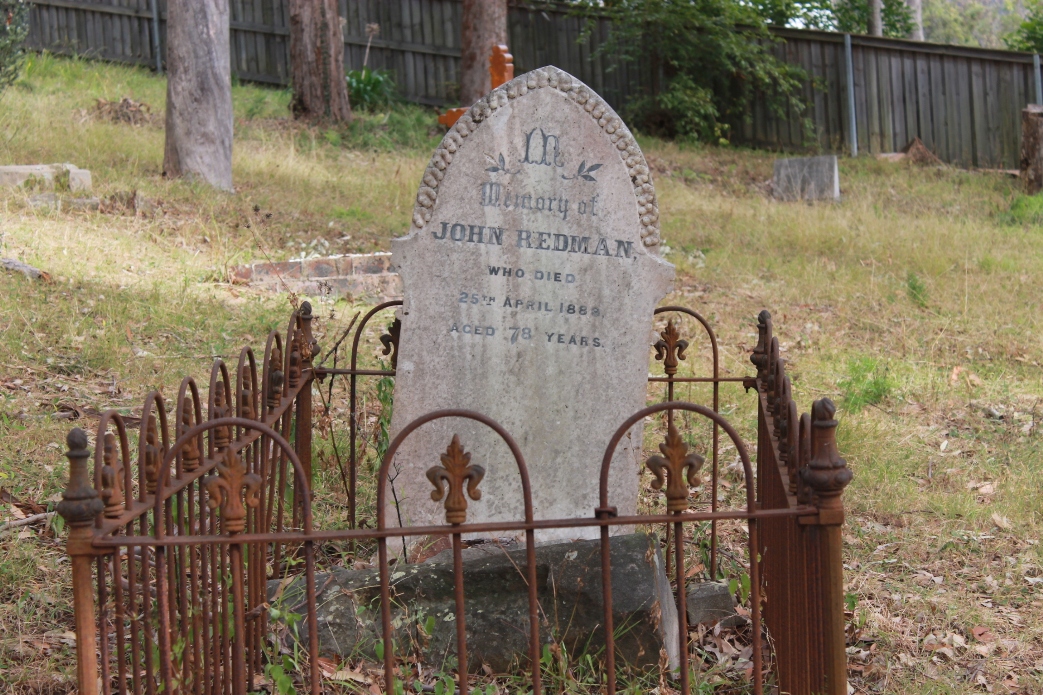
Benjamin James built the present residence, and spent much of his time there about fifty-two years ago. Later on Major Philip Charley purchased this property, and added to the house considerably; and the Fosters lived there for some time, Mrs Foster being a sister of Major Charley. That brings us up to the time of Mrs Codrington, already mentioned.
FOUNDATION OF METHODIST CHURCH.
Church Point derived its name from the small wooden Methodist Church that was demolished in April, 1932. The erection of this church was due to the efforts of George Mclntosh and William Henry McKeown, who first conducted services under the loquat trees at view.
William Oliver, an early settler, gave the Methodist Church one acre of land on the understanding that a church would be built there at an early date. The church was erected on this land in 1872 for the sum of £6O. McKeown supplied a saddle-horse to take the preacher to the services.
When Oliver died he was buried in the churchyard. His tombstone reads: —
William Oliver
died May 16th, 1882
Aged 65.
On the same tombstone is the legend:—
In loving memory of
Mary Oliver,
died July 12th, 1879,
Aged 65.
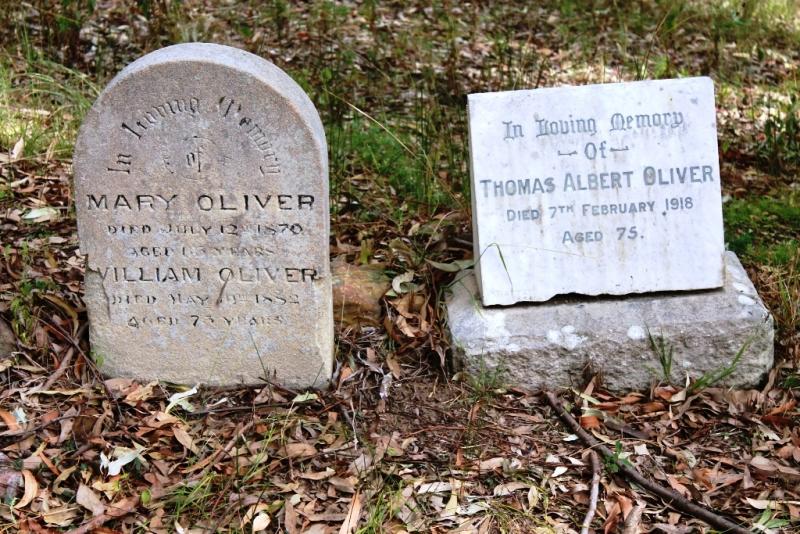
They were pioneers of Pittwater when the blacks still inhabited the fastnesses of Kuring-gai Chase. My father, J. C. W. Wheeler, a lay-reader, took the services occasionally at 3 o’clock on Sunday afternoon. In 1898, I remember Mrs S. Morrison teaching at the Sunday school in the morning.
JAMES BOOTH.
Church Point is ideally situated at the southern entrance to beautiful McCarr’s Creek, and was the terminus for the coaches from Manly. A mile-post stood near the wharf bearing the figure 13. At this spot stood the old Post Office store and boatshed once kept by James Booth, an old identity of the district. He now lives at Mona Vale. He built two large lugger-type yachts, the Claribel and the Menina, each about eight tons, in which he used to take parties down the bay on fishing, camping and pleasure excursions. The quaint little wharf where small cargo steamers landed their goods for local residents is just at hand.
Twenty years ago so sequestered was this spot that the arrival of the cargo boat from Sydney every Friday night about 9 o’clock created a flutter of interest among visitors and residents. Occasionally in those days a stores boat would berth alongside the wharf, and it was quite a novelty to go on board this travelling shop and purchase commodities such as bacon, cheese and butter, and other household articles.
SCOTLAND ISLAND.
Now we shall cross over to the well-wooded Scotland Island. Whence came the name ? The following notes have been taken from The Story of Pittwater* by Maybanke Anderson:— (*Royal Australian Historical Society’s Journal, Vol. VI. pp. 161-243.)
In the early years of the last century the island was a grant to Andrew Thompson who named it after his native land. On the island he built and carried on a prosperous business. He was the son of poor parents, born in 1773, and when he was sixteen was transported for setting fire to a haystack. He died when he was thirty-six, and one month after his death, a paragraph in the Sydney Gazette for November 24th, 1810, describes a ceremony which took place on Scotland Island when a vessel of 18 tons burthen was launched there, one of the finest ever built in the colony, part of the devised property of Mr. Thompson who at the laying down of the keel gave her the name of Geordy.
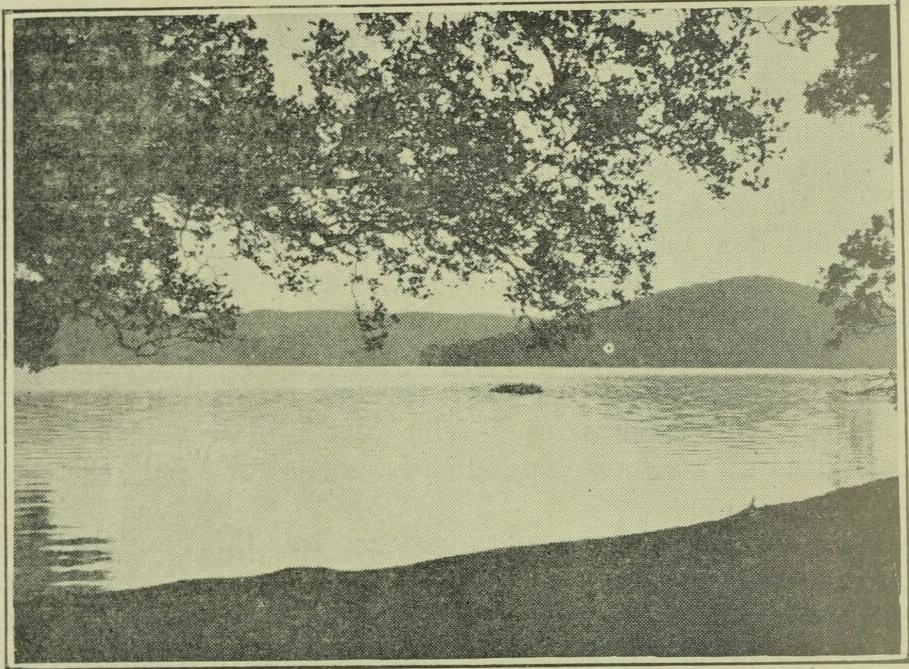
SCOTLAND ISLAND, PITTWATER. [Photo, by C. Price Conigrave.
At the time of the launch of the Geordy the saltworks on the island were advertised for sale, and in 1812, the island itself was advertised in the Gazette “containing 120 acres of good soil, extensive saltworks, a good dwelling-house and stores, labourers’ rooms, and every convenience suitable for a fishery or shipbuilding, also a vessel of about 90 tons, partly built still on the stocks.” The place where the vessels were built may be found by the curious, and near the great sunken logs, which supported their keels may be seen the beds of rubble set in rough mortar on which the salt pans rested. Above these on the slope, on the north side of the island were the foundations of a house, and further up a retaining wall to protect a flat.
Many years ago I saw the sunken logs and the remnants of Andrew Thompson’s house. Andrew Thompson, as we know, is buried in St Matthew’s Churchyard, Windsor.
The Story of Pittwater continues:—
Later on a man who called himself “Joe Benns” occupied the island. He rebuilt Andrew Thompson’s house with logs hewn on the spot. Benns brought with him to Scotland Island Mrs. Benns who was known to the district as the Queen of Scotland Island. She was a useful queen, always ready to help in sickness, and nearly all the small natives of that time owe their introduction to the little world of Pittwater to her kindly ministrations.
On Scotland Island with Mr and Mrs Benns lived Charlie Jenkins. After an undisturbed possession of thirty years they claimed the island and made application for a title, which was granted. The island later was sold for a little over £1000. Mrs Benns was a small dark lady of fluent speech and good manners. I remember seeing her once, an old lady, rowing herself across to Scotland Island in the teeth of a stiff nor’-easter. That was about the year 1905. It was ascertained after his death that Joe Benns’ real name was Ambrol Josef Diercknecht.
At the point of Flood’s Peninsula (Rocky Point) on the rise above the water westward of Scotland Island lies the solid stone and timber residence once known as the “Red House.” It was built in 1891 by J. Booth for Signor Stefani, artist and teacher of music. No doubt this part of Pittwater reminded him of the Italian lakes.* (*Stefani had an Italian wife, but he himself was an aristocratic Englishman named Arthur Stephens. He had probably altered his name for professional reasons.) About thirty-five years ago Mr Speechley, of Speechley and Bennett, engineers, bought the place with its spacious grounds and named it “Wyandra.” It had a good baths, wharf, and tennis-court. A pleasing feature is the Italian balustrade flanking the stone steps leading to the grassy banks in front of the house. The dining room had windows right along facing the bay.
Now situated on the neck of this peninsula between Elvina and Lovett Bays is an old brick and timber squat cottage named “Ventnor,” with low verandahs, and at the rear is a quaint chimney situated on the outside. It was a very isolated place in the ’eighties, where the fig, lemon, orange, the olive and the vine flourished to perfection. A giant figtree there collapsed early in 1934.
FREDERICK OLIVER’S GRAVE.
About one hundred yards distant in the bracken near the track to Linda Falls is the lonely grave of Frederick Oliver, who died in the year 1867. William Oliver (the donor of the land to the Methodist Church) applied for a portion of forty acres, conditional purchase, in 1865, and he had his farm on the neck of the peninsula. As we approach the falls secluded in the gully, we observe through the tall trees the blue waters of Lovett Bay and the flora of Kuring-gai Chase. The cascade pours over a sheer fall of rock of about one hundred feet, and was probably one of three which Governor Phillip saw falling from a ''height” during his visit to Pittwater in March, 1788. The fall is prominent from the bay in time of rain. The name of Lovett first appears on a plan dated 1862 of a survey by Surveyor George Commins of forty acres on the shores of the bay. John Lovett lived at Pittwater in 1836.
From a pool at the top of Linda Falls a water supply was obtained in a two-inch iron pipe sheer down the cliff. This pipe ran the full length of the peninsula to the highest point, on which a huge concrete reservoir had been built. With the constant flow of water it was always full, and in time of drought a supply was reticulated to the three homes on the peninsula, viz., “Trincomalee,” "Fairhaven," and “Ventnor,” from this reservoir.
Kuring-gai Chase National Park.
Across Lovett Bay is the Pittwater shore of Kuring-gai Chase, dedicated as a National Park for North Sydney on December 14, 1894. The first trustees were Hon. Henry Copeland, President; T. A. Dibbs, Vice-President; E .du Faur, Managing Trustee; and E. J. Sievers, Hon. Secretary pro. tem. Four men were employed at Lovett Bay at, six shillings per day in April, 1895, to make the tracks to ‘‘The Lookout,’’ the Flat Rock and the waterfall. The causeway and jetty were built at that time. The cause way was dedicated on January 3, 1907.
In the ’eighties, an Italian, Joe Carrio, a son-in-law of William Oliver, had a selection of forty acres adjacent to this causeway. I remember the remnants there of a few fruit trees. Carrio owned a ketch named The Maid of Australia, in which he made frequent trips to Sydney, taking firewood, with staghorns and tree-ferns as a side line. On the return trip he brought supplies for the settlers living on the side of the bay. There is a beautiful pool with cascades at the head of the bay.
A new track was made to Coal and Candle Creek about 1917, distant two and a half miles. It is a stiff climb up the zigzag track to “The Lookout.” The altitude is about six hundred feet, and there is a tunnel through the rock at this spot—a curious example of weathering. Viscount Hampden, Governor of New South Wales (1895-1899) was escorted to this spot by Mr du Faur.
Near the north entrance to Lovett Bay, F. Chave had in the ’eighties the finest orchard in the district, and his family is notable among the early residents of Bayview.
McCARR’S CREEK.
McCarr’s Creek, flowing into the south-west corner of Pittwater, was first surveyed by Captain John Hunter in 1789, when Governor Phillip made one of his several excursions to Broken Bay. On June 6 of that year a party left Port Jackson at 6 a.m. and arrived at Pittwater at 3p.m. the same day after a pretty warm and fatiguing journey, loaded as the party was with provisions for several days, water and ammunition. The next day was employed in going up the inlet, which the Governor had already named Pittwater, and so much of the day was spent in examining it that, when they returned near to the place which they had passed the previous night, it was thought too late to proceed further. The party therefore encamped on the same spot.
HUNTER’S SURVEY AT BROKEN BAY.
At the end of August, 1789, the Governor expressed a wish to have a survey made of Broken Bay, and Captain Hunter offered to perform that service. In his Journal he wrote: —
In this excursion I was accompanied by several gentlemen of the settlement; the boats were dispatched round under the care of Lieutenant Bradley by whom and Lieutenant Ball of the Supply I was assisted in this work. The party went by land, but as I wished also to make a sketch of the coast between the two harbours, we determined to be two days on the journey, and to lie all night in the woods. After taking a sketch of the coast, we arrived at Pittwater and joined the boats in the afternoon of the second day. We visited all those parts which are navigable for shipping, and having before very particularly sounded and examined all the branches here, the business was finished in little more than a fortnight. Mr. Bradley returned with the boats, and we walked along the shore to Port Jackson. There is also fresh water in various parts of this harbour, with wood in abundance, and fish may be caught in all the sandy bays.
It will be seen from the foregoing, and from an examination of the map in Hunter’s Journal (1792), that a survey of the waters of Bayview, Newport, around Church Point and McCarr’s Creek was made in the early part of September, 1789. I noticed a sounding of eighteen feet well up McCarr’s Creek on that old map compiled 149 years ago; to-day even at high tide one would get only about six feet in the channel to row one’s boat over the same spot, so much has the creek silted up since Hunter's visit.
On Hunter’s map a cross with four dots is shown on the spot where Newport now stands, but no indication is given as to the meaning of this sign. However, from a scrutiny of a map in Collins’ Account of New South Wales (1802), Vol. 2, I found a small circle in the same locality indicating a place where latitude was taken. The crosses on the map in Hunter’s Journal, in my opinion, have the same significance. Another cross on the map is placed on Snapperman Beach, south of Observation Head. These circles and crosses are very interesting, for they show the exact spots where the illustrious founders of our land once stood.
W. R. GOVETT’S SURVEY OF PITTWATER.
Later on, in 1829, William Romaine Govett surveyed Pittwater, and mentioned in his manuscript journal, which is in the Mitchell Library, that ‘'Pittwater receives a romantic creek.” The same stretch of water was surveyed by Captain F. W. Sidney, R.N., in the year 1868, and the creek was marked on the map as Pitt Inlet. The earliest plan on which the name of McCarr appears is that of a survey by J. Larmer, dated June 24, 1832. On the plan of a survey of January 13, 1830, by W. R. Govett, the creek in question is unnamed, so it is probable the name was given to it about that time.
In the estuary of McCarr’s Creek soundings reveal a depth of six fathoms, and this was always a good spot for anglers of red bream; but in the upper reach among the hills there is only sufficient water for rowing boats at high tide. It is to be regretted that the Government cannot see its way clear to dredge these pleasant waterways, as in course of time the silt from the mountains must choke them altogether.
The upper portion of the creek is covered to some extent by a forest of mangroves, and is enclosed by hills rising to a height of five hundred feet. Referring to the summits in these regions surveyed in 1829, Govett states:—
Masses of rock in some instances appear like the castellated ruins of a fortress with its dilapidated walls and shattered battlements—perpendicular in some places, sloping in others —and receding into caves overhung by huge and massive canopies, which may almost be taken for the workmanship of man. These caves or hollows are called by the natives “gibbie gunyahs” or homes of rock, under which they occasionally put a night.
TRIBUTARIES OF McCARR’S CREEK.
Bumpo Creek, a little affluent near the bend, received its name from some of the residents in this way: when one went up at high tide one’s boat continually bumped from one side to the other against snags and mangroves. The upper part is known as Jones’s Gully.
There are several fern-clad gorges which pour their tributary streamlets of fresh water into McCarr’s Creek. Two of these mountain rivulets have their source near Tumble Down Dick Hill 750 feet above the sea, and meet at some distance from the navigable portion of the creek. At this junction is a pool known as ‘‘The Duckhole,'’ truly a “sequestered pool in woodland valley,” if ever there was one worthy of Longfellow’s verse. The single streamlet forms a cascade over the rocks in the glen, flowing under ferny undergrowth and past mossy boulders. It pursues its tortuous course into a little rock-bound basin, finally entering the brackish waters at the limit of tidal action in the creek. This spot is the entrance to the beautiful gorge, and forms part of the boundary of Kuring-gai Chase.
Midway between McCarr’s and Coal and Candle Creeks are some fine examples of blackfellows’ carvings on the wide flat surface of a bed of sandstone. Not far away is a trigonometrical survey station. It is marked “McCarr” on the map compiled by the Lands Department, and the altitude is 620 feet, and from this lonely bushland vantage point a glimpse of Coal and Candle Creek amid surrounding green hills may be obtained. The trigonometrical station was placed there in August, 1880.
“WATERSIDE ESTATE.”
Just above one of the sandstone jetties previously mentioned are the remains of a wood hut, once the residence of Davy Walker in the ’eighties. Buffalo grass lawns, terraces and fruit trees testify to the amount of labour that was put into his “selection.’’ Half a century ago George Medlock, a farmer, also resided at McCarr’s Creek. On the shore opposite to Walker’s land up to the year 1913 stood the cosy weatherboard residence of the late George Brown, owner of “Waterside Estate,” consisting of forty one acres, a grant made in the year 1880.
The track that led from Church Point to Brown’s estate was replaced some years ago by a narrow road to the spot where the house stood, now a turning point for motorists. The first half of this road is Quarter Sessions Road, and it may be mentioned in passing that a Quarter Sessions Road is a road established under the Public Roads Act following a reference to the Court of Quarter Sessions. This application is made to the Court by the proprietor of land alienated by the Crown, to no part of which grant any road of access had been provided to the nearest high-way. The portion through the old “Waterside” Estate is named Brown’s Road.
COAL AND CANDLE CREEK.
A track was made from McCarr’s Creek to Coal and Candle Creek by James Booth about the year 1907 for the sum of £6/10/-. We follow Booth’s tortuous track, and, after sighting McCarr trigonometrical station and inspecting the great flat bed of sandstone covered with aboriginal carvings, we soon cross the track which leads away to Lovett Bay. Further on we descend to the beautiful but lonely stream, Coal and Candle Creek. Then we climb up the gully beyond the limit of tidal action in McCarr’s Creek.
The portion of land in this region, No. 9, Parish of Narrabeen, was selected by Joseph Saxby Davis on February 6, 1890, and was forfeited on May 8, 1901. A very much decayed boundary fence is to be seen, and an old ruined stone cottage—someone’s hope and dream, now a derelict of the bush.
About eleven miles distant from Pymble is the lofty eminence, “Tumble Down Dick.” Where the Pittwater Road winds over that hill there was once merely a track from Lane Cove. That was away back in 1832. A survey plan of that year shows the track leading down to Foley’s farm at Mona Vale, to which I have already referred. The plan also shows the upper reaches of McCarr’s Creek.
Just below “Tumble Down Dick” and close to the Pittwater trigonometrical station (701 feet) there is a region where the hills roll involute. This little-known country embraces the upper reaches of McCarr’s Creek. The stream broadened, and further on, the terrain becoming clearer, we sighted another affluent flowing over a sandstone bed that joined the “right-hand branch” that we had followed in a pellucid pool a few feet deep. This spot engaged our attention and study. The mere rivulet had developed into a fine brook containing pools.
Now the journey became interesting; we felt that we had discovered something worth-while. A tangerine “bottlebrush,” a perfect specimen of Banksia ericifolia, mirrored itself in a pool. On an open tract in a dell-like formation was a splendid setting of boronia, glinting pink in the sunshine, with a few native roses. Boronia serrulata did not “waste its sweetness on the desert air,” and we thanked a beneficent law for its preservation. Now appeared some vestiges of tracks which seemed to suggest that our curiosity was soon to be satisfied. Wider was the brook with holes four to six feet deep, until it flowed into a pond about sixty feet in diameter, ‘‘ The Duckhole''.
An old bushman states that this place was the resort of ducks over forty years ago; at any rate, one could not imagine a happier home for them. The air in this altitude was pure and invigorating. On the opposite side a slight rippling of the water revealed the place where the left-hand stream entered, hidden by thick bush. This is the main stream of McCarr’s Creek.
Distant up that stream a quarter of a mile is a hidden waterfall and emerald pool set amid rugged but beautiful surroundings. It has been named Upper Gledhill Falls.
Truly Surveyor W. R. Govett was not undiscerning when he termed the creed “romantic” in that far-off year 1829!
The Early Days of Bayview, Newport, Church Point and McCarr’s Creek, Pittwater By J. S. N. WHEELER. Journal and proceedings / Royal Australian Historical Society, Vol. 26 Part. 4 (1940) Pages 88, 7905 words. Call Number N 994.006 ROY Created/ Published Sydney : The Society, 1918-1964. Appears In Journal and proceedings, v.26, p.318 (ISSN: 1325-9261) Published 1940-08-01. Available Online: HERE
Extras and References
- TROVE - National Library of Australia
- Church Point Wharf
- The Church at Church Point
- Bayview Wharf
- Bayview Baths Centenary Celebrations
- Don Taylor and Margaret Tink; Some Early Bayview Memories
- Some Bayview Memories: The Lloyd Family - by Ken 'Sava' Lloyd
- Bayview Days: Pittwater In The 1950's by Andrew Amos
- The Williams Family - Pittwater Rowers, Boat Builders and Community Legends
- Cedric Vincent Williams
- Riddles Boatshed at Bayview
- Roche Tea Rooms when Run by The Newey Family
- Katherine Roche - Pittwater Matriarchs
- John Roche
- Sir Patrick Gordon Taylor
- Sir Francis Anderson
- Mark Foy
- Frederick Wymark
- La Corniche at Bayview
- The Green Frog
- The Pasadena - Pittwater Restaurants you Could Also Stay At
- To School And Home On The Ferries - Australia's First School Launch Was In Pittwater
- The Bay View School
- BYRA - a History
- Taramatta Park
- Pittwater Reserves: The Green Ways; Mona Vale's Village Greens A Map Of The Historic Crown Lands Ethos Realised
- The Marquise of Scotland Island
- The First Scotland Island Cup, Trophy And Race And The Gentleman Who Loved Elvina Bay
- A Steamer to Pittwater, A Run to Pittwater, A Trip to Pittwater and A Brief Respite (1880 to 1907)
- A Run From McCarr's Creek To Bayview June 2018
- Roads In Pittwater: The Barrenjoey Road
- Andrew Thompson - 'Long Harry'
- The First Boat Builders of Pittwater I: the Short Life and Long Voyages of Scotland Island Schooner the Geordy
- Pittwater YHA: Some History
- Pittwater Roads II: Where The Streets Have Your Name - Mona Vale, Bongin Bongin, Turimetta and Rock Lily
- Pittwater Roads II: Where The Streets Have Your Name - Bungan Beach
IN THE SHIRES.
WARRINGAH.
At the last meeting of Warringah Shire Council, held at Brookvale (Manly), a letter from the Works Department was read, stating that the council's request, for a grant towards the maintenance of the retaining wall at Bayview could not be entertained. The council recently approached the Railway Commissioners with a request that the cars to be used on the Brookvale tramway extension should be of the same type as those in use In Sydney. A reply was read, stating that the ordinary cars would be used. The Police Department (Traffic Branch) wrote, stating they had received two applications for new coach services starting from the proposed Brookvale tram terminus. It was decided to intimate the intention of the t council to take over the control of the licensing of public vehicles in the shire in the near future. A protest was received from the Ratepayers' Association (B Riding), protesting against the proposed deviation of the tram to Freshwater. To be forwarded to the Minister. The Brookvale Surf and Life-saving dub wrote, offering to provide £ for £ with the council towards the erection of dressing-sheds at Curl Curl Beach. This matter was referred to the works committee. Cr. M'Intosh moved— "That £25 be expended in making the drive at Freshwater, and portion of Edgar-street, Curl Curl, passable for vehicular traffic." It was agreed that the matter should be referred to the engineer for report. The following tenders were accepted:— Forming, etc., Gordon-road: First section, M. Hills £48/10; second section, M. Hills, £69. Three hundred yards of ballast for Gordon-Road: W. Thompson, 8/2 per yard. On the motion of Cr. Hews, it was decided to request the Postmaster-General to establish a receiving depot for dealing with mails at Frenchs Forest. It was decided to carry out some maintenance work on Macpherson and Warriewood roads, on the motion of Cr. Quirk. IN THE SHIRES. (1909, August 23). The Daily Telegraph (Sydney, NSW : 1883 - 1923), p. 11. Retrieved from http://nla.gov.au/nla.news-article238335225
Ambulance waggon for Pittwater
Pittwater district is now in possession of an ambulance waggon, an up to-date vehicle having recently been handed over to the residents of the Warringah Shire. Councillor Powell, in congratulating the residents, called upon Dr. Thomas to perform the official ceremony He paid a warm tribute to the work performed by Constable Hewitt, Councillor Powell, and Mr. Williams. A demonstration in first aid was given by Mr. C. D. Paterson. AMBULANCE WAGGON FOR PITTWATER. (1910, May 2). The Sydney Morning Herald (NSW : 1842 - 1954), p. 6. Retrieved from http://nla.gov.au/nla.news-article15119197
MONA VALE DRAINAGE.
A petition, signed by sixty residents, was presented to the Warringah Shire Council at its last meeting. The object was to draw attention to the drainage of Mona Vale. The Black Swamp is nothing more than a pool of stagnant water the greater part of the year, and when not under water It considered a menace to health by reason of the amount of decaying vegetable matter washed into it during every storm. It was suggested that a drain be made from Warriewood and Newport roads to the ocean, via Bayview. If this were done a considerable portion of good residential and agricultural ground would be opened up. The matter is to have consideration. MONA VALE DRAINAGE. (1913, June 18).Evening News (Sydney, NSW : 1869 - 1931), p. 10. Retrieved from http://nla.gov.au/nla.news-article113364399
Motor Fatality
A young woman named Oliver was thrown out of a motor car on Mona Vale road yesterday, and was killed. Motor Fatality (1918, March 25). The Gundagai Independent and Pastoral, Agricultural and Mining Advocate (NSW : 1898 - 1928), p. 2. Retrieved from http://nla.gov.au/nla.news-article121755649
LORRY CAPSIZES
TWO MEN INJURED
When a motor lorry capsized in Pittwater Road. Mona Vale, on Saturday afternoon, the driver, Herbert Walker, and Jack Bass were injured. Walker's hand was badly hurt, and Bass sustained severe shock. The other occupants of the lorry escaped injury. Walker and Bass were taken to the Manly Cottage Hospital. LORRY CAPSIZES (1923, December 31).The Daily Telegraph (Sydney, NSW : 1883 - 1930), p. 2. Retrieved from http://nla.gov.au/nla.news-article246001938
KILLED BY LORRY
SYDNEY, Thursday.
WHILE walking along Pittwater road, Mona Vale, last night, Charles Wilcox (50) was knocked down by a motor lorry and died later. KILLED BY LORRY (1935, July 25).Mudgee Guardian and North-Western Representative (NSW : 1890 - 1954), p. 1. Retrieved from http://nla.gov.au/nla.news-article162530894
SHOT IN THE THIGH
MILD SENSATION AT MONA VALE
A LOCAL sensation was created at Mona Vale about ' 4.30 yesterday afternoon when it was reported that a man was shooting with a revolver in the bush just off Bassett-road. Constable Grant, of Mona Vale, hurried to the spot and found a man who had been shot in the right thigh. He gave the name of A. Windybank and handed the constable a note that he had written previous to the shooting. He was taken to Manly Hospital for treatment, and later conveyed to the Reception House. SHOT IN THE THIGH (1929, March 10).Truth (Sydney, NSW : 1894 - 1954), p. 1. Retrieved from http://nla.gov.au/nla.news-article169320609
MAN SHOT .
MYSTERIOUS ROAD DRAMA WANTED BIKE RIDE EXCITEMENT AT MONA VALE
Strange circumstances surround the shooting of a young man in the bush at Mona Vale yesterday.
The victim is suffering from a superficial bullet wound, refused to disclose his address to the police. After treatment he was taken to the Reception House. Previous to the shooting, Stanley Porter, of Newport, was cycling along Mona-road, on his way to Mona Vale. A man stepped from the road, hailed Porter, and asked him for a ride on his bicycle. As the stranger appeared to be under the influence of drink, Porter refused to hand over his bike. The man, it is stated, then pulled out a large automatic pistol, and commenced to load it. Porter jumped on his bike and cycled off as fast as he could. Arriving at Mona Vale he Informed Constable Grant, who hurried along the road. When he got within 200 yards of a clump of bushes, near Bassett-street, the constable heard five shots. He ran towards the spot and saw a young man with an automatic pistol reeling against a tree. He was too ill to offer any resistance, and after Constable Grant had called in Dr. McGuiness to examine him, the patient was taken by the Manly Ambulance to the local hospital. The bullet, it is stated, pierced the right side, was deflected along the ribs, and came out near the shoulder. MAN SHOT (1929, March 10). The Sun (Sydney, NSW : 1910 - 1954), p. 2. Retrieved from http://nla.gov.au/nla.news-article222694919
LATE MR. "TOM” ARTER
DEATH AT MONA VALE
The death took place during the week-end, at Mona Vale, Pittwater, of Mr. Thomas Arter, and the remains were interred in the Gordon-road cemetery, at that place, on Monday.
Some, or 45 years ago, the deceased was a well-known local identity, and resided at Marrangaroo. Being a bricklayer by-trade,, the late Mr. Arter assisted in the erection of several of Lithgow's earlier buildings. He owned a block of land in Main-street, on which 40 years ago, he erected the premises in which Mr. Lunney's smallgoods shop is now located. The building was first let to a printing firm, from which the "Lithgow Times and Western Unionist" was issued. The paper did not survive more than two years, owing to financial stringency resulting from the 1893 banking crisis. Mr. R. Northey is the only member of the firm now resident in Lithgow. Mr. Arter also owned property in Inch street. The deceased was one of the old school, rugged and honest, qualities which won for him the goodwill of his fellow citizens. Later, he took a trip to South Africa, where he remained a few years. Returning to Lithgow, Mr. Arter pursued his trade for a time, and on retiring from work, went to reside on the outskirts of Manly, where one of his children had settled. Many of Lithgow's "old hands" will well remember the deceased, who had reached a ripe old age. LATE MR. "TOM" ARTER (1931, December 2). Lithgow Mercury (NSW : 1898 - 1954), p. 2 (TOWN EDITION). Retrieved from http://nla.gov.au/nla.news-article221857821

Information Provided As Mrs. Hawkins Talked With Mr. George Johnson
31.7.78 (Pittwater High School)
Mr. Johnson was born at 1891 Pittwater Rd., in 1907. His grandfather Mr. Arter, who built houses A, B and C lived with Mr. Johnson’s parents and the rest of the family, at that address. Mr. Arter continued to work as a bricklayer in the district, working on the Rock Lily and the general store, at the site of the present paper shop. (Mr. Johnson has a picture or the two storied building.)
Mr. Arter was a Lithgow businessman who came to live near the corner of Waterview St., Mona Vale, with his family. Mary Arter (Mr. Johnson’s mother had looked after her younger brothers and sisters from the age of 12 or 14, after their mother died. Mr. Johnson showed me his parent’s marriage certificate, showing the date of marriage 26/8/1903, and Mary’s age as 21 years. Mr. Johnson believes houses A, B, C were built prior to Mary’s marriage. Mrs. F. Lewis told Mr. & Mrs. Johnson that Mary said she was 17 when House A was built. Mr. Johnson recalls the bricks for the houses were obtained from Wilcox in Bassett St. area, and later from Mona Vale Rd.
Mr. Johnson’s paternal grandfather, who married Louisa Oliver, built the first house at Church Point. This house has been restored and re-decorated. Mr. Johnson has a photo of his grandfather, and he recalls how he and his brother would leave Mona Vale at 4.00am and run or walk behind grandfather’s horse and cart, as it carried wood for baker’s ovens or for building at Manly. After lunch of half a loaf of bread each with cheese, the boys enjoyed the cart ride back as groceries were carried back.
Mr. Johnson’s mother’s sister was married to Mr. John Oliver who, in an affidavit, described how residents flocked to the wharves when the steamers arrived and unloaded their supplies. The steamer carrying the tin used in the roof of houses A,B,C, would have been unloaded at the Bayview wharf, alongside the present William’s Marine. Mr. Johnson remembers the steamer’s whistle alerted everyone to the approach of the steamers. Mr. John Oliver worked for Mr. Geddes and mentions the ships “Hawkesbury”, “Narara” and “Erringhi”. Mr. Oliver was concerned to maintain the cemetery at Church Point- site of the Methodist Church.
John Oliver lived in the timber cottage at 1624 Pittwater Rd. after his father George. John later built where the Vet is now located.
Mr. Johnson’s father worked as a labourer in the Mona Vale area. On his property along Pittwater Rd. he grew flowers which he sold to the florist at Manly Wharf. He was the first labourer on the Maintenance Dept. of Warringah Shire Council. As the Shire extended to St. Ives, he would ‘travel to St. Ives by sulky, and camp overnight to enable him to maintain the road by filling in the holes in the dirt road, using a shovel and wheelbarrow. Mr. Johnson’s father cut the stone for the building of St. John’s Church at 1624 Pittwater Rd. There are two headstones in the churchyard, originally from the cemetery of the first St. John’s Pittwater on the Mona Vale headland off Grandview Pde. (1871-1888).
(Mr Geddes owned property on “Brick Yard Hill” ½ mile from Wharf, east towards Bayview).
Mr. Johnson has a postcard, dated 1906, showing Pittwater Rd., Mona Vale with the three brick houses on the right, two houses and a wooden Church on the left of the road. Two of the brick houses were named “Esbank” and “Lithgow” (“Bowenfels” may have been the name of the third.) The two wooden houses were occupied by Wilsons and Aldridges. He cannot recall the occupant of the third wooden house. There are two tall cabbage tree palms on either side of the road, opposite house A.
There is a line or telegraph poles on the left-hand side of the road. Mr. Shaw built boats and launched them at the nearby creek. The black berry patch at the right of the picture, is the spot where the girl Godbolt was bitten by a snake, and ran home to near Loquat Valley School. Her mother treated her and she was away from school for four days. As a boy, Mr. Johnson’s Sunday Sport was killing black snakes with a stick in the swamp where the Bayview golf links are now located.
When four years old, Mr. Johnson attended the Mona Vale public School in the old house which still stands next to the lane off Park St. Mr. Morrison was the teacher. When he was Six, Mr. Morrison was the first teacher in the stone Mona Vale School. After the School burnt down, classes moved to La Corniche, with a new teacher and his wife. Mr. Ross and Miss Giddely were teachers when Mona Vale School was rebuilt. The house with the attic at 28 Park St. was built by Mr. Stringer, possibly at the same time as Brock’s was built. (later known as La Corniche).
As a boy, Mr. Johnson and his father used to do odd labouring jobs for Mr. Arter. Mr. Johnson believes Mr. Arter built the Bakery at the same time as the house. There was one baker before Andrieson. When Mr. Johnson was about 14, he worked for Mr. Andrieson, and recalls that young Jack Andrieson playfully tripped him as he ran from the Bakery to the house, with the result that he landed face down in his tray of hot buns. There was no license needed for making or selling bread in those days, but occasionally an inspector checked the weights of the bread. When 16, he worked for Mr. Maisey and he had a photo of himself with the bread cart, when the bakery was operating in Bungan St. Mr. F. Lewis recalls that Mrs. Shreinert Snr. used to serve teas in the side room at House b, before her son was married. The three houses were known as Show places in the district.
The Marshalls and Connellys were two families who lived along the present Mona St., north of Pittwater High School. Homers Dairy was located north of Bassett St.
In the early 1900’s Mr. Boulton was digging wells on a Newport property, and when he heard the lady owner wanted to sell, he said he’d found gold there. Coal shafts were dug uneventfully off Walters Rd. and also at Lane Cove Rd., Ingleside.
Mr. Johnson has an aerial photo -1906- of Bayview wharves, many of which no longer exist.
(The George Johnson’s lived opposite St John’s – George’s parents lived on the corner)
Warringah Shire Council Records - Minutes from Meetings: Bayview and Church Point Wharves and Roads
21/06/1926 That H. J. Fitzpatrick's proposed refreshment room and boat-shed and on his permissive Occupancy near Church Point Wharf be approved, provided he give an undertaking that when the existing Post Office is demolished, he will add a community boat-shed in uniformity with the rest of the building; and that his charge for the use of boats shall not be more than that recently fixed in the case of Goddard's application, Palm Beach. Church Pt. Rd. H. J. Fitzpatrick's letter 11/6/26/ requesting the widening of Church Point road opposite the site of his proposed building was read; and it was resolved, (Crs. Hitchcock, Simpson) That the work be done, and £60 be voted therefore. Resolved,- (Crs. Hope, Simpson) That it be left with do the Engineer to decide as to whether the work should be done by the Council's men or by contract.
Meeting of 3rd August, 1926. That with regard to the proposed widening of the road adjoining H. J Fitzpatrick's Special Lease near Church Point Wharf, and filling in Mr. Fitzpatrick's land adjoining the road alignment; he be asked to state what he is prepared to contribute towards the cost, and that the proposal for widening the road be forwarded to the Main Roads Board for its approval
British Imperial Oil Co; 30.7.26 requesting permission to install a petrol tank under the road in front of H. J Fitzpatrick's Special Lease at Church Point, with in two ok three foot of the approved position for the pump: Resolved; -' (Crs; Hope, Hitchcock) That the request be granted
A. Jensen. 11/2/27. Forwarding petition by 25 residents by rate-payers of Church Point for the construction of public baths at Church Point. Resolved (Crs. Hope, Simpson) — that the matter be referred to the Councillors for A. Riding.
H. Jensen 3/11/27. Drawing attention to the bad condition of the roadway in front of his business premises at Church Point, and also inquiring what the Council proposes to do in regard to the erection of public baths at Church Point. Resolved (Crs. Simpson, Hitchcock) - That £10 be voted for repairs, suggested by the Overseer.
Baths query not addressed
10/11/27. 9. Bayview, and Church Point Progress Association. (1) Inquiring as to what is the Council's policy in regard to leases along the waterfront, and (2) what the Council intends to do in regard to declaring the district a residential one. Resolved (Ore. Parr, Hitchcock) - The Association be informed that it is the Council's policy to resist is far as it reasonably can, the alienation of the waterfront, and to deal with each case on its merits, and that it be suggested they convene a public meeting for the purpose of obtaining an expression of opinion regarding the question of a residential district.
H. Jensen. 14/2/28. Requesting permission to erect notices advertising launches, and setting out time tables of Church Point ferry services, on shelter shed on Church Point Wharf and similar time tables on the various wharves at which the ferry calls. Resolved (Crs. Hope, Hitchcock) - That permission be granted as desired.
Bayview and Church Point Progress Association. 30/4/28. Submitting a resolution passed by the Association on 5th ult. 'Residential relative to the declaration of a residential district. Districts Deferred for consideration until next meeting.
44. Bayview and Church Point Progress Association.. 1/6/28; Requesting that notices be erected on the roadside at Bayview requiring campers to burn or bury, their rubbish. Resolved '' (Cr5. Hitchcock,Hope) That two notices be erected as requested.
A.J. Morgan. 28/6/28, Reporting that the end of Great Mackerel Beach Wharf is in a dangerous condition. To be informed of the instruction regarding the erection of a warning notice. 16. J. Young. 20/6/28. Complaining of the condition of the roads on Scotland Island, and also of the unsatisfactory ferry service running between Church Point and Scotland Island. Referred to the Overseer for report. 26/6/28. and Requesting that the roads on Scotland Island be cleared and that the shark proof fence around the baths at the north wharf be repaired. Referred to the Overseer for report. 18. M. P. McNultv, 25/6/28. Requesting that the lantana on the public reserve next her land on Scotland Island be cleared away, and that Pitt View Street be put in order. Referred to the Overseer for report.
12. Bayview & Church Point Progress Association. 29/9/28. Requesting (1) that the practice of tipping rubbish into the Bay on both sides of Church Point wharf be stopped, and the rubbish cleaned up, and (2) that notice boards be erected at Bayview and Church Point indicating the names of the localities. Resolved (Crs. Hitchcock, Campbell) - That notices be erected warning against the tipping of rubbish at this spot, The Inspector report regarding the cleaning up of the rubbish and the Association be asked for information regarding the offenders; also that locality signs be erected as requested. 13. Mrs. J. Scrivener. 3/10/28. Submitting offer to rent the cottage on Newport Beach resumed area, formerly owned by herself. Resolved - That Mrs. Robertson's lease date issued from 1st November, and that it be a condition of the lease that she shall not use any portion of the building as a tea room, but that the building be used solely for residential purposes.
8. Bayview & Church Point Progress Assn. 19/12/28. Urging the Council to proceed with the solution for providing a parking area near Church Point, and suggesting a visit from the the Engineer. Referred to A. Riding Councillors,
Occupancies 11. H..J. Fitzpatrick. 21/3/29. Replying that he is now dealing with tenders for a new building at Church Point to take the place of the one demolished by fire. Resolved - That Dr. Fraser, in regard to his application to erect a boat shed and garage-at Church Point, be advised of Mr. Fitzpatrick's proposal, and it be suggested to him that he house his boat and car in the new buildings when erected.
81. Bayview & Church Point Progress Assoc. 21/4/29. On the need for combating the mosquito pest. Received. '
42. M. Bryant. Respecting the disabilities 6/5/29. suffered by the ratepayers and residents of Scotland Island, Elvina Bay, Lovett Bay and Fowler Bay by the discontinuance of the ferry service and also by the absence of a store at Church Point. 42a. .Amos Corbet 8/5/29. On the need for a public boat-shed at Church Point. Consideration deferred till next meeting.
18. H. Bryant.. 16//29. Pointing out the need for provision for boatshed and skids in Mr. Fitzpatrick's proposed building at Church Point. Progress Assoc Miss E.A. Poster Urging the Council to take action to secure a permissive establishment of the ferry service to Scotland Island, F. F.. 1 Occupancies and a store for necessary goods at Church Point, 19, Clayton Utz & Co. Respecting H Jensen's 14/5/29. application for a Special Lease at Church Point,and requesting to be advised of the Council's reasons for objecting to such application. 20. T.C. & H Malnh. .20/5/29. Also on the lack of a ferry service to Scotland Island. Resolved (Crs. Hitchcock, Austin) - That H J. Fitzpatrick be given a fortnight in which to furnish the Council with a satisfactory reply as regards his intentions for the re-erection of his store etc at Church Point, and he be informed that if no satisfactory be received by next meeting, the Council will support other applicants
Clayton Utz & Co. 30/5/29. Further; in regard to H. .Jensen's application for a.Special Lease at Church Point,; and requesting the Council to do all in its powers to enable Mr. Jensen to act the store running Permissive again. H J. Fitzpatrtck. 4/6/29. Furnishing reason for the delay in the re-erection of his store &c at Church Point. Decided that if Mr. Fitzpatrick's buildings be not commenced within one month, the Council support Mr. Jensen's Special lease application.
8/7/1929: Resolved (Crs; Austin, Robertson) - That the Council withdraw its objection to H. Jensen's application for a Special Lease at Church Point wharf, and that Mr. Fitzpatrick and also the Land Board be advised of this. Resolved (Crs. Greenwood, Ross)
Same. 27/9/29. Requesting that favourable consideration be given Dr. Fraser's application for Permissive Occupancies permission to erect a boat shed and garage on a Permissive Occupancy at Church Point held by him since 1921. Resolved, That the Council adhere to its previous decision in the matter and it be pointed out to the Department that Mr. H.J Fitzpatrick has until February to erect a public boat shed on his Special Lease, that if the work be not done by that time, Dr. Fraser's application will then be dealt with on its merits. 4.
13. Bayview & Church Point Progress Assoc. 23/9/29. Drawing attention to the congestion of launches and skiffs at Church Point Wharf, and (2) reporting that at low tide the wharf piles are seen to be very decayed. - Resolved, - That a notice be erected prohibiting the mooring of beats at the wharf.
9. Bayview and Church Point Progress Assoc. 21/10/29. Permissive Requesting that the Council endeavour to expedite the re- building of the Church Point Store, etc. Occupancies 9a. Lands Dept- 30/10/29. Furnishing particulars of H.J..Fitzpatrick's lease 9b. Same. 30/10/29. Respecting H. Jensen's lease Received.
Main Roads Dept. Received.' 4. Same 27.2.30 Pointing out that the temporary store erected on Bayview Road, Church Point, by H Jensen, has not been removed, although the six months allowed in the permit has expired.
48. Local Government Dept. 25.2.30. Advising the Council that Residential District No. 2 (Bayview and Church Point) was proclaimed in the Government Gazette as of 14th ult.
5/5/1930: (2).That in connection with the building operations adjacent to Church Point wharf, the Inspector see that no more timber is placed on - -
19.Bayview & Church Point Progress Asso. 10/5/30. .. . Suggesting that the sandy-mud flat adjoining Wymark's new store at Church Point be reclaimed for the purpose of providing a parking area. Referred to the Works Committee for report.
Obstruction Main Roads &. 10/7/30.. Pointing out that the temporary store erected on the road at Church Point by Mr. Jensen is still there,and requesting that arrangements be made for the early removal of it. Resolved, - That Jensen be notified to remove the structure within a week, and that if he does not, the Council will pull it down and take it into its depot. (Crs..Hitchcock, 'Austin)'
1. Navigation Department, 28/7/30. Objecting to the reclamation proposal at Church Point adjacent to the Church Point wharf, submitted-by the Council, but.suggesting a. - Reclamation continuation of the cqxc.rdte nil front C. E. Mann's Special lease in a straight line to the wall on the north approach. (Dealt with in Works Committee's report)
The Shortage of Shell Grit
The closing of metropolitan beaches to the operations of shell grit miners occasioned enquiries by the APPA regarding the possibility of having certain beaches reopened. In all instances, however, the efforts have been met with refusal. The dredging company at Bay-view in addition is requiring its entire output for smelting purposes and this important source of supply accordingly cannot be relied upon. The position was I represented to the Minister for Agriculture with the request that a survey of the position would be made and efforts made to ensure adequate supplies being made available. The reply received from the Minister for Agriculture, copy of which is given hereunder, is of very great interest in view of the advocacy of ground lime stone as a substitute and a much cheaper equivalent to shell grit: "Dear Sir, ...POULTRY FARMERS (1946, December 19). The Leader (Liverpool, NSW : 1946 - 1949), p. 3. Retrieved from http://nla.gov.au/nla.news-article66417294
BRICKS FROM SAND
Warringah Shire Council decided last night to grant a special lease to Composite Brick Pty. Ltd. for the dredging of sea sand at Bayview, Pittwater.
The sand will be used to make clay-cement bricks. It will be taken from areas in the Newport channels that have been silted up by previous dredgings.
The Council rejected a proposal that a special lease be granted for an area at the head of the bay which the company is willing to reclaim by dredging. The company wanted to build a factory on the reclaimed land. BRICKS FROM SAND (1947, September 3). The Sydney Morning Herald (NSW : 1842 - 1954), p. 4. Retrieved from http://nla.gov.au/nla.news-article18041363
A Great Schoolmaster.
WILLIAM TIMOTHY CAPE.
A SYDNEY TEACHER 100 YEARS AGO.
By WOLOMA.
What the Universities, the Colleges, and the High Schools of Australia are now doing every day to lit the young man and woman with an education that will make them avail able for the highest positions in public life was done solely by one man for the splendid types of early Colonial youth that flourished in Sydney one hundred years ago.
That remarkable man was William Timothy Cape—now an imposing figure in Australian history—who fulfilled the duties of a little University in himself, so to speak, although be loved best, and was almost strict in exacting, his simple calling—a competent schoolmaster. This great pioneer schoolmaster of higher education—as it was then termed—was an Englishman, born at Walworth. Surrey, on October 25, 1806. His father, William Cape, was a London bank manager and was induced to emigrate to New South Wales on the assurance of receiving special privileges from the Colonial Government, and he accordingly reached Sydney with his family, including William Timothy, in the early twenties of last century.
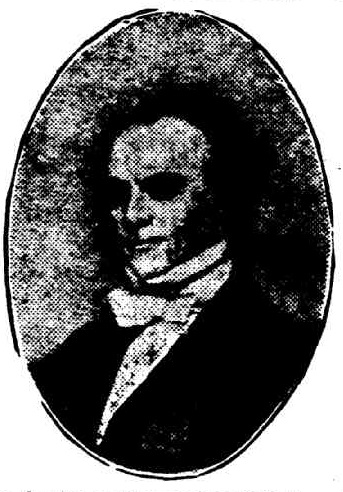
The father and son were soon at work in Sydney as combined teachers, having shortly after their arrival opened a private school in Macquarie Street,which they named the Sydney Academy. Success at tended the venture, and the fame of the school quickly circulated among the colonists, and attracted the notice of the Governor-General. Sir Thomas Brisbane. At this time, W. T. Cape was in bis nonage (about 17 years old), and possessing an English reputation for general erudition and classical learning, with the further inborn gift (the teacher's gift) of imparting know ledge to others; it may be guessed that the splendid teaching powers of the younger Cape influenced the father in abandoning the banking business to follow the profession of schoolmaster too. It is not surprising, there fore, to find that early in 1824, the Governor General, Sir Thomas Brisbane, offered Mr. Cape, senr., the headmasterahip of the Sydney Public School, then known as the Georgian School, Castlereagh Street, and more recently as the Sydney Girls' High School, now demolished to make room for the new St. James Theatre.
It may be mentioned that with this appointment was modestly included the name of William Timothy as assistant. In 1825, Cape senior having retired, the son became headmaster, and for some years he labored as such at the Georgian, when he, too resigned his position in the Government service. W. T. Cape, in 1829, started a private academy at the corner of Phillip and King Streets, the site now being occupied as a public-house. He labored here for six years, and fashioned some of the best of early Australia's native brains, including Sir James Martin. Judge Dowling, Dr. Jas. Nor ton, William Forster, Geoffry Eager. T. A. Browne (Rolf Boldrewood), Sir John Robert son. Sir Saul Samuel. Sir William Windeyer, Judge David Forbes. W. B. Dalley. Q.C, the Stephen brothers (Alfred Conaett and Matthew Henry), and Sir George Wigram Allen.
At this time the reputation of Mr. W. T. Cape, as a teacher was so high, that in January, 1836, the committee of Sydney College. which now forms the ancient centre building of the Sydney Grammar School, induced him to close his private school in King Street, and accept the headmastership of the Sydney College, sixty of his private pupils following him to the latter. He continued in charge of the college for seven years, when, through some friction with the committee, he resigned, the attendance of pupils being 192. Me was succeeded by Rev. T. H. Braim, who remained in charge till 1847, when the college had to be temporarily closed, the attendance of pupils being only sixty-two, the fees from these being insufficient for its upkeep. Meanwhile. Mr. W. T. Cape was established in his own private school, "Elfred House" Glenmore road, Paddington, built on a land grant to him of 4 acres 27 perches, where he continued to reside until his final retirement as a teacher, in 1856.
In 1859 he was appointed a Magistrate of the Territory, and returned a member of the Legislative Assembly for Wollombi; he was also created a Commissioner of National Education, and elected a Fellow of St. Paul's College. In 1860 he resigned all these appointments, and proceeded to England to complete his children's education and to establish their principles as British subjects. Three years later he died of smallpox in England and was buried at Brompton.
The first memorial tablet to be erected in St. Andrew's Anglican Cathedral, Sydney, was one to his worth as a great schoolmaster and 4n English gentleman, reverently placed there by some of his old Australian pupils. A Great Schoolmaster. (1923, March 24). The World's News (Sydney, NSW : 1901 - 1955), p. 35. Retrieved from http://nla.gov.au/nla.news-article128671920
NEW SOUTH WALES.
RETURN OF ALL CONVICTS ASSIGNED BETWEEN THE 1st DAY OF JANUARY AND THE 31st DAY OF MARCH, 1832
1136. Turner John, Surry (5), ploughs, &c. to William Timothy Cape, Sydney NEW SOUTH WALES. (1832, July 4). New South Wales Government Gazette (Sydney, NSW : 1832 - 1900), p. 164. Retrieved from http://nla.gov.au/nla.news-article230388706
Anno Quinto.
GULIELMI QUARTI REGIS.
By His Excellency Major-General RICHARD BOURKE, Captain-General and Governor- in Chief of the Territory of New South Wales and its Dependencies, and Vice-Admiral of the same, with the Advice of the Legislative Council.
An Act to enable the Proprietors of a Public Library, heretofore instituted and conducted at.Sydney, under the name and designation of the "Australian Subscription Library,'' to sue and be sued in the name of the Secretary for the time-being of the said Library, and for other purposes therein-mentioned.
WHEREAS, a Society or Company was some time since forrned at Sydney, in the Colony of New South Wales, for the purpose of establishing a Public Subscription Library; and whereas, the said, Society or Company has been established, and is now carried on in Sydney under the name or style of the " Australian Subscription Library," and consists of about eighty Members or Share-holders, and is under the management and control of a President, Vice-president, Treasurer, and Secretary, and a Committee of ten Members chosen, and to be chosen, from time to time, from the body of the Proprietors: And whereas, the sum payable on the admission of each Member is an Original subscription or payment of Five Pounds sterling, and an annual subscription or payment of Two Pounds sterling : And whereas, difficulties may arise in recovering the debts, fines, and penalties due, and to become due, to the said Society or Company, and in maintaining actions or other legal proceedings for damages done to their property, and also in prosecuting persons who may steal or embezzle the goods, chattels, and effects of the said Society or Company ; and it would be also convenient and just that persons having demands against the said Society or Company should be entitled to sue some Member thereof in the place and stead of the whole : Aud whereas it is expedient that the said Society or Company should have the pdwer to contract for, and purchase either in fee simple, or for life or lives, or for any term or terms of years, for the purposes of the said Society or Company, any measuages, buildings, lands, tenements, and hereditaments, situate in the Colony of New South Wales, and also to sell all or any of the said messuages, buildings, lands, tenements, and hereditaments, as they may think proper, and purchase any other messuages, buildings, lands, tenements, and hereditaments, for the purposes aforesaid ; and also that the* said Society or Company should be empowered and enabled to accept, take, receive, and hold, and subsequently sell or dispose of any messuages, lands, tenements, and hereditaments, money, property, arid effects whatsoever, which shall or may be given, devised, or bequeathed, to them : And whereas Thomas "Walker, of Sydney, Esquire, Merchant, James Mitchell, of Sydney aforesaid, Esquire, Surgeon, and William Timothy Cape, of Sydney aforesaid, Esquire, have been at a general Meeting of the said "Society or Company, nominated and elected Trustees for the purpose of this Act: And whereas the above-mentioned purposes cannot be effected without the aid and authority of the Legislature : Be it therefore enacted, by His Excellency the Governor of New South Wales, with the advice of the Legislative Council thereof, that the present Proprietors of any share or shares in the said Society or Company, and all such other persons as shall from time to time become Proprietors of any such share Society or shares shall be and they are hereby authorised and empowered to purchase any chase rmd lands, messuages, tenements, and heredita acceptments for the purposes of this Act, and also lands, &fc. to accept and take, receive and hold any lands, messuages, tenements, hereditaments, money, property, and effects whatsoever.
(Lands, &C. belonging to the Society vested in Trustees.)
II. And be it further enacted, that all lands, measuages, tenements, and hereditaments, and all charts,' books, accounts, minutes, records, and all other books kept by any officer of the said Society or company, and relating to the affairs of the same, and all furniture, goods, and chattels, of what nature or kind soever, now being or at anytime hereafter to become the property of the said Society or Company, shall be and the same are hereby declared to *be vested in Thomas Walker, of Sydney, aforesaid, Esquire, merchant, James Mitchell, or the same place, Esquire, surgeon, and William Timothy Cape, of Sydney, aforesaid, Esquire, and their successors, as Trustees for the said Society of Company.
(Trustees dying, property to vest in survivor.)
III. And be it further enacted, That in case of the death, resignation, or absence from the Colony, or tlie incapacity of any or either of the said Trustees, or of any other or future Trustee or Trustees, tha^ then the said lands, messuages, tenements, and lierew ditaments, charts, books, furniture, and other property belonging to the said Society or Company shall vest in the surviving or remaining Trustee or Trustees, until some other person or persons shall be elected at a general meeting of the said Society or Company, to be held in manner ...An Act to enable the Proprietors of a Public Library,heretofore instituted and conducted at Sydney, under the name and designation of the "Australian Subscriptiqn Library," to sue and be sued in the name of the Secretary for the time-being of the said Library, and for other purposes therein-mentioned. (1834, August 13). New South Wales Government Gazette (Sydney, NSW : 1832 - 1900), p. 582. Retrieved from http://nla.gov.au/nla.news-article230687232
MANLY TO BAY VIEW—A POPULAR EASTER RESORT BY ROAD
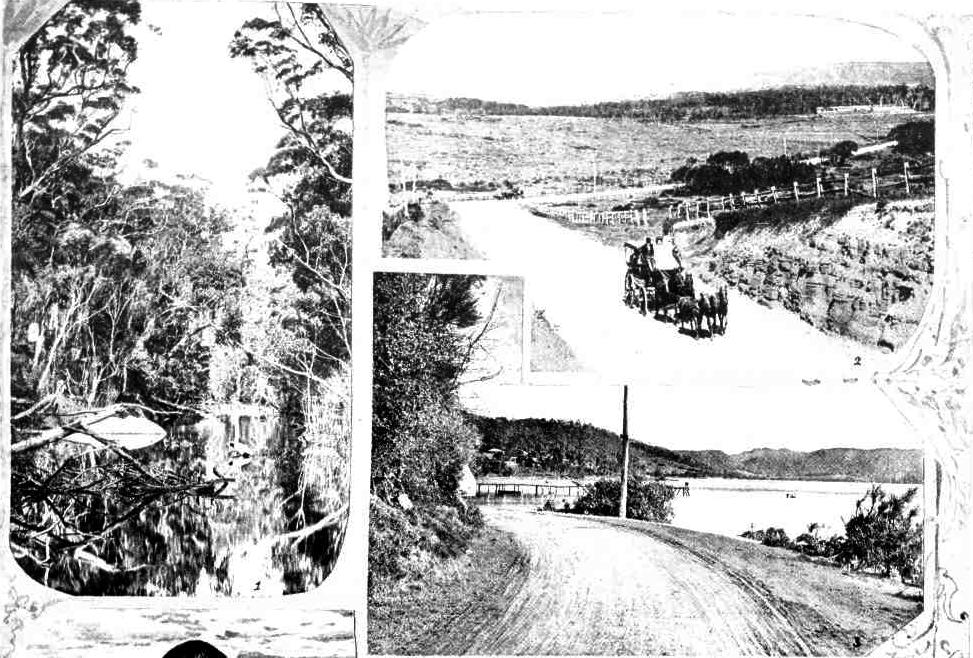
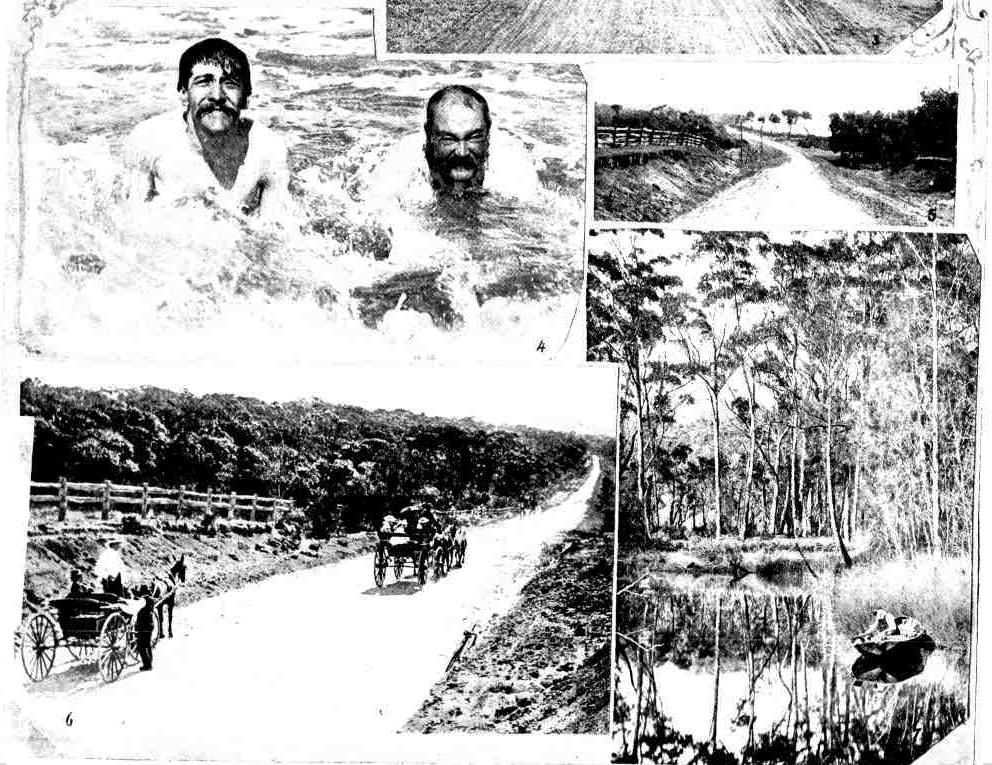
1. On the Narrabeen Lagoon. 2. View from Sheepstation Hill, looking south. 3. Bay View. 4. A dip in the surf at Narrabeen. 5. Near Long Reef. 6. Approaching Narrabeen. 7. One of the creeks.
The distance from Manly to Bay View is about 15 miles. The road is by the Narrabeen-road past Rocklily. A proposal to put down a tram line is now being considered, and a member of the ministry was recently driven over the country, which in many parts is remarkably picturesque. MANLY TO BAY VIEW—A POPULAR EASTER RESORT BY ROAD. (1900, April 14). The Sydney Mail and New South Wales Advertiser (NSW : 1871 - 1912), p. 878. Retrieved from http://nla.gov.au/nla.news-article165297416
Photos taken by Macpherson family - visit: The Macphersons Of Wharriewood: The William Joseph Macpherson Albums
Sydney, 25th October, 1963.
WITHDRAWAL FROM SPECIAL LEASE FOR "SETTLEMENT PURPOSES"
IT is hereby notified that, in pursuance of section 233 (1) of the Crown Lands Consolidation Act, 1913, the Crown land hereunder described is hereby withdrawn from Special Lease No. 45/22, Metropolitan, held by William Wallace Brooks Lloyd, for "Settlement Purposes".
K. C. COMPTON, Minister for Lands. Land District—Metropolitan; Shire—Warringah
Parish Narrabeen, county Cumberland, area 12 ½ perches, being allotment 9, section 9, village Turimetta. Plan Turimetta 22. T. 62-7,281. WITHDRAWAL FROM SPECIAL LEASE FOR "SETTLEMENT PURPOSES" (1963, November 1). Government Gazette of the State of New South Wales (Sydney, NSW : 1901 - 2001), p. 3250. Retrieved from http://nla.gov.au/nla.news-article220332095
DEPARTMENT OF MAIN ROADS
Levels
MAIN ROADS ACT, 1924
Section 264 of the Local Government Act, 1919
Shire of Warringah. Main Road No. 174—Pittwater Road.
Deviation between Mona Street and Bayview Place, Bayview
NOTICE is hereby given that the levels of Main Road No. 174—Pittwater Road between Mona Street and Bay view Place, Bayview, and so much of any side roads thereby affected within the Shire of Warringah in accordance with and as shown on plan Registered No. 0174.479.RC.2511, exhibited at the Head Office of the Department of Main Roads, 309 Castlereagh Street, Sydney, at the Department's Divisional Office, Milson's Point and at the Council Chambers of the Shire of Warringah, and duly notified in the "Sydney Morning Herald", on Friday, 26th May, 1978, and in the Government Gazette on Friday, 26th May, 1978, have been approved.
The levels are now fixed and/or refixed and will take effect from the date of publication of this notice.
Signed and sealed at Sydney, this 20th day of September, one thousand nine hundred and seventy-eight.
I, Brian Joseph Sexton, The Commissioner for Main Roads have hereto affixed the Official Seal of The Commissioner for Main Roads in the presence of: H. B. HERRICK, Secretary. (D.M.R. No. L.479.5357)
(L.S.)
B. J. SEXTON
DEPARTMENT OF MAIN ROADS (1978, October 20). Government Gazette of the State of New South Wales (Sydney, NSW : 1901 - 2001), p. 4226. Retrieved from http://nla.gov.au/nla.news-article220219600
STATE ROADS ACT 1986 PUBLIC WORKS ACT 1912
NOTIFICATION OF ACQUISITION OF LAND AT CHURCH POINT IN THE SHIRE OF WARRINGAH
IT Is hereby notified and declared by His Excellency the Governor, acting with the advice of the Executive Council, that in pursuance of the State Roads Act 1986 the land described in the Schedule hereunder in respect of so much of the said land as is Crown Land is hereby appropriated and in respect of so much of the said land as is private property is hereby resumed under the Public Works Act 1912 for the purposes of the State Roads Act 1986 and that all the said land is hereby vested in the Roads and Traffic Authority of New South Wales.
DATED at Sydney this 4th day of December 1991.
A M GLEESON
By deputation from His Excellency the Governor By His Excellency's Command,
WAL MURRAY
Deputy Premier and Minister for Roads
SCHEDULE
ALL those pieces or parcels of land situate in the Shire of Wanringah, Parish of Narrabeen and County of Cumberland being:
the residue of the land comprised within Certificate of Title Volume 6991 Folio 102 and shown as Lot 4, Deposited Plan 516255,
the residue of the land comprised within Certificate of Title Volume 6991 Folio 101 and shown as Lot 5, Deposited Plan 516255, and
the residue of the land comprised within Certificate of Title Volume 7275 Folio 59 and shown as Lot 6, Deposited Plan 516255.
The land is in the possession of the Roads and Traffic Authority of New South Wales. (RTA Papers 479.11464) STATE ROADS ACT 1986 PUBLIC WORKS ACT 1912 (1991, December 13). Government Gazette of the State of New South Wales (Sydney, NSW : 1901 - 2001), p. 10469. Retrieved from http://nla.gov.au/nla.news-article231924805
ENVIRONMENTAL PLANNING AND ASSESSMENT ACT 1979
PITTWATER LOCAL ENVIRONMENTAL PLAN 1993 (AMENDMENT No 26)
I, the Minister for Urban Affairs and Planning, in pursuance of Section 70 of the Environmental Planning and Assessment Act 1979 make the local environmental plan set out hereunder.
(S97/01892/S69)
CRAIG KNOWLES MP
Minister for Urban Affairs and Planning Sydney, 1 November 1998
Citation
1. This plan may be cited as Pittwater Local Environmental Plan 1993 (Amendment No 26). Aims, objectives etc 2. This plan aims:
(a) to enable the land to which this plan applies to be used for the public purposes for which it is reserved under the provisions of the Crown Lands Act 1989; and
(b) to ensure that the land to which this plan applies is used for public purposes consistent with the plan of management for the land prepared and adopted by the Council of Pittwater; and
(c) to enable the land to be used for the additional public purpose of carparking.
Land to which the plan applies
3. This plan applies to land within the area of Pittwater, being Lot 321, DP 824048 (Crown Reserve 100256), Pittwater Road, Church Point, as shown edged heavy black on the map marked "Pittwater Local Environmental Plan 1993 (Amendment No 26)" deposited in the office of the Council of Pittwater.
Relationship to other environmental planning instrument
4. This plan amends Pittwater Local Environmental Plan 1993 in the manner set out in clause 5. Amendment of Pittwater Local Environmental Plan 1993
5. Pittwater Local Environmental Plan 1993 is amended by inserting at the end of Schedule 10 (Development for certain additional purposes) the following matter:
Lot 321, DP 824048, Pittwater Road, Church Point, being Crown Reserve 100256, as shown edged heavy black on the map marked "Pittwater Local Environmental Plan 1993 (Amendment No 26)" - carparking for public purposes in accordance with the plan of management for Crown Reserve 100256 adopted by the Council. ENVIRONMENTAL PLANNING AND ASSESSMENT ACT 1979 (1998, November 13). Government Gazette of the State of New South Wales (Sydney, NSW : 1901 - 2001), p. 8855. Retrieved from http://nla.gov.au/nla.news-article231963061